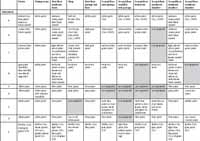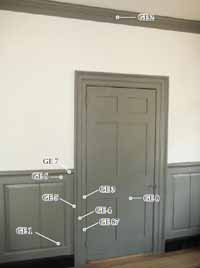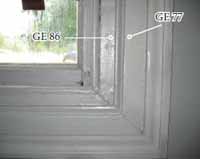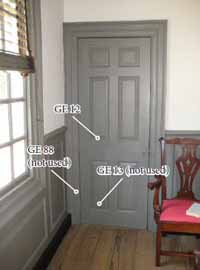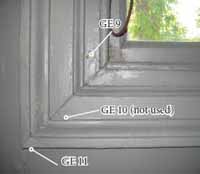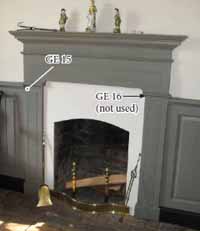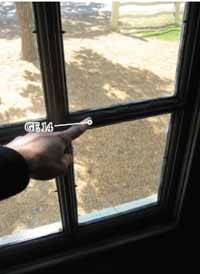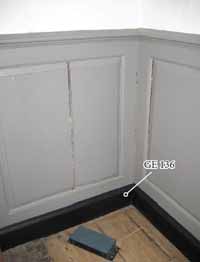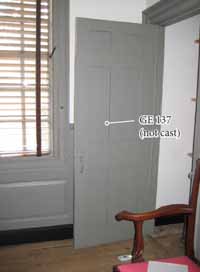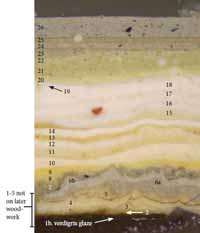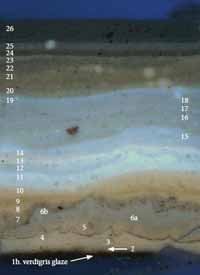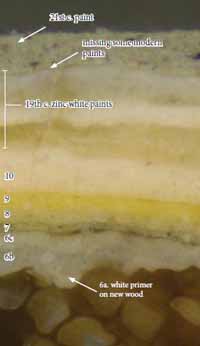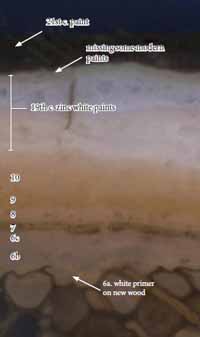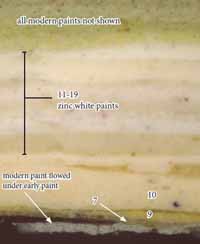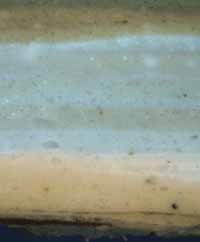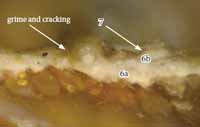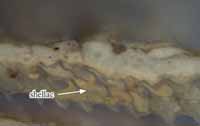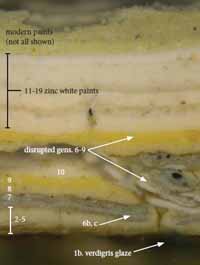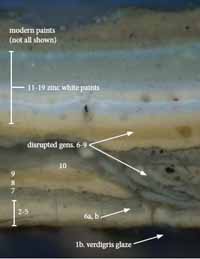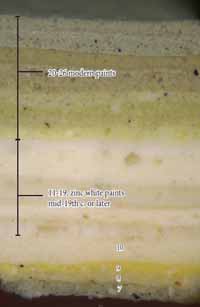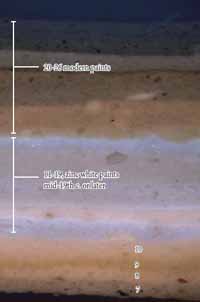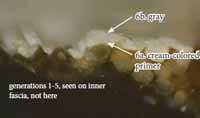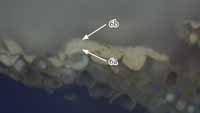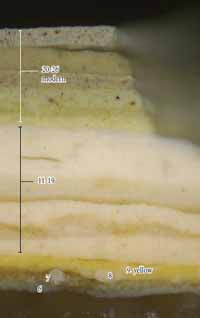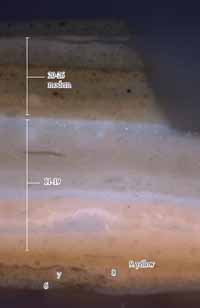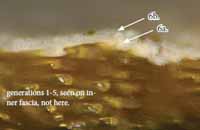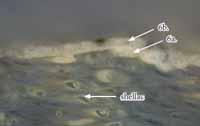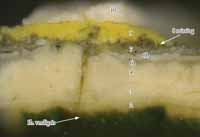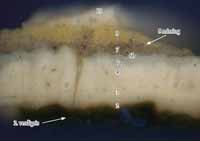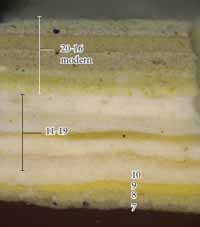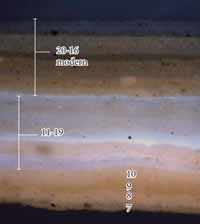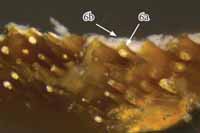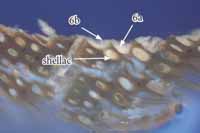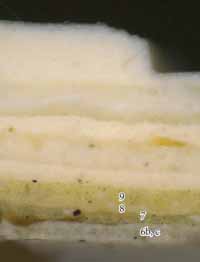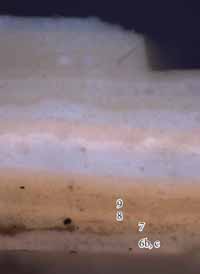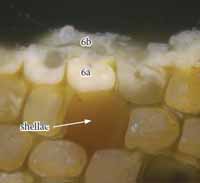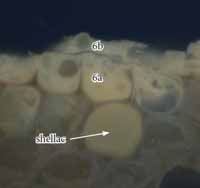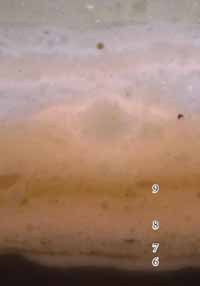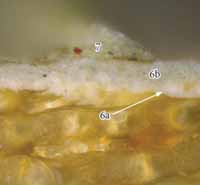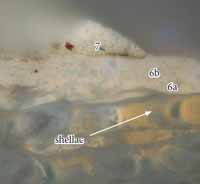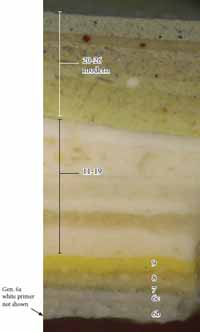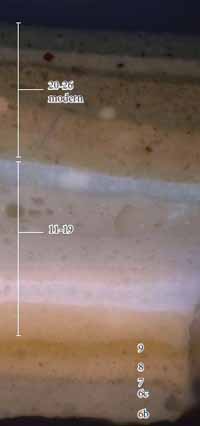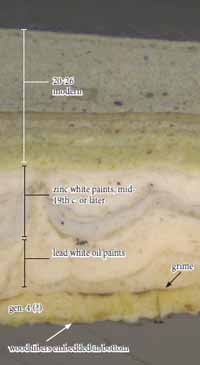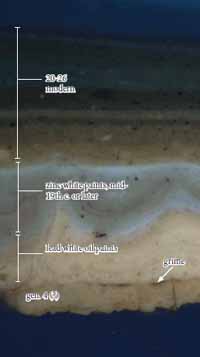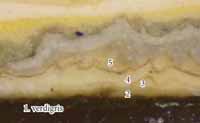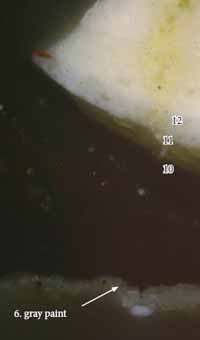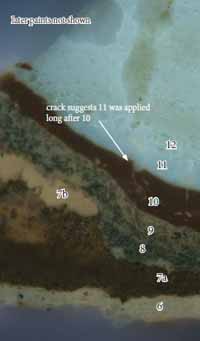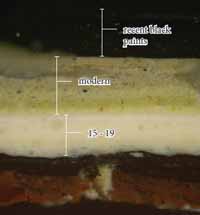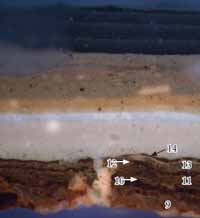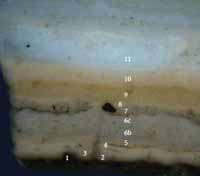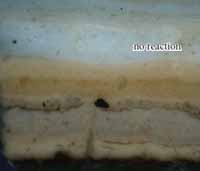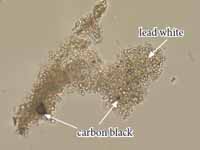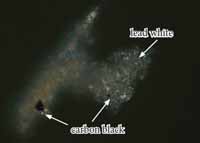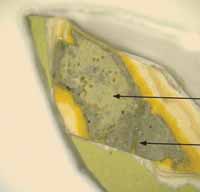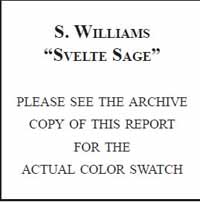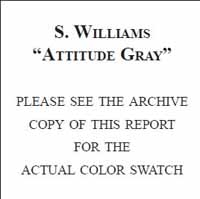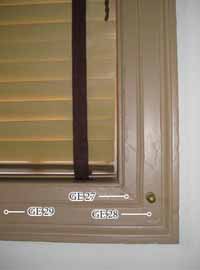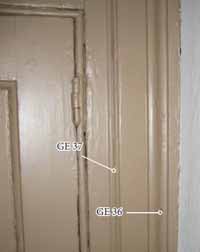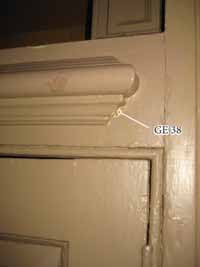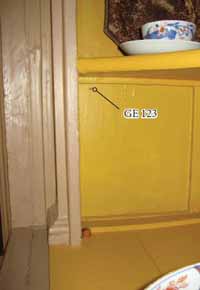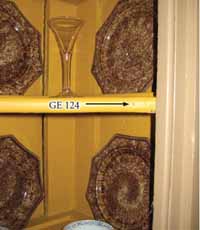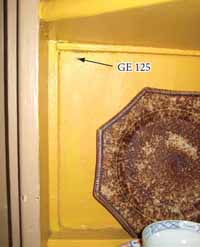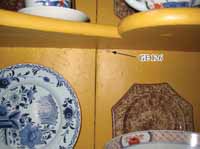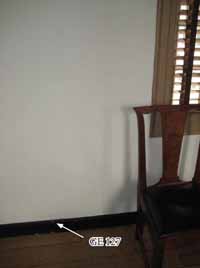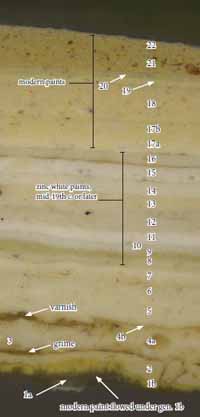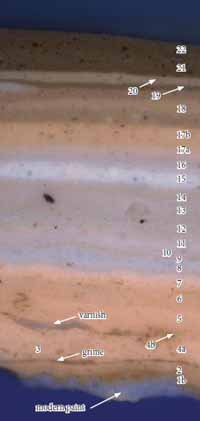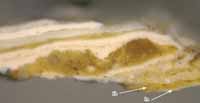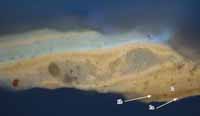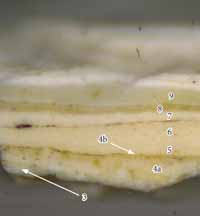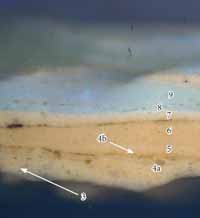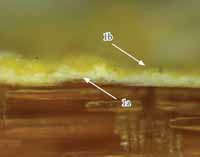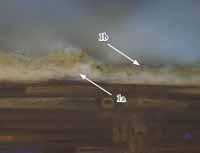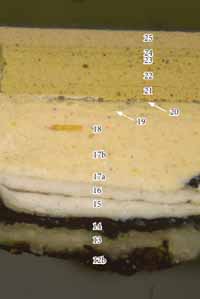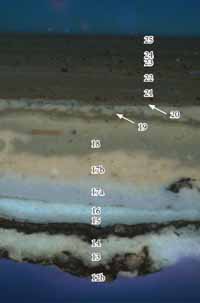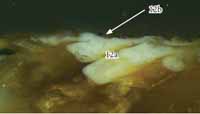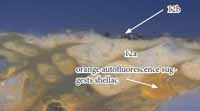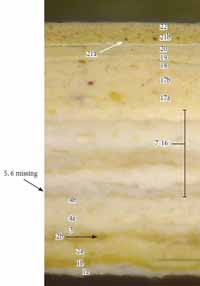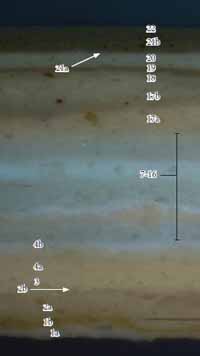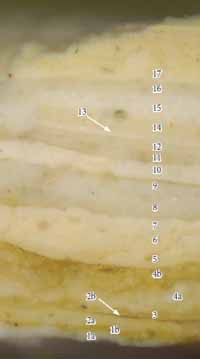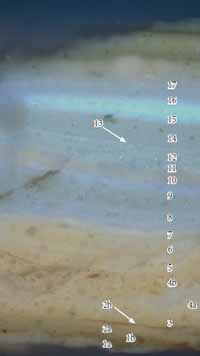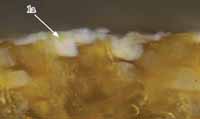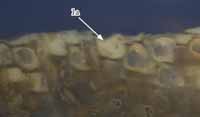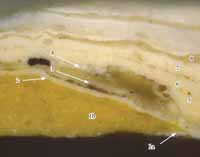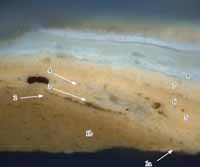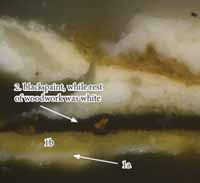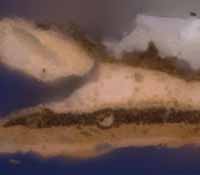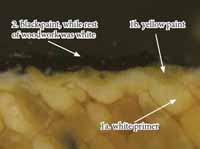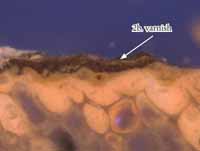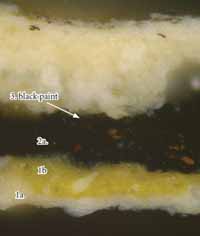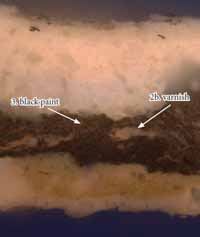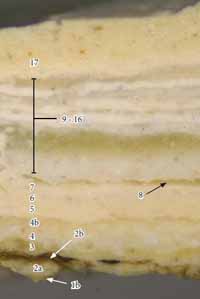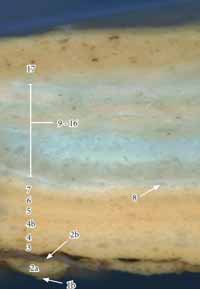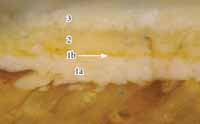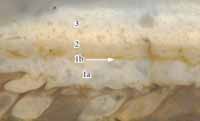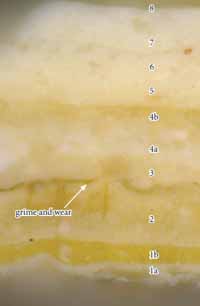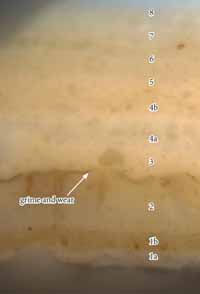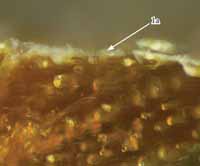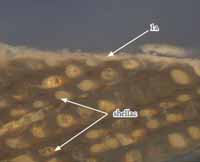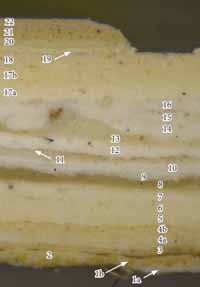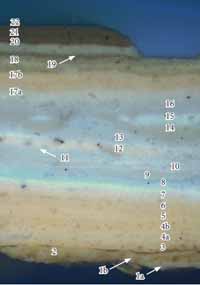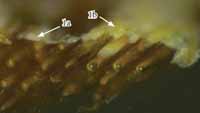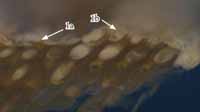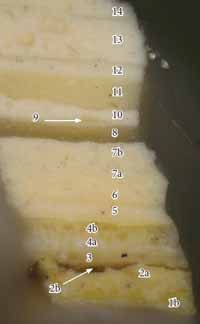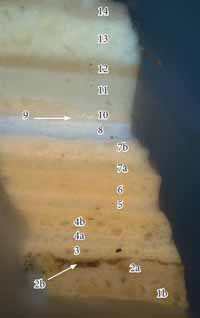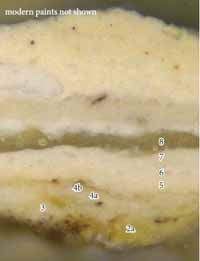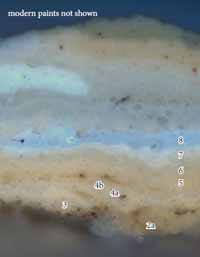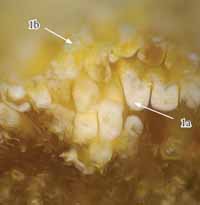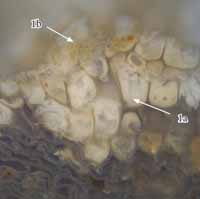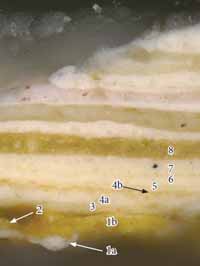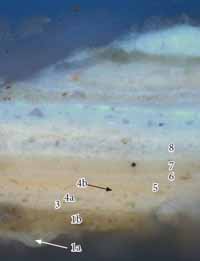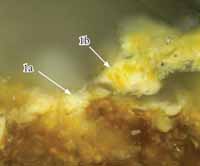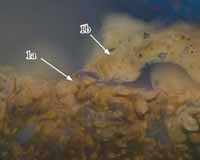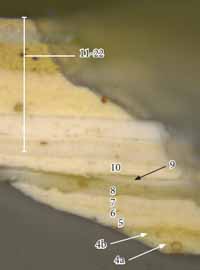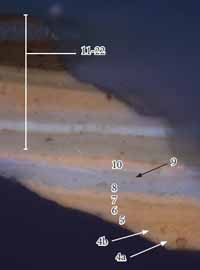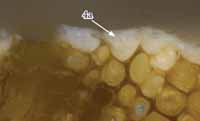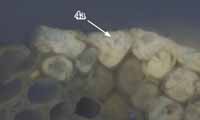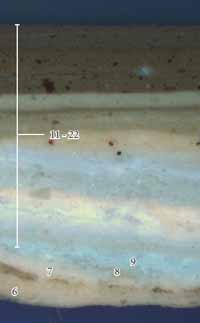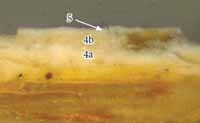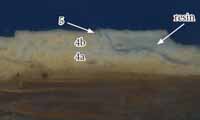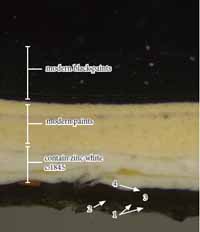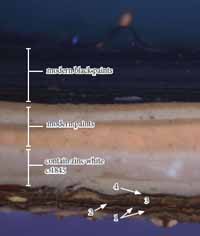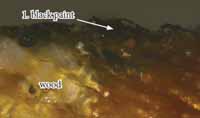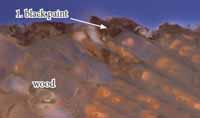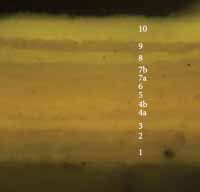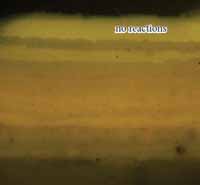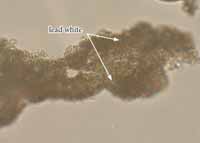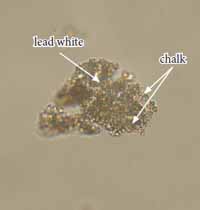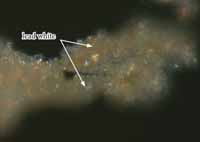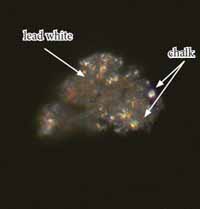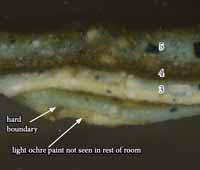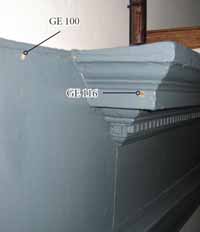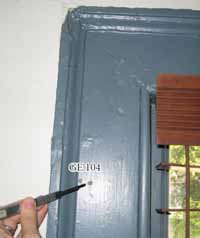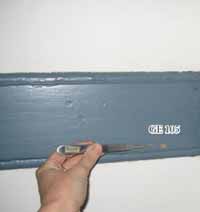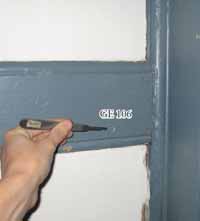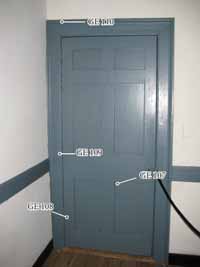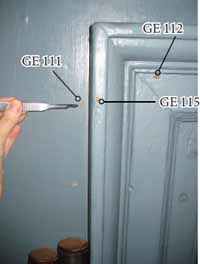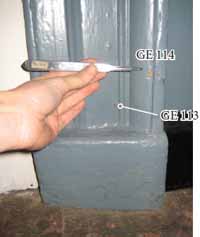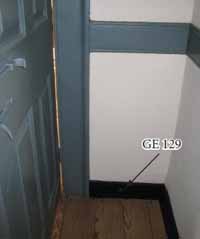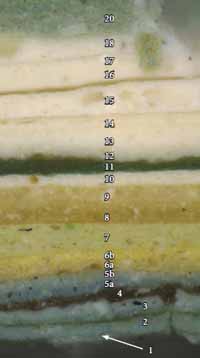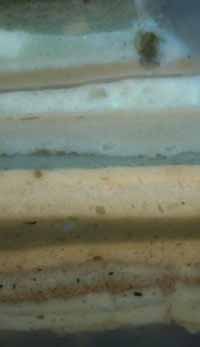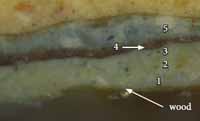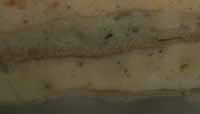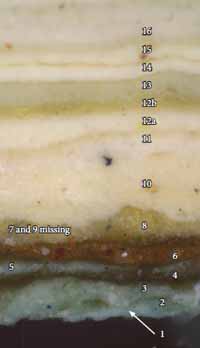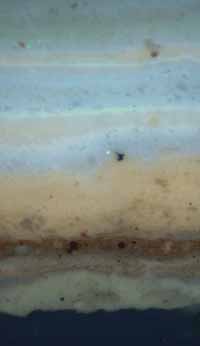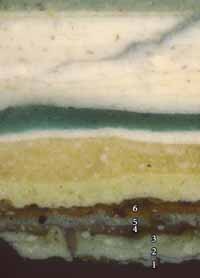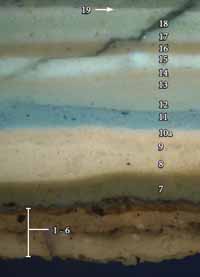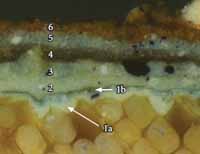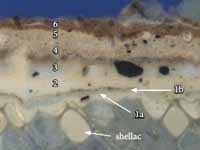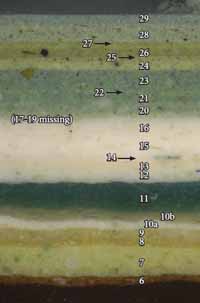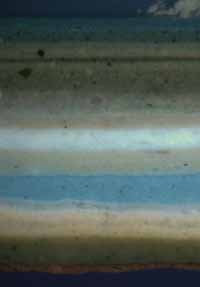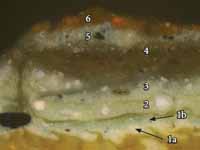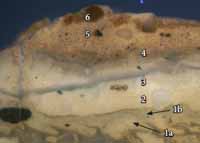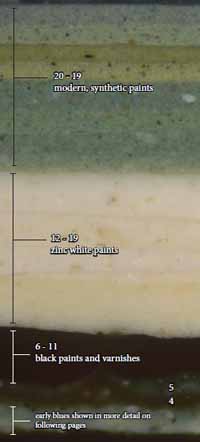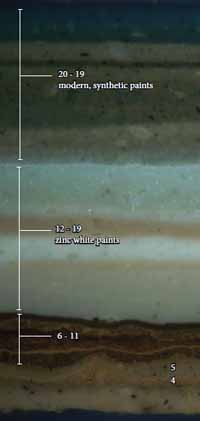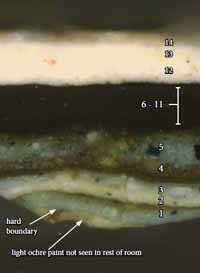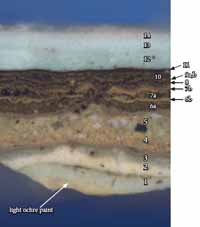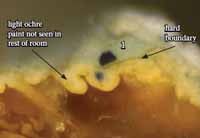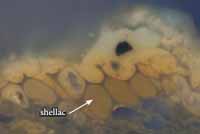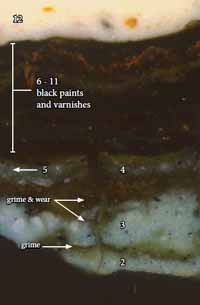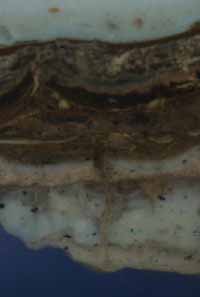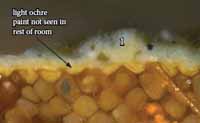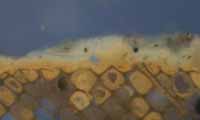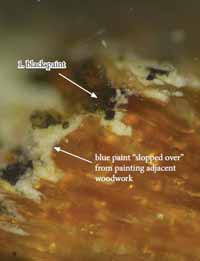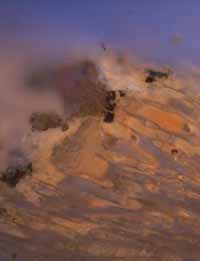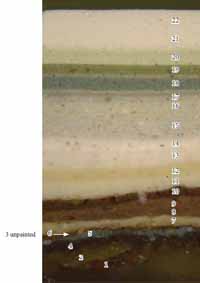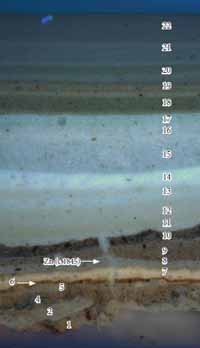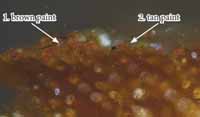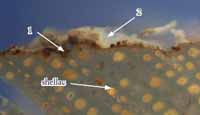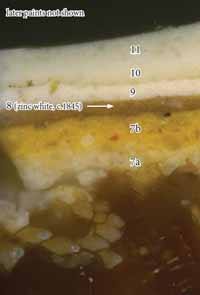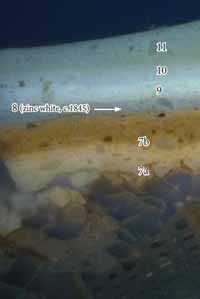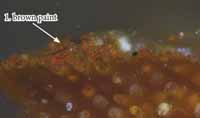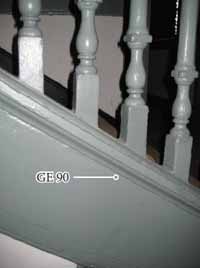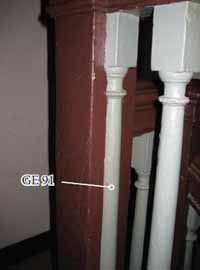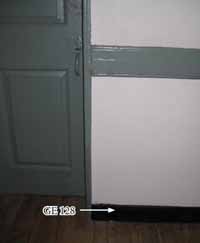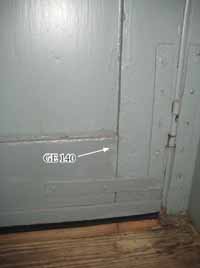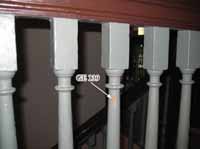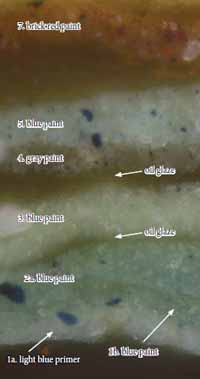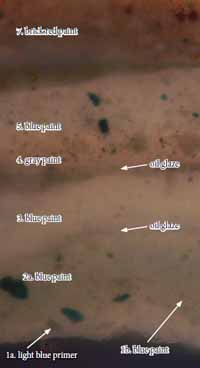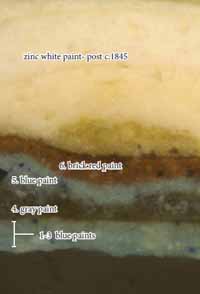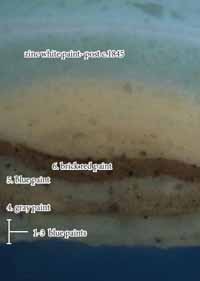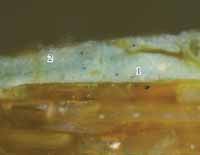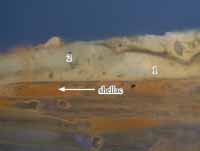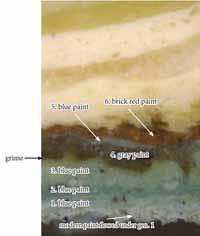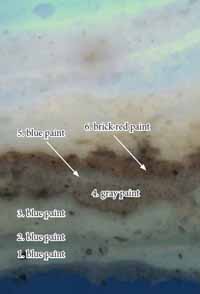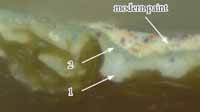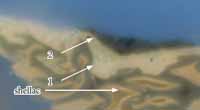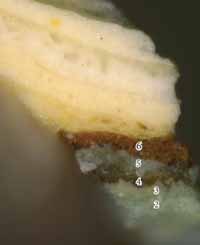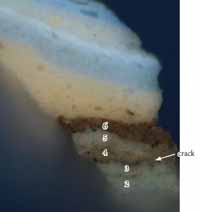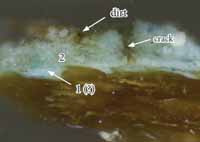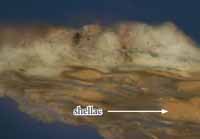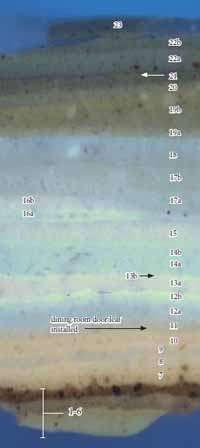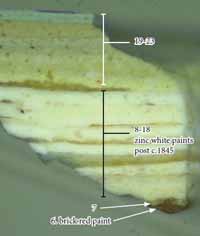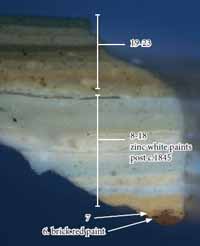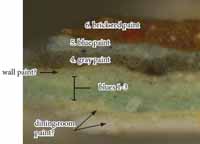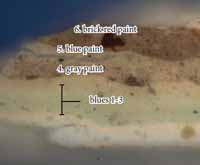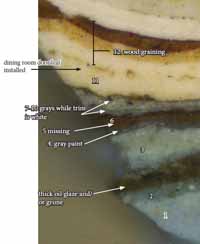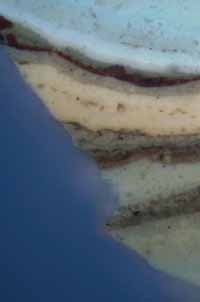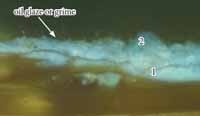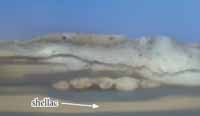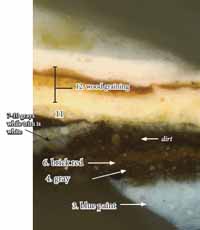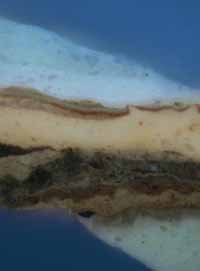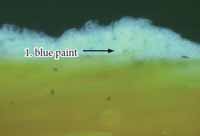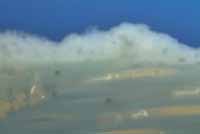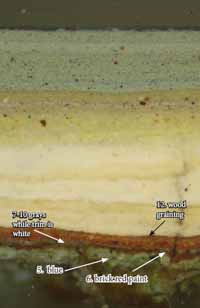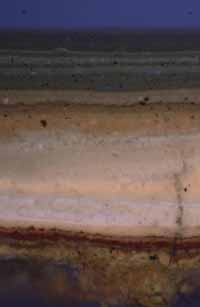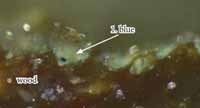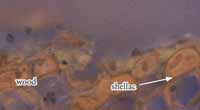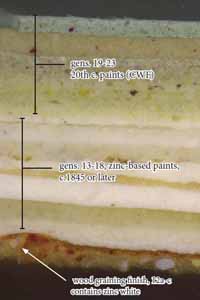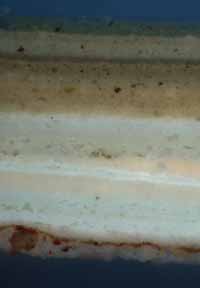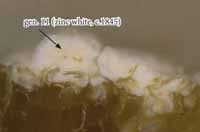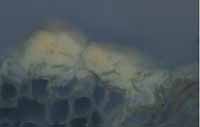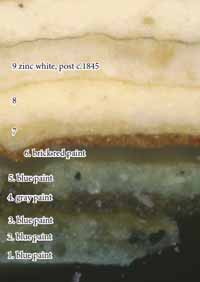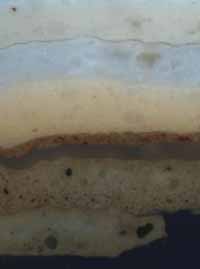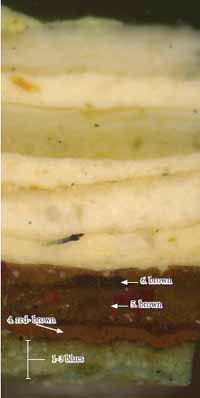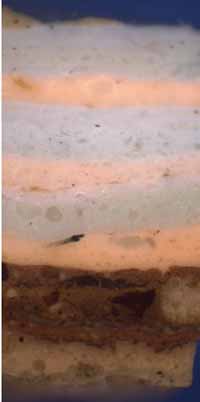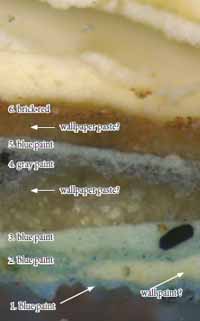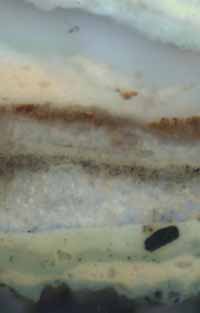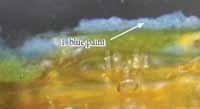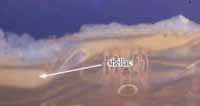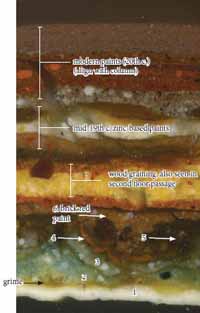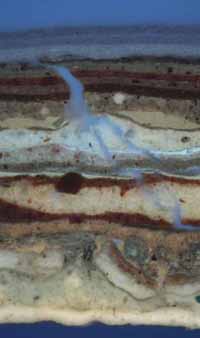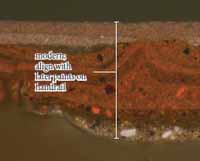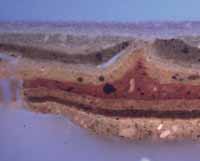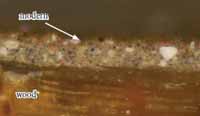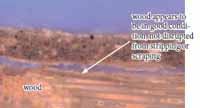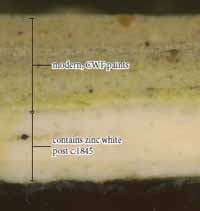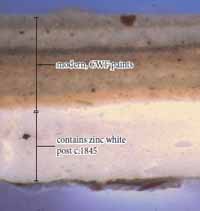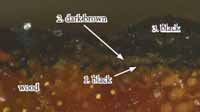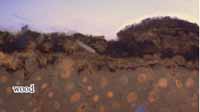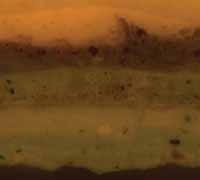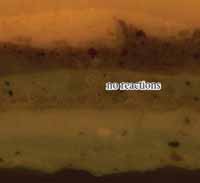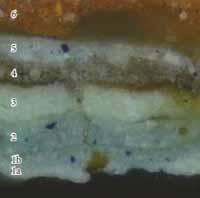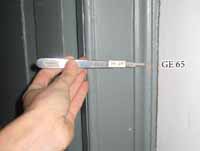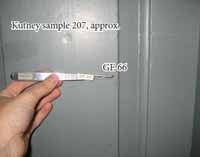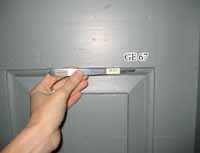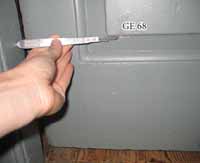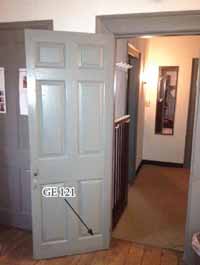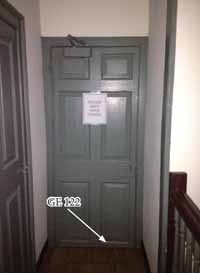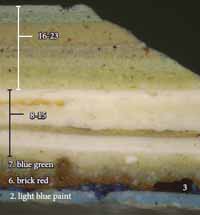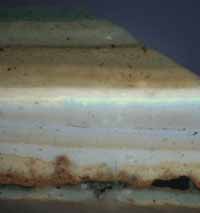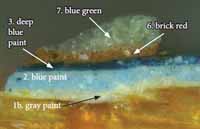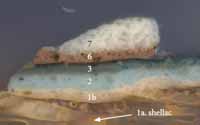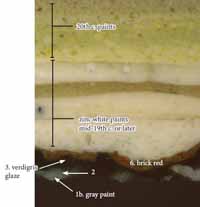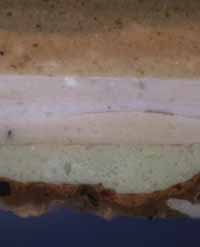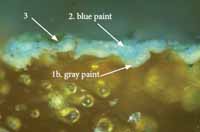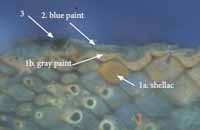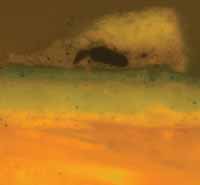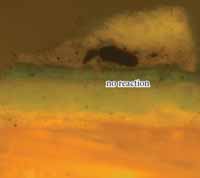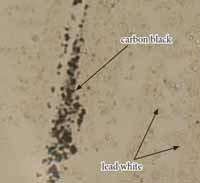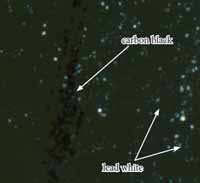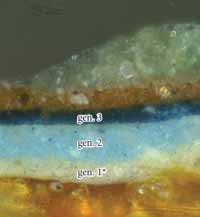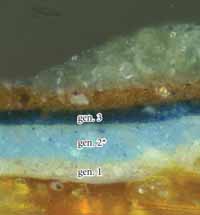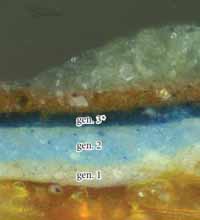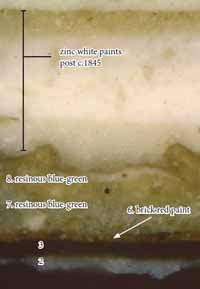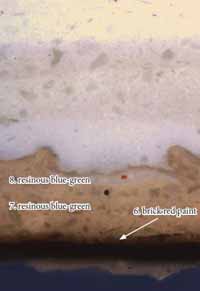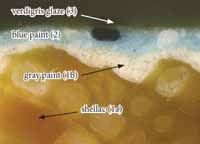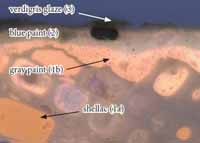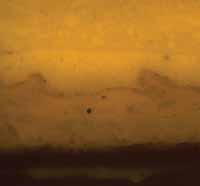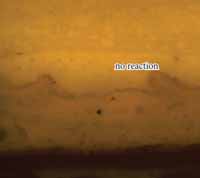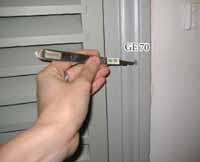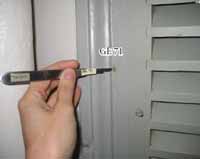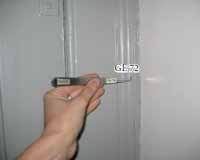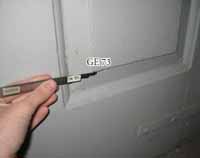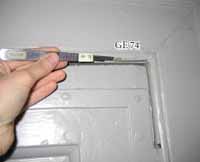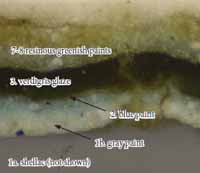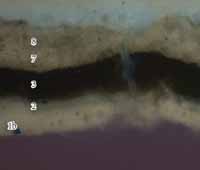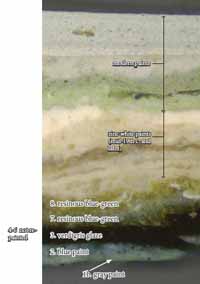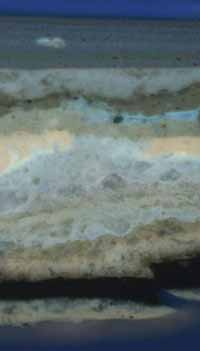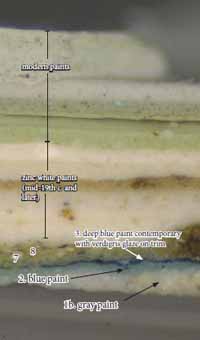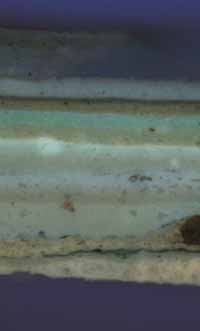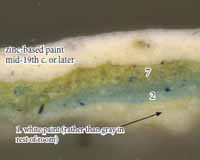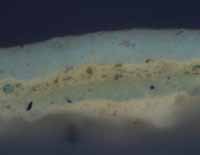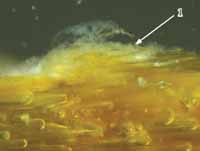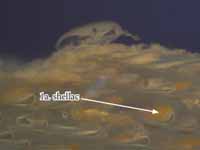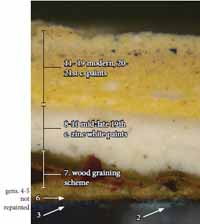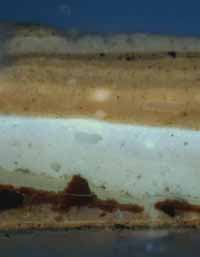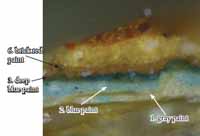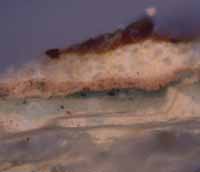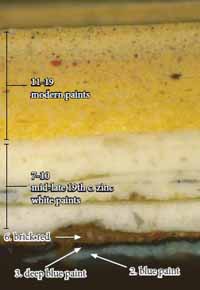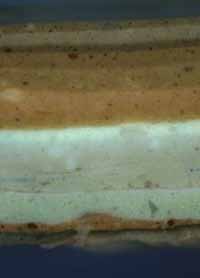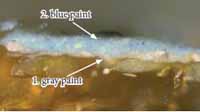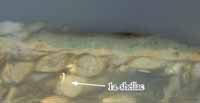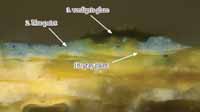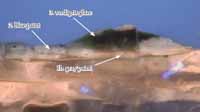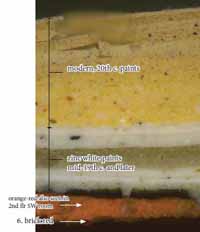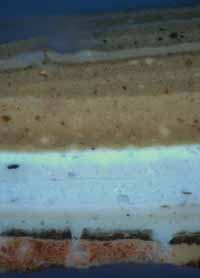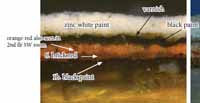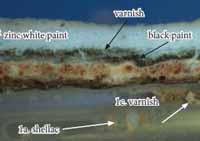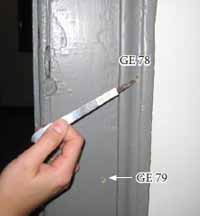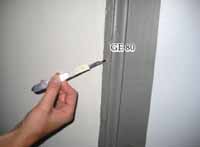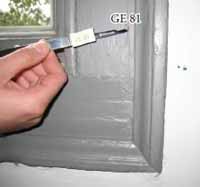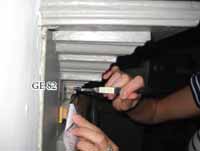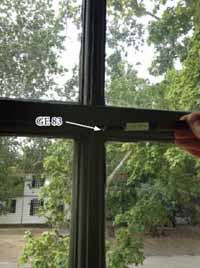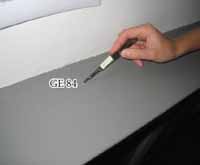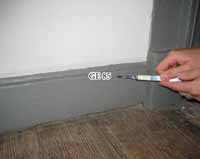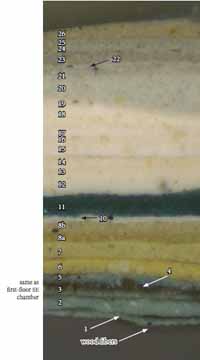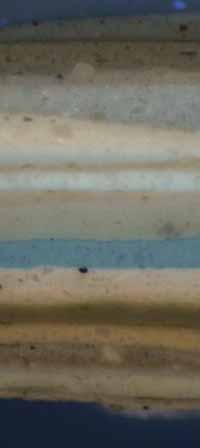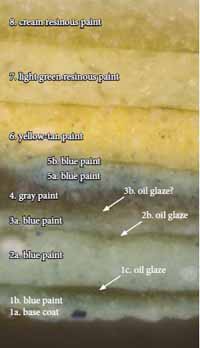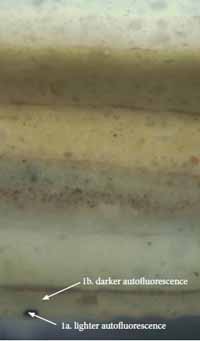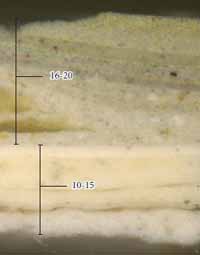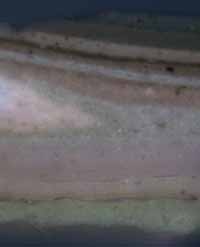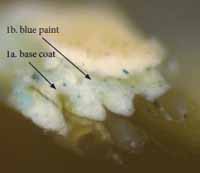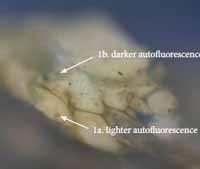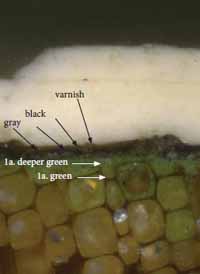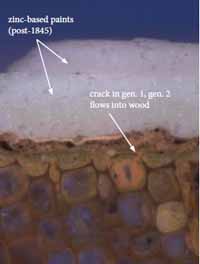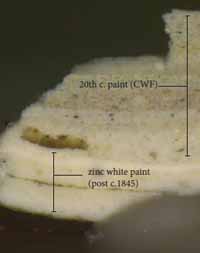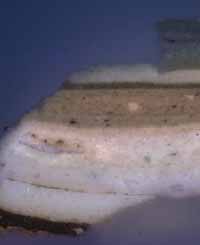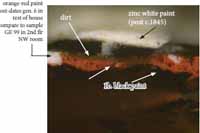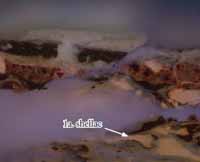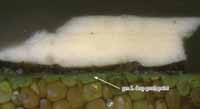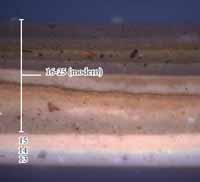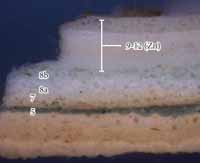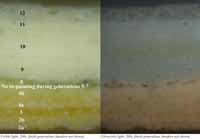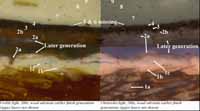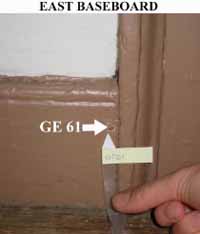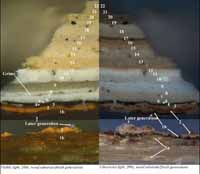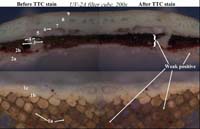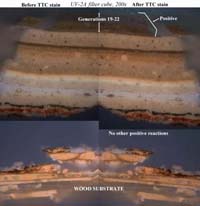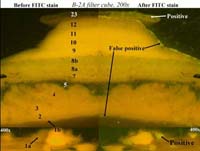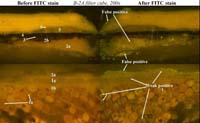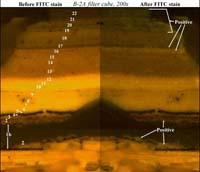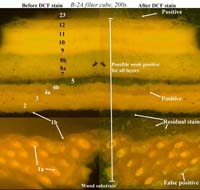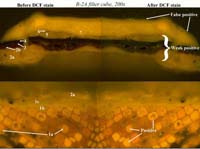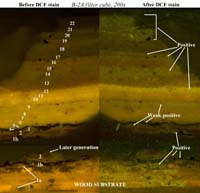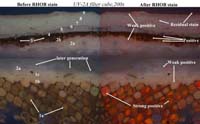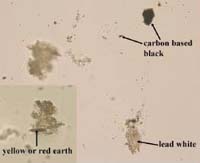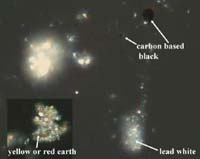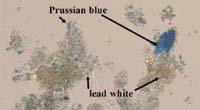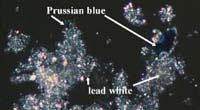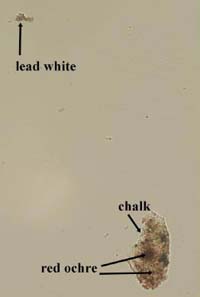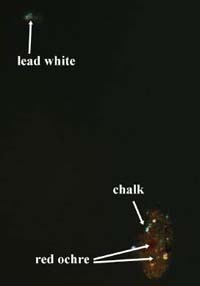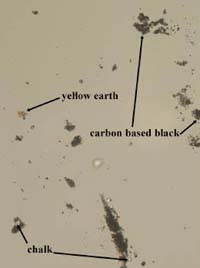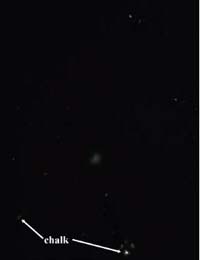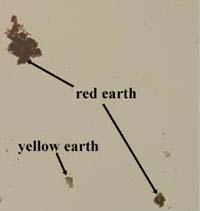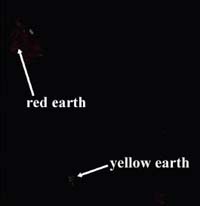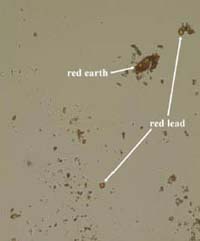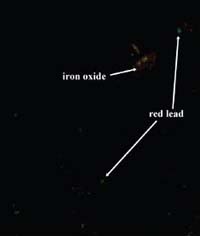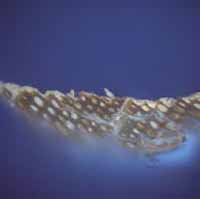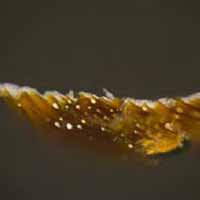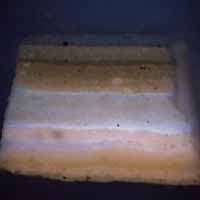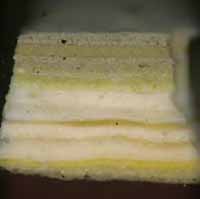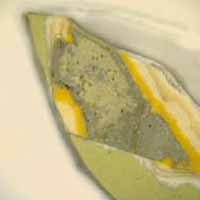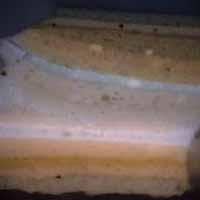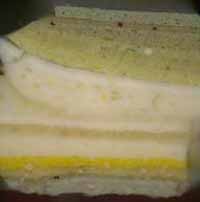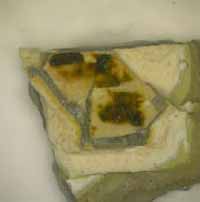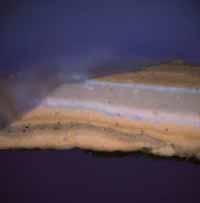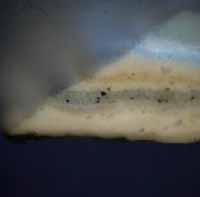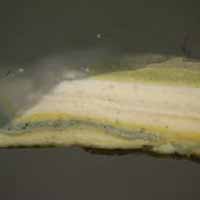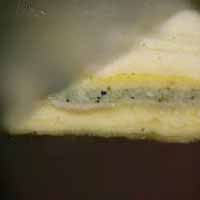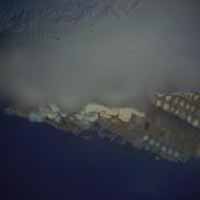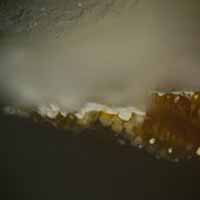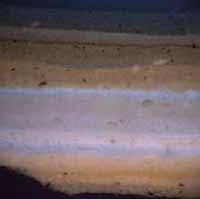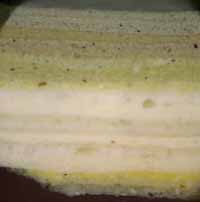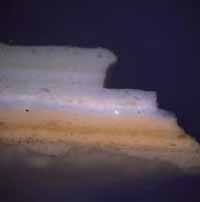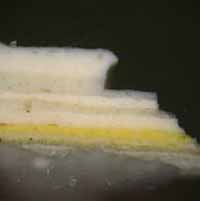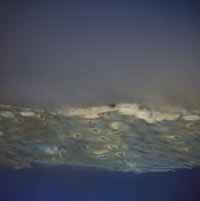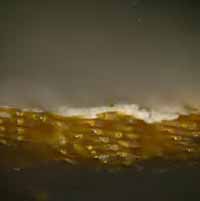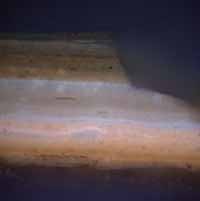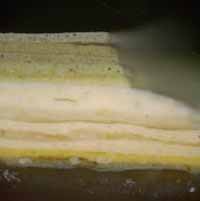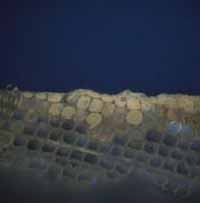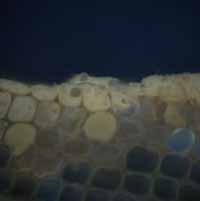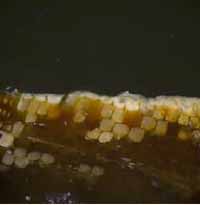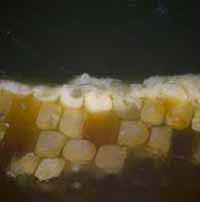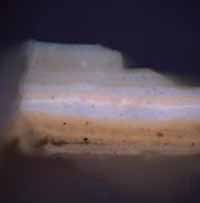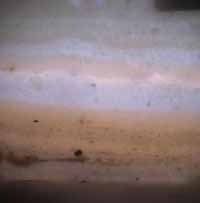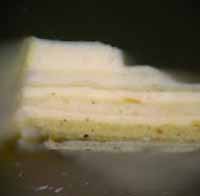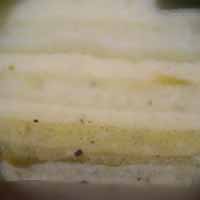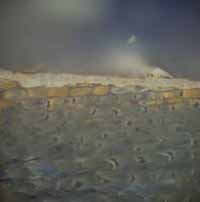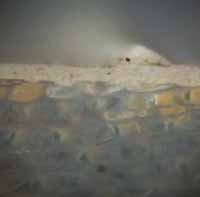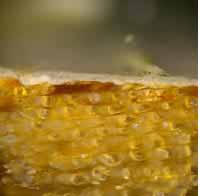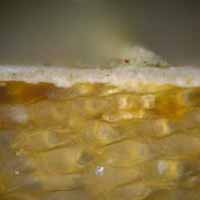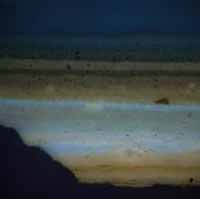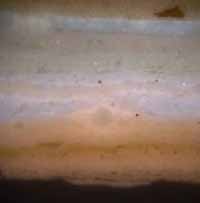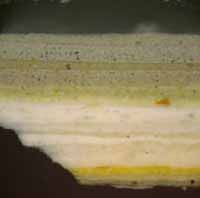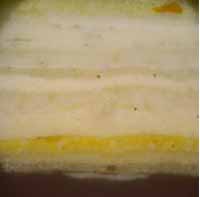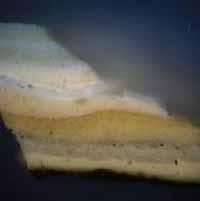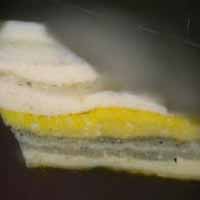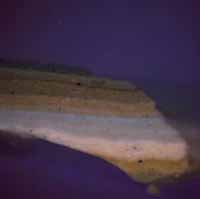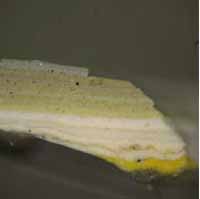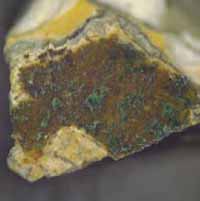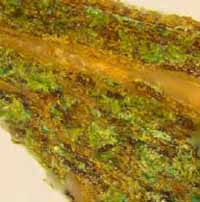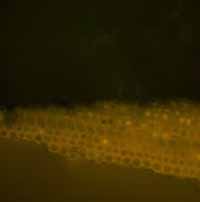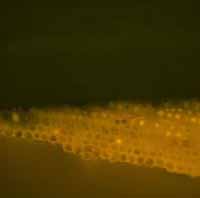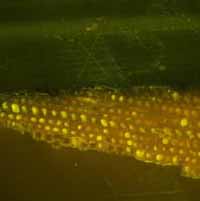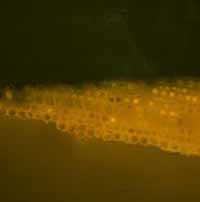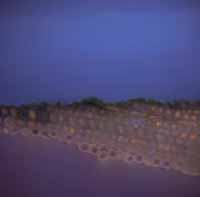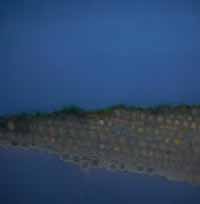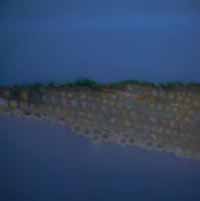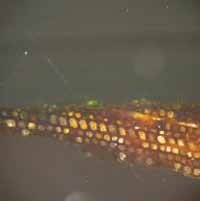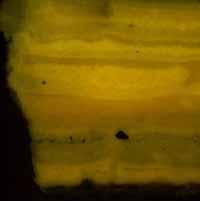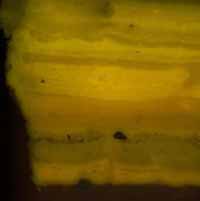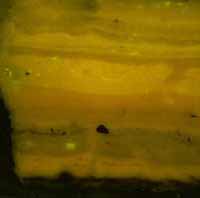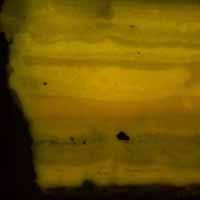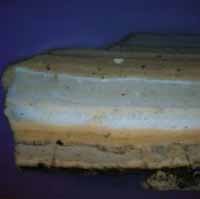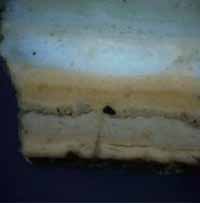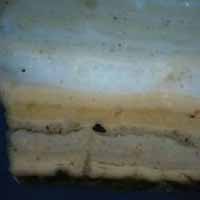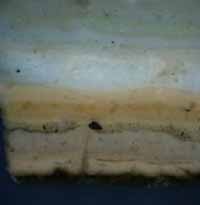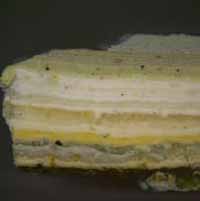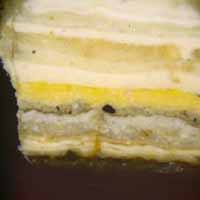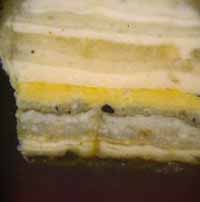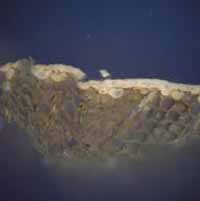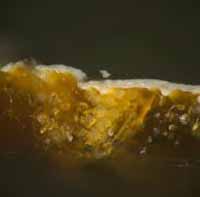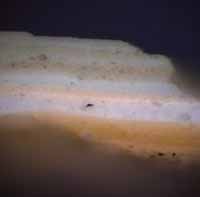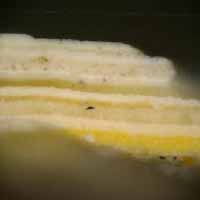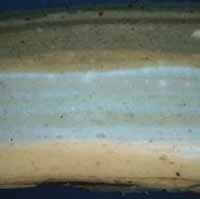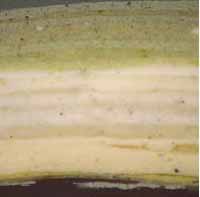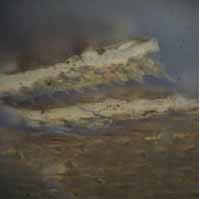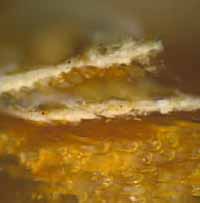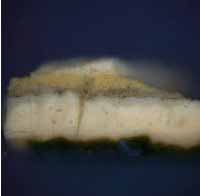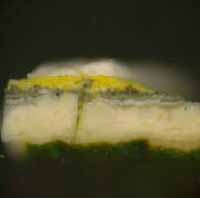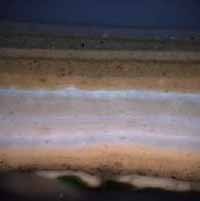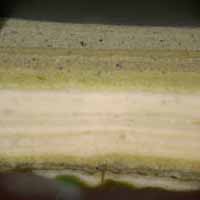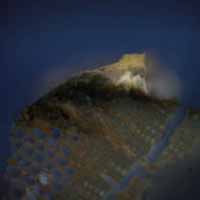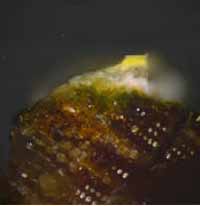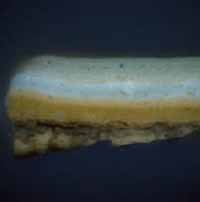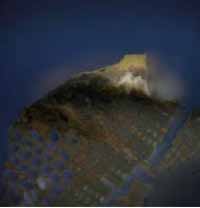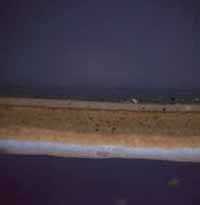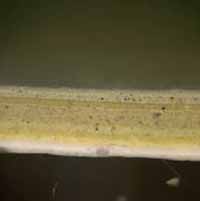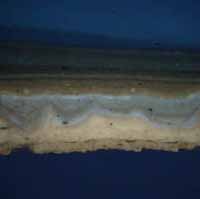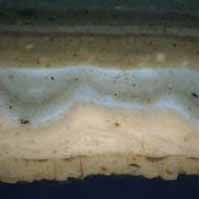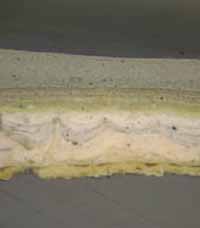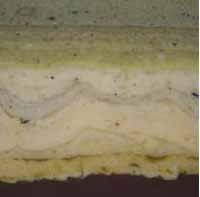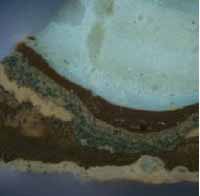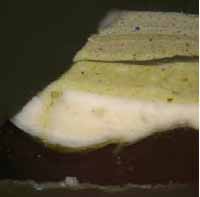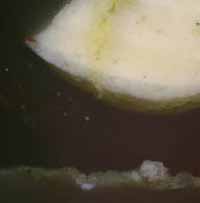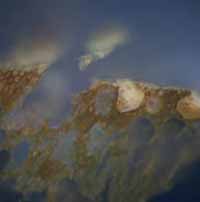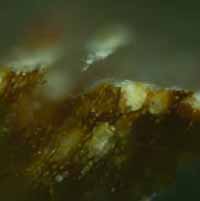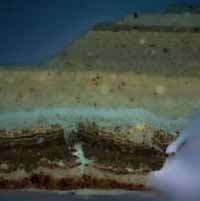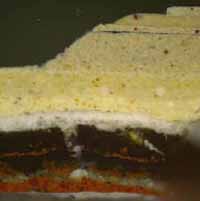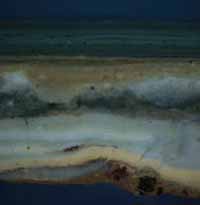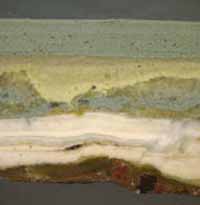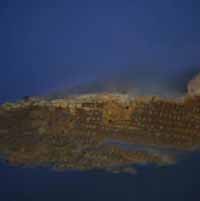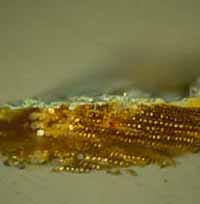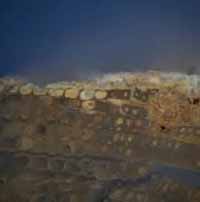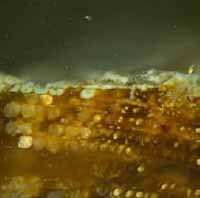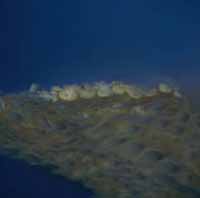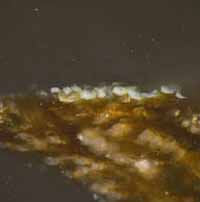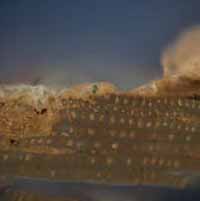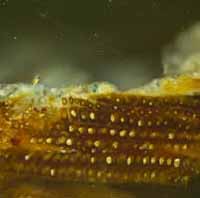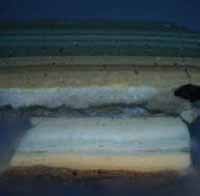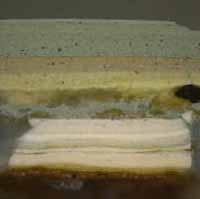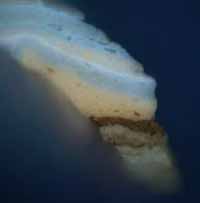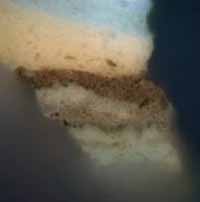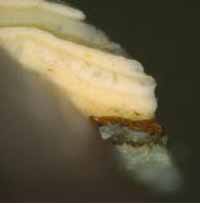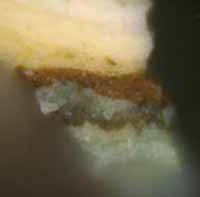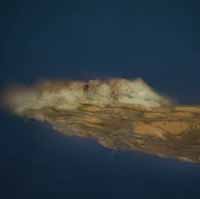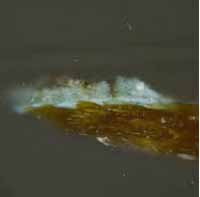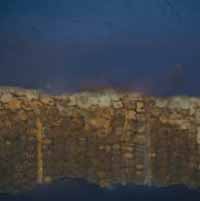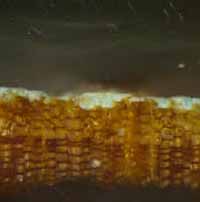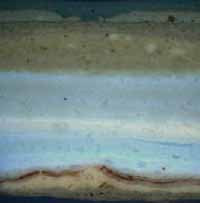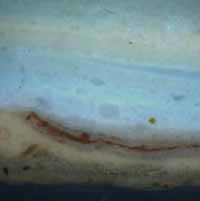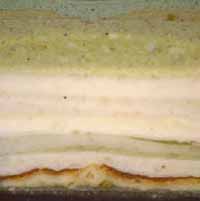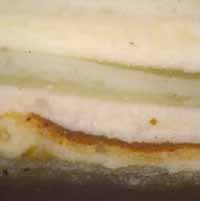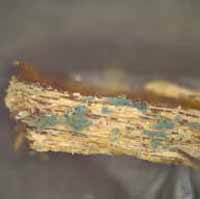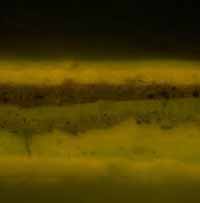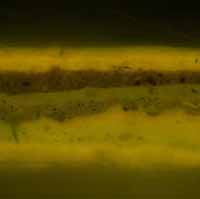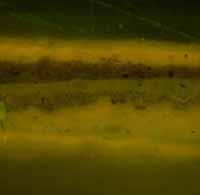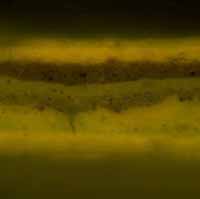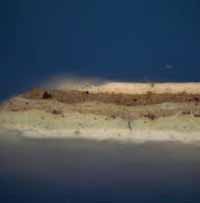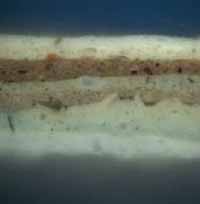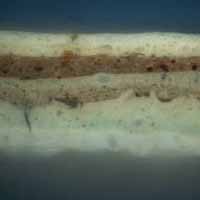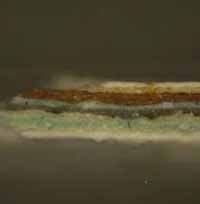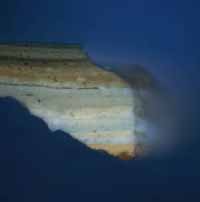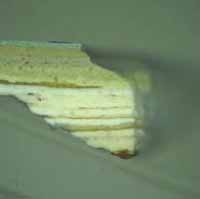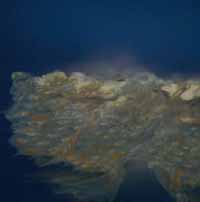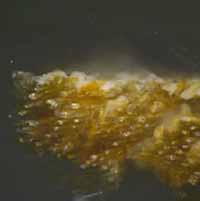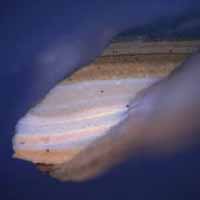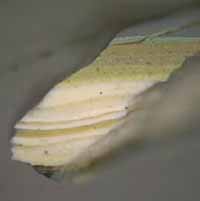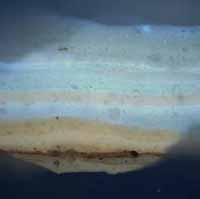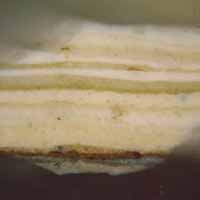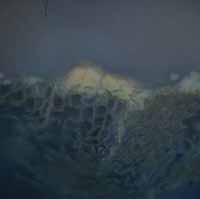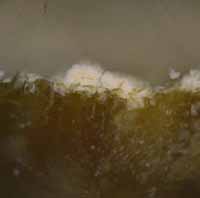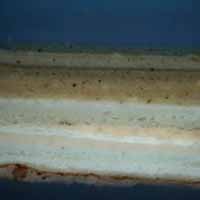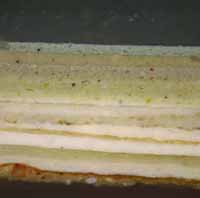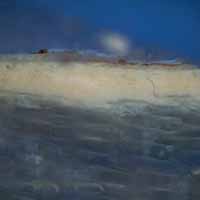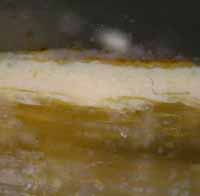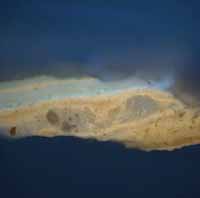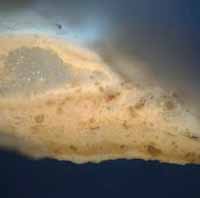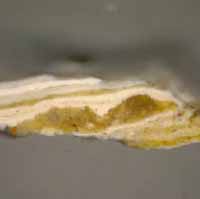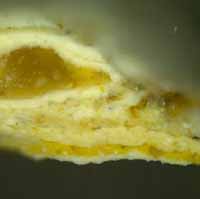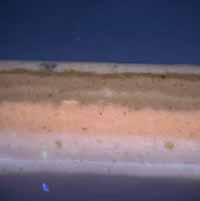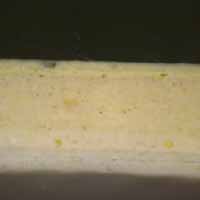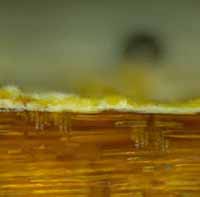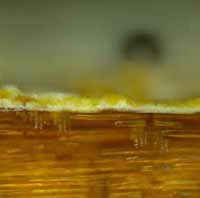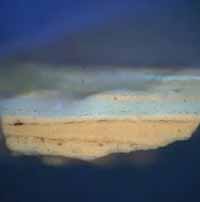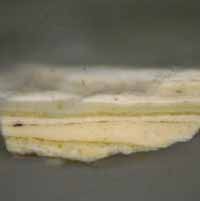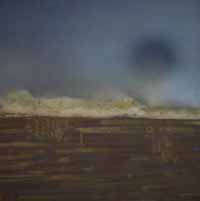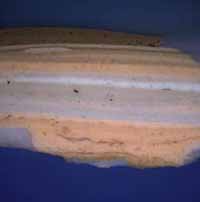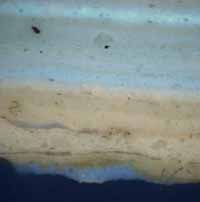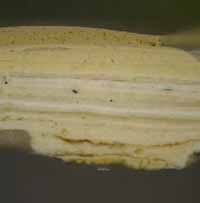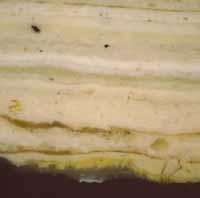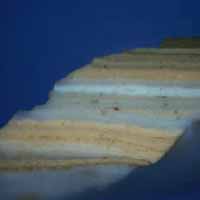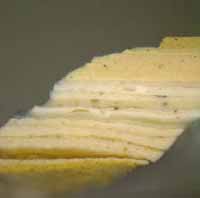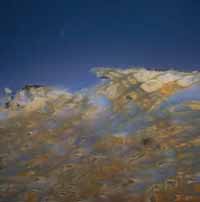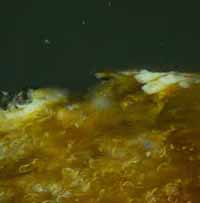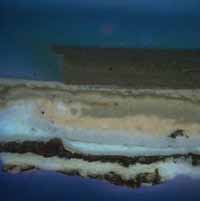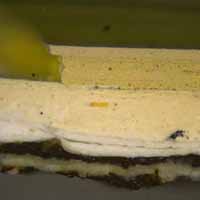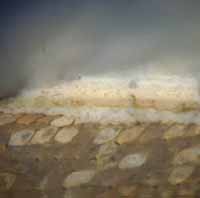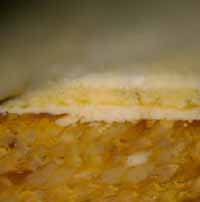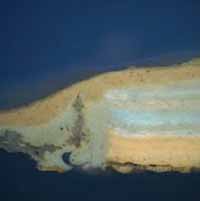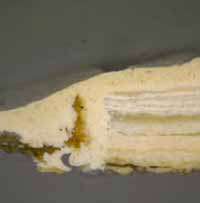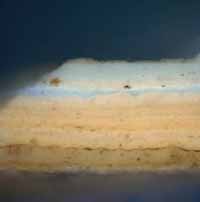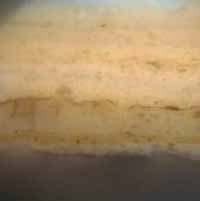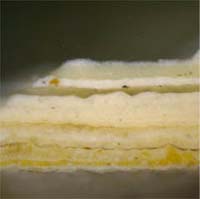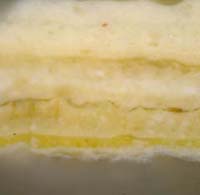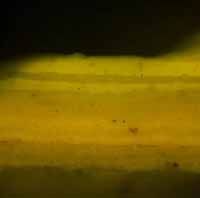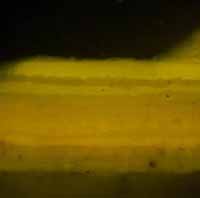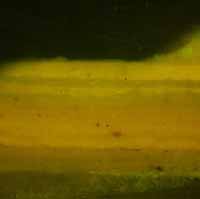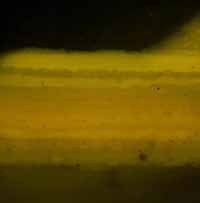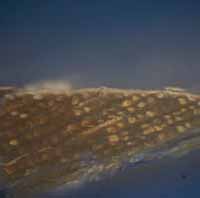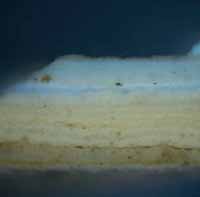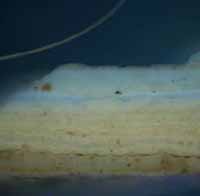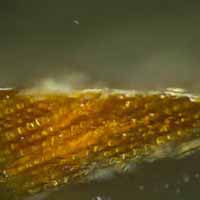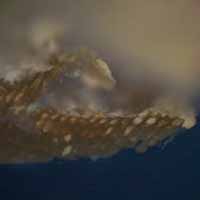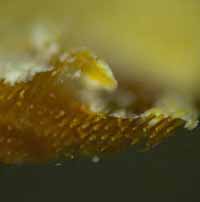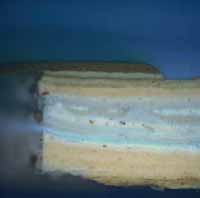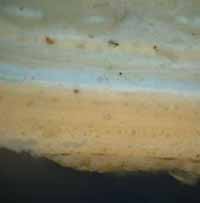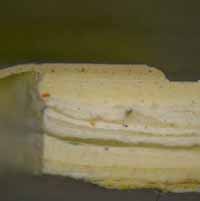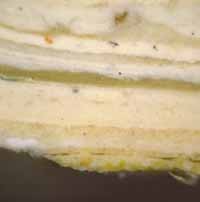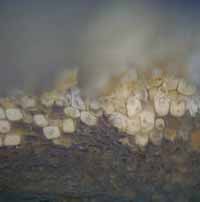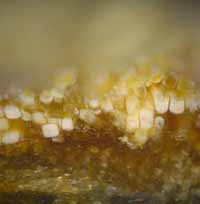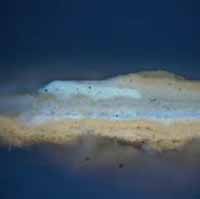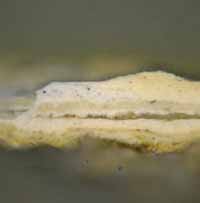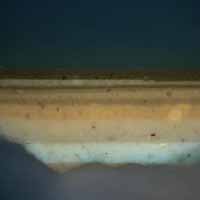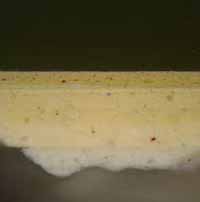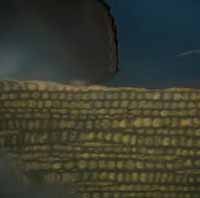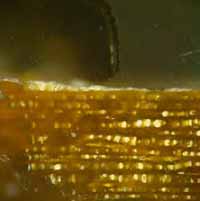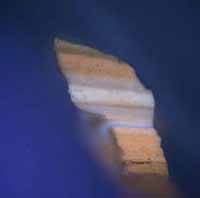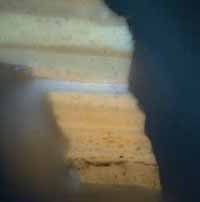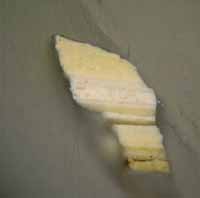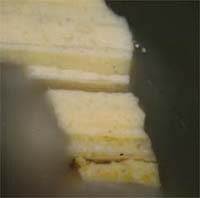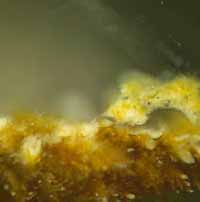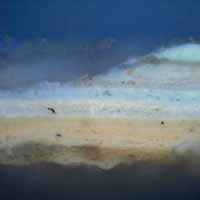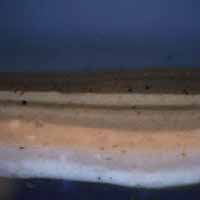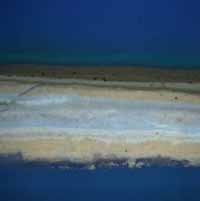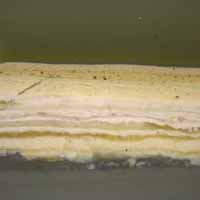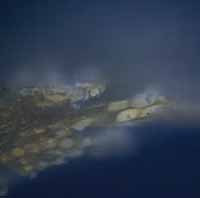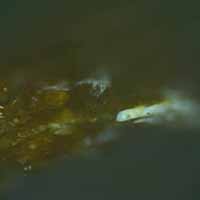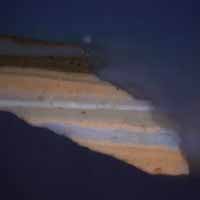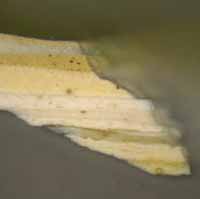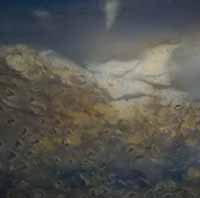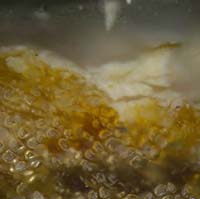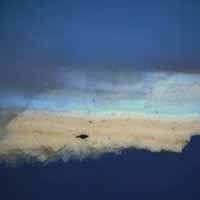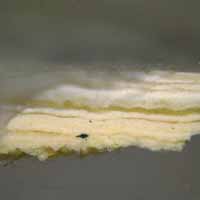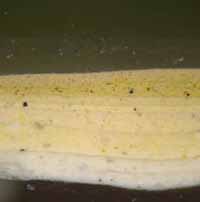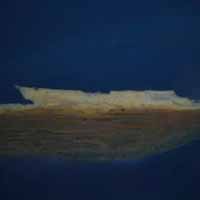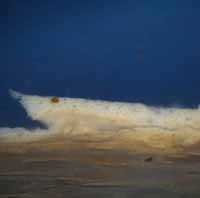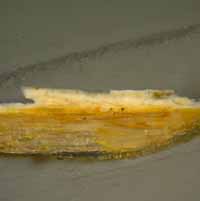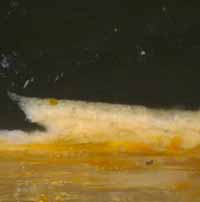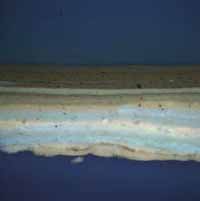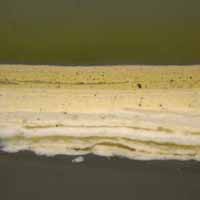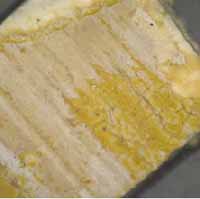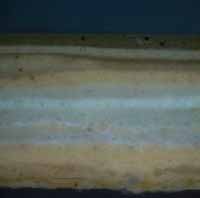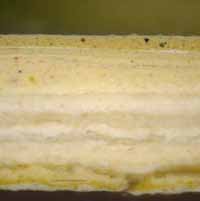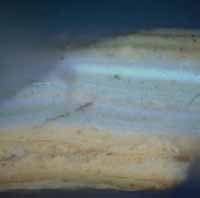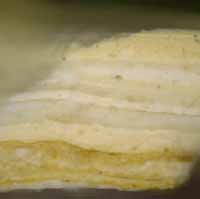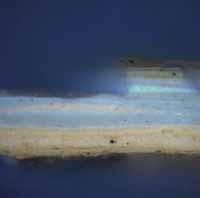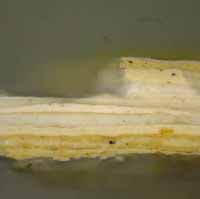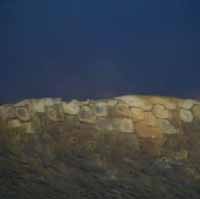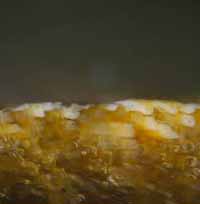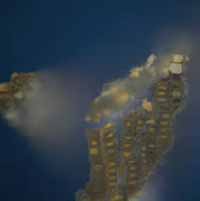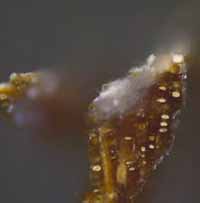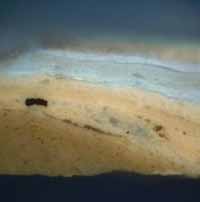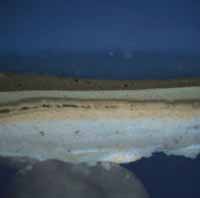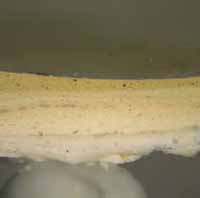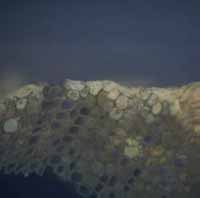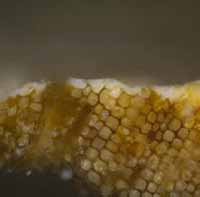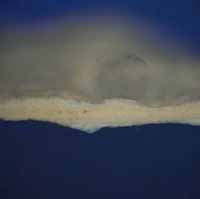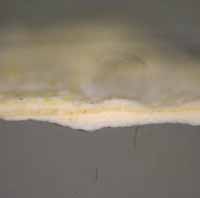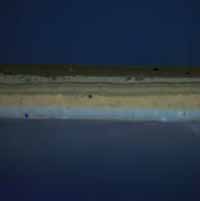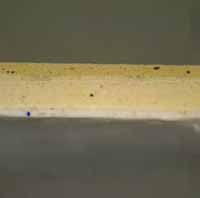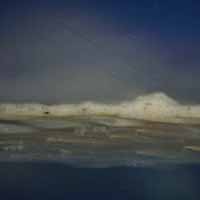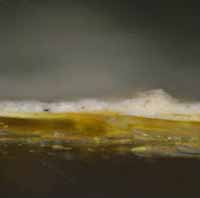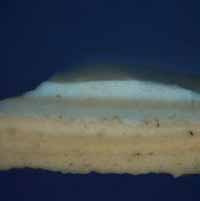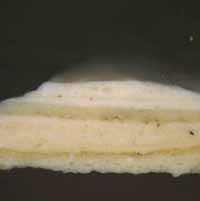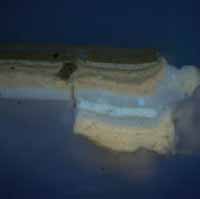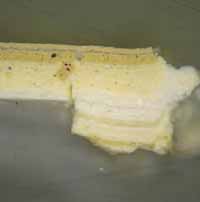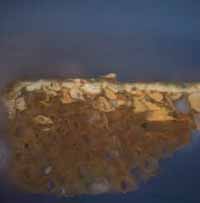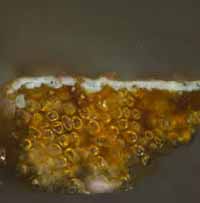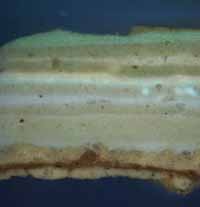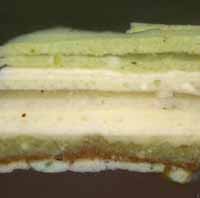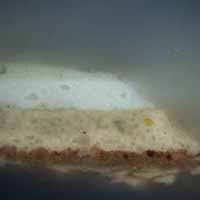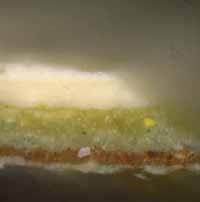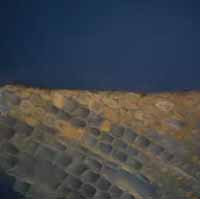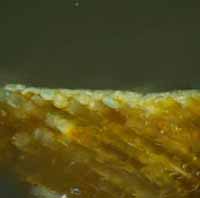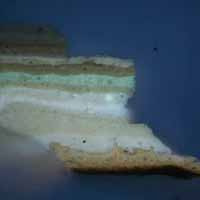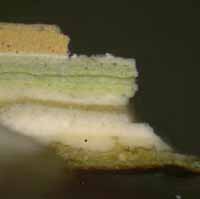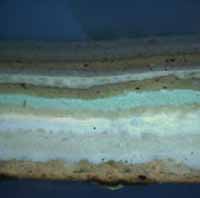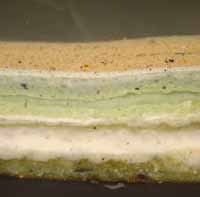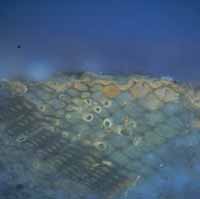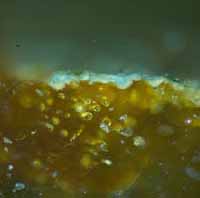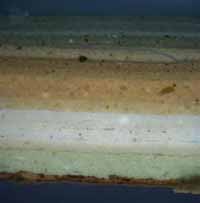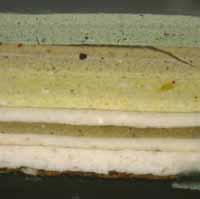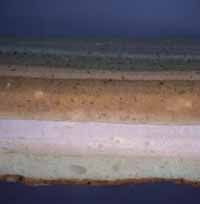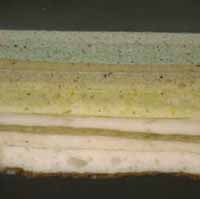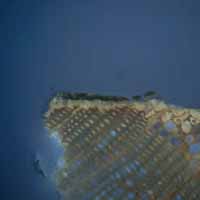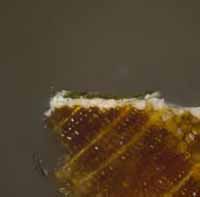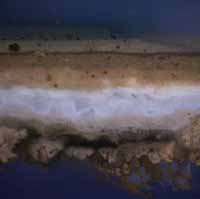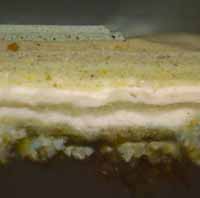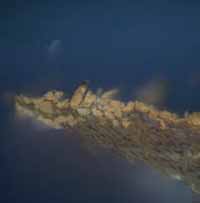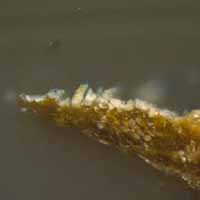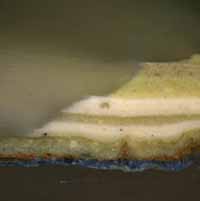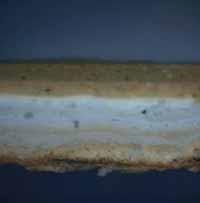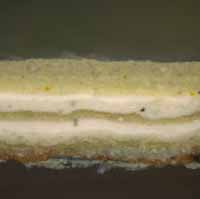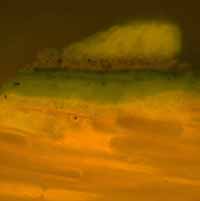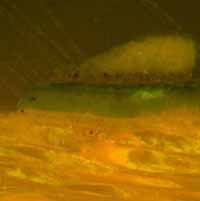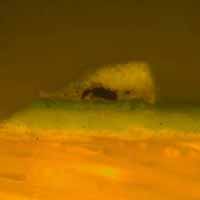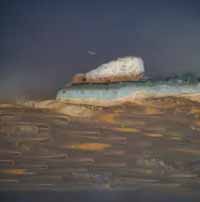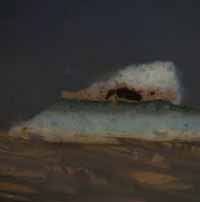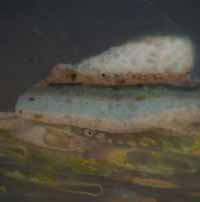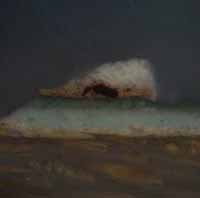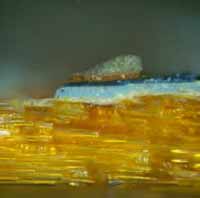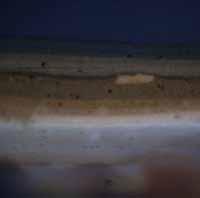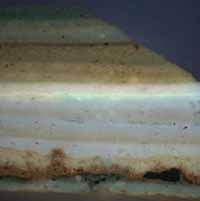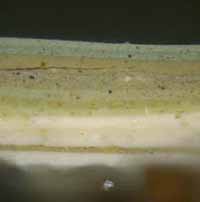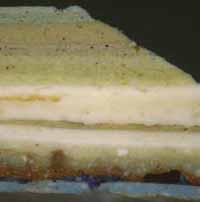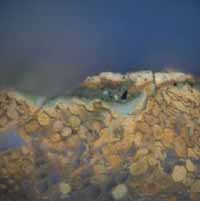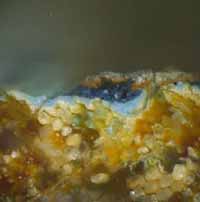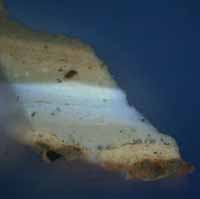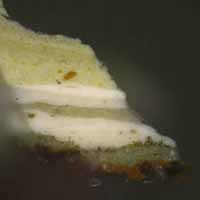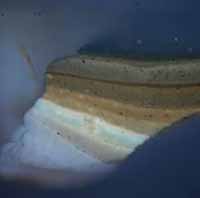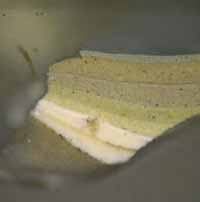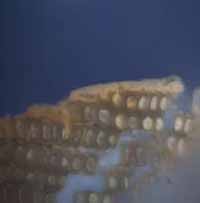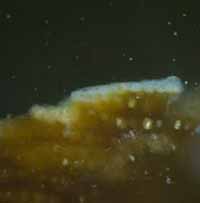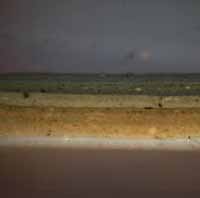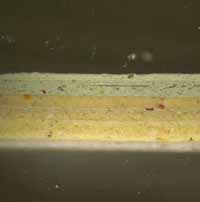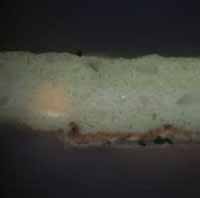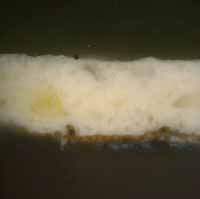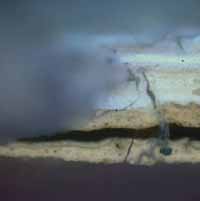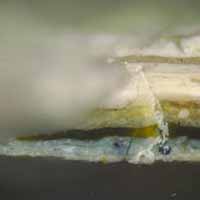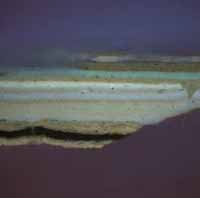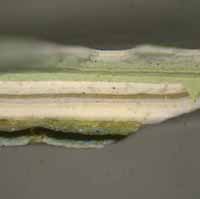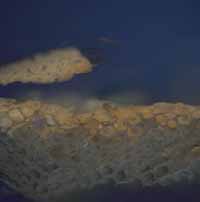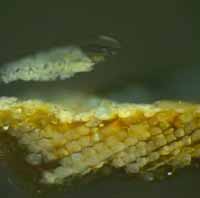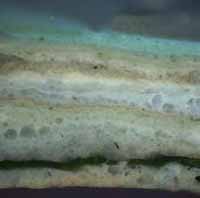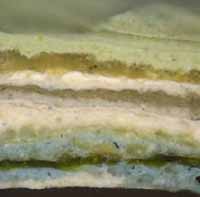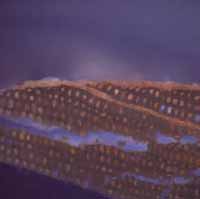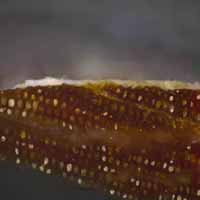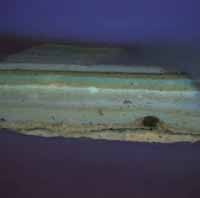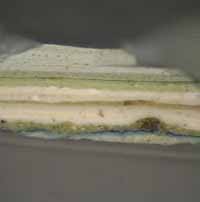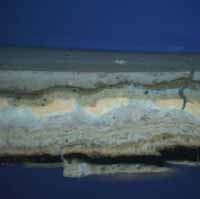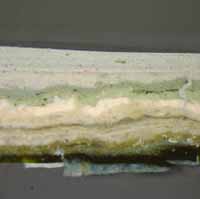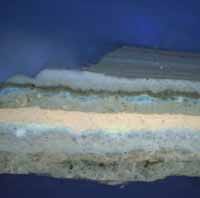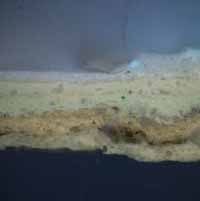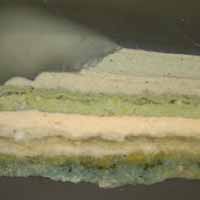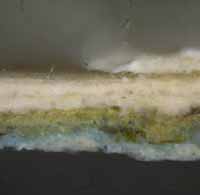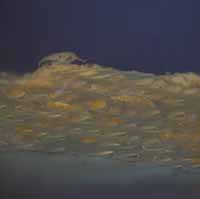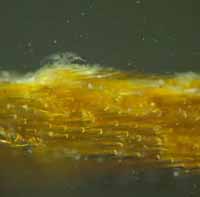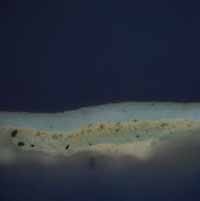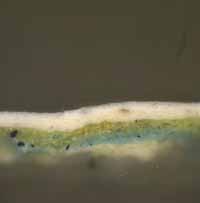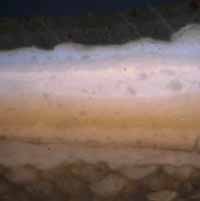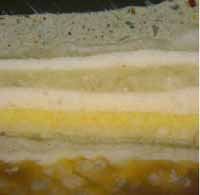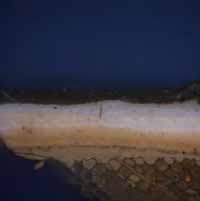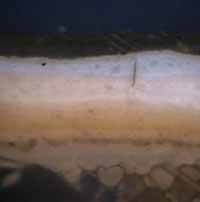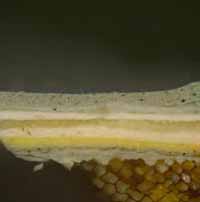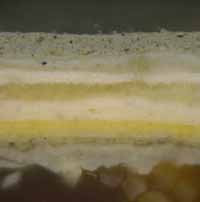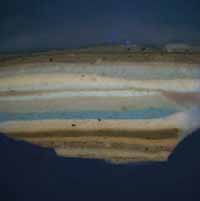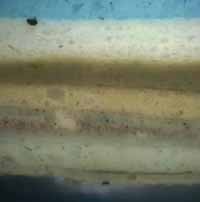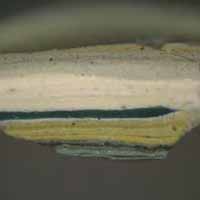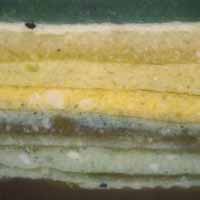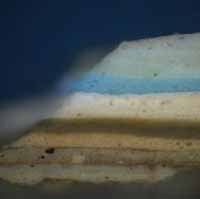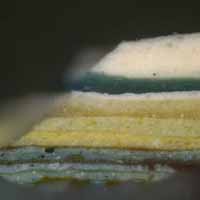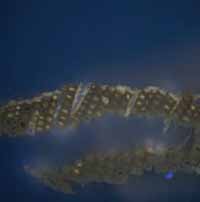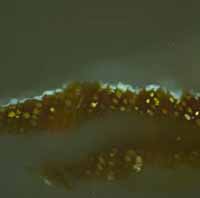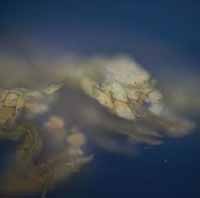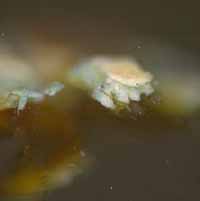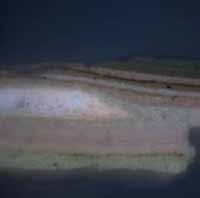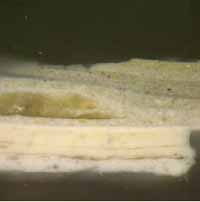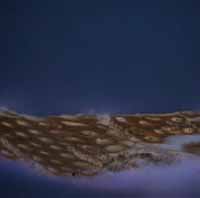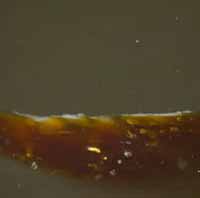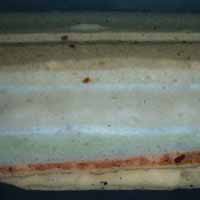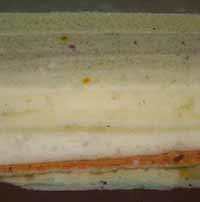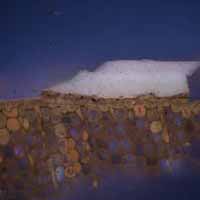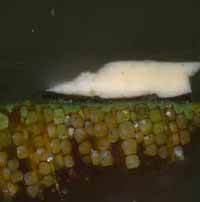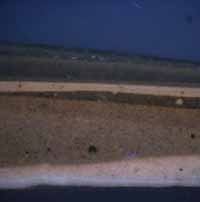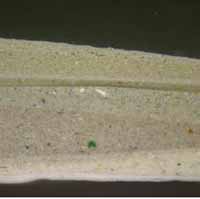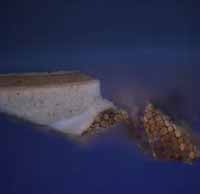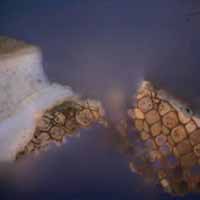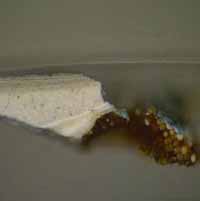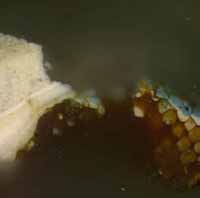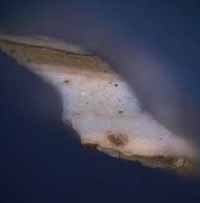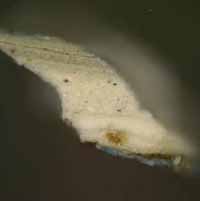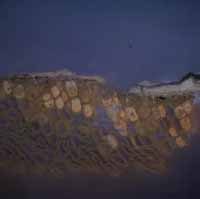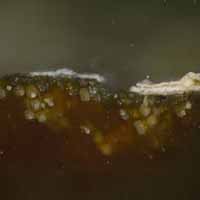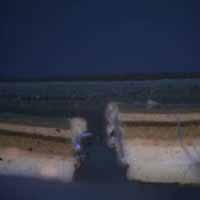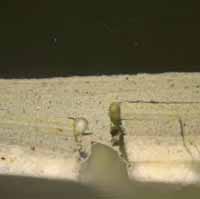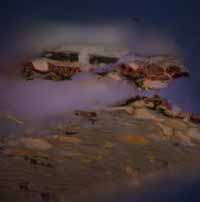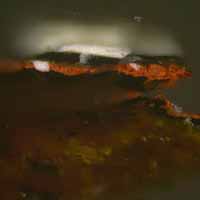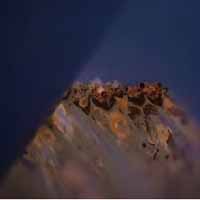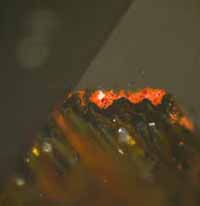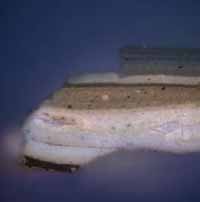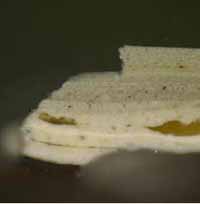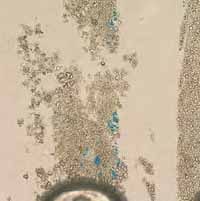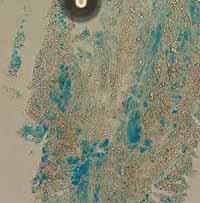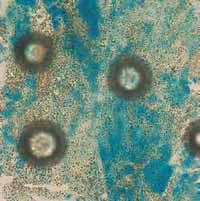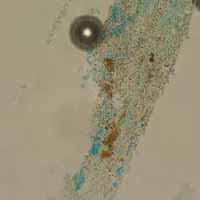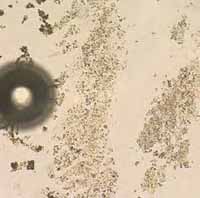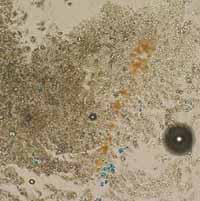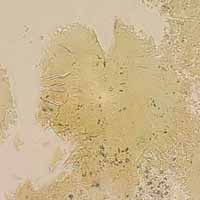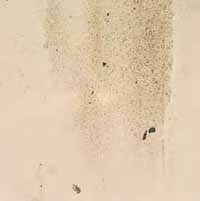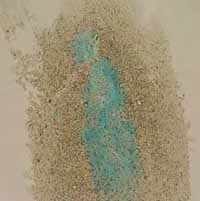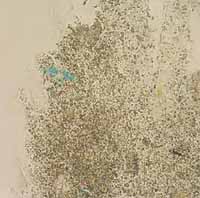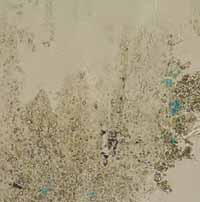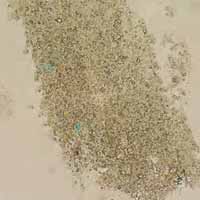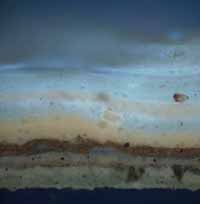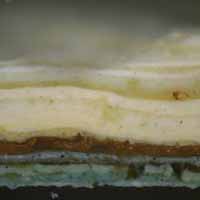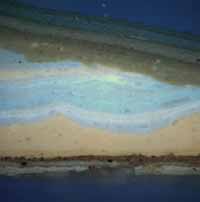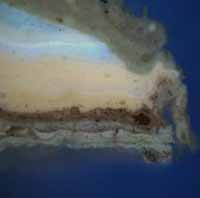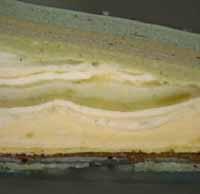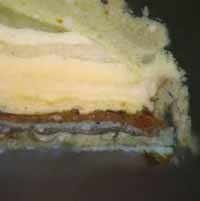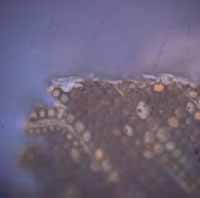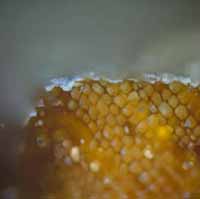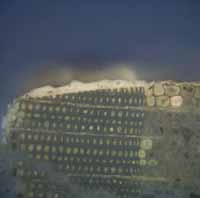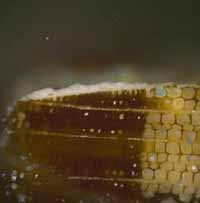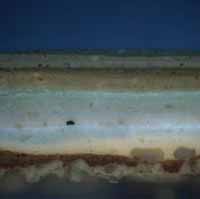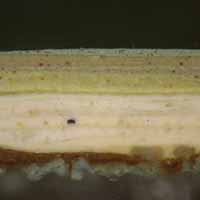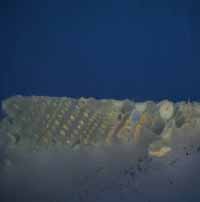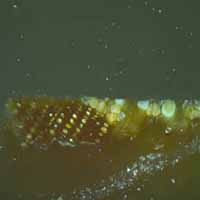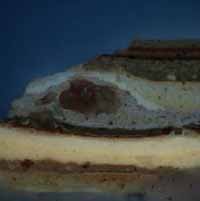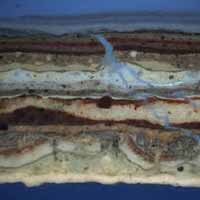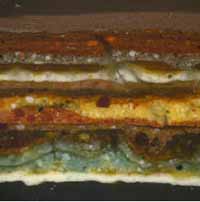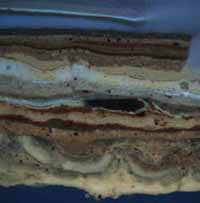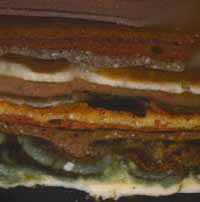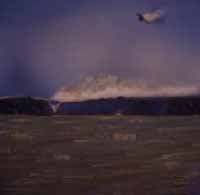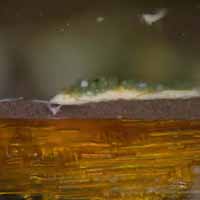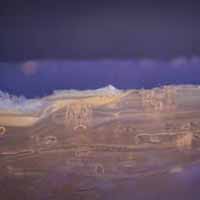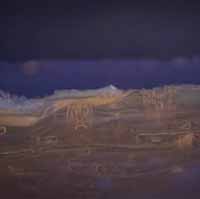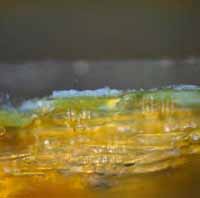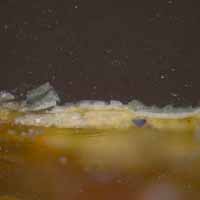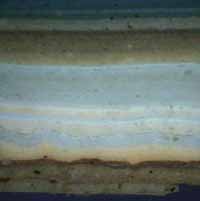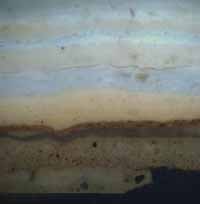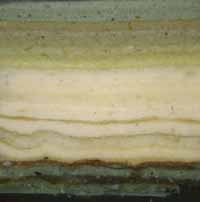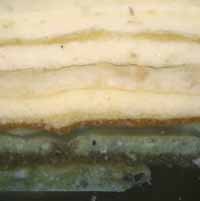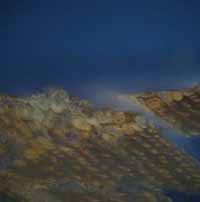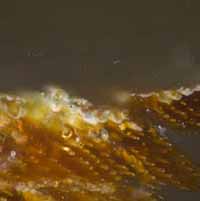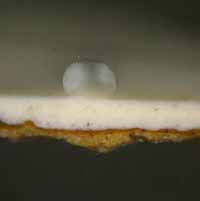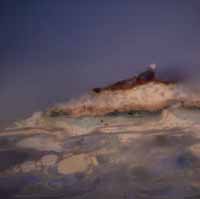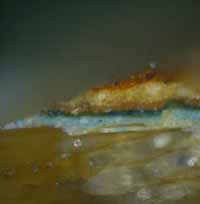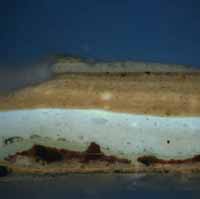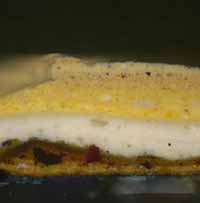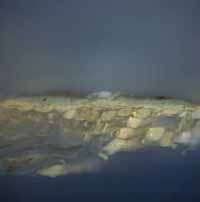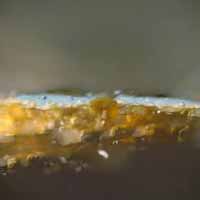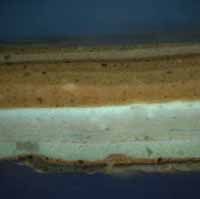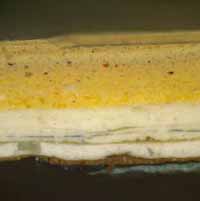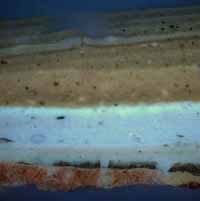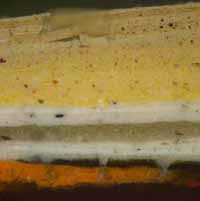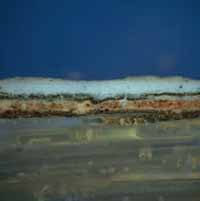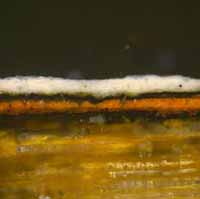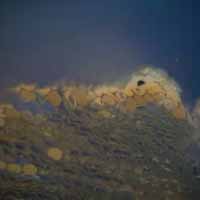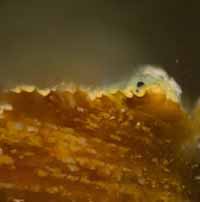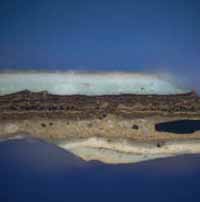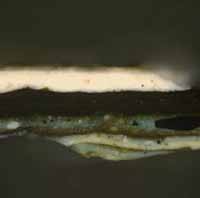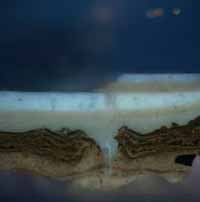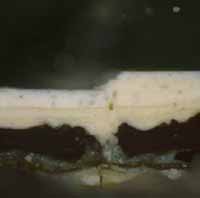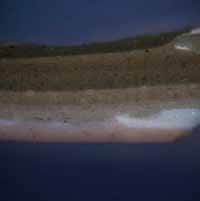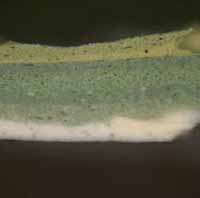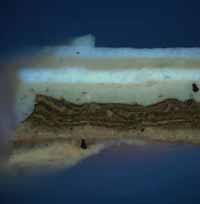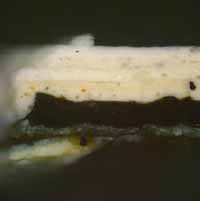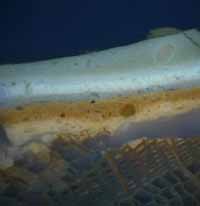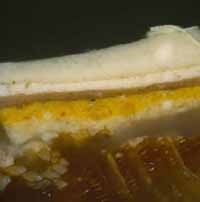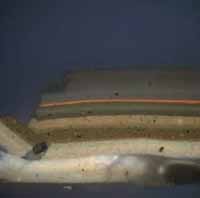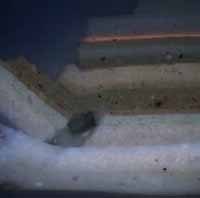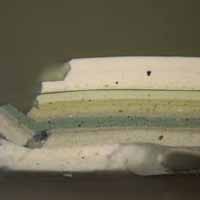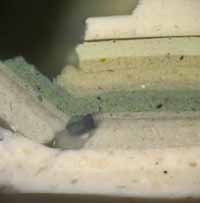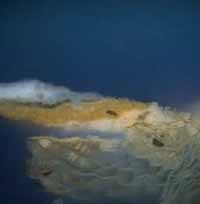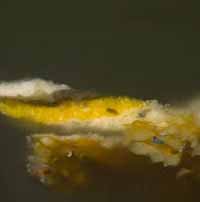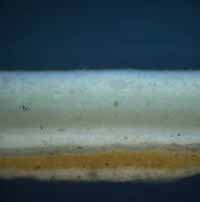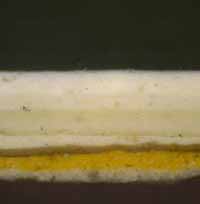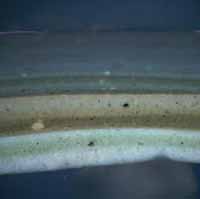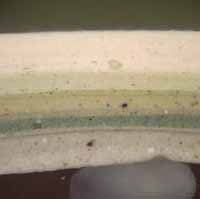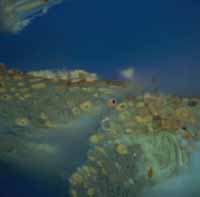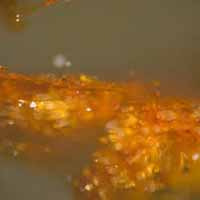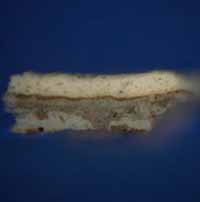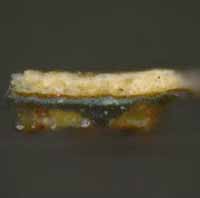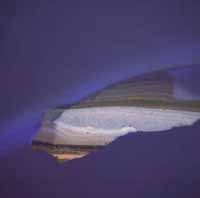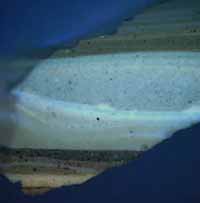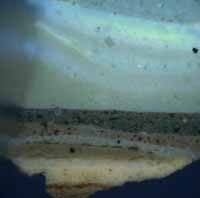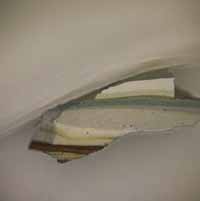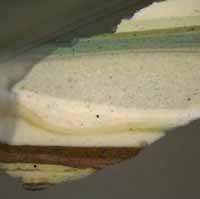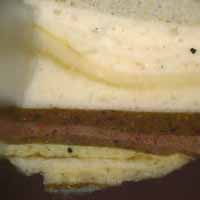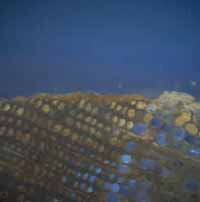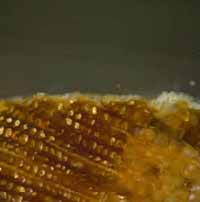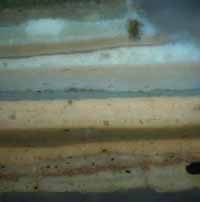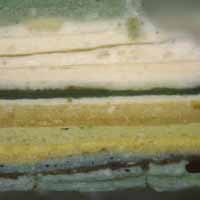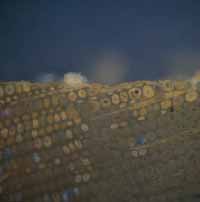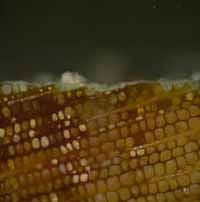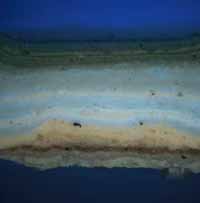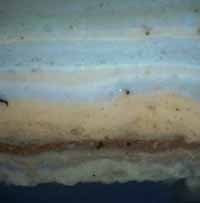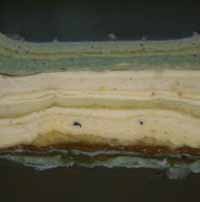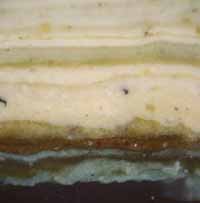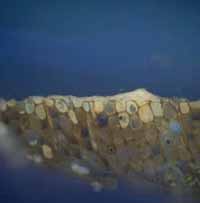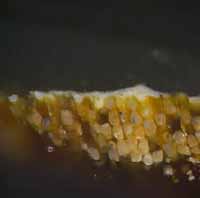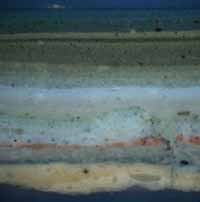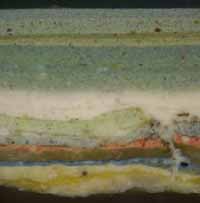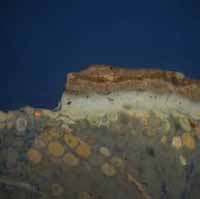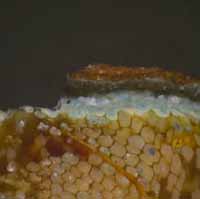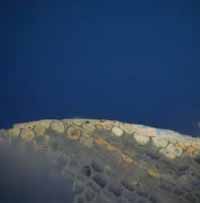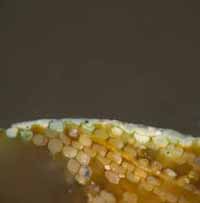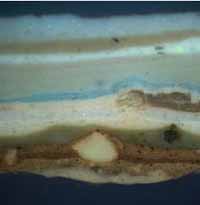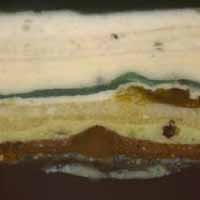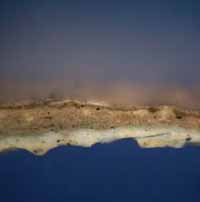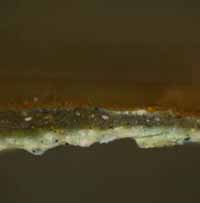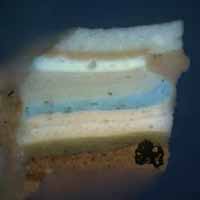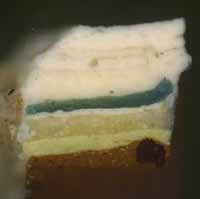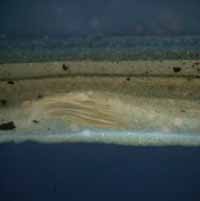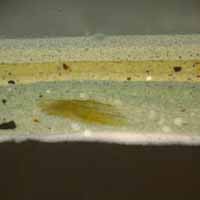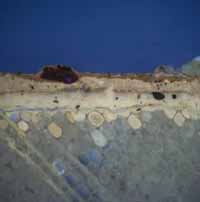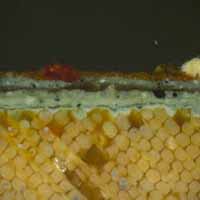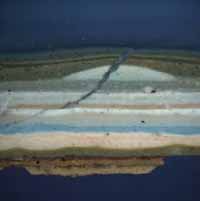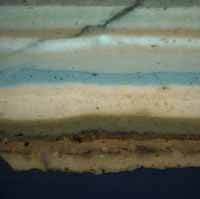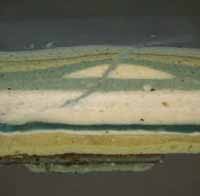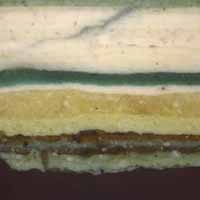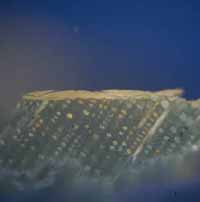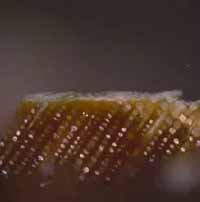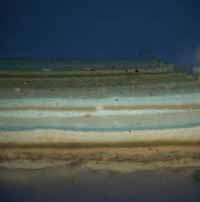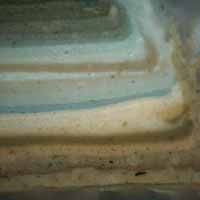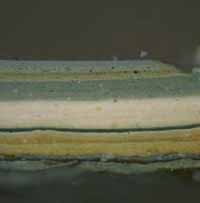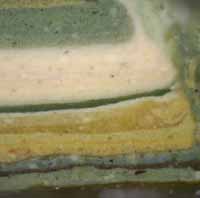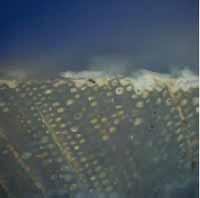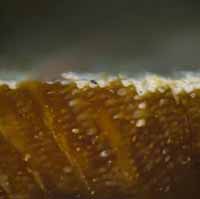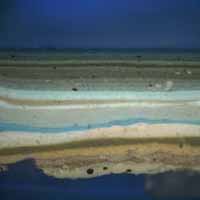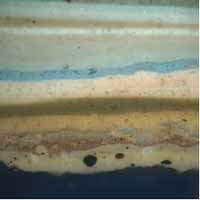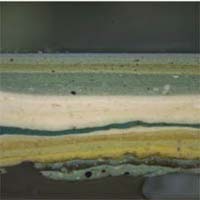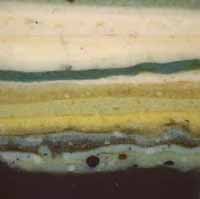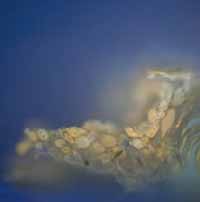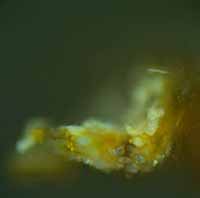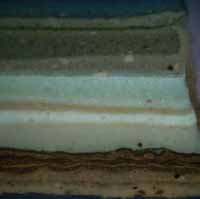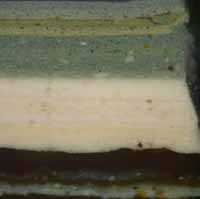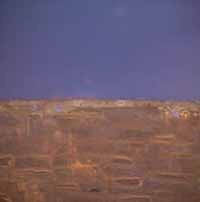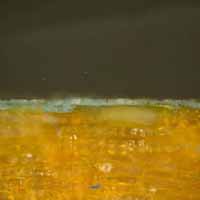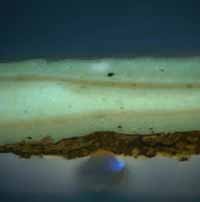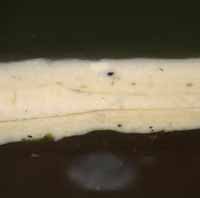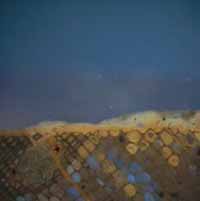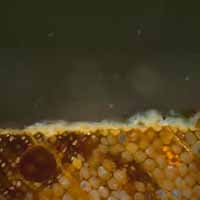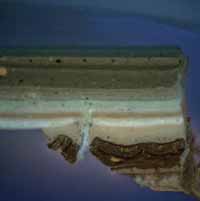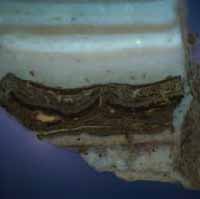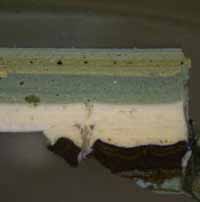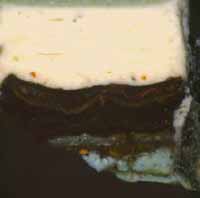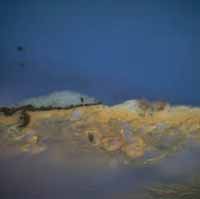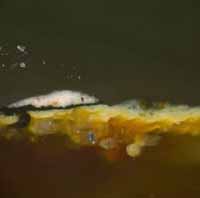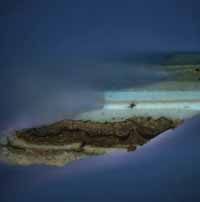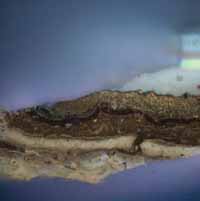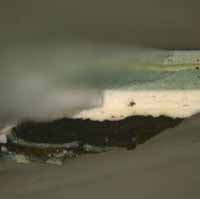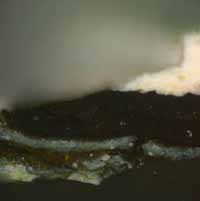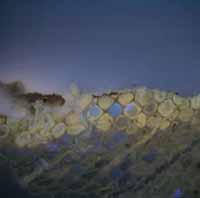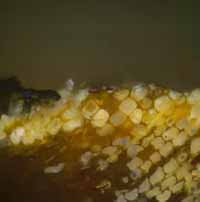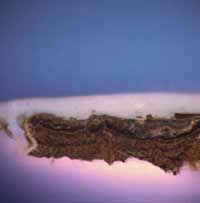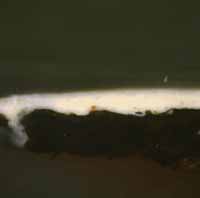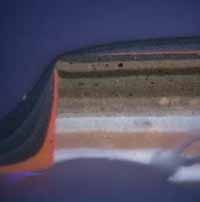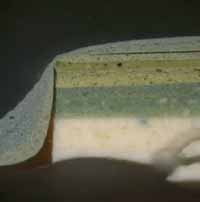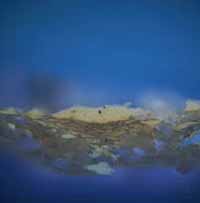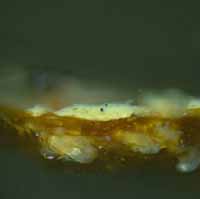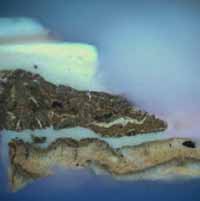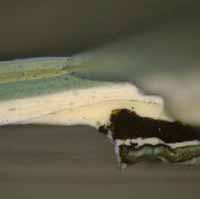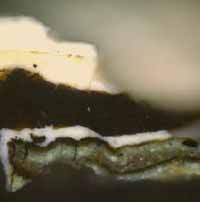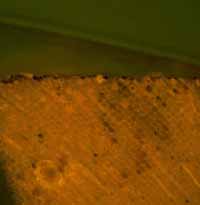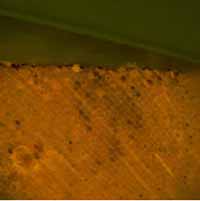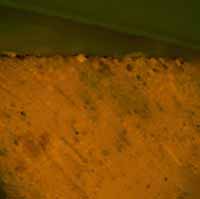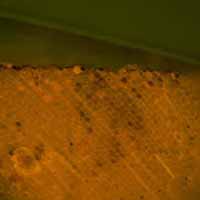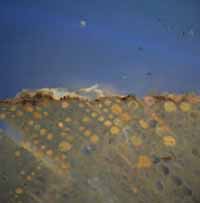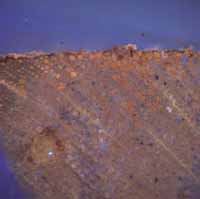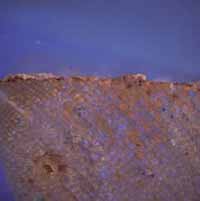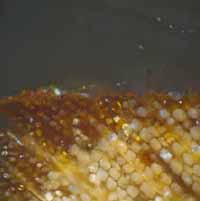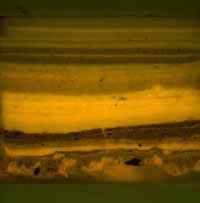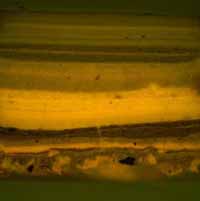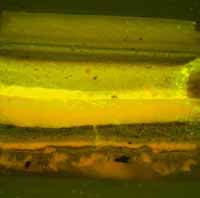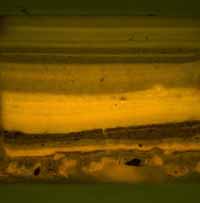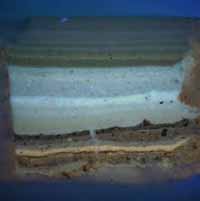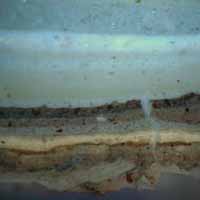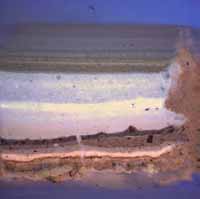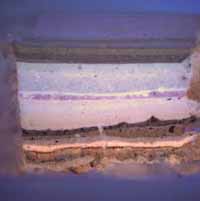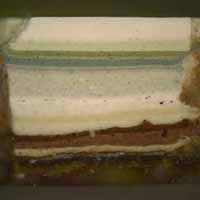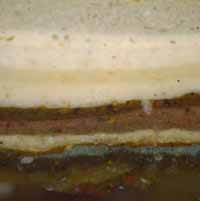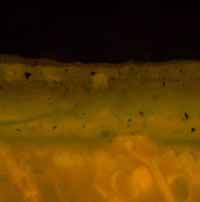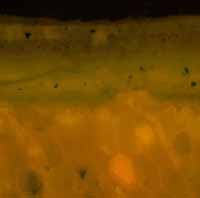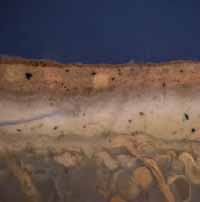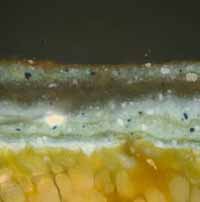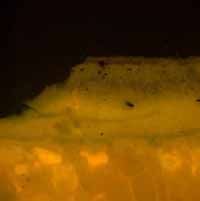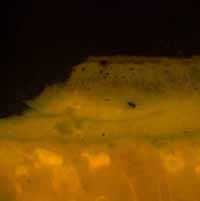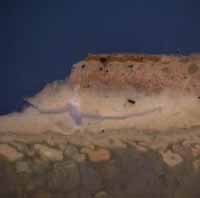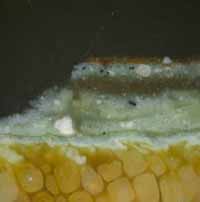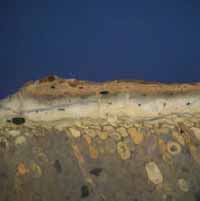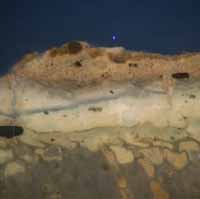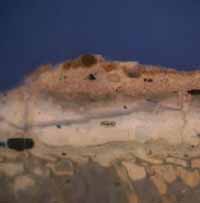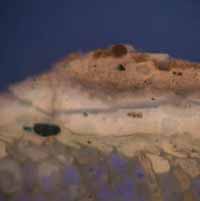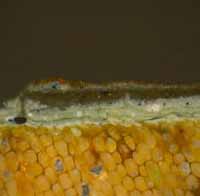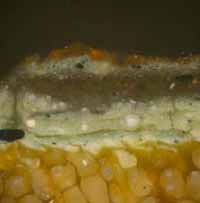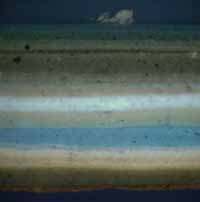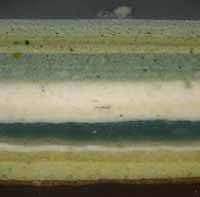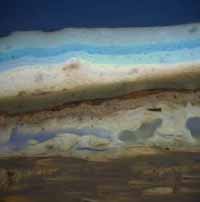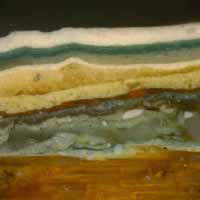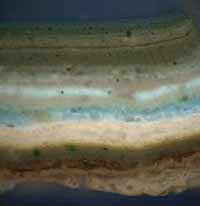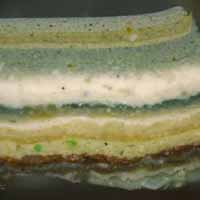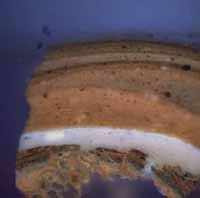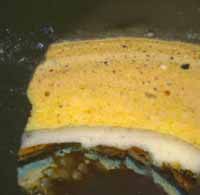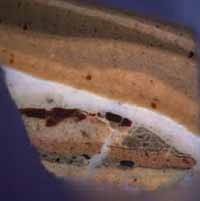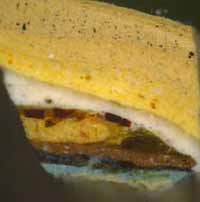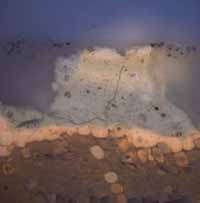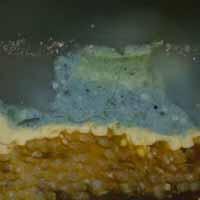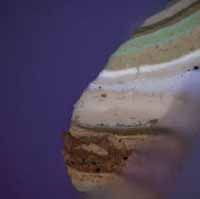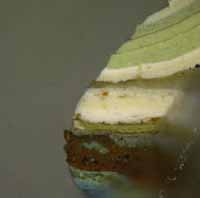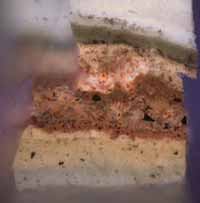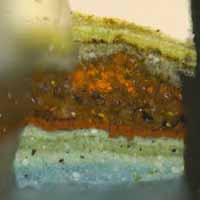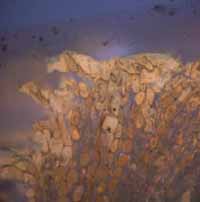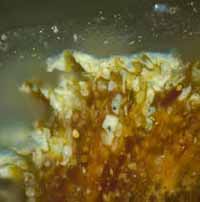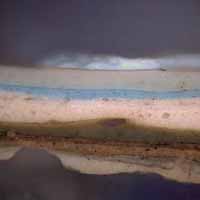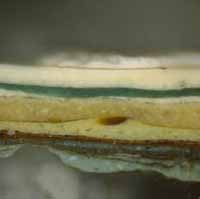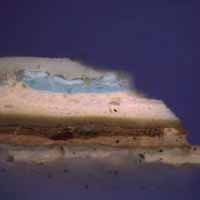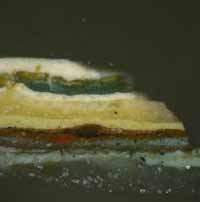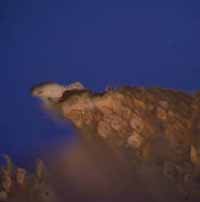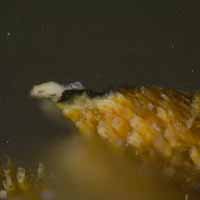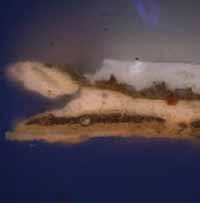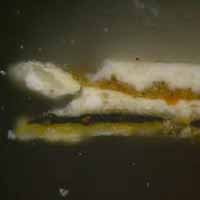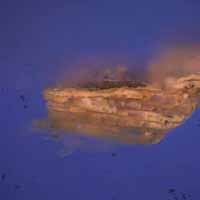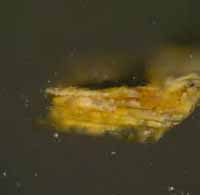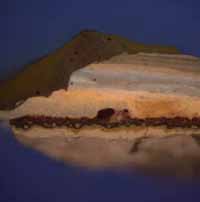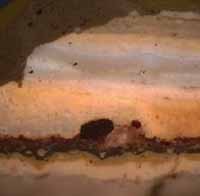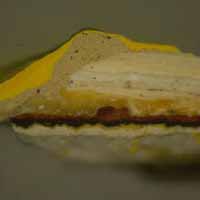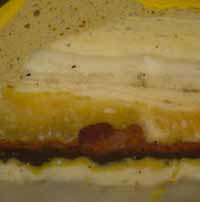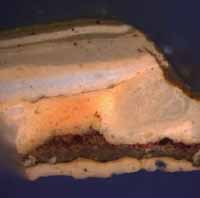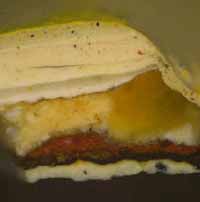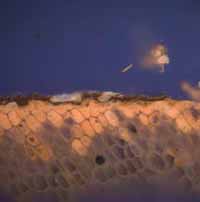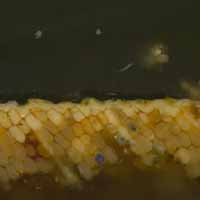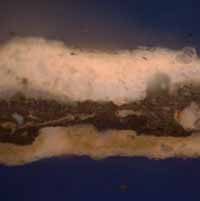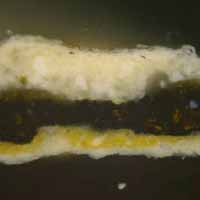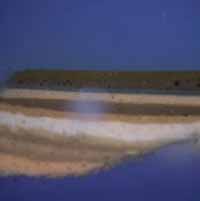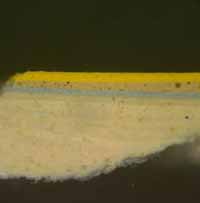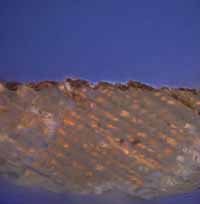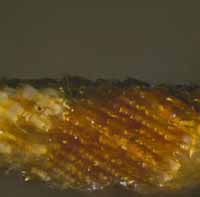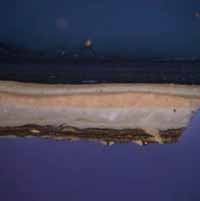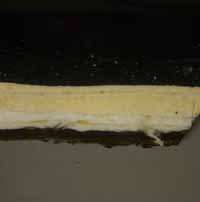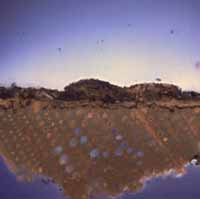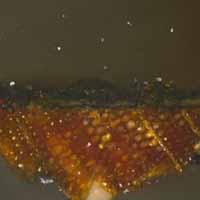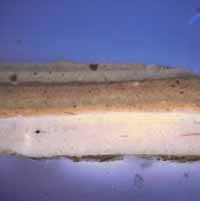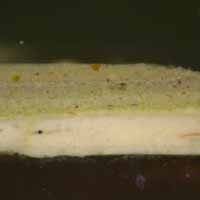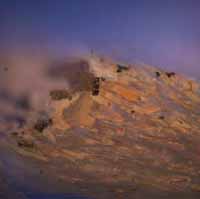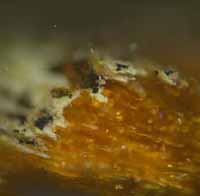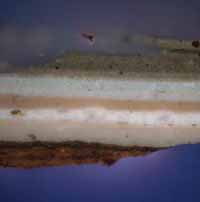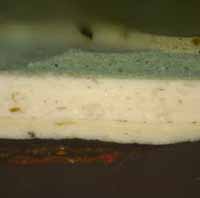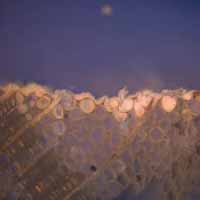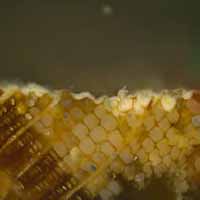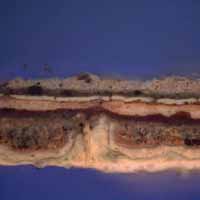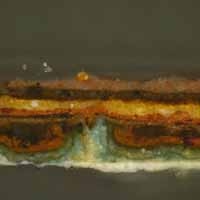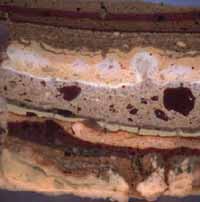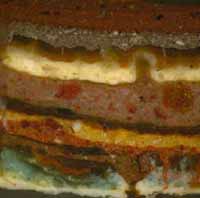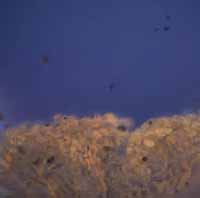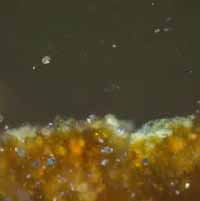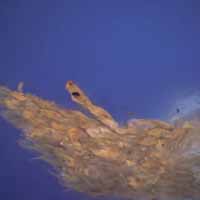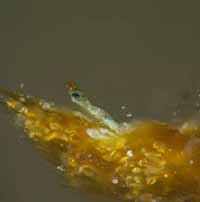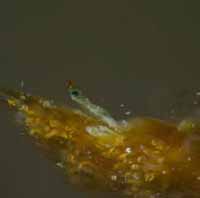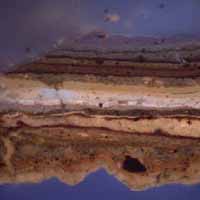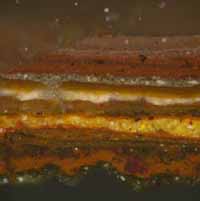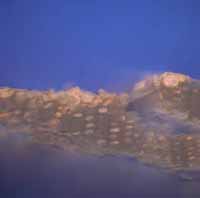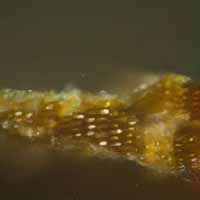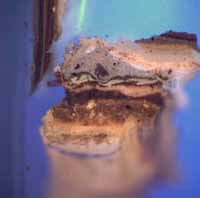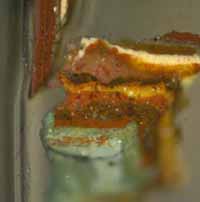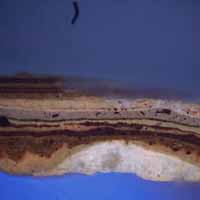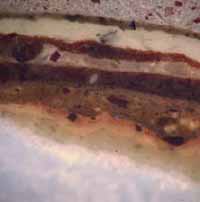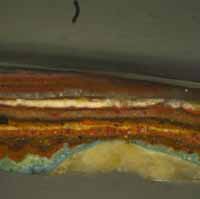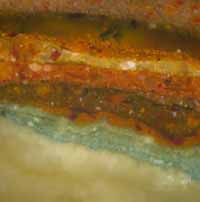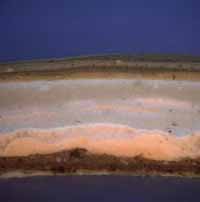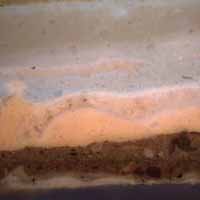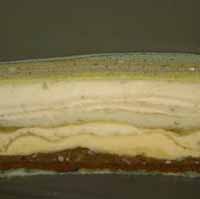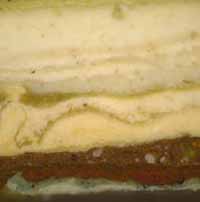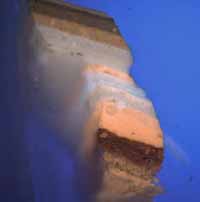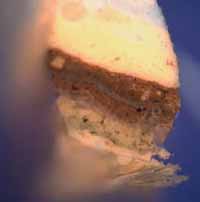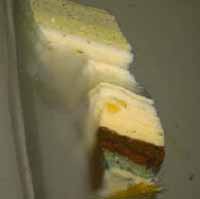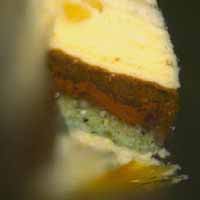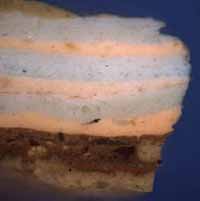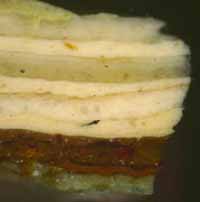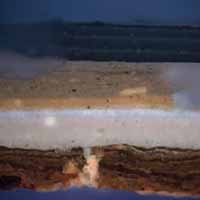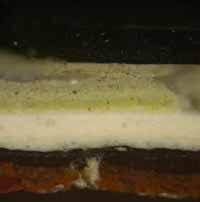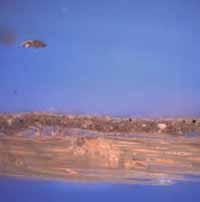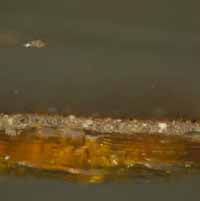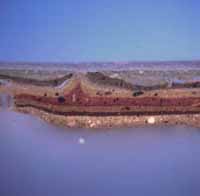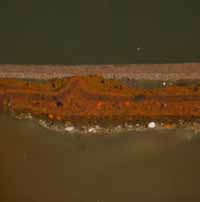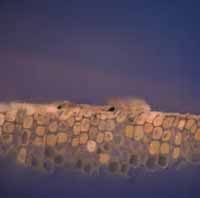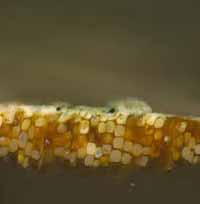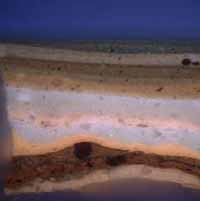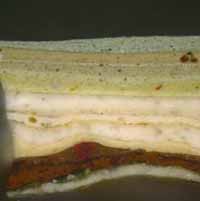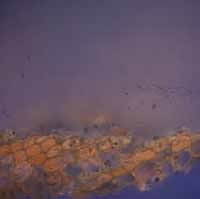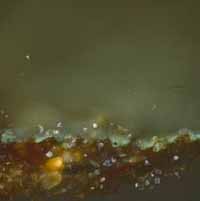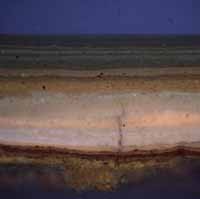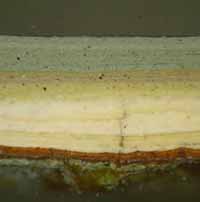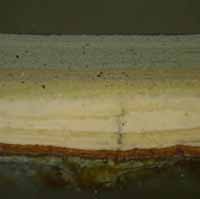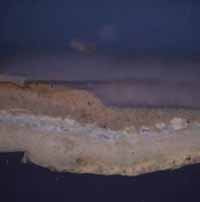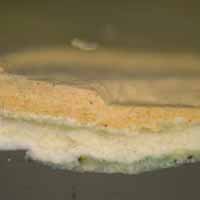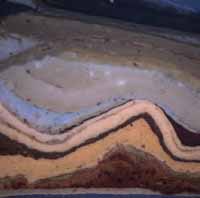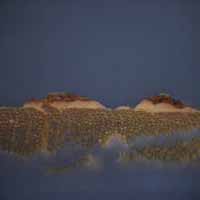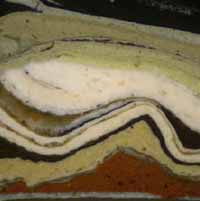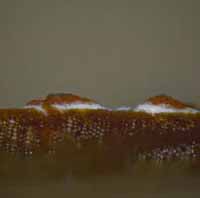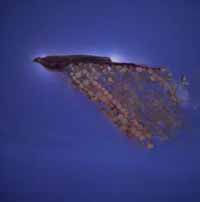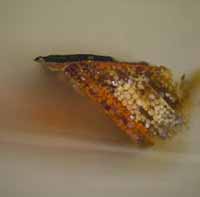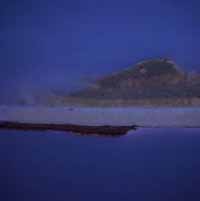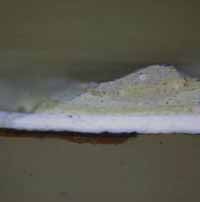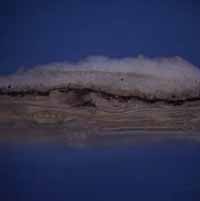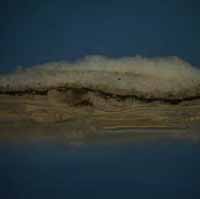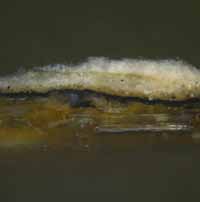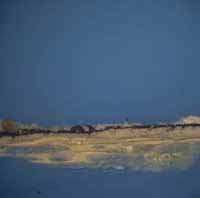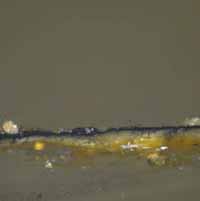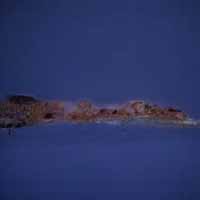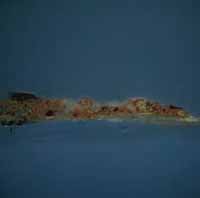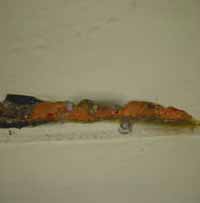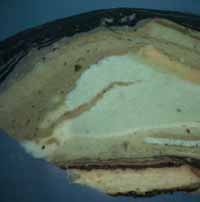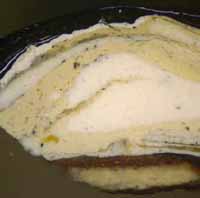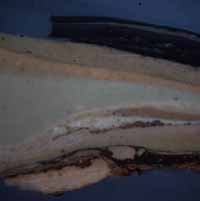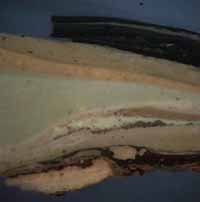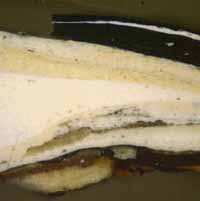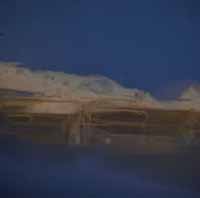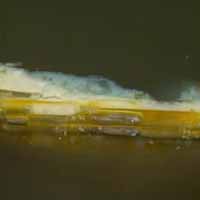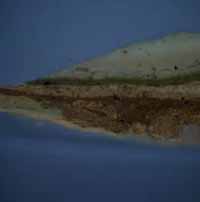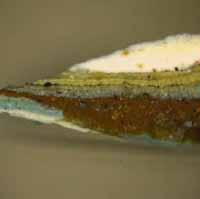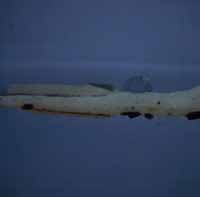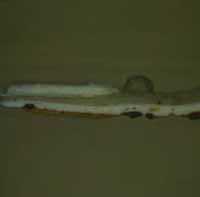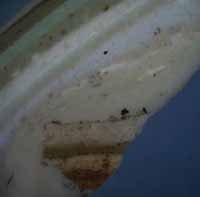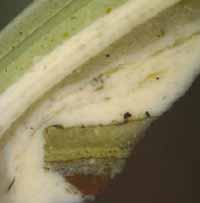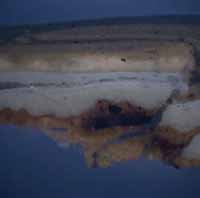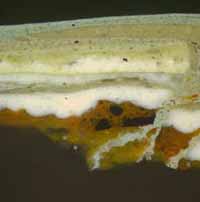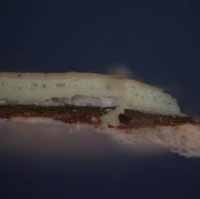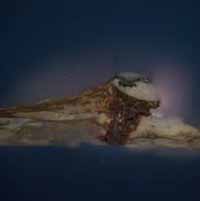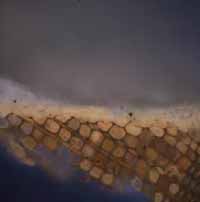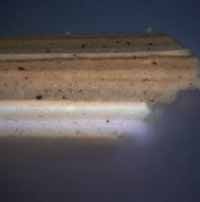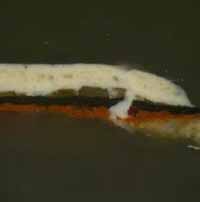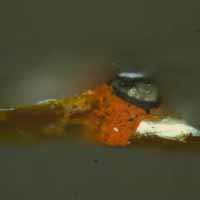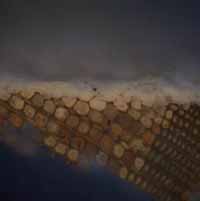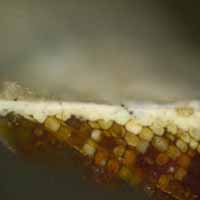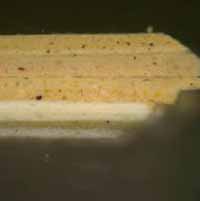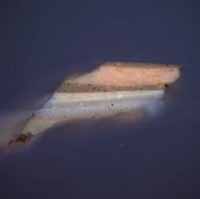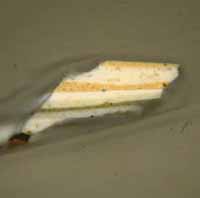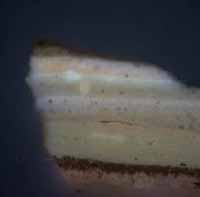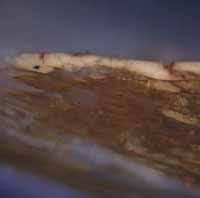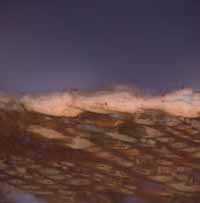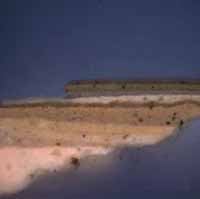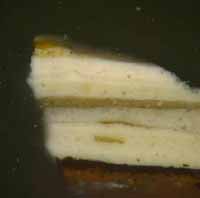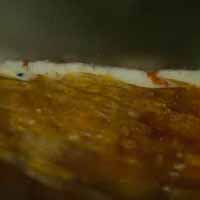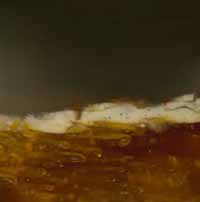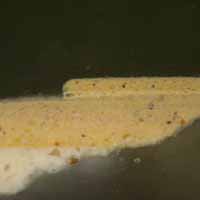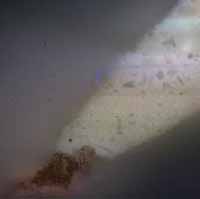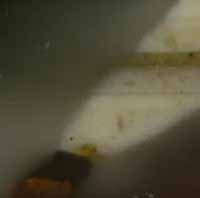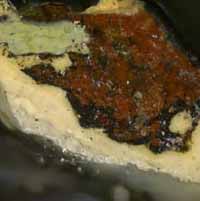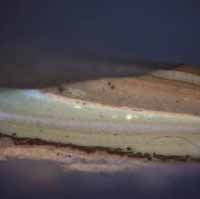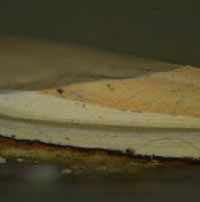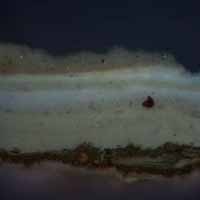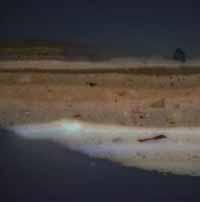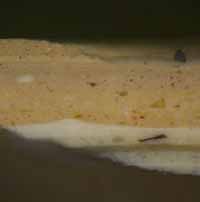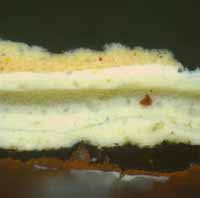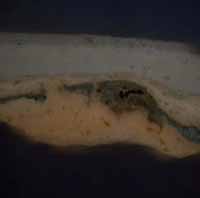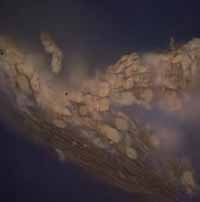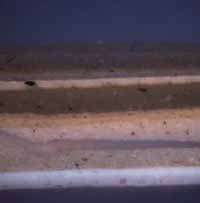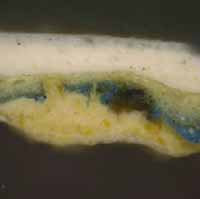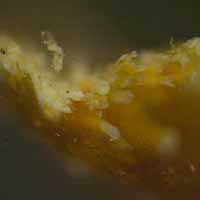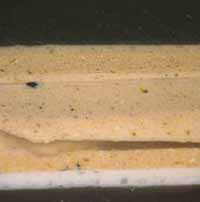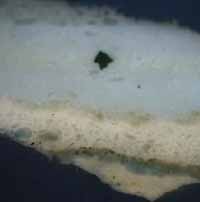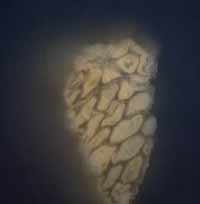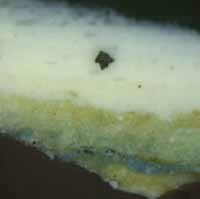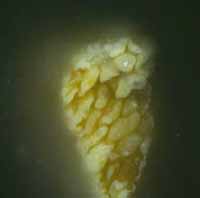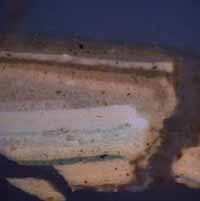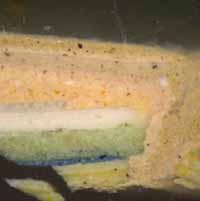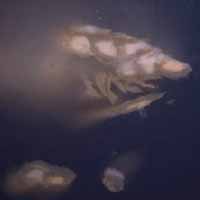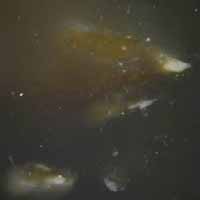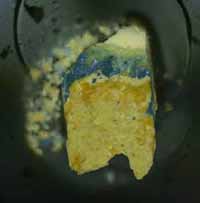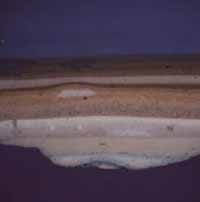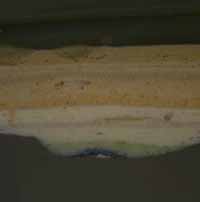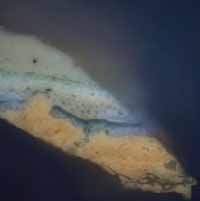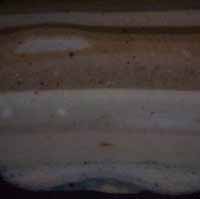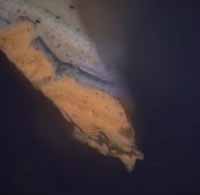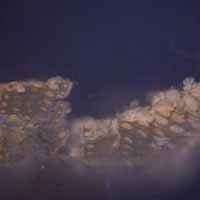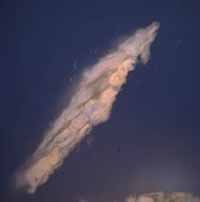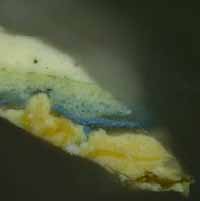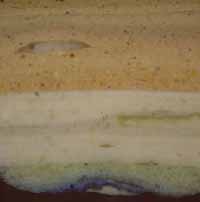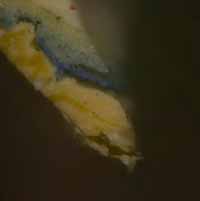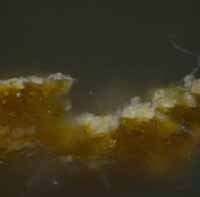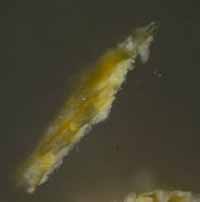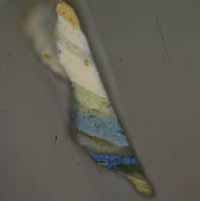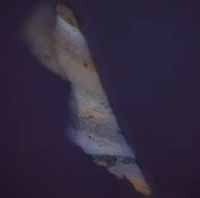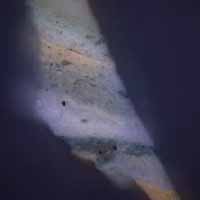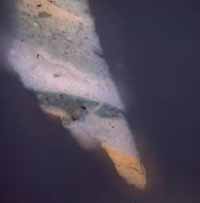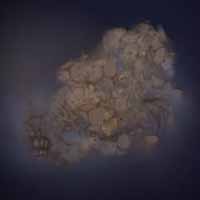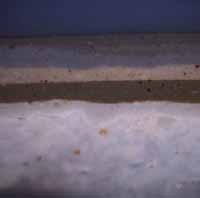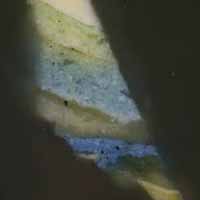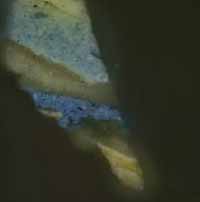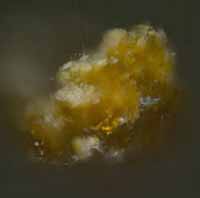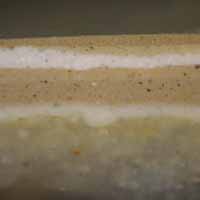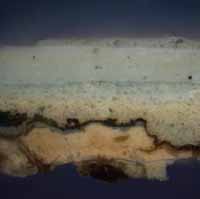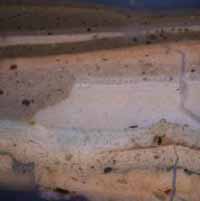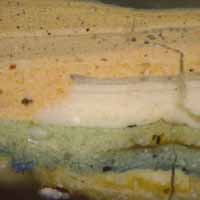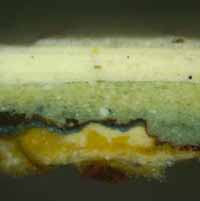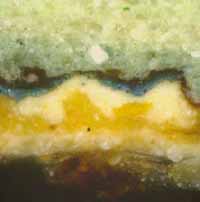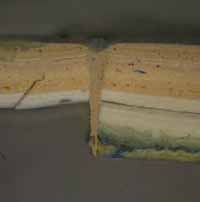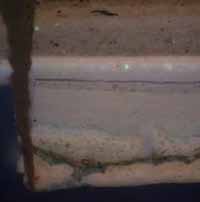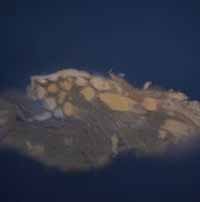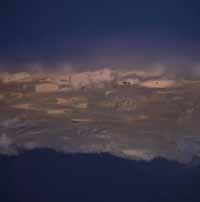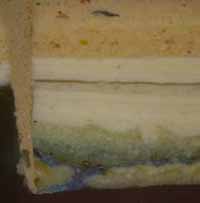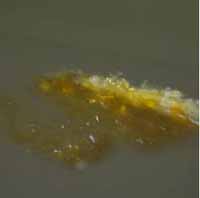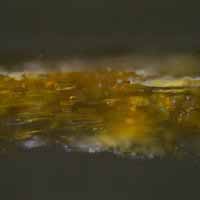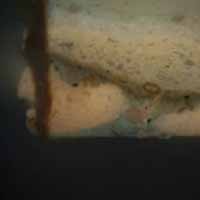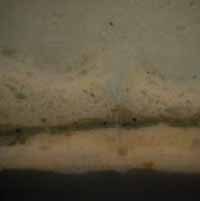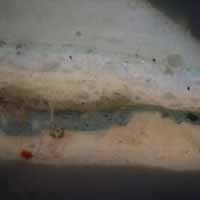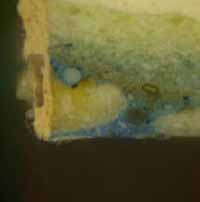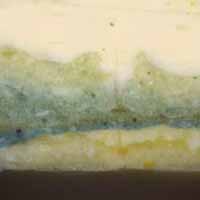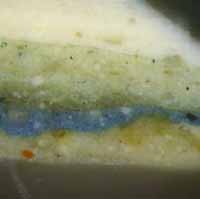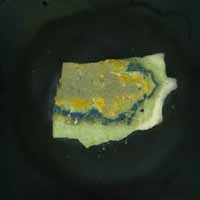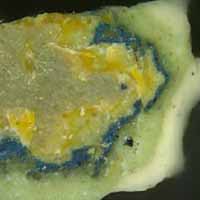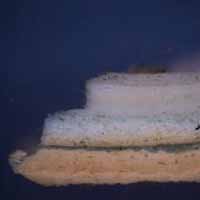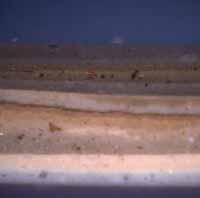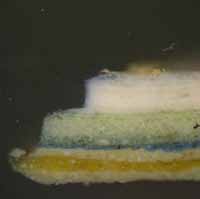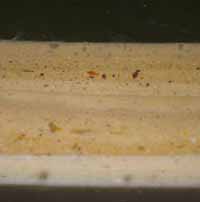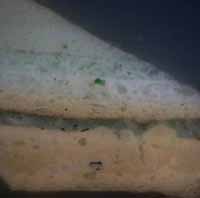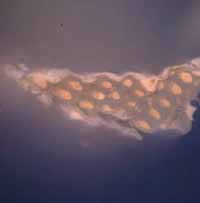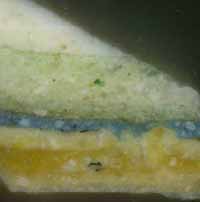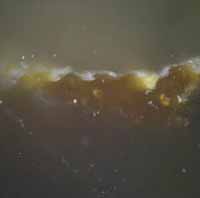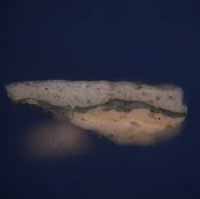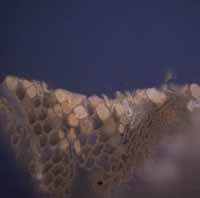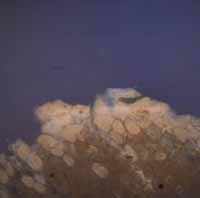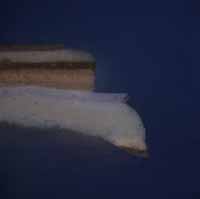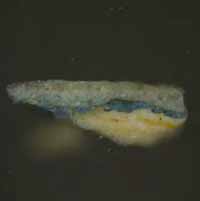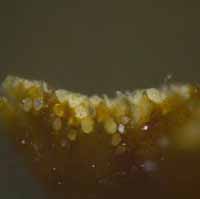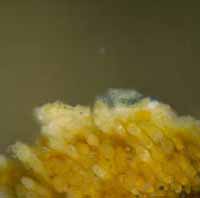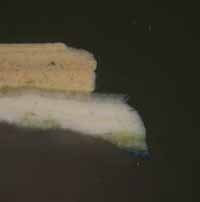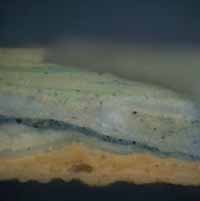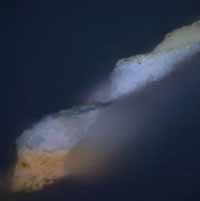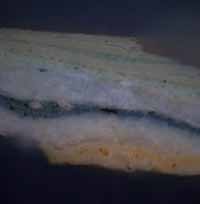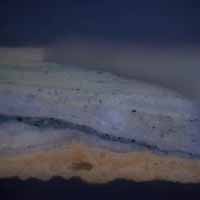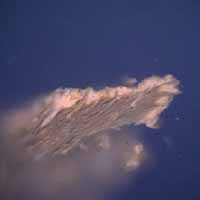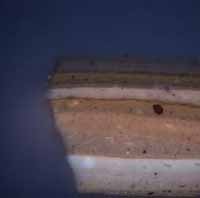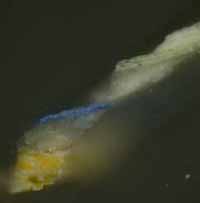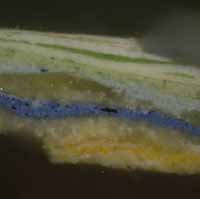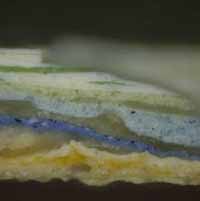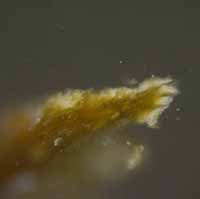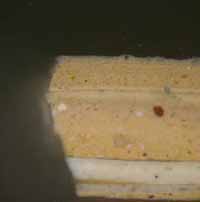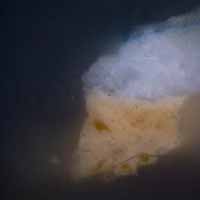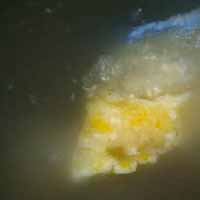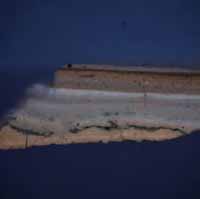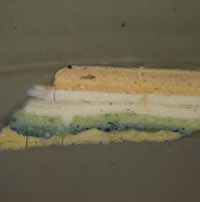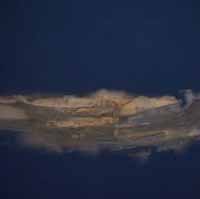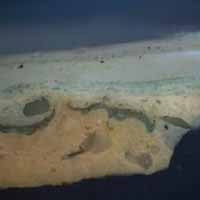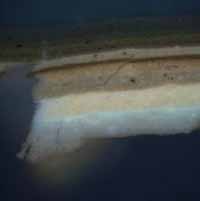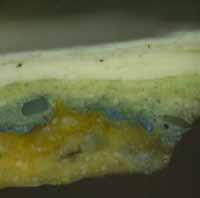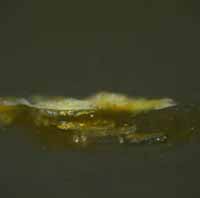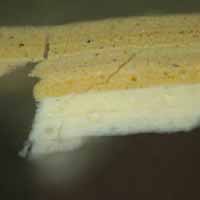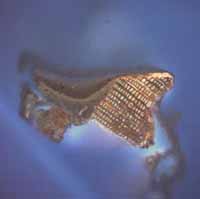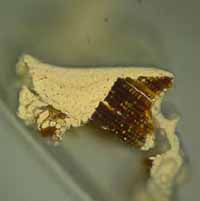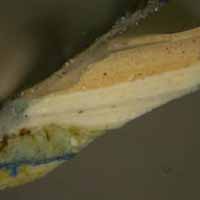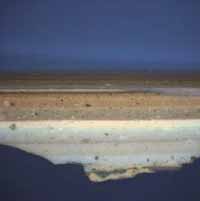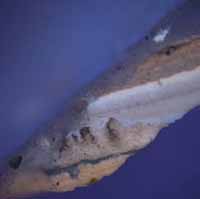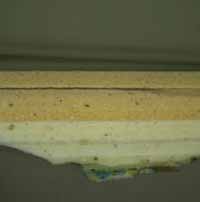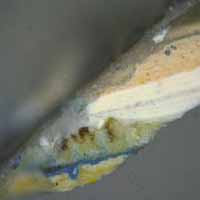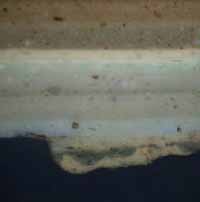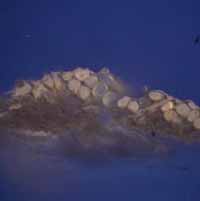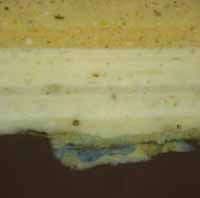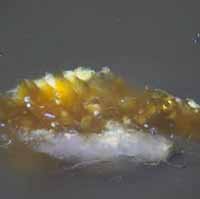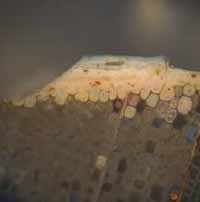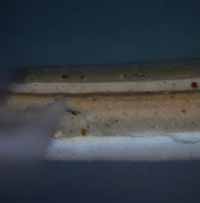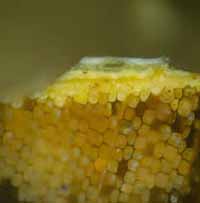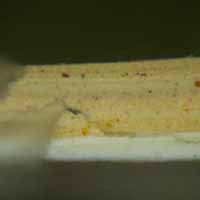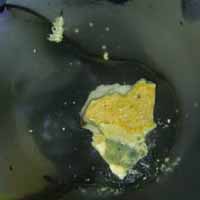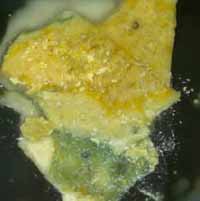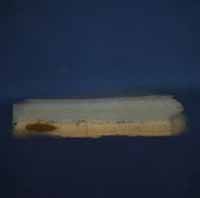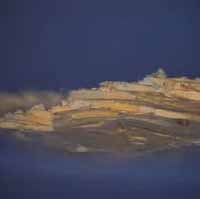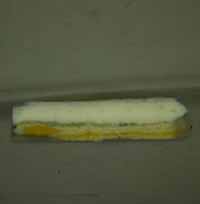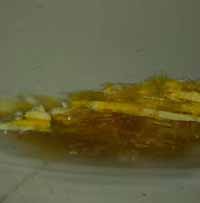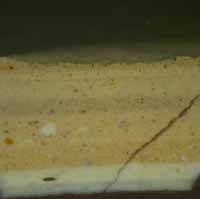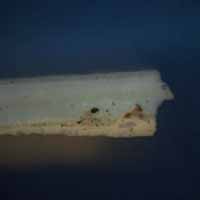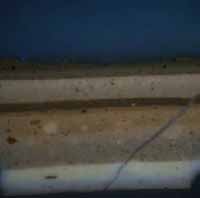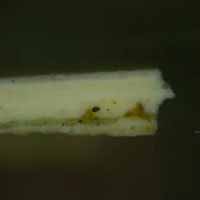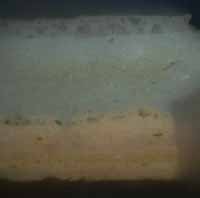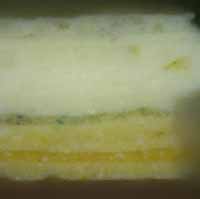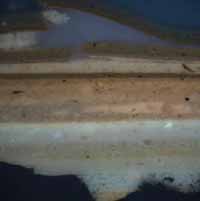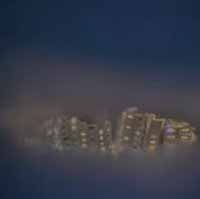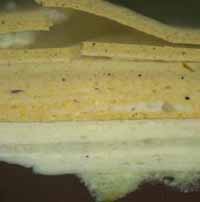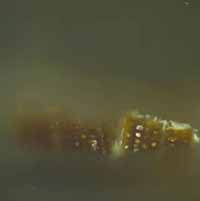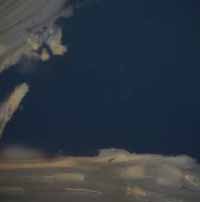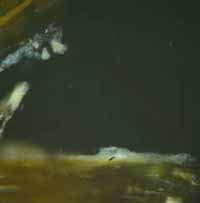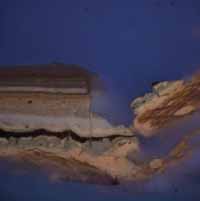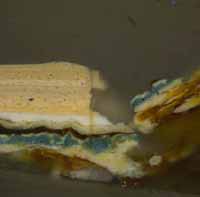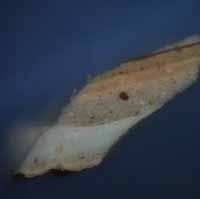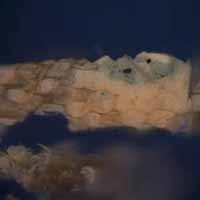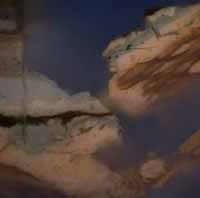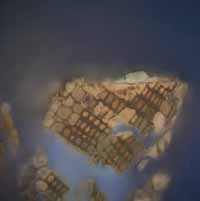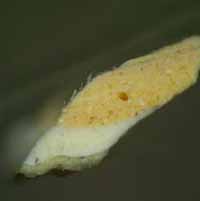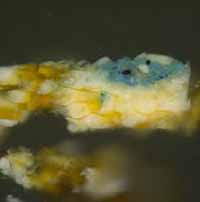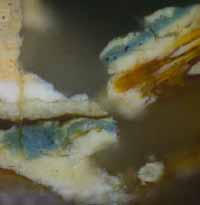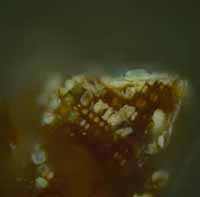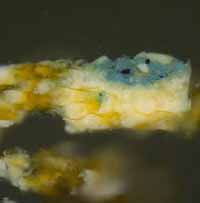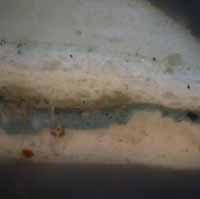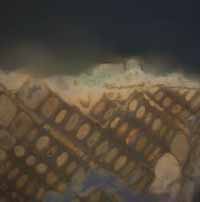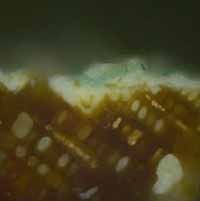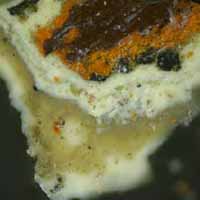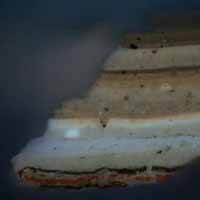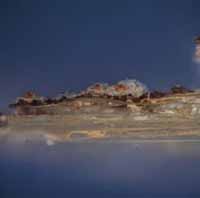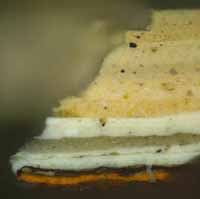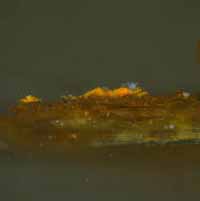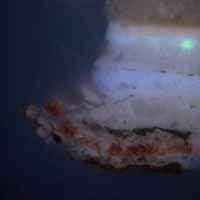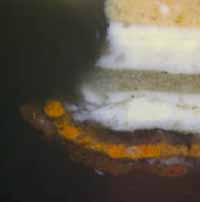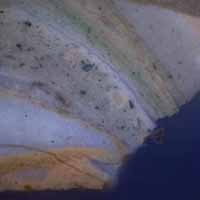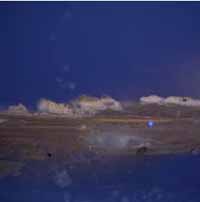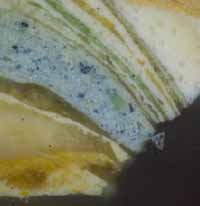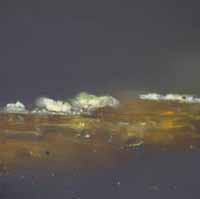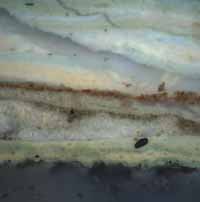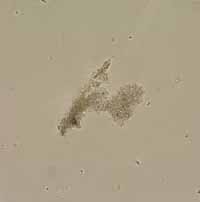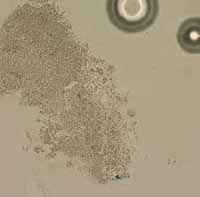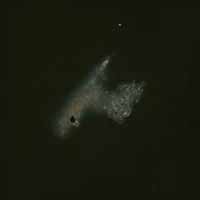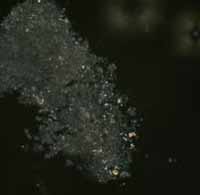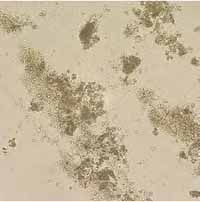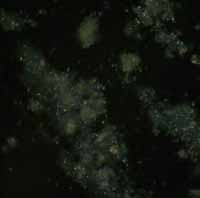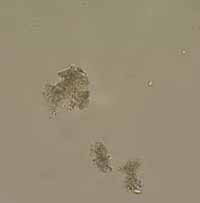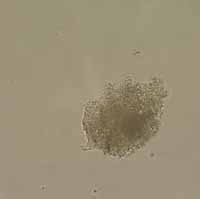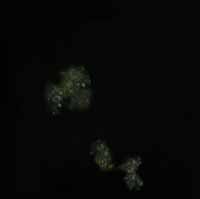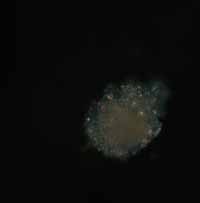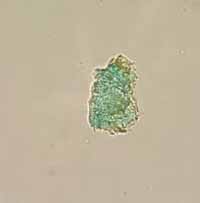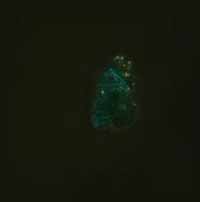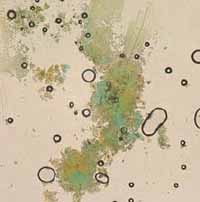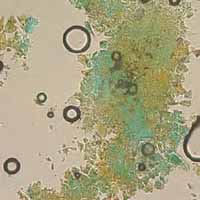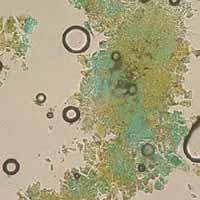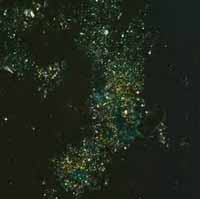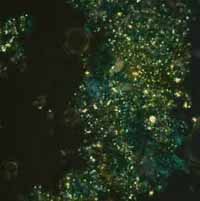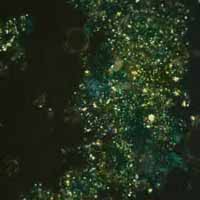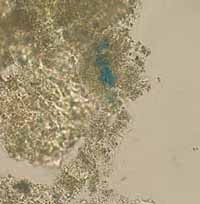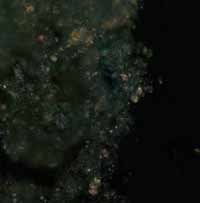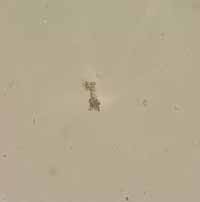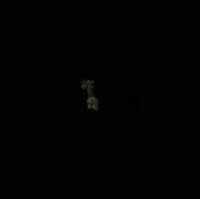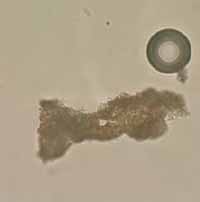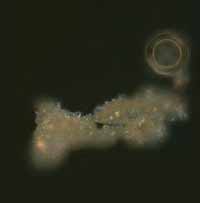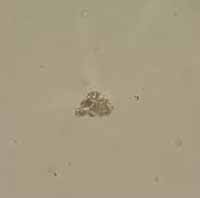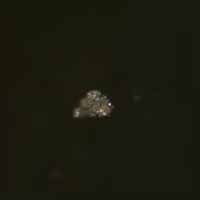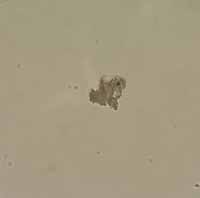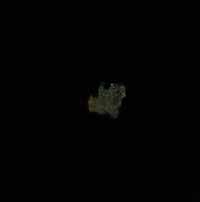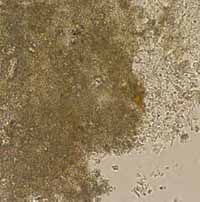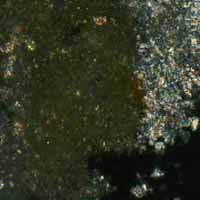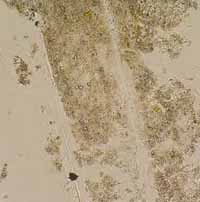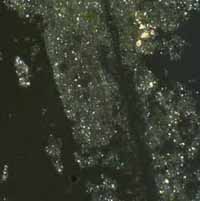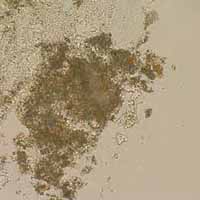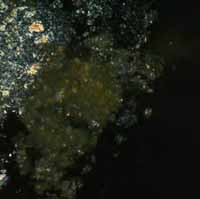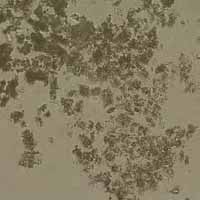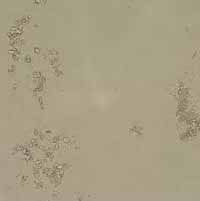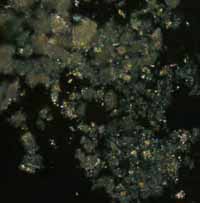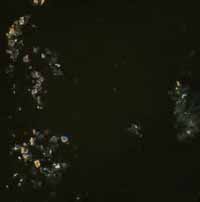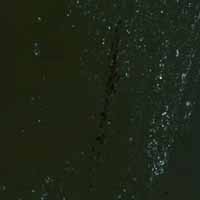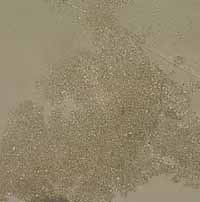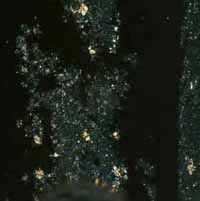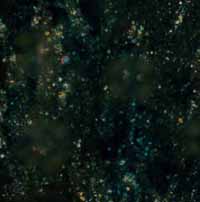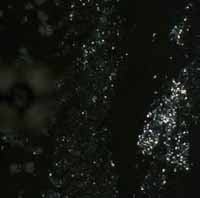Cross-section Microscopy Analysis : James Geddy House Interior Finishes (Block 19, Building 11), Williamsburg, VirginiaCross-section Microscopy Analysis Report: James Geddy House Interior Finishes (Block 19, Building 11)
Colonial Williamsburg Foundation Library Research Report Series - 1745
Colonial Williamsburg Foundation Library
Williamsburg, Virginia
2013
CROSS-SECTION MICROSCOPY ANALYSIS REPORT
JAMES GEDDY HOUSE, INTERIOR FINISHES
Block 19, Building 11
COLONIAL WILLIAMSBURG FOUNDATION
WILLIAMSBURG, VIRGINIA
Table of Contents
| Purpose | 5 |
| History | 5 |
| Previous Research | 5 |
| Procedures | 6 |
| Results | 6 |
| Table 1. James Geddy House, Early Interior Paint History | 8 |
| Parlor (Southwest First-Floor Room) | |
| Floor Plan and Sample List | 9 |
| Summary of Results | 10 |
| Table 2. Parlor Paint History | 12 |
| Paint Sample Location Images | 13 |
| Cross-Section Photomicrographs | 16 |
| Binding Media Analysis | 31 |
| Pigment Identification | 35 |
| Colorimetry | 39 |
| Dining Room (Northwest First-Floor Room) | |
| Floor Plan and Sample List | 43 |
| Summary of Results | 44 |
| Table 3. Dining Room Paint History | 45 |
| Paint Sample Location Images | 46 |
| Cross-Section Photomicrographs | 50 |
| Binding Media Analysis | 70 |
| Pigment Identification | 72 |
| Colorimetry | 75 |
| First-floor Southeast Chamber | |
| Floor Plan and Sample List | 80 |
| Summary of Results | 81 |
| Table 4. First-floor SE Chamber Paint History | 83 |
| Paint Sample Location Images | 84 |
| Cross-Section Photomicrographs | 86 |
| Binding Media Analysis | 95 |
| First-floor Shop | |
| Floor Plan and Sample List | 97 |
| Summary of Results | 97 |
| Table 5. Shop Paint History | 98 |
| Paint Sample Location Images | 99 |
| Cross-Section Photomicrographs | 100 |
| Binding Media Analysis | 102 |
| Pigment Identification | 104 |
| Colorimetry | 105 |
| First-floor Passage and Stair | |
| Floor Plan and Sample List | 106 |
| Summary of Results | 107 |
| Table 6. First-floor Passage and Stair Paint History | 109 |
| Paint Sample Location Images | 110 |
| Cross-Section Photomicrographs | 114 |
| Binding Media Analysis | 131 |
| 3 | |
| Pigment Identification | 133 |
| Colorimetry | 137 |
| Second-floor Stair Passage | |
| Floor Plan and Sample List | 140 |
| Summary of Results | 140 |
| Table 6. Second-floor Stair Passage Paint History | 141 |
| Paint Sample Location Images | 142 |
| Cross-Section Photomicrographs | 144 |
| Binding Media Analysis | 148 |
| Pigment Identification | 150 |
| Colorimetry | 153 |
| Second-floor Small West Passage | |
| Floor Plan and Sample List | 156 |
| Summary of Results | 156 |
| Paint Sample Location Images | 156 |
| Cross-Section Photomicrographs | 157 |
| Binding Media Analysis | 158 |
| Second-floor Current Bathroom | |
| Floor Plan and Sample List | 160 |
| Summary of Results | 160 |
| Table 7. Current Bathroom Paint History | 161 |
| Paint Sample Location Images | 162 |
| Cross-Section Photomicrographs | 163 |
| Second-floor Northwest Room | |
| Floor Plan and Sample List | 167 |
| Summary of Results | 167 |
| Table 7. Second-floor Northwest Room Paint History | 168 |
| Paint Sample Location Images | 168 |
| Cross-Section Photomicrographs | 169 |
| Second-floor Southeast Chamber | |
| Floor Plan and Sample List | 173 |
| Summary of Results | 173 |
| Table 7. Second-floor SE Chamber Paint History | 174 |
| Paint Sample Location Images | 175 |
| Cross-Section Photomicrographs | 177 |
| Pigment Identification | 183 |
| Colorimetry | 184 |
| Second-floor Southwest Chamber* | |
| Floor Plan and Sample List | 185 |
| Summary of Results | 186 |
| Table 7. Second-floor SW Chamber Paint History | 188 |
| Cross-Section Photomicrographs (selected) | 189 |
| 4 | |
| Conclusions | 193 |
| References | 196 |
| Appendix A. Procedures | 197 |
| Appendix B. Sample Memo 1 | 200 |
| Appendix C. Sample Memo 2 | 202 |
| Appendix D. Sample Memo 3 | 204 |
| Appendix E. Sample Memo 4 | 206 |
| Appendix F. Sample Memo 5 | 207 |
| Appendix G. Sample Memo 6 | 209 |
| Appendix H. Sample Memo 7 | 211 |
| Appendix I. Sample Memo 8 | 212 |
| Appendix J. Sample Memo 9 | 214 |
| Appendix K. Chappell Field Notes (Parlor) | 215 |
| Appendix L. Chappell Field Notes (Dining Room) | 216 |
| Appendix M. Memo in Geddy File | 218 |
| Appendix N. Memo in Geddy File | 219 |
| Appendix O. Table of Paint Samples (Organized by Space) | 220 |
| Appendix P. Parlor, In-situ Paint Exposures | 225 |
Attachment: Lapham, Sara. 2012. Cross-Section Microscopy Analysis Report: James Geddy House Interior, Second-Floor Southwest Chamber. Report prepared for the Department of Architectural and Archaeological Research, Colonial Williamsburg Foundation.
Footnotes
James Geddy House Interior, Cross-Section Microscopy Report December 2012
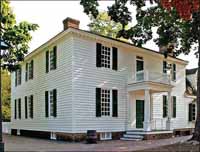 James Geddy House exterior, block 19, building 11 [history.org]
James Geddy House exterior, block 19, building 11 [history.org]
| Structure: | James Geddy House, block 19, building 11 |
|---|---|
| Requested by: | Edward Chappell, Roberts Director of Architectural and Archaeological Research, Colonial Williamsburg Foundation |
| Analyzed by: | Kirsten Travers, Paint Analyst, Colonial Williamsburg Foundation; and Sara Lapham, Graduate Fellow, Winterthur/University of Delaware Program in Art Conservation |
| Consulted: | Susan L. Buck, Ph.D., Conservator and Paint Analyst, Williamsburg, Virginia |
| Date submitted: | December 2012 |
Purpose:
The goal of this project is to use cross-section microscopy techniques to explore the early interior paint history of the James Geddy House, to better understand the arrangement of spaces and finish, as well as the evolution of spaces in the early history of the building.
History:
The James Geddy House is a large, frame, two-story L-shaped building, the south face of which looks south to Duke of Gloucester street, and the west face of which extends north on Palace Green. Dendrochronology dates the house to 1762, two years after lot 161 was purchased by James Geddy Jr. from his mother, Anne Geddy (Heikkenen 1983). James Geddy Jr., a silversmith, lived in the house with his family and operated his business from this location until 1777. The house was restored in 1930 (Schlesinger 1968, 14). Two shops to the east were reconstructed in 1954 (James Geddy Jr. used the western shop and rented out the eastern one). The interior is remarkably complete and retains practically all of its original features, although some of the mantels are new, and the walls were completely replastered during the 1930 restoration (Waterman 1932, 1). The shop extensions to the east occupy their original foundations, and retain an original door between the west shop and east room of the house, but are otherwise total reconstructions (Schlesinger, 2). The house is currently interpreted to reflect the period of James Geddy Jr.'s occupancy (1762-1778).
Previous Research:
Around 1994, Susan Buck carried out a small test study in the parlor and saw evidence on the door leafs for a first-period green verdigris glaze, followed by a second generation white paint, and a third generation white primer and gray finish coat. Notably, the first generation on the wainscot was the white primer and 6 gray finish, suggesting that the wainscot post-dates the rest of the woodwork by at least two generations.1
From 1999 to 2003, Mark Kutney took two hundred and twenty-five paint samples from the Geddy House interior and exterior, but never completed a report.2 Some of Kutney's cast and uncast samples are stored in the Architectural Fragments collection in Packett's Court, accompanied with a complete list of sample locations. These samples were re-examined when necessary, to complement the current findings. However, most of the sample location descriptions are insufficiently specific to be as useful as they could have been. Kutney did find evidence for the wainscot and mantel in the parlor being later than the doorway and explained this to the architectural historians. Certainly his samples should be kept for further study.
Procedures:
One hundred and forty paint samples (GE 1 — GE 140), were removed from the Geddy House interior by Kirsten Travers (Paint Analyst), and Sara Lapham (Graduate Fellow), accompanied by Edward Chappell (Director of Architectural and Archaeological Research). On site, a monocular 30x microscope was used to examine the painted surfaces to determine the most appropriate areas for sampling. A microscalpel was used to remove the samples, and sampling locations were recorded and photographed. Samples were labeled and stored in small, individual Ziploc bags for transport. All samples were given the prefix "GE", and numbered according to the order in which they were collected. A complete list of sample locations can be found in the Appendices.
In the laboratory, the samples were examined with a stereomicroscope under low power magnification (5x to 50x), to identify those that contained the most paint evidence and would therefore be the best candidates for cross-section microscopy. Uncast portions were retained for future examination and analysis, if necessary. The best candidates were cast in resin cubes and sanded and polished to expose the cross-section surface for microscopic examination. Please see Appendix A for sample preparation details. The cross-section samples were examined and digitally photographed in reflected visible and ultraviolet light conditions at 100x to 400x magnifications. By comparing the resulting photomicrographs, finish generations could be interpreted based on physical characteristics such as color, texture, thickness, presence of dirt layers and extent of surface deterioration.
Results:
This study found significant paint evidence on woodwork throughout the house that shed light on the early color schemes and evolution of the interior finish. In this report, the results are organized according to room: the first-floor spaces are discussed first, starting with the parlor (southwest first-floor room), followed by the dining room (northwest first-floor room), the southeast chamber, the shop, and the first-floor passage and stair. The second-floor spaces are presented in the following order: the stair passage, followed by the small western passage, the current bathroom, the northwest room, the southeast chamber, and the southwest chamber (analyzed by Sara Lapham, Graduate Fellow, Winterthur/University of Delaware Program in Art Conservation). Her full report is attached in the Appendix).
Photomicrographs of paint stratigraphies have been annotated according to finish generation. For instance, a primer, paint layer, and varnish may represent one finish generation and are all given the same number, but differentiated with lowercase letters (1a, 1b, 1c, etc.). Since many samples contained redundant evidence, only the most relevant cross-section photomicrographs are presented in this report. The analytical results and pertinent observations are discussed adjacent to the photomicrographs. The results are interpreted in the conclusion, and all raw photomicrographs can be found in the appendix at the end of this report.
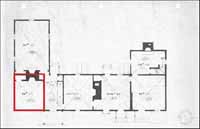 James Geddy House and Silversmith Shop, First-Floor Plan [Schlesinger, 1968]. The parlor is outlined in red.
James Geddy House and Silversmith Shop, First-Floor Plan [Schlesinger, 1968]. The parlor is outlined in red.
Twenty paint samples were collected from the parlor woodwork.
Parlor (Southwest First-Floor Room) Samples
| GE 1 | East wall, wainscot to left of door, lower left corner of raised panel, 6" out from door architrave backband | p. 24 |
| GE 2 | East wall, cornice, center of fascia, just above door to passage | p. 27 |
| GE 3 | East wall, door architrave to passage, inner fascia, 37" up from floor | p. 39, used for color matching |
| GE 4 | East wall, door architrave to passage, center fascia, 28" up from floor | p. 20 |
| GE 5 | East wall, door architrave to passage, back edge of backband, 33 ½" up from floor | p. 21 |
| GE 6 | East wall, top rail of wainscot, left of passage doorway, just below chair rail, 40.5" up from floor | p. 25 |
| GE 7 | East wall, wainscot, underside of chair rail, 2" to left of door architrave | p. 26 |
| GE 8 | East wall, door leaf to passage, bottom right panel, upper left corner | p. 22 |
| GE 9 | West wall, window architrave, bottom left corner, inner fascia | p. 31-34, used for staining |
| GE 10 | West wall, window architrave, bottom left corner, center fascia | redundant, not used |
| GE 11 | West wall, window architrave, bottom left corner, backband | p. 18 |
| GE 12 | Closet door leaf, room-side, bottom ovolo of center left panel | p. 23 |
| GE 13 | Closet door leaf, room-side, bottom left raised panel, bottom left corner | disrupted, not used |
| GE 14 | West wall, window sash, bottom right pane, top muntin | p. 28 |
| GE 15 | Mantel, left jamb, 41" up from floor | p. 29 |
| GE 16 | Mantel, inner face of right jamb, 43" up from floor | not used |
| GE 77 | West wall, window architrave, right jamb, center fascia, 8" above bottom of arch. | p. 17 |
| GE 86 | West wall, window architrave, right jamb, inner fascia, 8" above bottom of arch. | p. 16 |
| GE 87 | East wall, door architrave to passage, left jamb, inner fascia, 18" from floor | p. 19 |
| GE 88 | North wall, closet door architrave, left jamb, inner fascia, 9" above floor | redundant, not used |
| GE 136 | Baseboard, north wall, 4" out from east wall | p. 30 |
| GE 137 | Interior of closet door, center panel, adjacent to center stile | not cast |
Summary of results:
The paint evidence in this room sheds an important light on the renovations that took place in the 18th century. The results suggest that the first-period woodwork in the room was much simpler than its present appearance — the earliest elements are the door leafs (closet and passage) and the inner fascias of the door and window architraves. These elements were determined to be earliest because they contain five finish generations that were not present on the rest of the woodwork (see next page for comparison).
On these first period elements, the first finish generation is a shellac sealant (1a, identified by the orange autofluorescence in the wood cells), followed by a deep green verdigris glaze (1b), which contains large particles of verdigris ground in oil (identified via PLM and DCF+). Interestingly, the verdigris glaze was not applied over a traditional base coat, but directly on the shellacked wood. This is an unusual treatment, as verdigris has little hiding power and usually requires a gray or red-brown base coat.4
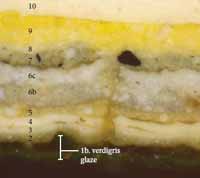 Window Architrave, inner fascia
Window Architrave, inner fascia
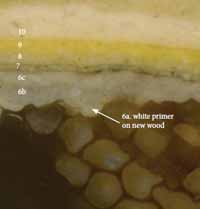 Window Architrave, center fascia
Window Architrave, center fascia
West wall, window architrave, center fascia
GE 77, visible light, 200x
 West wall, window architrave, inner fascia
GE 9a (bottom) and 9b (top), visible light, 200x
West wall, window architrave, inner fascia
GE 9a (bottom) and 9b (top), visible light, 200x
It should be noted that verdigris is an expensive and high maintenance pigment, and its use here suggests this room was decorated as a high status and visible space, despite its relatively simple woodwork. It is significant that this paint was also used on the interior side of the closet door (sample GE 137), which was not a highly visible surface. (Sample GE 137 was not cast but during collection the surface was examined and found to have the same verdigris finish on the wood as the rest of the first period woodwork).
Following this verdigris green finish, generations 2-5 are white paints. These exhibit a peach-colored autofluorescence in UV light, indicative of lead-based oil paints (Travers 2011). PLM was performed on generation 2, and lead white was the only pigment identified. The other white paints could not be separated for PLM analysis. The earliest paint on the window sash appears to be white paint generation 4. This would suggest the sash is early but not first period.
According to the paint evidence, the wainscot, cornice, and mantel were installed in the sixth finish generation, and the architraves were 'improved' and widened by adding center fascias and backbands (see below). The style of this new woodwork is consistent with a late 18th-century date. The new woodwork was primed white (6a), and all of the existing woodwork received a gray finish (6b, 6c), often present as a layer of darker gray on the bottom (6b) and lighter gray on the top (6c). The boundary between 6b and 6c is very amorphous, suggesting that they were applied 'wet into wet'. This initially suggested that a faux-finish, possibly an imitation marble, painted in shades of gray, was present. Attempts were made to expose this possible finish on-site, but no evidence was found. Only a solid gray color was uncovered (see Appendix P), so the variation of this generation throughout the samples could simply reflect variations in hand ground paints. This sixth generation was exposed for a long period of time, since its surface is grimy and cracked.
All of the baseboards in the room were excavated and examined, but fewer paints were seen compared to the rest of the woodwork (sample GE 136, p.30). Since they are contemporary with the wainscot their finishes in generations 1-5 are unknown. Regardless, the earliest finish on the baseboards in the parlor was a dark brown paint that may align with generation nine on the wainscot, although the exact alignment of paints is uncertain.
If the first generation verdigris finish dates to c.1762, when the house was constructed, and the new woodwork dates to the late 18th century, the paint evidence suggests that this room was painted quite frequently in its early history. This might have been necessitated by the discoloration of the first period verdigris finish soon after its application, but also suggests this room continued to be a highly visible and frequently used space.
Overall, very few reactions were observed with fluorochrome stains in the early paints. This could result from the age and deterioration of the binding media. However, a very strong reaction for oils (DCF+) was observed in the wood substrate, the shellac (1), and the verdigris finish (2).
The complete stratigraphy for the parlor is found on the table on the next page:
Parlor Paint History
| Generation | Description | Observations/Analytical results |
|---|---|---|
| 20-26 | Gray paints | modern, 20th c. (dim autofluorescence). Present finish. Probably applied by CWF. |
| 11-19 | White paints | contain zinc, c. 1845 or later ('twinkling' blue autofluorescence). Baseboards black. |
| 10 | Cream paint, mantel black | lead white in oil (peachy autofluorescence). Baseboards dark brown (?) |
| 9 | Yellow paint on trim, blue-green on wainscot, mantel black | more finely ground, may be industrially prepared, probably 19th c. Present baseboards may have been added in this period, earliest paint dark brown. |
| 8 | Cream paint, mantel black | lead white in oil, finely ground, may be industrially prepared, probably 19th c. Baseboards unknown. |
| 7 | Coarsely ground blue-green paint, mantel black | hand ground, large coarse pigment particles in a resinous matrix. Baseboards unknown. |
| 6 (new woodwork added) | Gray finish: white primer on new woodwork (6a), dark gray (6b), light gray (6c). | hand ground, small black pigment particles visible. This is the first generation on new woodwork (wainscot, cornice, mantel, and architrave outer elements). Very worn and grimy suggesting long period of exposure. Stain reactions: inconclusive. Pigments: lead white and carbon black (PLM). Baseboards unknown. |
| 5 | White paint | Found only on inner architraves and door leaves (including closet-side of door leaf). hand ground, lead white in oil. (peachy autofluorescence). Stain reactions: inconclusive. PLM not performed. |
| 4 | White paint | Found only on inner architraves and door leaves (including closet-side of door leaf). hand ground, lead white in oil. (peachy autofluorescence). Stain reactions: inconclusive. PLM not performed. This may be the first paint on the window sash. |
| 3 | White paint | Found only on inner architraves and door leaves (including closet-side of door leaf). hand ground, lead white in oil. (peachy autofluorescence). Stain reactions: inconclusive. PLM not performed. |
| 2 | White paint | Found only on inner architraves and door leaves (including closet-side of door leaf). hand ground, lead white in oil (peachy autofluorescence). Stain reactions: inconclusive. Pigments: lead white (PLM). |
| 1 (early woodwork only) | Green finish: verdigris-oil glaze (1b) over shellac sealant (1a) | Found only on inner architraves and door leaves (including closet-side of door leaf). Applied directly over shellacked wood, no opaque base coat. Stain reactions: oil (DCF+). Pigments: verdigris (PLM). |
Parlor (Southwest First-Floor Room), West wall
GE 86: Window architrave, inner fascia of right architrave
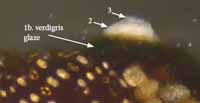 GE 86a (bottom, 200x) and 86b (top, 100x), visible light
GE 86a (bottom, 200x) and 86b (top, 100x), visible light
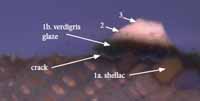 GE 86a (bottom, 200x) and 86b (top, 100x), UV light
GE 86a (bottom, 200x) and 86b (top, 100x), UV light
Sample 86a was taken from the inner fascia of the west window architrave, which has more paint layers (generations 1-5), than the center fascia and backband of the same architrave (see following pages), indicating they were installed later. The orange autofluorescence in the wood substrate suggests that shellac was used to seal the surface before painting (1a). The first finish generation is the green verdigris glaze (1b), which was identified by its dark green color, translucency, and total lack of autofluorescence in UV. The absence of a base coat is unusual for this type of finish. There is a crack at the interface between the wood and the glaze which most likely occurred during sampling, when this finish was noted to be very brittle and aged. This condition was not noted in any of the other samples.
Parlor (Southwest First-Floor Room), West wall
Sample GE 77 suggests that the earliest paint on the center window architrave fascia is generation 6. This would suggest that the center fascia post-dates the inner fascia (GE 86, previous page), but is contemporary with the backband of this same window architrave (GE 11, p. 18) which has the same stratigraphy. The paint evidence suggests this upgrade is also contemporary with the cornice, wainscot, and improvements to the door architraves in the room.
The earliest paints on the backband (GE 11) are disrupted, but there is enough evidence to suggest that the earliest paint is generation 6. Therefore, the backband post-dates the inner fascia (GE 86, p. 16), but is contemporary with the center fascia of this same window architrave (GE 77, p. 17). This upgrade is also contemporary with the cornice, wainscot, and improvements to the door architraves in the room.
Parlor (Southwest First-Floor Room), East wall
GE: 87 Door architrave to passage, inner fascia
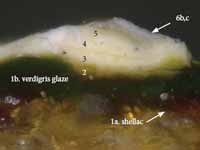 GE 87a (bottom, 200x), and 87b (top, 100x), visible light
GE 87a (bottom, 200x), and 87b (top, 100x), visible light
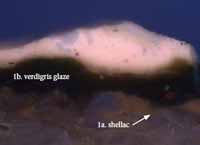 GE 87a (bottom, 200x), and 87b (top, 100x), UV light
GE 87a (bottom, 200x), and 87b (top, 100x), UV light
Like the window architraves discussed previously, sample GE 87 illustrates that the inner fascia of the door architrave to the passage is also first period, as it contains the first generation shellac sealant, verdigris glaze, and white paint generations 2-5, which were not present on the center fascia and the backband of this same architrave (see following pages). Therefore, the inner fascia is first period and the rest of the architrave is later.
This same condition was also noted on the closet door architrave, which was examined on-site, but not sampled.
GE 4: Door architrave to passage, center fascia
The center fascia of the passage door architrave begins with generation 6, suggesting it was added well after the inner fascia (see GE 87, previous page).
GE 5: Door architrave to passage, backband
The paint history of the door architrave backband (GE 5) is the same as that from the center fascia (see GE 4, previous page), suggesting both are contemporary and were installed well after the inner fascia (GE 87, p. 19).
GE 8: Door leaf to passage, bottom right panel (early generations only)
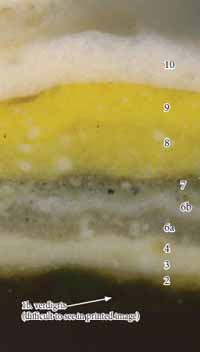 GE 8a, visible light, 200x (enlarged, early generations only)
GE 8a, visible light, 200x (enlarged, early generations only)
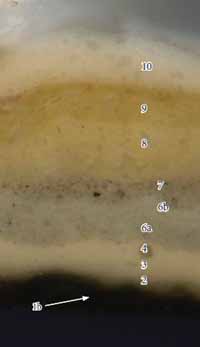 GE 8a, UV light, 200x (enlarged, early generations only)
GE 8a, UV light, 200x (enlarged, early generations only)
The door leaf to the passage (GE 8), contains the same early paint history as the inner fascia of the door architrave (GE 3, p. 39), suggesting that the door leaf is first period.
Generation 5 is missing from this sample.
Parlor (Southwest First-Floor Room), North wall
GE 12: Closet door leaf, room-side, center left panel, ovolo (early paints only)
Sample GE 12 illustrates that the early paint history of the closet door leaf on the north wall is the same as that of the door leaf to the passage (GE 8, previous page). This suggests the closet door leaf is also first period. Generation 5 is missing from this sample.
Parlor (Southwest First-Floor Room), East wall
GE 1: Wainscot to left of doorway to passage, raised panel, lower right corner
The early paints in sample GE 1 are disrupted and cleaved at the wood substrate, but enough evidence remains to show that the first generation applied to the wainscot panel is generation 6. This suggests the wainscot is later and contemporary with the cornice and the center fascias and backbands of the window and door architraves.
This was confirmed by the other wainscot samples, shown on the following pages (GE 6, top rail, next page; and GE 7, chair rail, p. 26).
GE 6: Wainscot to left of doorway to passage, top rail, just below chair rail
GE 7: Wainscot to left of doorway to passage, chair rail (underside)
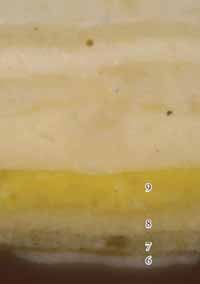 GE 7b, visible light, 400x (early generations only)
GE 7b, visible light, 400x (early generations only)
GE 2: Cornice
Although the wood substrate is not present in the cross-section, examination of the uncast portion of GE 2 confirmed that generation 6 is the first finish applied to the cornice. This would suggest that the cornice is later and contemporary with the wainscot and architrave upgrades in this room.
Parlor (Southwest First-Floor Room), West wall
GE 14: Window sash, bottom right pane, top muntin
Sample GE 14 suggests that the earliest generation on the window sash is a cream-colored paint that appears rather coarse and hand ground. This paint is cracked and covered with a layer of grime which suggests it was exposed for a long period of time.
This paint looks similar to generation 4 on the door leaves and the inner fascias of the architraves (see GE 86b, left), which is also covered with grime. This is not a definitive match but it does suggest that the sash could be old, and possibly 18th-century.
GE 15: Mantel, left jamb, 41" up from floor (early paints only)
The substrate cleaved away from sample GE 15, but examination of the uncast sample portion suggests that the dark gray paint at the bottom of the sample was the earliest paint on the wood substrate. This paint is very similar to the sixth generation gray paint in the rest of the room, and would suggest the mantel is not first period but contemporary with the later 18th c. wainscot, cornice, and architrave upgrades.
Repeated micro-excavations on the mantel did not find any evidence of more paint, so this would appear to be the complete stratigraphy, unless the mantel was scraped down at an early date.
Generations 7 - 10 are black paints which were not found elsewhere in the room. Generation 11 is a varnish with a bluish-white autofluorescence, suggestive of a plant resin. The crack in generation 10 suggests it was already exposed for a long period of time before it was varnished. Generation 12 is a white paint with a 'twinkling' autofluorescence, suggestive of zinc white, which dates this paint to after c.1845. The rest of the stratigraphy is not shown, but aligns with the rest of the room.
Parlor (Southwest First-Floor Room)
GE 136: north wall, baseboard
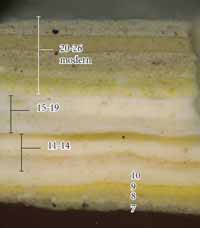 GE 1b, visible light, 200x (Wainscot, east wall)
GE 1b, visible light, 200x (Wainscot, east wall)
The baseboards throughout the parlor were excavated and examined but they seemed to contain fewer paints in comparison to the rest of the woodwork in the room, suggesting paint loss due to wear and abrasion, as well as replacements.
Sample GE 136 was taken from an area on the baseboard that contained the most paint evidence. The earliest paints are two generations of coarsely-ground dark brown color (appears deep red in cross-section). It is not clear how this color aligns with the rest of the room. Compared to a wainscot sample, the earliest paint may align with generation 9, but this is uncertain.
This comparison suggests that the baseboard is old, but possibly later than most of the woodwork in the room. Therefore, its color in generations 1-6 is unknown.
Parlor (Southwest First-Floor Room), West wall
Binding Media Analysis (Fluorochrome staining): TTC for carbohydrates
GE 9a: Window architrave, bottom left corner, inner fascia (wood and early paints only)
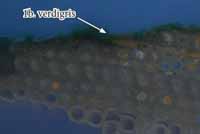 GE 9a,UV light, 200x. Before TTC stain
GE 9a,UV light, 200x. Before TTC stain
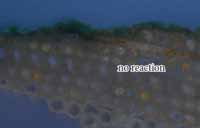 GE 9a, UV light, 200x. TTC reaction.
GE 9a, UV light, 200x. TTC reaction.
Sample GE 9a was stained with TTC to tag carbohydrates in the sample. No positive reactions (a dark red-brown color), were observed. However, this could result from the dark colors of the coatings themselves, which masked a reaction. In this case, the presence of carbohydrates would be better analyzed with an instrumental technique such as FTIR or GC-MS.
Binding Media Analysis (Fluorochrome staining): FITC for proteins
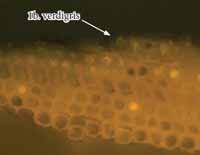 GE 9a, B-2A filter, 200x. Before FITC stain
GE 9a, B-2A filter, 200x. Before FITC stain
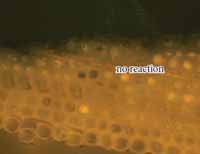 GE 9a, B-2A filter, 200x. FITC reaction.
GE 9a, B-2A filter, 200x. FITC reaction.
Sample GE 9a was stained with FITC to tag proteins in the sample. No positive reactions (a bright, yellow-green fluorescence), were observed.
Binding Media Analysis (Fluorochrome staining): DCF for lipids (oils)
GE 9a: Window architrave, bottom left corner, inner fascia (wood and early paints only)
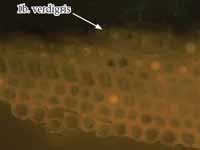 GE 9a, B-2A filter, 200x. Before DCF stain
GE 9a, B-2A filter, 200x. Before DCF stain
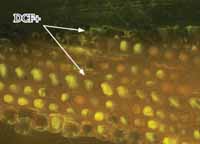 GE 9a, B-2A filter, 200x. DCF reaction.
GE 9a, B-2A filter, 200x. DCF reaction.
Sample GE 9a was stained with DCF to tag lipids (oils) in the sample. Strong positive reactions (a bright, yellow-green fluorescence), were observed throughout the sample.
Binding Media Analysis (Fluorochrome staining): TTC for carbohydrates
Binding Media Analysis (Fluorochrome staining): FITC for proteins
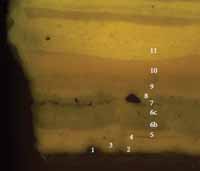 GE 9b, B-2A filter, 200x. Before FITC stain
GE 9b, B-2A filter, 200x. Before FITC stain
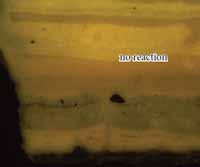 GE 9b, B-2A filter, 200x. FITC reaction.
GE 9b, B-2A filter, 200x. FITC reaction.
Sample GE 9b was stained with FITC to tag proteins in the sample. No positive reactions (a bright yellow-green fluorescence), were observed.
Binding Media Analysis (Fluorochrome staining): DCF for lipids (oils)
GE 9b: Window architrave, bottom left corner, inner fascia (early paints only)
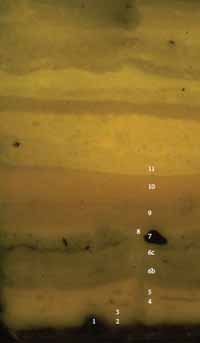 GE 9b, B-2A filter, 200x. Before DCF stain
GE 9b, B-2A filter, 200x. Before DCF stain
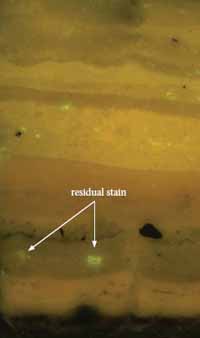 GE 9b, B-2A filter, 200x. DCF reaction.
GE 9b, B-2A filter, 200x. DCF reaction.
Sample GE 9b was stained with DCF to tag oils in the sample. No positive reactions (a bright yellow-green fluorescence), were observed, other than a few patches of residual stain.
Pigment Identification Results
Summary
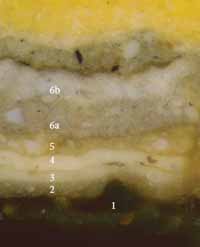 GE 9b, visible light, 200x (enlarged and lightened for legibility)
GE 9b, visible light, 200x (enlarged and lightened for legibility)
Pigments in some of the earliest paint generations were identified using polarized light microscopy (PLM) techniques. Pigment samples were collected with a clean scalpel blade from the uncast portions, dispersed on a glass slide, and mounted with Cargille Meltmount (refractive index 1.66) and examined in plane polarized transmitted light and cross polarized transmitted light.
The results indicate that the first generation green finish contains verdigris particles. Lead white (2PbCO3 ‧ Pb(OH)2), and chalk (CaCO3) particles were also seen, most likely contaminants from adjacent generations 2 and 3. See p. 33 for further details.
Generation 2 appears to be composed of lead white (2PbCO3 ‧ Pb(OH)2) pigment only. See p. 32 for further details.
Generations 3-5 could not be separated for independent analysis.
Generation 6 is composed of lead white (2PbCO3 ‧ Pb(OH)2), with some carbon black (C), yellow ochre (Fe2O3 ‧ nH2O), and Prussian blue pigment (Fe4[Fe(CN)6]3). Generation 6a and 6b could not be separated for independent analysis. See p. 33 for further details.
Generation 1 verdigris-green finish on period 1 woodwork
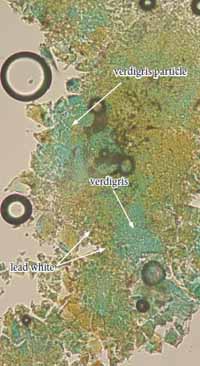 Dispersed pigment sample from sample GE 9, generation 2, transmitted plane polarized light, 400x
Dispersed pigment sample from sample GE 9, generation 2, transmitted plane polarized light, 400x
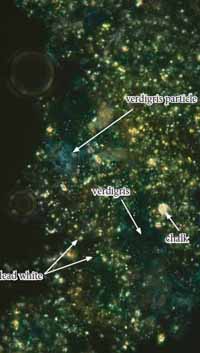 Dispersed pigment sample from sample GE 9, generation 2, transmitted cross polarized light, 400x
Dispersed pigment sample from sample GE 9, generation 2, transmitted cross polarized light, 400x
This sample contained large particles of verdigris pigment (Cu(C2H3O2) ‧ 2Cu(OH)2) having an intense blue-green color and a "fibrous structure" made more visible in cross-polarized light (Gettens and Stout 1942, 169). Small particles of lead white (2PbCO3 ‧ Pb(OH)2), and larger plate-like particles of chalk (CaCO3), were also visible, although these are most likely contaminants from paints above, since none of these pigments were visible in the cross-section.
Generation 2 white paint on period 1 woodwork
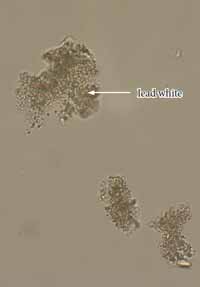 Dispersed pigment sample from sample GE 9, generation 3, transmitted plane polarized light, 1000x
Dispersed pigment sample from sample GE 9, generation 3, transmitted plane polarized light, 1000x
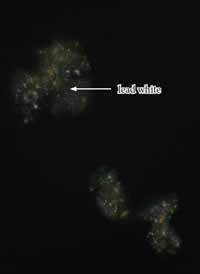 Dispersed pigment sample from sample GE 9, generation 3, transmitted cross polarized light, 1000x
Dispersed pigment sample from sample GE 9, generation 3, transmitted cross polarized light, 1000x
The third generation light gray paint is mostly comprised of lead white (2PbCO3 ‧ Pb(OH)2), which appears as small, rounded colorless particles that are birefringent (bright) under crossed polars.
There were no other colored particles found in this paint.
Generation 6 gray paint on period 2 woodwork
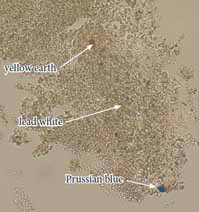 Dispersed pigment samples from sample GE 2, generation 6a, transmitted plane polarized light, 1000x
Dispersed pigment samples from sample GE 2, generation 6a, transmitted plane polarized light, 1000x
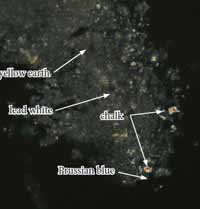 Dispersed pigment sample from sample GE 92 generation 6a, transmitted cross polarized light, 1000x
Dispersed pigment sample from sample GE 92 generation 6a, transmitted cross polarized light, 1000x
The sixth generation light gray paint is mostly comprised of lead white (2PbCO3 ‧ Pb(OH)2), and carbon black (C). Some chalk (CaCO3), was also present, visible as thin plates with strong interference colors. Yellow ochre (Fe2O3 ‧ nH2O), was also present, visible as particles with a deep yellow color in transmitted light that are isotropic in crossed polars. Finally, a few scattered particles of Prussian blue (Fe4[Fe(CN)6]3), were seen, which have a deep blue color in transmitted light and are isotropic in crossed polars.
Colorimetry Results
Generation 2 White Paint (Sample GE 3, door architrave to passage, inner fascia)
 Underside of sample GE 3, uncast, visible light, 40x
Underside of sample GE 3, uncast, visible light, 40x
Accurate color readings for the second generation white paint in the parlor could not be obtained with the Minolta Chroma Meter because a clean, intact area could not be isolated for measurement. Instead, the closest commercial color match was determined by eye using a stereomicroscope at 30x magnification with a color corrected light source. The closest match was determined to be Benjamin Moore HC-28 "Shelburne Buff", a tannish color. However, PLM found only lead white pigments present in this paint (see p. 37). Therefore, it seems most likely that the tannish color results from the extensive age and deterioration of this paint and its oil binder with time, and was not the original color.5
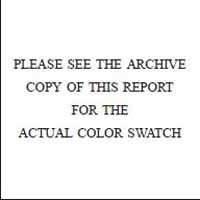 Benjamin Moore
Benjamin Moore
HC-28
"Shelburne Buf"
| CIE L*a*b* values | L* (black to white) | a* (green to red) | b* (blue to yellow) |
|---|---|---|---|
| 73.84 | +0.02 | +23.33 | |
| Munsell values | hue | value | chroma |
| 2.9Y | 7.3 | 3.4 |
A color match is provided below that was taken from a sample of a hand ground paint made with lead white pigment in cold-pressed linseed oil.6 This may better represent the color of the paint when it was freshly painted.
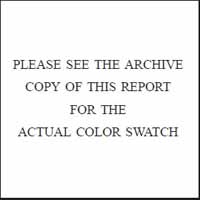 Benjamin Moore
Benjamin Moore
OC-17
"White Dove"
| CIE L*a*b* values | L* (black to white) | a* (green to red) | b* (blue to yellow) |
|---|---|---|---|
| 93.02 | -1.08 | +5.56 | |
| Munsell values | hue | value | chroma |
| 6.8Y | 9.5 | 0.7 |
Generation 6 Gray Paint (Sample GE 2, cornice, west wall)
Generations 6a and 6b from sample GE 2 were measured with a Minolta Chroma Meter colorimeter/ microscope to obtain color values in CIE L*a*b* and Munsell color-space. Measurements could only be obtained from 6a, while generation 6b had to be matched by eye. For 6a, readings were obtained from two different areas measuring 0.3 mm across, and averaged together resulting in one value (although the difference between the two readings was negligible).
| CIE L*a*b* values | L* (black to white) | a* (green to red) | b* (blue to yellow) |
|---|---|---|---|
| area 1 | 64.49 | -2.61 | +12.81 |
| area 2 | 64.31 | -2.60 | +12.02 |
| average | 64.40 | -2.61 | +12.42 |
The closest commercial matches for both generation 6a and 6b were determined by eye using a stereomicroscope at 30x magnification with a color corrected light source. Commercial swatches used for matching included Benjamin Moore, Sherwin Williams, Pittsburgh Paints, and the Colonial Williamsburg Color Collection. Final determination of the closest match was carried out by obtaining the CIE L*a*b* value of the commercial swatch, and mathematically calculating the color difference (known as ΔE), between the swatch and the actual sample. The commercial swatch with the lowest ΔE was the best match (see Appendix A for more details).
42The closest commercial color match for generation 6a was determined to be Sherwin Williams swatch #6164 "Svelte Sage". The color difference (ΔE) between this swatch and the actual sample was calculated as 6.75. This was the closest color to be found amongst the various sample sets.
| CIE L*a*b* color values | L* (black to white) | a* (green to red) | b* (blue to yellow) |
|---|---|---|---|
| 70.87 | -4.51 | +12.11 | |
| Munsell color values | hue | value | chroma |
| 1.5GY | 7.0 | 1.7 |
The closest commercial color match for generation 6b was obtained by eye and determined to be Sherwin Williams swatch #7060 "Attitude Gray".
| CIE L*a*b* color values | L* (black to white) | a* (green to red) | b* (blue to yellow) |
|---|---|---|---|
| 53.11 | -3.51 | +3.39 | |
| Munsell color values | hue | value | chroma |
| 8.9GY | 5.2 | 0.7 |
Dining Room (Northwest First-Floor Room)
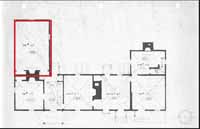 James Geddy House and Silversmith Shop. First-floor Plan [Schlesinger, 1968]. The dining room is outlined in red.
James Geddy House and Silversmith Shop. First-floor Plan [Schlesinger, 1968]. The dining room is outlined in red.
On-site, E. Chappell noted considerable variation among the architraves, and was particularly interested to learn if they were all of the same period, or if the paint history could shed light on stages of installation.7 He noted that the "chunkier" architrave backbands on the buffet and passage door suggested they were first period.
Eighteen paint samples were collected from the dining room woodwork. The mantel was examined and found to contain no historic paints, so it was not sampled. The door leaf to the passage, which was installed in the mid-19th century, was also not sampled.
| GE 23 | Door architrave to passage, left jamb, inner fascia just above plinth | p. 51 |
| GE 24 | Door architrave to passage, left jamb, center fascia just above plinth | p. 52 |
| GE 25 | Door architrave to passage, left jamb, backband just above plinth | p. 50 |
| GE 26 | Door architrave to passage, left jamb, plinth face, upper left corner | p. 53 |
| GE 27 | North wall, window architrave, bottom right corner, inner fascia | p. 60 |
| GE 28 | North wall, window architrave, bottom right corner, center fascia | p. 61, staining 70-71 |
| GE 29 | North wall, window architrave, bottom sill, enter fascia, 10 ½" out from back of left jamb | p. 62 |
| GE 30 | West wall, NW window architrave, inner fascia, 34" from bottom edge | p. 64 |
| GE 31 | West wall, NW window architrave, right jamb, center fascia where meets backband | p. 63 |
| GE 32 | West wall, NW window architrave, backband, bottom edge, right side | p. 65 |
| GE 33 | West wall, SW window architrave, center fascia where meets backband, bottom left corner | p. 67 |
| GE 34 | West wall, SW window architrave, bottom sill, inner fascia, 9 ½" out from left edge | fragmentary, not used |
| 44 | ||
| GE 35 | West wall, SW window architrave, backband, bottom left corner | p. 68 |
| GE 36 | Buffet architrave, right jamb, cyma of backband, 19" up from floor | p. 54, uncast p. 75, 77 |
| GE 37 | Buffet architrave, right jamb, cyma between inner and center fascias, 22" up from floor | p. 55 |
| GE 38 | Buffet, far right end of fascia just under bolection | p. 56 |
| GE 39 | West wall, SW window architrave, left jamb, center fascia, 51" up from bottom sill | p. 67 |
| GE 40 | West wall, SW window architrave, left jamb, inner fascia, 51" up from bottom sill | p. 66 |
| GE 123 | Buffet, east side, panelling towards the front, just under the first shelf | p. 57 |
| GE 124 | Buffet, west side, edge of second shelf up from the bottom | p. 58 |
| GE 125 | Buffet, same as GE 123, but under second shelf | p. 59 |
| GE 126 | Buffet, back panelling, center, just below bottom shelf | p. 59 |
| GE 127 | Baseboard, east wall, 36" out from north wall | p. 69 |
Summary of results:
Comparison of the samples taken from the door, window, and buffet architraves suggest that all of these elements are contemporary and first period. (However, the plinth of the passage door architrave did not contain any early paints so its relative date could not be determined). This is different from the adjacent parlor, where the paint stratigraphies determined that some of the outer elements on the architraves (cymas and fillets), post-dated the inner elements (reveal, bead, fascia). However, the early paints in the dining room do not clearly align with those in the parlor, so it was difficult to relate the finishes in this room to those in the adjacent parlor. But it does suggest that early in the house's history, interior spaces were 'picked out' in different colors, rather than an overall monochrome scheme.
The mantel in this room was not sampled because it appeared new and contained only new paints.
The results suggest that on all first period woodwork the first generation is a white primer (1a), made with lead white and chalk, followed by a deep golden-yellow paint (1b), made with yellow ochre, lead white, chalk, and some carbon black. This yellow paint was also found on the interior of the buffet, so it was not picked out in a particular color in the first period, but would have matched the rest of the room.
In generation 2 most of the woodwork was painted with a white or off-white paint that has a layer of grime and varnish on its surface (2a-c), suggesting a long period of exposure. Interestingly, the interior of the buffet appears to have been picked out in black paint (samples GE 123-126), with remnants of a resin varnish. This would have created a very striking effect combined with the white paint in the rest of the room.
In generation 3, most of the woodwork was painted again with a white or off-white paint. The buffet interior appears to have been repainted black, although a brown paint was found on the edge of only the second shelf up from the bottom, which could suggest another scheme or an anomaly in the paint samples. Further investigation is necessary to search for this brown paint in other areas of the buffet.
Generation 4 is a white or off-white paint that becomes yellowish and translucent near the surface (4a, b), suggesting some type of resinous component. In most samples, this generation was coated with a thin layer of grime and remnants of a plant resin varnish (4c), suggesting it originally had a glossy surface and was exposed for a long period of time. This was the earliest paint applied to the southernmost window architrave on the west wall (GE 33-35, 39-40), which would indicate that this architrave post-dates the 45 rest of the woodwork in the room. This is consistent with the knowledge that this window was originally a doorway.8 These results suggest that at least three finish generations had passed before this work was carried out.
Overall, the buffet samples indicate that it is contemporary with the rest of the room, but it was not sampled extensively to understand its construction history, which is of particular interest to the architectural historians. This will be the focus of more detailed study in the future.
The baseboards around the room were examined but there were few areas with significant paint accumulation. One sample was taken (GE 127), which suggests that the earliest paints on the baseboards were black. However, this black paint did not extend across the architrave and/or mantel plinths, or the bottom of the door leaf to the passage. This was confirmed through micro-excavations on-site.
The complete finish history for the dining room is found in the table below:
| Generation | Description | Observations/Analytical results |
|---|---|---|
| 17-22 | tan paints | Modern, 20th c. (finely ground, dim autofluorescence). Present finish. Probably applied by CWF. |
| 8-16 | white paints on all woodwork (including baseboards) | Contain zinc (ID via 'twinkling' blue autofluorescence), c.1845 or later |
| 5-8 | white paint (baseboards most likely black) | Lead white in oil (peachy autofluorescence). PLM not performed. Stain reactions inconclusive. |
| 4 (SW window installed) | white paint on all woodwork with black baseboards | First paint on SW window. Very worn and grimy suggesting long period of exposure. Stain reactions inconclusive. Pigments: lead white, chalk (PLM) |
| 3 | white paint on all woodwork (buffet interior black). Black baseboards. | White paint is lead white in oil (peachy autofluorescence). PLM not performed. Stain reactions inconclusive. |
| 2 | white paint on all woodwork (buffet interior black). Black baseboards. | White paint is lead white in oil (peachy autofluorescence). Very worn and grimy suggesting long period of exposure. PLM not performed. Stain reactions inconclusive. |
| 1 | shellac sealant (1a), white primer (1b), deep yellow paint (1c) on all woodwork. Black baseboards. | Stain reactions inconclusive. 1a pigments: lead white, chalk. 1b pigments: lead white, yellow ochre, chalk, carbon black (PLM) |
Dining Room Paint Sample Locations
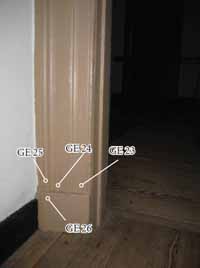 Door architrave leading to passage
Door architrave leading to passage
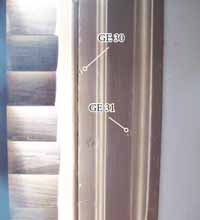 West wall, NW window architrave
West wall, NW window architrave
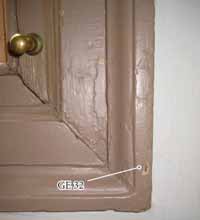 West wall, NW window architrave
West wall, NW window architrave
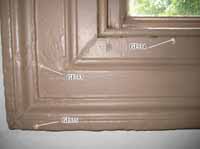 West wall, SW window architrave
West wall, SW window architrave
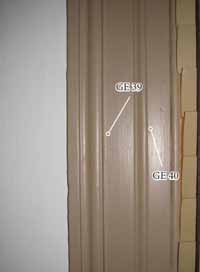 West wall, SW window architrave
West wall, SW window architrave
GE 25: Door architrave to passage, left jamb, backband
Sample GE 25, taken from the door architrave backband, contains the complete paint history for first period elements in the dining room. The earliest finish is a white primer (1a) and a yellow paint (1b). The same first generation finish was seen on the door architrave center fascia (GE 24, p. 52) and the inner fascia (GE 23, next page). This confirms that all architrave elements are contemporary and first period. (In this particular sample, a modern coating has flowed underneath the first generation yellow paint at the bottom of the sample. It is visible as a tannish layer with a bright blue autofluorescence, characteristic of a varnish).
GE 23: Door architrave to passage, left jamb, inner fascia
The early paints in sample GE 23 are very disrupted, but they do contain the first generation white primer (1a) and yellow paint (1b) that was seen on the door architrave backband (GE 25, previous page) and center fascia (GE 24, next page). This confirms that all architrave elements are contemporary and first period.
GE 24: Door architrave to passage, left jamb, center fascia
Sample GE 24, taken from the architrave center fascia, contains the first generation white primer (1a) and yellow paint (1b) that was seen on the same door architrave backband (GE 25, p. 50) and inner fascia (GE 23, p. 51). This confirms that all architrave elements are contemporary and first period.
Note: while the surface of the white primer (1a) looks uneven in this sample (suggestive of wear), this condition is an anomaly amongst the many dining room samples, and could result from the overall disruption of the early paints in this particular sample.
GE 26: Door architrave to passage, plinth
Comparison of sample GE 26 with the rest of the door architrave samples (see previous pages) suggests that the earliest extant finish applied to the plinth is generation 12. This would suggest that the plinth is much later, but more likely that the earliest finishes have been lost from this surface (a strong possibility considering its proximity to the floor and vulnerability to high foot traffic).
GE 36: Buffet, right jamb, cyma of backband
Sample GE 36, taken from the buffet architrave backband, begins with the first generation white primer (1a) and a yellow paint (1b). The same first generation finish was seen on the buffet architrave center fascia (GE 37, p. 55), and the fascia under the bolection (GE 38, p. 56). This confirms that these sections of the buffet are first period and contemporary with the passage door architrave and the window architraves (with the exception of the SW window architrave on the west wall).
GE 37: Buffet, right jamb, cyma between inner and center fascia
GE 38: Buffet, fascia at far right end, under bolection
The buffet fascia contains the same first generation white primer (1a) and deep yellow paint (1b) as the rest of the buffet, and the room.
GE 123: Buffet, east side, interior panelling towards front, just under bottom shelf
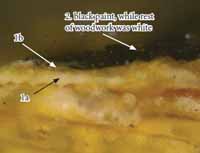 GE 123c, visible light, 200x (enlarged)
GE 123c, visible light, 200x (enlarged)
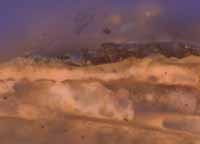 GE 123c, UV light, 200x (enlarged)
GE 123c, UV light, 200x (enlarged)
This sample from the buffet interior indicates that the interior was painted the same yellow (1b) as the rest of the room in the first period. In the second period, the interior of the buffet was picked out in black. This would have been contemporary with the white paint on the rest of the woodwork, and would have created a very striking effect.
GE 124: Buffet, west side, edge of second shelf up from bottom
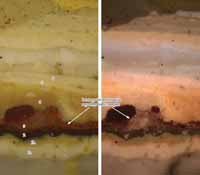 GE 124a, visible light, 200x, GE 124a, UV light, 200x
GE 124a, visible light, 200x, GE 124a, UV light, 200x
This sample from the buffet shelf edge interior indicates that the buffet interior was painted the same yellow (1b) as the rest of the room in the first period. In the second period, the interior of the buffet was picked out in black, as seen in other buffet interior samples (GE 123, previous page, and GE 125 and GE 126, next page).
Interestingly, this sample from the shelf edge has a third generation brown paint. This paint was not found in any of the other buffet samples. It looks as though the previous generation of black paint (2) was disrupted when this brown paint was applied, so they do not belong to the same generation. This third generation brown paint is disrupted and has a thin layer of grime on its surface, suggesting it was exposed for a long period of time. It may indicate that the edges of the shelves were 'picked out' in brown at an early date, but this requires further exploration.
GE 125: Buffet, back panelling, center, just below bottom shelf
GE 126: Buffet, east side, panelling towards front, under second shelf)
These two samples from the buffet again illustrate that the first generation is the same as the rest of the room— a white primer (1a) and yellow paint (1b). In the second generation the buffet interior was painted black (2a) with a disrupted varnish layer (2b). In the third generation, it was painted black again (3). The third generation brown paint seen in sample GE 124 (previous page), was not seen here, so it is unclear exactly how these early paints align.
GE 27: window architrave, north wall, inner fascia of bottom right corner
Sample GE 27, taken from the inner fascia of the north wall window architrave, begins with the first generation white primer (1a) and a yellow paint (1b). This suggests this architrave is contemporary with the buffet architrave, the passage door architrave, and the other window architraves (with the exception of the SW window architrave on the west wall). The same first generation white primer and yellow paint were seen on the rest of this architrave (GE 28, p. 61; and GE 29, p. 62).
GE 28: window architrave, north wall, center fascia, bottom right corner
GE 29: window architrave, north wall, center fascia, bottom right corner
GE 31: window architrave, west wall, NW window, center fascia
Sample GE 31, taken from the center fascia of the west wall NW window architrave, begins with the first generation white primer (1a) and a yellow paint (1b). This suggests this architrave is contemporary with the buffet architrave, the passage door architrave, and the other window architraves (with the exception of the SW window architrave on the west wall).
The same first generation white primer and yellow paint were seen on the rest of this architrave (GE 30, p. 64; and GE 32, p. 65), although some of the early paint evidence is fragmentary.
GE 30: window architrave, west wall, NW window, inner fascia
GE 32: window architrave, west wall, NW window, backband
GE 40: window architrave, west wall, SW window, inner fascia (continued from next page)
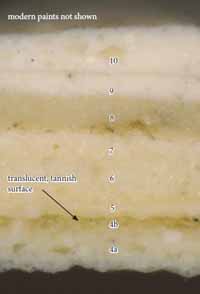 GE 40b, visible light, 200x (enlarged)
GE 40b, visible light, 200x (enlarged)
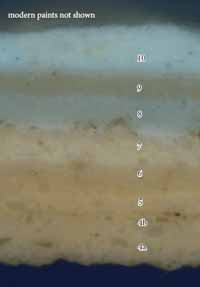 GE 40b, UV light, 200x (enlarged)
GE 40b, UV light, 200x (enlarged)
Sample GE 40, taken from the SW window architrave on the west wall, begins with the fourth generation white paint seen on the rest of the woodwork in this room. This surface of 4a has a tannish, translucent appearance in visible light, but a medium autofluorescence in UV light. This could be some type of oil/resin additive to increase the glossiness of the final finish. Four other samples were taken from this architrave (GE 33, GE 35, and GE 39, following pages), and all began with the fourth generation finish. Therefore, this evidence suggests that this window was converted from a doorway in the fourth generation, when all of the woodwork in this room was painted white.
GE 33 and 39: window architrave, west wall, SW window, center fascia
Both GE 33 and GE 39 were taken from the center fascia of the SW window architrave on the west wall. Sample GE 39a contained good evidence that generation 4a was the earliest paint applied to this architrave. Sample GE 33 did not have the wood substrate attached, but contained better evidence regarding the remainder of the stratigraphy.
This sample evidence was also seen on the inner fascia (GE 40, previous page), and backband of the same architrave (GE 35, next page).
GE 35: window architrave, west wall, SW window, backband
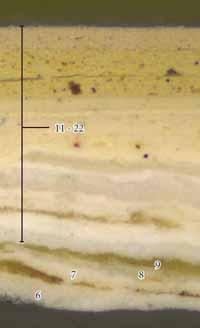 GE 35b, visible light, 100x (enlarged)
GE 35b, visible light, 100x (enlarged)
GE 127: Baseboard
The earliest paint generations on the baseboards are a series of black paints (generations 1-4). These are followed by white paints that contain zinc white (based on its twinkling autofluorescence in UV light), postdating these paints to the mid-19th century or later.
Binding Media Analysis (Fluorochrome staining): TTC for carbohydrates
GE 28: window architrave, north wall, center fascia, bottom right corner
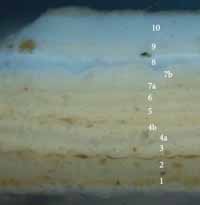 GE 28, UV light, 200x. Before TTC stain.
GE 28, UV light, 200x. Before TTC stain.
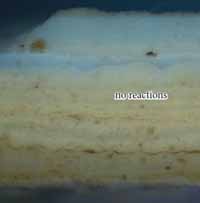 GE 28, UV light, 200x. TTC reaction.
GE 28, UV light, 200x. TTC reaction.
Sample GE 28 was stained with TTC to tag carbohydrates in the sample. No major reactions (a dark reddish-brown color) were observed. The sample was also stained with FITC to tag proteins (see below). No results (a yellow-green fluoroscence) were observed.
Binding Media Analysis (Fluorochrome staining): FITC for proteins
Binding Media Analysis (Fluorochrome staining): DCF for lipids (oils)
GE 28: window architrave, north wall, center fascia, bottom right corner
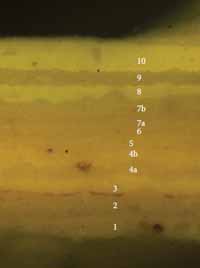 GE 28, B-2A filter, 200x. Before DCF stain.
GE 28, B-2A filter, 200x. Before DCF stain.
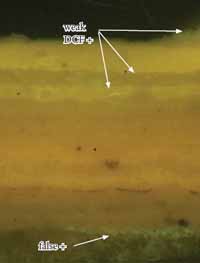 GE 28, B-2A filter, 200x. DCF reaction.
GE 28, B-2A filter, 200x. DCF reaction.
Sample GE 28 was stained with DCF to tag lipids (oils) in the sample. A false positive reaction was observed along the bottom of the sample, beneath generation 1. Weak reactions were observed in generations 7b, 8, 9, and 12.
Pigment Identification Results
Generation 1a: white primer
GE 36, dispersed pigment samples from generation 1a, white primer, plane polarized light, 1000x
GE 36, dispersed pigment samples from generation 1a, white primer, cross polarized light, 1000x
The white primer (generation 1a), is mostly comprised of lead white (2PbCO3 ‧ Pb(OH)2), and chalk (CaCO3). The lead white particles are visible as very small, rounded transparent to greenish-colored particles with a bright birefringence in crossed polars. The chalk particles are visible as larger, colorless, plate-like particles with an undulose birefringence.
Generation 1b: yellow paint
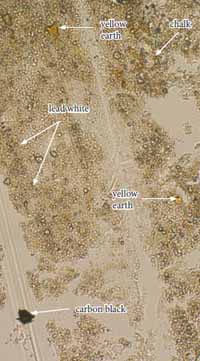 GE 36, dispersed pigment samples from generation 1b, yellow paint, plane polarized light, 1000x
GE 36, dispersed pigment samples from generation 1b, yellow paint, plane polarized light, 1000x
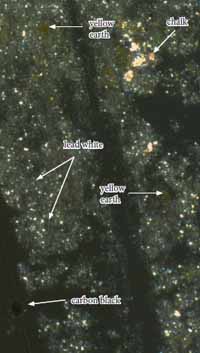 GE 36, dispersed pigment samples from generation 1b, yellow paint, cross polarized light, 1000x
GE 36, dispersed pigment samples from generation 1b, yellow paint, cross polarized light, 1000x
The yellow paint (generation 1b), is comprised of lead white (2PbCO3 ‧ Pb(OH)2), yellow ochre (Fe2O3‧ nH2O), chalk (CaCO3), and carbon black (C). The lead white particles are visible as very small, rounded transparent to greenish-colored particles with a bright birefringence in crossed polars. The yellow earth particles range in size but have a golden color in transmitted light and are dark under crossed polars. The chalk particles are visible as larger, colorless, plate-like particles with an undulose birefringence. The carbon black particles vary in size and shape but have shard-like edges, are black and opaque in transmitted light, and dark under crossed polars.
Generation 4: white paint
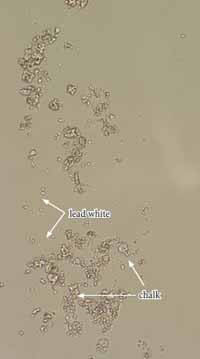 GE 40, dispersed pigment samples from generation 4, white paint, plane polarized light, 1000x
GE 40, dispersed pigment samples from generation 4, white paint, plane polarized light, 1000x
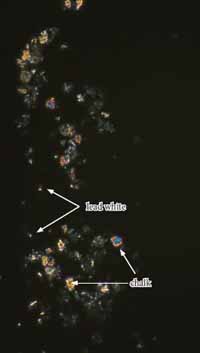 GE 40, dispersed pigment samples from generation 4, white paint, cross polarized light, 1000x
GE 40, dispersed pigment samples from generation 4, white paint, cross polarized light, 1000x
The white paint (generation 4), is comprised of lead white (2PbCO3 ‧ Pb(OH)2), and large particles of chalk (CaCO3). The lead white particles are visible as very small, rounded transparent to greenish-colored particles with a bright birefringence in crossed polars. The chalk particles are visible as larger, colorless, plate-like particles with an undulose birefringence.
Color Measurement Results
Generation 1a: white primer
 GE 36, uncast, visible light, 40x
GE 36, uncast, visible light, 40x
Accurate color readings for the first generation white primer in the dining room could not be obtained with the Minolta Chroma Meter because a clean, intact area could not be isolated for measurement. Instead, the closest commercial color match was determined by eye using a stereomicroscope at 30x magnification with a color corrected light source. The closest match was determined to be Benjamin Moore swatch OC-11 "Clay Beige".
Polarized light microscopy suggests this paint contains only lead white and chalk. Therefore, the off-white color of the present paint could result from age and deterioration of the oil binding media.9
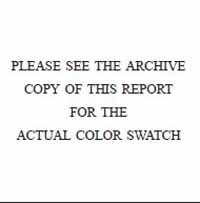 Benjamin Moore
Benjamin Moore
OC-11
"Clay Beige "
| CIE L*a*b* values | L* (black to white) | a* (green to red) | b* (blue to yellow) |
|---|---|---|---|
| 82.09 | -0.49 | +11.22 | |
| Munsell values | hue | value | chroma |
| 3.3Y | 8.1 | 1.6 |
A color match is provided below that was taken from a sample of a hand ground paint made with lead white pigment in cold-pressed linseed oil.10 This could reflect the color of the paint when it was freshly painted.
 Benjamin Moore
Benjamin Moore
OC-17
"White Dove"
| CIE L*a*b* values | L* (black to white) | a* (green to red) | b* (blue to yellow) |
|---|---|---|---|
| 93.02 | -1.08 | +5.56 | |
| Munsell values | hue | value | chroma |
| 6.8Y | 9.5 | 0.7 |
Generation 1b: yellow paint
 GE 36, uncast, visible light, 40x
GE 36, uncast, visible light, 40x
The first generation yellow paint in sample GE 36 was measured with a Minolta Chroma Meter colorimeter/microscope to obtain color values in CIE L*a*b* and Munsell color-space. To compensate for the inherent color variation in early hand ground paints, the average of two readings was determined.
| CIE L*a*b* values | L* (black to white) | a* (green to red) | b* (blue to yellow) |
|---|---|---|---|
| area 1 | 58.39 | +8.24 | +34.55 |
| area 2 | 62.20 | +6.81 | +29.68 |
| average | 60.30 | +7.53 | +32.16 |
The closest commercial color match was determined to be Benjamin Moore HC-41 "Richmond Gold." The color difference (ΔE) between this swatch and the yellow paint was calculated to be 2.47. Since the average human eye cannot detect ΔE values less than 3, this is an excellent visual match.
 Benjamin Moore
Benjamin Moore
HC-41
"Richmond Gold"
| CIE L*a*b* values | L* | a* | b* |
|---|---|---|---|
| 61.33 | +6.50 | +30.16 | |
| Munsell values | hue | value | chroma |
| 9.7YR | 6.0 | 4.8 |
Generation 4: white paint (first finish on west wall, SW window architrave)
Accurate color readings for the fourth generation white paint in the dining room could not be obtained with the Minolta Chroma Meter because a clean, intact area could not be isolated for measurement. Instead, the closest commercial color match was determined by eye using a stereomicroscope at 30x magnification with a color corrected light source. The closest match was determined to be Benjamin Moore swatch OC-32 "Tapestry Beige". However, polarized light microscopy suggests this paint contains only lead white and chalk (p.74). Therefore, the off-white color of the present paint could result from age and deterioration of the oil binding media.11
 Benjamin Moore
Benjamin Moore
OC-32
"Tapestry Beige "
| CIE L*a*b* values | L* (black to white) | a* (green to red) | b* (blue to yellow) |
|---|---|---|---|
| 83.95 | -1.57 | +9.81 | |
| Munsell values | hue | value | chroma |
| 5.6Y | 8.3 | 1.3 |
A color match is provided below that was taken from a sample of hand ground paint made with lead white pigment in cold-pressed linseed oil.12 This could reflect the color of the paint when it was freshly painted.
 Benjamin Moore
Benjamin Moore
OC-17
"White Dove"
| CIE L*a*b* values | L* (black to white) | a* (green to red) | b* (blue to yellow) |
|---|---|---|---|
| 93.02 | -1.08 | +5.56 | |
| Munsell values | hue | value | chroma |
| 6.8Y | 9.5 | 0.7 |
First-floor southeast chamber samples
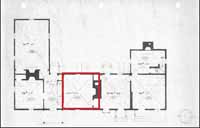 James Geddy House and Silversmith Shop, First-Floor Plan [Schlesinger, 1968] The southeast chamber is outlined in red.
James Geddy House and Silversmith Shop, First-Floor Plan [Schlesinger, 1968] The southeast chamber is outlined in red.
Sixteen samples were collected from the first-floor southeast chamber:
| GE 100 | West wall, mantel backboard, north end, 2.5" out from wall and 1/2" from top | p. 92 |
| GE 104 | South wall, left window architrave, fascia, 12" from top and 1" in from backband | p. 86 |
| GE 105 | East wall, chair rail, 3" from south wall, 1.5" up from bottom of rail | p. 88 |
| GE 106 | South wall, chair rail, 4" from west wall, 1.5" up from bottom of rail | not used |
| GE 107 | Door leaf to passage, room-side, upper left corner of lower right panel | not used |
| GE 108 | Door leaf to passage, left stile, just above bottom hinge | p. 89 |
| GE 109 | Door architrave to passage, left architrave, fascia, 37" up from floor | p. 87 |
| GE 110 | Door architrave to passage, top architrave, backband cyma, 5" from south wall | not used |
| GE 111 | Mantel, left side of backboard, 45" from floor | p. 91 |
| GE 112 | Mantel, fascia of center trim around fireplace, top element, far left edge | not used |
| GE 113 | Mantel, fascia of center trim around fireplace, right side just above plinth | p. 93 |
| GE 114 | Mantel, ovolo of outer trim around fireplace, 8" above floor | not used |
| GE 115 | Mantel, north face of outermost fillet, 55" up from floor | not used |
| GE 116 | Mantel, north face of top trim, bottom fascia | not used |
| GE 118 | Door leaf to shop, room-side. Bottom right raised panel, lower right corner, beveled edge on right, 17" up from floor | stained, p. 95-96 |
| GE 119 | Door leaf to shop, room-side. Bottom right panel, bottom right corner | not used |
| GE 129 | Baseboard, east wall, 8" in from south wall | p. 94 |
Summary of results:
Approximately twenty-nine paint generations in total were identified on the woodwork in this room. The results suggest that all elements are contemporary and first period, as opposed to the parlor, where paint stratigraphies revealed that some of the outer architrave elements were added. Interestingly, while the earliest generations in this room do not align with the colors used in the first-floor parlor or dining room, 81 they are the same as the adjacent stair passage. This chromatic link could suggest a relationship between these two spaces, one that may have naturally guided visitors from the passage into this chamber. It is also interesting to note that the exact same paint stratigraphy was found in the chamber directly above this one (second-floor southeast chamber), suggesting the woodwork in both spaces was always painted the same (see below for comparison).
The first three generations in this room are coarsely ground deep blue paints on all of the woodwork. In some samples, the boundaries between these finishes are difficult to discern, but in the samples taken from the window architrave fascia (GE 104, see below, far left), and the door leaves (GE 108 and GE 118), the boundaries are clearly visible.
Baseboards from each wall were examined but few areas had significant paint accumulations. One baseboard sample (GE 129), was fragmented, but had remnants of one of the early blue paints on the wood surface, followed by a black paint. It is very possible that the blue paint was accidentally overlapped when painting the adjacent woodwork. The black paint is most likely the first baseboard color. The rest of the sample is missing early paints, so very little is known of the baseboard color history from that point.
Generation one consists of a shellac sealant, followed by a light-blue colored primer (1a) and a coarsely-ground blue paint (1b). There is a dark thin layer on the surface of this paint that could be either grime or an oil glaze. It should be noted that the white or light-colored primer was very thin and not consistent in all samples, but it is most visible in the sample taken from the door leaves (GE 108 and GE 118).
Generation two is another blue paint that is very similar in color to the previous generation. This paint also has a thin layer of grime or oil glaze. Generation three is another deep blue paint that is very coarsely ground with very large particles of blue pigment, which appears somewhat lighter than the previous blue generations. The surface of this finish is very worn, soiled and cracked, suggesting it was exposed for a very long period of time.
Generation four is a coarsely-ground dark gray paint, and followed by generation five, another blue paint, this one a deeper blue than the previous generations. This blue paint is very coarsely ground with large blue pigment particles.
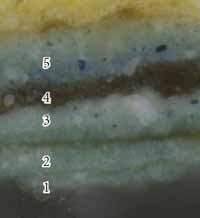 First-floor southeast chamber window architrave; GE 104b, visible light, 200x
First-floor southeast chamber window architrave; GE 104b, visible light, 200x
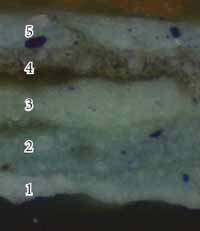 First-floor passage chair rail; GE 89, visible light, 200x
First-floor passage chair rail; GE 89, visible light, 200x
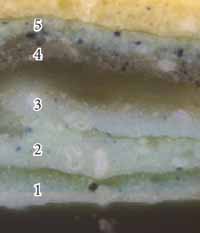 Second-floor southeast chamber, door architrave; GE 78, visible light, 200x
Second-floor southeast chamber, door architrave; GE 78, visible light, 200x
The mantel's paint stratigraphy was puzzling as it was slightly different from the rest of the woodwork (see left). The earliest paint applied to the mantel was a light yellow ochre-colored paint that was not seen in the rest of the room, and the grime-covered "hard boundary" between this light ochre paint and the first generation blue indicates that this paint was present before the rest of the room began to be painted. The reason for this is unclear, but could indicate that the mantel was made with re-used wood, or that the mantel was initially painted a color that was eventually rejected for the rest of the room, but allowed to stand for a certain length of time.
Sample GE 118 was stained with flurochromes for binding media analysis but no reactions were observed. These same paints from the stair passage (sample GE 89), were also stained, but again, no reactions were observed. This could result from the age and deterioration of these paints. Visually, these appear to be traditional oil-based paints.
For pigment analysis and color matching of the blue paints, see the Stair Passage Section, p. 133-139.
A table listing the complete paint history for the southeast chamber woodwork is found on the following page.
| Generation | Description | Observations/Analytical results |
|---|---|---|
| 20-29 | Blue-gray paints on all woodwork | modern, 20th c. (dim autofluorescence). Present finish. Probably applied by CWF. |
| 12-19 | White paints on all woodwork | contain zinc, c. 1845 or later ('twinkling' blue autofluorescence) |
| 11 | deep blue-green paint on architraves and door leaves, chair rails white, black mantel | |
| 10 | white paint on all woodwork w/black mantel | |
| 9 | resinous cream paint w/ black mantel | chair rail colors unknown in this period |
| 8 | resinous cream paint w/ black mantel | |
| 7 | light yellow-green paint on architraves and door leaves, mantel black | Paint appears finely ground and homogenous, most likely prepared industrially, postdates c. 1850. Chair rail colors unknown in this period |
| 6 | brick red paint on door leaves and chair rail, yellow paint on architraves, black mantel | Brick red paint also used in passage, shop, and second floor rooms. |
| 5 | blue paint | Found on all woodwork. Also seen in passage, shop, and second floor rooms. |
| 4 | gray paint | Found on all woodwork. Also seen in passage, shop, and second floor rooms. |
| 3 | blue paint | Found on all woodwork. Appears hand ground. Very grimy and worn at the surface, suggesting a very long period of exposure. Also used in first-floor passage and second-floor SE chamber. |
| 2 | blue paint (2a), grime or oil glaze (2b) | Found on all woodwork. Appears hand ground, very similar color and thickness to gen. 1. Also used in first-floor passage and second-floor SE chamber. |
| 1 | shellac sealant, lighter blue primer (1a), darker blue finish (1b), grime or oil glaze (1c). Black baseboards. | On mantel, blue is applied over a light-ochre colored paint not seen elsewhere. Blues appear hand ground. Grimy and worn on surface, suggesting long period of exposure, also may contain oil glaze. Also used in first-floor passage and second-floor SE chamber. |
Sample locations
85GE 104: Window architrave on south wall, left fascia
The sample from the window architrave fascia begins with three generations of blue paint, which is representative of what was seen on all of the trim in this room (with the exception of the mantel), suggesting that all of the woodwork in this space is first-period and was installed at the same time.
These blues appear to align with the early blues used in the passage and second-floor SE chamber.
Twenty-nine paint generations in total were identified on the trim (see next page).
GE 109: Door architrave to passage, left fascia, 37" up from floor
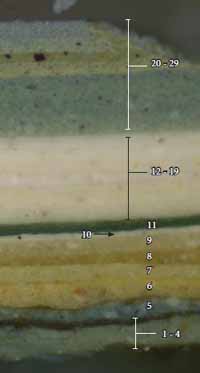 GE 109b, visible light, 100x (enlarged)
GE 109b, visible light, 100x (enlarged)
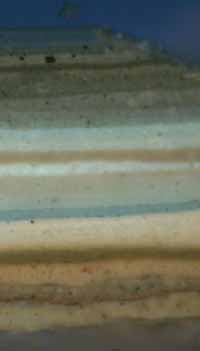 GE 109b, UV light, 100x (enlarged)
GE 109b, UV light, 100x (enlarged)
GE 105: East wall, chair rail, 3" from south wall, 1.5" up from bottom of rail
The chair rail sample begins with the same three generations of early blue paint that was seen on the rest of the woodwork in this room. In this sample, the blue paints are disrupted, blurring their boundaries.
GE 108: Door leaf to passage, left stile, above bottom hinge
The sample from the passage door leaf begins with the same three generations of blue paint seen throughout the room, an indication that this leaf is first-period and contemporary with the rest of the woodwork. The first generation shellac (1a), and light-colored primer (1a) are clearly visible here. They are less visible in other samples.
GE 118: Door leaf to shop, bottom right raised panel, lower right corner
The sample from the door leaf leading to the shop begins with the same three generations of blue paint, an indication that this leaf is first-period and contemporary with the rest of the woodwork in this room. The first generation shellac (1a), and light-colored primer (1a) are clearly visible here. They are less visible in other samples.
GE 111: Mantel, left side of backboard, 45" from floor
From generations 12 to the present, the mantel was painted to match the rest of the woodwork. From generations 6-11, the mantel was painted black while the rest of the woodwork was painted a variety of colors. The early blue paint generations were found on the mantel, although the earliest generation is a grimy light ochre-colored paint that was not seen elsewhere in the room (see next page).
GE 100: Mantel, top left side of backboard, ½" from top
The light ochre-colored paint seen as the earliest layer applied to the mantel was not seen elsewhere in the room. The hard boundary between this paint and the first generation blue paint strongly suggests this is a finish coat, not a primer. It is unclear why this ochre-colored paint was found on the mantel only, but it is possible that this element was constructed using wood that had been previously painted.
In this sample, generation two appears to be another ochre-colored paint, but there are blue pigment particles in its matrix. It is possible that this paint simply appears different in this particular sample.
GE 113: Mantel, fascia of center trim, right jamb just above plinth
Like sample GE 100, the sample GE 113 shows that the first generation blue paint on the mantel was applied over an existing light ochre-colored paint. This paint was not seen elsewhere in the room.
The earliest generations are disrupted in this sample, but the first three blue paints appear to be present.
GE 129: Baseboard, east wall
The first paint applied to the baseboards is the blue paint on the rest of the woodwork, which was probably accidentally "slopped over" when the wainscot was being painted. The black paint above this is most likely from the first baseboard paint generation, similar to the black baseboards in the rest of the house, although this evidence is fragmentary.
Binding Media Analysis (Fluorochrome staining): TTC for carbohydrate and FITC for proteins
GE 118: Door leaf to shop, bottom right raised panel
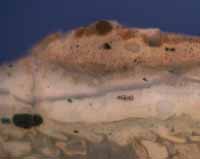 GE 118a, UV light, 400x. Before TTC stain.
GE 118a, UV light, 400x. Before TTC stain.
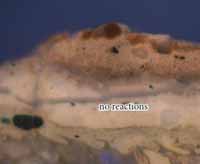 GE 113a, UV light, 400x. TTC reaction.
GE 113a, UV light, 400x. TTC reaction.
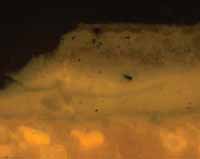 GE 118a, B-2A filter, 400x. Before FITC stain.
GE 118a, B-2A filter, 400x. Before FITC stain.
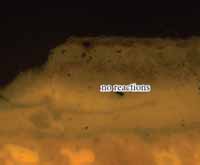 GE 113a, B-2A filter, 400x. FITC reaction.
GE 113a, B-2A filter, 400x. FITC reaction.
Sample GE 118 was stained with TTC to tag carbohydrates in the sample (top). No reactions (a dark reddish-brown color) were observed.
The sample was repolished and stained with FITC to tag proteinaceous materials in the sample (bottom). No reactions (a bright yellow-green fluorescence) were observed.
Binding Media Analysis (Fluorochrome staining): DCF for lipids (oils)
GE 118: Door leaf to shop, bottom right raised panel
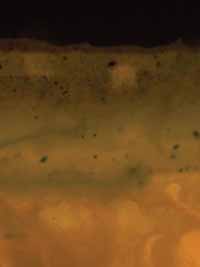 GE 118a, B-2A filter, 400x. Before DCF stain.
GE 118a, B-2A filter, 400x. Before DCF stain.
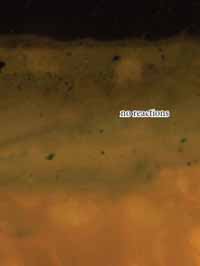 GE 113a, B-2A filter, 400x. DCF reaction.
GE 113a, B-2A filter, 400x. DCF reaction.
The sample was repolished a second time and stained with DCF to tag lipids (oils) in the sample. No reactions (a bright yellow-green fluorescence), were observed.
First Floor, Shop
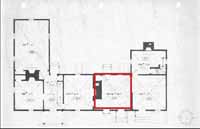 James Geddy House and Silversmith Shop, First-Floor Plan [Schlesinger, 1968]. The Shop is outlined in red.
James Geddy House and Silversmith Shop, First-Floor Plan [Schlesinger, 1968]. The Shop is outlined in red.
Four samples have been collected from the shop woodwork:
| GE 101 | Left door architrave, fascia, 30" up from floor | p. 101 |
| GE 102 | Left door architrave, backband cyma, 17" up from floor | not used, redundant |
| GE 103 | Door leaf to bedchamber, upper left corner of bottom left panel | not used, redundant |
| GE 117 | Door leaf to bedchamber, bottom left corner of bottom right panel | p. 100, staining 102-103 |
Summary of results:
The only original and/or old woodwork in the shop is the door leaf and door architrave in the west wall, leading to the first-floor southeast bedchamber. The architectural report (Schlesinger) suggests that the door leaf may be an early addition or that it first served as a closet. E. Chappell noted that the door has scars indicating it was rehung from the other side, and that the hinges were moved or replaced, but that it looks early and matches the other door leaves on the first floor.
The cross-section microscopy results confirm that the shop door leaf is first-period, as its finishes on the opposite side (facing the southeast chamber) align with the rest of the woodwork sampled in that room (see sample GE 118, page 90). Therefore, the paint history of the door on the shop-side must date back to the first period as well, since there is no evidence of scraping or stripping on that side. However, comparison of the paint history on the leaf with the paint history of the architrave indicates that the latter is an addition, since the earliest finish aligns with generation 7 on the door leaf.
Twenty-two paint generations were identified on the shop door leaf. The first finish is a shellac sealant followed by a thin, brown paint made with red ochre and carbon black pigments (PLM). Binding media analysis was inconclusive, but it appears to be a traditional oil-based paint. The surface of this paint is 98 worn and disrupted suggesting it was exposed for a long period of time.
Generation 2 has a tannish color and translucent quality in visible light, with a few scattered white and yellow particles visible in the cross-section. In UV, this coating has a bright autofluoresence suggestive of a resinous binder. This finish is very dirty and disrupted and would have been exposed for a long period of time.
The next generation is a dark gray paint that aligns with the fourth generation in the adjacent southeast chamber and the first-floor stair passage. Therefore, generation three is either missing or the leaf was unpainted in this period.
Generations 5 and 6 are blue and brick-red colored paints, respectively. These same painted were also seen in the adjacent southeast chamber and the first-floor stair passage, as well as the second-floor southeast chamber.
Generation seven is a cream paint (7a) that was followed by a yellow paint (7b) only on the door architrave. This was the earliest generation on the architrave, suggesting that it was installed later.
Generation eight contains 'twinkling' particles of zinc white, suggesting this paint dates to the mid-nineteenth century or later.
Binding media analysis was carried out but was mostly inconclusive. The first generation red-brown paint (1b), did not exhibit any positive reactions, while the shellac sealant (generation 1a), did exhibit positive reactions for carbohydrates (TTC+) and oils (DCF+).
The complete paint history for the shop is shown on the table below:
| Generation | Description | Observations/Analytical results |
|---|---|---|
| 15 — 22 | modern (20th c.) paints | whites, grays, sage green colors. Current color white |
| 11 — 14 | white paint | on all woodwork, appears industrially prepared |
| 10 | leaf red-brown, trim white | |
| 9 | leaf brown, trim white | |
| 8 | brown paint | contains zinc, post-dates c. 1845 |
| 7 | Door architrave installed, both painted cream while architrave was painted yellow over cream base | appears hand ground, coarse pigment particles |
| 6 | brick red paint | also seen in adjacent southeast chamber (gen. 6) and passage |
| 5 | blue paint | also seen in adjacent southeast chamber (gen. 5) and passage |
| 4 | gray paint | also seen in adjacent southeast chamber (gen. 4) and passage |
| 3 | unpainted | |
| 2 | tan or off-white paint | bright autofluorescence, possibly resinous |
| 1 | shellac sealant, brown paint | Appears hand ground, coarse pigment particles. Made with red earth and carbon black (PLM). Worn and grimy, exposed for long period of time |
First floor, shop paint sample locations
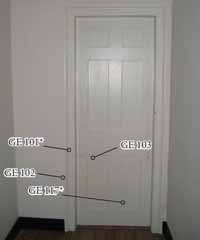 west wall, door leaf and architrave
west wall, door leaf and architrave
GE 117: door leaf to bedchamber, bottom left corner of bottom right panel
GE 101: door architrave, left fascia, 30" up from floor
The first generation applied to the architrave woodwork is a cream-colored primer (7a) and a yellow-gold paint (7b). Generation 7a was also seen on the door leaf, but without the yellow-gold finish coat. This confirms that the architrave is later than the leaf.
Binding Media Analysis (Fluorochrome staining): TTC for carbohydrate and FITC for proteins
GE 117: door leaf to bedchamber, bottom left corner of bottom right panel
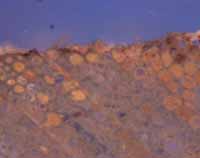 GE 117, UV light, 400x. Before TTC stain.
GE 117, UV light, 400x. Before TTC stain.
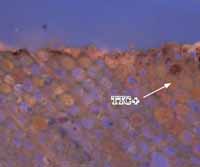 GE 117, UV light, 400x. TTC reaction.
GE 117, UV light, 400x. TTC reaction.
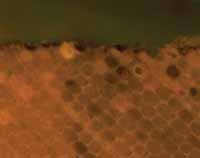 GE 117, B-2A filter, 400x. Before FITC stain.
GE 117, B-2A filter, 400x. Before FITC stain.
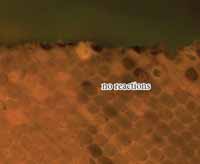 GE 117, B-2A filter, 400x. FITC reaction.
GE 117, B-2A filter, 400x. FITC reaction.
Sample GE 117 was stained with TTC to tag carbohydrates in the sample (top). A slight reaction (a dark reddish-brown color) was observed in the shellac sealant.
The sample was repolished and stained with FITC to tag proteinaceous materials in the sample (bottom). No reactions (a bright yellow-green fluorescence) were observed.
Binding Media Analysis (Fluorochrome staining): DCF for lipids (oils)
GE 117: door leaf to bedchamber, bottom left corner of bottom right panel
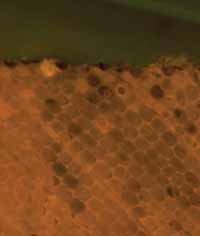 GE 117, B-2A filter, 400x. Before DCF stain.
GE 117, B-2A filter, 400x. Before DCF stain.
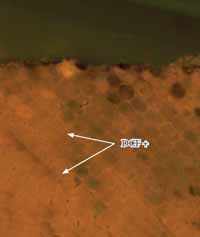 GE 117, B-2A filter, 400x. DCF reaction.
GE 117, B-2A filter, 400x. DCF reaction.
Sample GE 117 was repolished and stained with DCF to tag lipids in the sample (top). A slight reaction (a yellow-green fluorescence) was observed in the shellac sealant, but not in the brown paint itself.
Pigment Identification
GE 117: Generation 1 brown paint on shop door leaf
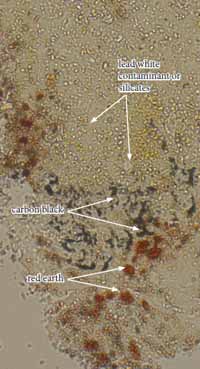 Dispersed pigments from generation 1 brown paint on shop door, plane polarized transmitted light, 1000x
Dispersed pigments from generation 1 brown paint on shop door, plane polarized transmitted light, 1000x
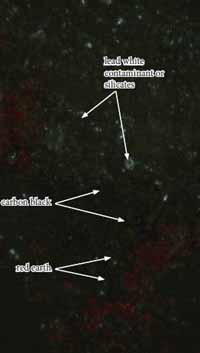 Dispersed pigments from generation 1 brown paint on shop door, plane polarized transmitted light, 1000x
Dispersed pigments from generation 1 brown paint on shop door, plane polarized transmitted light, 1000x
The first generation brown paint on the shop door appears to be composed of a mixture of red earth (ochre), and charcoal black pigments. Red earth is visible as agglomerations of deep red to orange-red particles that are isotropic (dark) in crossed polars. Carbon black is visible as small black, opaque particles with sharp edges that are isotropic (dark) in crossed polars.
There are some small, rounded, colorless particles included in this sample that are birefringent. These could be silicate inclusions that accompany earth pigments, or particles of lead white pigment from generation two that contaminated this sample.
Color Matching
Generation 1 brown paint on shop door leaf
Accurate color readings for the first generation brown paint in the shop could not be obtained with the Minolta Chroma Meter because a clean, intact area could not be isolated for measurement. Instead, the closest commercial color match was determined by eye using a stereomicroscope at 30x magnification with a color corrected light source. The closest match was determined to be Colonial Williamsburg (Martin Senour) color #114 "Everard Washboard Brown".
 Colonial Williamsburg
Colonial Williamsburg
#114
"Everard Washboard Brown"
| CIE L*a*b* values | L* (black to white) | a* (green to red) | b* (blue to yellow) |
|---|---|---|---|
| 28.59 | +7.31 | +4.38 | |
| Munsell values | hue | value | chroma |
| 7.5R | 2.8 | 1.6 |
First-floor Passage and Stair
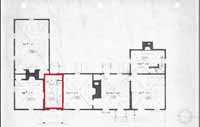 James Geddy House and Silversmith Shop, First-Floor Plan
James Geddy House and Silversmith Shop, First-Floor Plan
[Schlesinger, 1968]. The stair passage is outlined in red.
To date, twenty-three paint samples have been collected from the first-floor passage and stair woodwork. Five of Mark Kutney's best samples from this space were examined and re-photographed for inclusion:
| GE 17 | Door architrave to parlor, right jamb, backband, 22" up from floor | fragmented, not used |
| GE 18 | Door architrave to parlor, right jamb, fascia, 20" up from floor | p. 117 |
| GE 19 | Door leaf to parlor, center stile, ovolo, 16" up from floor | fragmented, not used |
| GE 20 | Door architrave to dining room, left jamb, backband, 31" up from floor | p. 119 |
| GE 21 | Door architrave to dining room, left jamb, fascia, 30" up from floor | fragmented, not used |
| GE 22 | Door leaf to dining room (not original), left stile, just above bottom H-L hinge | p. 123 |
| GE 89 | West wall, chair rail, adjacent to dining room door, 5" from north wall | p. 114, staining 131-132 |
| GE 90 | Stair stringer, west face, fascia just beneath top trim, under 3rd baluster | fragmented, not used |
| GE 91 | Stair, shaft of 1/2 baluster on newel post on landing | fragmented, not used |
| GE 92 | Stair, newel post on landing btwn 1st and 2nd floors | missing early layers, not used |
| GE 93 | Stair, handrail fascia, above 2nd baluster up from landing btwn 1st and 2nd floors | p. 128 |
| GE 94 | Stair, second floor, 1/2 newel post against east wall | p. 126 |
| GE 95 | Stair, underside of bottom trim of second floor landing, adjacent to the central newel that extends to the ceiling. | p. 129 |
| GE 128 | Baseboard, east wall, just beneath stair stringer, far north end near closet under stairs | p. 130 |
| GE 130 | Stair, handrail, fascia, south face, above the 5th baluster down from the landing | fragmented, not used |
| 107 | ||
| GE 131 | Stair, handrail, bottom bead, above second baluster down from landing, south face | disrupted, not used |
| GE 132 | Stair, just above GE 131, fascia of handrail | disrupted, not used |
| GE 133 | Stair, half baluster at landing, bottom of shaft (large flake came off accidentally, collected for sampling) | disrupted, not used |
| GE 134 | Stair, baluster, first down from 1/2 newel at landing, plinth | p. 125 |
| GE 135 | Stair, unknown location, large flake collected for sampling | not used |
| GE 138 | Column on top of newel at stair landing on second floor, extends to ceiling, east face, 3" above bottom of newel | p. 129 |
| GE 139 | Stair, baluster, second floor, 8th out from landing newel, top of shaft | disrupted, not used |
| GE 140 | First floor, north entrance door, east side above H-L hinge | p. 122 |
| Kutney GE 79 | Door architrave (top) to parlor, backband, far left end | p. 116 |
| Kutney GE 80 | Door leaf to parlor, center stile, ovolo | p. 121 |
| Kutney GE 114 | Door leaf to SE bedchamber, bottom right panel, top edge | p. 120 |
| Kutney GE 117 | Door architrave to SE bedchamber, top architrave, fascia | p. 115 |
| Kutney GE 128 | Door architrave to dining room, west jamb, fascia | p. 118 |
Summary of results:
The paint evidence in the first-floor passage suggests that all old woodwork is first-period and contemporary (with the exception of the dining room door leaf, a known later addition). There do not appear to have been any later upgrades to the woodwork like those in the parlor.
The samples from the chair rails (GE 89) and the door architraves (GE 18 and GE 20, Kutney sample GE 117), contained good early paint evidence for the trim in this space. The first three generations appear to be the same coarsely-ground blue paints used in the adjacent first-floor southeast bedchamber and the second-floor southeast bedchamber (see p. 81 for comparison of samples from these spaces), starting with a shellac sealant, a light blue primer (1a), and a blue finish coat (1b), followed by a second generation blue that appears very similar in color to the first (2), and a third generation blue (3). All of these paints are coarsely ground and contain occasional large Prussian blue pigment particles (PLM).
The earliest paints were stained with fluorochromes to analyze their binding media, but no reactions were observed. This could result from the age and deterioration of these early paints. Visually, these finishes appear to be traditional oil-based paints.
Polarized light microscopy was carried out on the first three blue paint generations. All contained primarily lead white and Prussian blue as the predominant pigments. The light blue primer (1a) contained lead white, Prussian blue, and possibly carbon black (which could also originate from soiling particles). Generations 1b and 2 could not be isolated for analysis, and together contained lead white, chalk, Prussian blue, yellow earth, and carbon black pigments. Generation three contained lead white, chalk, and Prussian blue. All of these pigments are consistent with 18th-century paints.
The samples from the parlor and southeast chamber door leaves were very disrupted (Kutney samples GE 114 and GE 80), but the extant paints suggest that these leaves are first-period and were finished in the 108 same manner (ie: painted blue), as the rest of the trim in generations 1-3. It should be noted that the opposite sides of these doors (facing the first-floor southeast chamber and parlor), also contained first-period paint evidence.
The sample taken from the door leaf to the dining room (GE 22), confirmed that this was a mid-19th century addition, as the earliest paint aligned with generation eleven, a white paint, on its associated architrave. This was immediately followed by a wood graining finish (generation 12) that contained 'twinkling' particles of zinc white, a mid-19th century pigment.
The finishes on the stair were complex and the generations did not always align, with the exception of the panelling on the underside of the stair (GE 95), which contained the same three generations of blue paints found in the rest of the passage. The samples from the half-newel on the second floor (GE 94), the stringer (GE 90) and the handrail (GE 93) all contained at least one or more of the early passage blues, but these were interspersed with light gray or cream-colored paints that were not seen in the rest of the passage. In the case of the half-newel, these could be wall paints that were accidentally applied to the newel, but it is unclear why the handrail and stringer contain other paints. They are almost always grimy and disrupted, suggesting they were exposed for a long period of time. This might suggest that the certain elements of the stair were 'picked out' in different colors in the early period (for instance, in generation one the handrail might have been white while the rest of the stair was blue, while in generations 2 and 3 the stringer was lighter gray while the handrail and rest of the passage woodwork was blue). The exact schemes are uncertain but the stair does appear to be first-period and contemporary with the rest of the original woodwork in the passage.
109The complete paint history for the first-floor stair passage and the stair can be found on the following table:
| Generation | Description | Observations/Analytical results |
|---|---|---|
| 19-23 | modern, industrial paints | 20th c. (finely ground, dim autofluorescence). Present finish. Probably applied by CWF. |
| 13-18 | mid-19th c. paints (mostly white on trim) | Contain zinc (ID via 'twinkling' blue autofluorescence), c.1845 or later, stair picked out in darker colors and finishes |
| 12 | trim white, door leaves wood grained | Stair handrail picked out in darker color or finish |
| 10-11 (dining room door added) | trim repainted white | Stair handrail picked out in darker color or finish |
| 9 | trim repainted white | Stair handrail picked out in darker color or finish |
| 8 | trim white, door leaves gray | Stair handrail picked out in darker color or finish |
| 7 | trim cream, door leaves gray | Stair handrail picked out in darker color or finish |
| 6 | brick red paint | Found on all woodwork. Used throughout house. |
| 5 | blue paint, balusters and handrail red-brown | Found on all woodwork, large coarse pigment particles. Used throughout house (except for red-brown) |
| 4 | gray paint, balusters and handrail red-brown | Found on all woodwork. Used throughout house. (except for red-brown). |
| 3 | blue paint | Found on all woodwork. Appears hand ground. Very grimy and worn at the surface, suggesting a very long period of exposure. Also used in first and second-floor SE chamber. Stair stringer possibly 'picked out' in lighter color (?) |
| 2 | blue paint | Found on all woodwork. Appears hand ground, very similar color and thickness to gen. 1b. Also used in first and second-floor SE chambers. Stair stringer possibly 'picked out' in lighter color (?) |
| 1 | shellac sealant, light blue primer (1a), blue paint (1b). Stair handrail white (?) | Found on all original woodwork. Blues appear hand ground. Grimy and worn on surface, suggesting long period of exposure, also may contain oil glaze. Also used in first and second-floor SE chambers. |
First-floor Stair Passage Paint Sample Locations
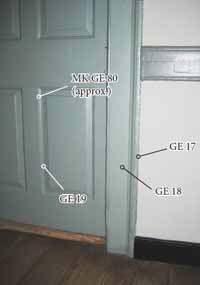 Door to parlor (exact location of Kutney sample unknown)
Door to parlor (exact location of Kutney sample unknown)
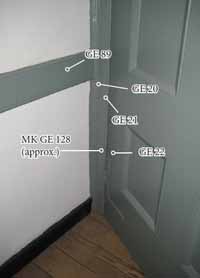 Door to dining room (exact location of Kutney sample unknown)
Door to dining room (exact location of Kutney sample unknown)
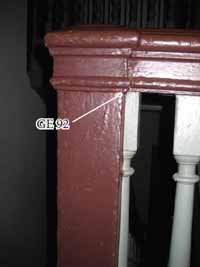 landing between 1st and 2nd floors
landing between 1st and 2nd floors
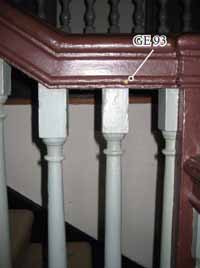 handrail from landing to 2nd floor
handrail from landing to 2nd floor
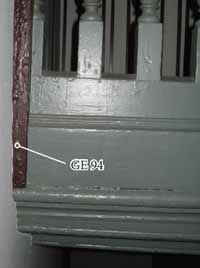 ½ newel on second floor, east wall
½ newel on second floor, east wall
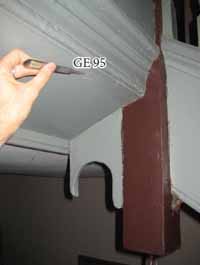 bottom trim of second floor stair
bottom trim of second floor stair
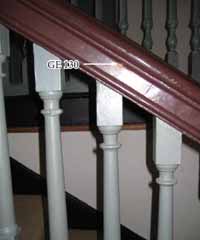 handrail fascia, south face, above the 5th baluster down from the landing
handrail fascia, south face, above the 5th baluster down from the landing
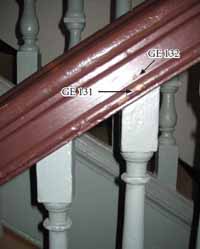 south face, above second baluster down from the landing
south face, above second baluster down from the landing
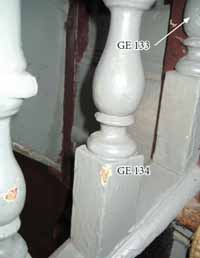 first baluster down from ½ baluster on landing
first baluster down from ½ baluster on landing
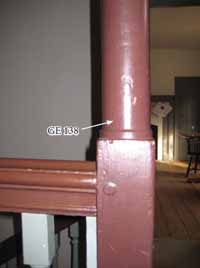 second floor, column on top of newel, extends to ceiling
second floor, column on top of newel, extends to ceiling
GE 89: chair rail, west wall, adjacent to dining room doorway, 5" south of the north end
On the chair rail, three early blue paint generations were observed. These are the same blue paints used in the adjacent SE chamber and the second-floor SE chamber. Generation 1a is a light blue-colored primer, followed by generation 1b, a coarsely-ground blue paint. Generation two is another blue paint that is coarsely ground and a very similar color to generation one. There is a thin, tan-colored layer on the surface that could be an oil glaze (2b). Generation three is another blue paint that also has an oil glaze on its surface.
Generation 4 is a dark gray paint. Generation 5 is another coarsely-ground blue, and generation 6 is a brick-red paint. These paints were seen throughout the stair passage and the rest of the house.
Kutney sample GE 117: Door architrave to bedchamber, top architrave, fascia
The paints on the door architrave to the bedchamber align with the rest of the original woodwork in the passage, starting with three generations of coarsely ground blue paints, a dark gray paint (4), another blue paint (5), and a brick red paint (6). In this sample, the earliest generations are disrupted and their boundaries are not as clear.
Kutney sample GE 79: Door architrave (top) to parlor, backband, far left end, bottom edge
The sample from the door architrave to the parlor (GE 79) aligns with the rest of the trim in the passage, starting with three generations of blue paints, a gray paint (4), another blue paint (5, very thin here), and the sixth generation brick red paint.
GE 18: Door architrave to parlor, right jamb, fascia
Although the earliest paints are disrupted, the paints on the parlor door architrave fascia are shown here to illustrate that they are the same as those found on the backband (previous page). The first three blue paint generations appear to be present, although they are disrupted and their boundaries are blurred for the most part. The rest of the stratigraphy aligns with the rest of the woodwork in this space.
Kutney sample GE 128: Door architrave to dining room, west jamb, fascia
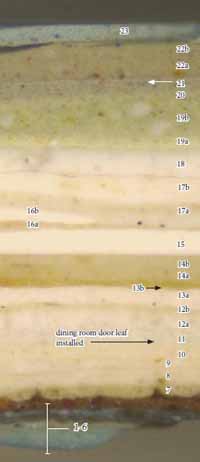 MK_GE 128c, visible light, 100x
MK_GE 128c, visible light, 100x
The door architrave to the dining room contains the same early paints (generations 1-6) as the chair rail (GE 89) and the door architrave to the bedchamber (Mark Kutney sample GE 117, p. 115). The sample is shown here in its entirety to illustrate that there were twenty-three paint generations in total identified in the passage. The dining room door leaf appears to begin with generation 11.
GE 20: door architrave to dining room, left jamb, backband
Sample GE 20 from the dining room door architrave backband aligned with the other passage trim samples with some puzzling exceptions. The earliest paint is a white coating with a thin yellowish paint on top. This appears similar to the first generation paint in the dining room, and could be some of that paint accidentally applied on the passage trim, although this is uncertain. The same early blues were seen, although their boundaries are blurred, and they are followed by a thin light-gray-colored paint that was not seen elsewhere in the passage. This could be a wall paint that overlapped onto the backband.
Kutney sample GE 114: Door leaf to bedchamber, bottom right panel, top edge
The early paints on the door leaf to the bedchamber are disrupted, but the evidence aligns with its associated architrave (Kutney sample GE 117, p. 115), and the rest of the original woodwork in the passage, starting with three generations of coarsely ground blue paints. (As previously discussed, the bedchamber-side finishes on this particular leaf (GE 108, p. 89), suggest this door is first-period). The oil glaze and/or grime on top of generation two is very thick in this sample.
Kutney sample GE 80: Door leaf to parlor, center stile, ovolo
Mark Kutney's sample from the parlor door leaf had more early paint evidence than sample GE 19 (taken by Travers— very disrupted, not shown), although the complete stratigraphy is still not intact. However, the extant paints suggest that this door is original and that the earliest blue paint generations are present. (As previously discussed, the parlor-side finishes on this particular leaf (GE 8, p. 22), suggest this door is first-period).
GE 140: North entrance door, bottom rail
The early paint evidence on the bottom rail of the north entrance door is very disrupted, but it does appear to align with the early blues seen on the rest of the woodwork in this space. This would confirm that this door leaf is also first period.
GE 22: Door leaf to dining room (dates to c.1850), passage-side, left stile just above bottom hinge
The style of the door leaf to the dining room suggests it dates to the mid-19th century (see Chappell Sample Memo, Appendix D). This was confirmed by the paint evidence, which, when compared to the associated architrave (see Kutney sample GE 128, p.118 and sample GE 20, p. 119), revealed that the earliest finish is generation 11, a white paint with a peach-colored autofluorescence that is followed by generation 12, a wood graining finish. This graining finish contains 'twinkling' particles of zinc white pigment and this appears to be contemporary with the white paint (also containing zinc) on the architrave.
GE 95: Underside of stair trim on second floor (accessible by standing on first floor stair)
The paint evidence on the underside of the stair trim aligns with the rest of the original woodwork in the passage, starting with three generations of coarsely ground blue paints, although their boundaries are somewhat blurred in this sample.
Only the earliest paints in the sample are shown above.
GE 134: Baluster, first down from half newel at landing, plinth
All of the samples taken from the balusters had very disrupted early paint evidence. Sample GE 134 was the most intact. It appears to contain the same three early blues seen in the rest of the stair passage, although their boundaries are blurred here. The fourth generation gray paint and the fifth generation blue paints were not seen in any of the baluster samples. Instead, the balusters appear to have been painted dark brown or red-brown from generations 4-6.
GE 94: Second floor, ½ newel post against east wall, bottom edge
The sample from the newel post contains the same early blue paints, although a cream-colored paint follows generation one that was not seen in the other samples. This sample was taken very close to the second-floor wall, so this could originate from an early wall paint. There were also two thick tannish, cloudy coatings with bright autofluorescences (above generations three and six), that could represent wallpaper pastes.
GE 90: Stair stringer on first floor, under third baluster up from bottom, fascia just under top trim
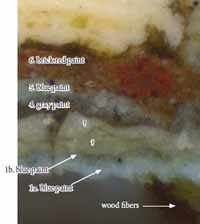 GE 90a, visible light, 200x (enlarged)
GE 90a, visible light, 200x (enlarged)
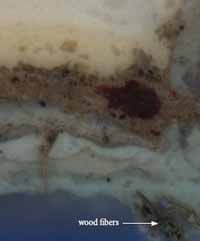 GE 90a, UV light, 200x (enlarged)
GE 90a, UV light, 200x (enlarged)
In sample GE 90, taken from the stringer, the first blue paint generations is present on the wood substrate. This is followed by two generations not seen in the rest of the passage- a grayish-green-colored paint, and a lighter grayish paint with a bright autofluorescence, although it is unclear if these are different paints, or if these are the same blue paints in the rest of the passage, but they are simply degraded here.
Additional samples were taken but the evidence is very disrupted on the stair, which made it difficult to pin down these early finishes.
GE 93: bottom bead of handrail, east face above the 2nd baluster up from landing
The sample from the handrail (GE 93) is puzzling, as the first paint generation is clearly a white paint that was not seen elsewhere in the passage, or in any other samples taken from the stair. The surface of this paint is uneven and worn, and covered with a layer of tannish grime, which strongly suggests this was a finish layer. Perhaps the handrail alone was 'picked out' in white in the first period or was primed white and left unpainted for a period of time. The answer is unclear.
The second and third generation blue paints are more clearly seen here. Generations 4 is the red-brown paint also seen on the balusters, and generation 5 appears to be a brown paint although it is very disrupted and soiled. The sixth generation brick red paint used in the rest of the passage is also seen here, which has a dull red-brown matrix with larger red-brown pigment particles.
This is followed by a wood graining finish that was also seen on the second floor passage woodwork.
The handrail was re-sampled in multiple locations but this was the most intact sample.
GE 138: Column on second floor, extends to ceiling
The column on the second floor does not appear to contain any historic paints. In fact, the extant paints align with the later paints on the stair handrail (see sample GE 93, previous page). However, the wood in this sample does not appear to have been stripped. Multiple excavations were made on this element but the same paints were always found. The architectural report states that this is an old, and most likely original feature of the house, so the reason for these missing paints is unclear.
GE 128: Baseboard, east wall, under staircase and adjacent to closet (under stair)
The earliest paint on the stair passage baseboards is a black paint. Generation two is a dark brown paint, and generation three is another black paint. This is immediately followed by 19th c. zinc white paints, which suggests that this sample is missing intermediate finishes.
Binding Media Analysis (Fluorochrome staining): TTC for carbohydrates
GE 89: West wall, chair rail (continued on next page)
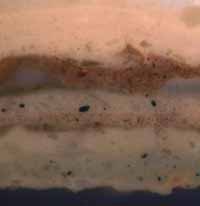 GE 89, UV light, 400x. Before TTC stain.
GE 89, UV light, 400x. Before TTC stain.
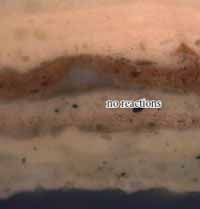 GE 89, UV light, 400x. TTC reaction.
GE 89, UV light, 400x. TTC reaction.
Sample GE 89 was stained with TTC to tag carbohydrates in the sample. No reactions (a red-brown color), were observed. The sample was also stained with FITC for proteins (see below). No reactions (a bright yellow-green fluorescence) were observed.
Binding Media Analysis (Fluorochrome staining): FITC for proteins
Binding Media Analysis (Fluorochrome staining): DCF for lipids (oils)
GE 89: west wall, chair rail
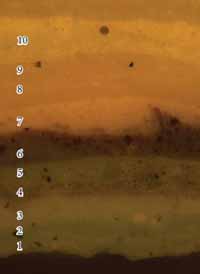 GE 89, B-2A filter, 400x. Before DCF stain.
GE 89, B-2A filter, 400x. Before DCF stain.
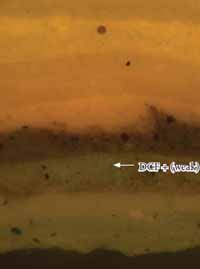 GE 89, B-2A filter, 400x. DCF reaction.
GE 89, B-2A filter, 400x. DCF reaction.
Sample GE 89 was stained with DCF to tag lipids (oils). A very weak reaction (a yellow-green fluorescence) was observed in generation five, the later blue paint. No other reactions were observed in the sample.
Pigment Identification Results
Generation 1a blue primer
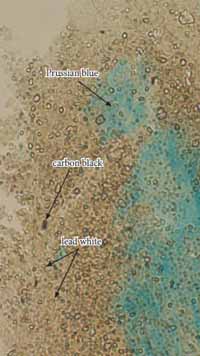 Dispersed pigments from generation 1a blue paint in stair passage, plane polarized transmitted light, 1000x
Dispersed pigments from generation 1a blue paint in stair passage, plane polarized transmitted light, 1000x
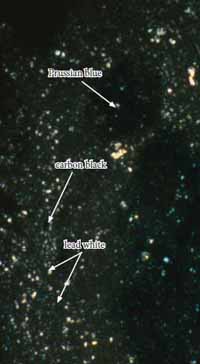 Dispersed pigments from generation 1a blue paint in stair passage, cross polarized transmitted light, 1000x
Dispersed pigments from generation 1a blue paint in stair passage, cross polarized transmitted light, 1000x
The first generation blue primer appears to contain primarily lead white pigment (2PbCO3 ‧ Pb(OH)2), visible as small, rounded particles with high relief, that are colorless to greenish in transmitted plane polarized light and have a bright birefringence in cross polarized light.
Particles of Prussian blue (Fe4[Fe(CN)6]3), were also present, visible as bright blue areas of pigmentation in a range of shapes and sizes, always with low relief, soft edges, and a 'smeary' quality in some areas. This pigment is isotropic (dark) in crossed polars.
There were a few scattered particles of carbon black (C), visible as small, sharp-edged black particles of varying size that were isotropic in crossed-polarized light. These particles could also originate from a soiling layer. It is unclear if this was a deliberate pigmentation.
Generation 1b and 2 blue paint (could not be separated)
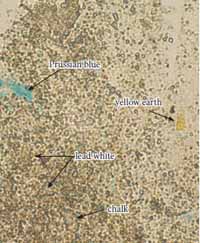 Dispersed pigments from generation 1b and 2 blue paint in stair passage, plane polarized transmitted light, 1000x
Dispersed pigments from generation 1b and 2 blue paint in stair passage, plane polarized transmitted light, 1000x
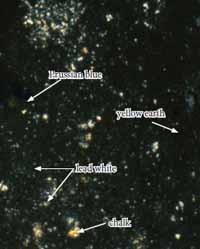 Dispersed pigments from generation 1b and 2 blue paint in stair passage, plane polarized transmitted light, 1000x
Dispersed pigments from generation 1b and 2 blue paint in stair passage, plane polarized transmitted light, 1000x
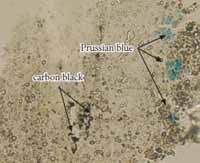 Dispersed pigments from generation 1b and 2 blue paint in stair passage, plane polarized transmitted light, 1000x
Dispersed pigments from generation 1b and 2 blue paint in stair passage, plane polarized transmitted light, 1000x
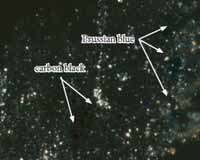 Dispersed pigments from generation 1b and 2 blue paint in stair passage, cross polarized transmitted light, 1000x
Dispersed pigments from generation 1b and 2 blue paint in stair passage, cross polarized transmitted light, 1000x
The first (1b) and second generation blue paints could not be isolated for analysis, and were examined together. The sample appears to contain primarily lead white pigment (2PbCO3 ‧ Pb(OH)2), visible as small, rounded particles with high relief, that are colorless to greenish in transmitted plane polarized light and have a bright birefringence in cross polarized light.
Chalk (CaCO3), was also present in this sample, visible as larger particles with sharp edges, high relief and an unulose birefringence.
Particles of Prussian blue (Fe4[Fe(CN)6]3), were also present, visible as bright blue areas of pigmentation in a range of shapes and sizes, always with low relief, soft edges, and a 'smeary' quality in some areas. This pigment is isotropic (dark) in crossed polars.
There were also particles of carbon black (C), visible as small, sharp-edged black particles of varying size that were isotropic in crossed-polarized light, as well as some yellow earth pigment (Fe2O3 ‧ nH2O), visible as yellow particles of varying size with low relief, that are isotropic under crossed polars.
Generation 3 blue paint
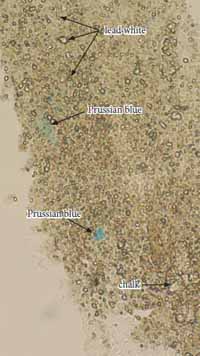 Dispersed pigments from generation 3 blue paint in stair passage, plane polarized transmitted light, 1000x
Dispersed pigments from generation 3 blue paint in stair passage, plane polarized transmitted light, 1000x
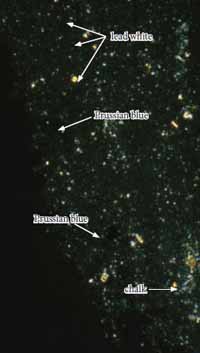 Dispersed pigments from generation 3 blue paint in stair passage, cross polarized transmitted light, 1000x
Dispersed pigments from generation 3 blue paint in stair passage, cross polarized transmitted light, 1000x
The third generation blue paint appears to contain primarily lead white pigment (2PbCO3 ‧ Pb(OH)2), visible as small, rounded particles with high relief, that are colorless to greenish in transmitted plane polarized light and have a bright birefringence in cross polarized light.
Chalk (CaCO3), was also present in this sample, visible as larger particles with sharp edges, high relief and an unulose birefringence.
Particles of Prussian blue (Fe4[Fe(CN)6]3), were also observed, visible as bright blue areas of pigmentation in a range of shapes and sizes, always with low relief, soft edges, and a 'smeary' quality in some areas. This pigment is isotropic (dark) in crossed polars.
Color Measurement Results
Generation 1 light blue base coat (1a) and blue finish coat (1b)*
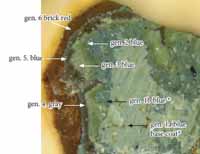 underside of uncast sample GE 89, 100x
underside of uncast sample GE 89, 100x
Accurate color readings for the first generation blue base coat (generation 1a), and blue finish coat (generation 1b), could not be obtained with the Minolta Chroma Meter because a clean, intact area could not be isolated for measurement. Instead, the closest commercial color match was determined by eye using a stereomicroscope at 30x magnification with a color corrected light source. The closest match for the base coat was determined to be Sherwin Williams #6214 "Underseas", while the match for the finish coat was Benjamin Moore AC-21 "Silver Pine".
 Sherwin Williams
Sherwin Williams
#6214
"Underseas"
| CIE L*a*b* values | L* (black to white) | a* (green to red) | b* (blue to yellow) |
|---|---|---|---|
| 58.12 | -8.56 | -0.22 | |
| Munsell values | hue | value | chroma |
| 3.3BG | 5.7 | 1.6 |
 Benjamin Moore
Benjamin Moore
AC-21
"Silver Pine"
| CIE L*a*b* values | L* (black to white) | a* (green to red) | b* (blue to yellow) |
|---|---|---|---|
| 44.40 | -9.86 | +0.79 | |
| Munsell values | hue | value | chroma |
| 1.1BG | 4.3 | 1.9 |
Generation 2 blue paint
* same as first-floor southeast chamber and second-floor southeast chamber.
Accurate color readings for the second generation blue paint could not be obtained with the Minolta Chroma Meter because a clean, intact area could not be isolated for measurement. Instead, the closest commercial color match was determined by eye using a stereomicroscope at 30x magnification with a color corrected light source. The closest match for the base coat was determined to be Sherwin Williams #6222 "Riverway".
 Sherwin Williams
Sherwin Williams
#6222
"Riverway"
| CIE L*a*b* values | L* (black to white) | a* (green to red) | b* (blue to yellow) |
|---|---|---|---|
| 45.54 | -6.76 | -4.84 | |
| Munsell values | hue | value | chroma |
| 1.6B | 4.5 | 1.8 |
Generation 3 blue paint
* same as first-floor southeast chamber and second-floor southeast chamber.
The third generation blue paint was measured with a Minolta Chroma Meter colorimeter/microscope to obtain color values in CIE L*a*b* and Munsell color-space. Readings were obtained from two different areas measuring 0.3 mm across, and averaged together resulting in one value.
| CIE L*a*b* values | L* (black to white) | a* (green to red) | b* (blue to yellow) |
|---|---|---|---|
| area 1 | 54.43 | -8.21 | +2.10 |
| area 2 | 54.50 | -8.15 | +2.03 |
| average | 54.47 | -8.18 | +2.07 |
The closest commercial match for this paint was determined by eye using a stereomicroscope at 30x magnification with a color corrected light source. The closest match was determined to be Sherwin Williams #0047 "Studio Blue-Green." The color difference (ΔE) between this swatch and the actual sample was calculated as 3.64. Since the human eye cannot detect color differences at values of 3 or less, this would be considered a very close match.
 Sherwin Williams
Sherwin Williams
#0047
"Studio Blue-Green"
| CIE L*a*b* values | L* (black to white) | a* (green to red) | b* (blue to yellow) |
|---|---|---|---|
| 52.35 | -8.21 | -0.89 | |
| Munsell values | hue | value | chroma |
| 4.3BG | 5.1 | 1.6 |
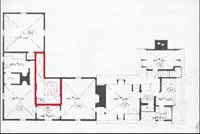 James Geddy House and Silversmith Shop, Second-Floor Plan [Schlesinger, 1968]. The stair passage
is outlined in red.
James Geddy House and Silversmith Shop, Second-Floor Plan [Schlesinger, 1968]. The stair passage
is outlined in red.
Six samples were collected from the second-floor stair passage:
| GE 64 | Doorway at north end of east partition wall, right architrave, stop, 16 ½" up from floor | p. 146 |
| GE 65 | Door architrave to northwest room, right architrave, cyma of backband, 26 ½" up from floor | redundant, not used |
| GE 66 | Door leaf to northwest room, bottom right raised panel, 27" up from bottom of door, far right end | disrupted, not used |
| GE 67 | Door leaf to northwest room, bottom ovolo of lock rail, 25 ½" from left edge of leaf | p. 145, staining p. 148-149, uncast p. 153 |
| GE 68 | Door leaf to northwest room, underside of bottom left raised panel, beveled edge | redundant, not used |
| GE 69 | West wall of partition, door architrave leading to smaller east passage, left architrave, cyma of backband, 23" up from floor | disrupted, not used |
| GE 121 | Door leaf between north and south passages (south side), bottom edge of bottom right panel | redundant, not used |
| GE 122 | Door leaf to SE room, bottom edge of bottom right panel | redundant, not used |
| Kutney GE 207 | Door leaf to northwest room, bottom right panel, bottom right corner, flat surface | p. 144 |
| Kutney GE 209 | Door architrave on north wall, top architrave leading to NW room | p. 147 |
Summary of results:
The early paints in the second-floor stair passage appear to be different from the paints used on the first-floor passage. Two architrave samples had good evidence (GE 64 and Kutney sample GE 209), as did two of the door leaf samples (GE 67 and Kutney sample GE 207).
The first generation is a shellac sealant (1a), and a gray paint which contains fine black particles and occasional yellow particles in a lead white matrix (identified by its peach-colored autofluorescence in UV light). Kutney sample GE 207 contained strong evidence showing this paint to be a finish, not a primer, as there was a distinct boundary between this gray paint and the next generation.
Generation two is a light blue paint. This was found on all surfaces and was determined to be a finish layer because it had a cracked and soiled surface in Kutney sample 207 and GE 67.
Comparison of all samples collected from the second-floor passage woodwork indicates that generation
three was a polychrome scheme. At this time, the door leaves were painted with a coarsely-ground deep
blue paint, while the trim was glazed with a green glaze that most likely contains verdigris, based on its
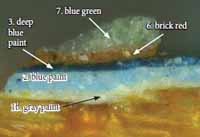 Door leaf to NW room
Door leaf to NW room
GE 67a, visible light, 400x
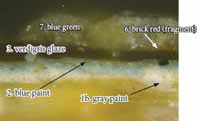 Door architrave to NW room
Door architrave to NW room
Kutney sample 209, visible light, 400x
complete lack of autofluorescence in UV light. There are no pigment particles in this layer, suggesting it is
a glaze, not a paint. This layer is very discolored and appears dark brown in cross-section. This has been
designated generation three, although it is unclear exactly which finishes were present in the rest of the
house when this was applied.
Generations four and five, a gray paint and blue paint, respectively, which were seen in almost every space in the house, were not seen in any of the samples from the second-floor passage, strongly suggesting that the blue and green polychrome finish was exposed for a long period of time.
The complete finish history for the second-floor stair passage is found in the table below:
| Generation | Description | Observations/Analytical results |
|---|---|---|
| 16-23 | modern (20th c.) paints | presently painted blue-green |
| 8-15 | zinc white paints | zinc white identified by its 'twinkling' autofluorescent particles. Post-dates c.1845 |
| 7 | blue-green resinous paint | very grimy, exposed for long period of time |
| 6 | brick red paint | used throughout the house |
| 4-5 | unpainted (?) | gray and blue paints used throughout the house, not seen in any samples from this space |
| 3 | deep blue paint on door leaves, verdigris green on trim | |
| 2 | light blue paint | coarsely ground, cracked and grimy, probably aligns with one of the blue paint generations on first-floor. |
| 1 | shellac sealant (1a), gray paint (1b) | gray paint also seen in some samples from the second-floor SW chamber |
Second-floor, Eastern Passage Leading from Stair to Rear (Northwest) Room, Paint Sample Locations
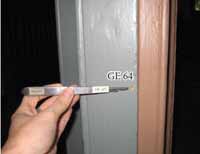 Doorway at north end of east wall
Doorway at north end of east wall
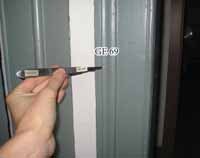 Doorway on west partition wall
Doorway on west partition wall
Second-floor, Eastern Passage from Stair to Northwest Room
Kutney sample GE 207: Door leaf to northwest room, lower right panel, bottom right corner
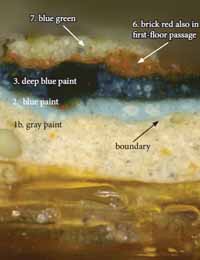 Kutney sample GE 207b, visible light, 200x
Kutney sample GE 207b, visible light, 200x
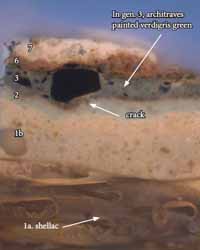 Kutney sample GE 207b, UV light, 200x
Kutney sample GE 207b, UV light, 200x
This sample contained evidence to show that the earliest gray paint is a finish coat, not a primer. This is suggested by the "hard boundary" between it and generation two. This gray paint was also seen in the second-floor southwest chamber, although it was applied much more thinly. There was very little dirt or grime observed on the surface of this gray paint, suggesting it was not exposed for very long. It is even possible that this was a primer for the blue paint (generation 2), that was exposed for a longer period of time that usual before receiving a finish coat.
Generation two is a blue paint that has cracks and grime on the surface, suggesting it was exposed for a long period of time. This blue paint appears similar to one of the first three blue paint generations used on the woodwork in the first-floor passage, but it is unclear precisely which blue paint this aligns with.
Generation three is a deep blue paint. Comparison of all second-floor passage samples indicates that this deep blue was used on the doors, while the trim was glazed with a verdigris-green finish (see architrave samples for comparison).
The brick red paint is the same as the brick red paint used on the first-floor passage woodwork in generation six. Its location within the stratigraphy here suggests that the woodwork in the second-floor passage was painted less often than that on the first-floor.
GE 67: Door leaf to northwest room, bottom ovolo of lock rail
Like the other door leaf sample (Kutney GE 207), sample 67 has a very intact early stratigraphy, as well. Generation 1 is the shellac sealant (1a) and gray paint (1b). This generation was not present in all samples from the second-floor passage, but appears to be a finish layer as evidenced by Kutney sample GE 207 (previous page).
GE 64: Doorway architrave at east wall (to bathroom), right architrave stop
The first and second generation paints on the architrave stop (shellac sealant (1a), gray paint (1b), and light blue paint (2)) align with what was found in the rest of the second-floor stair passage (see next section).
The third generation finish is a dark-colored layer which has a dark greenish color in visible light (very dark in the printed image) and no autofluorescence in UV, strongly suggesting this a verdigris or copper resinate glaze. This would be contemporary with the deep blue paint on the door leaves.
Generation six is the brick red paint used throughout the house in this period.
Kutney sample GE 209: Door architrave to northwest room, top architrave
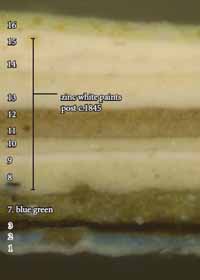 Kutney sample 209, visible light, 200x
Kutney sample 209, visible light, 200x
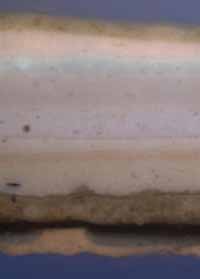 Kutney sample 209, UV light, 200x
Kutney sample 209, UV light, 200x
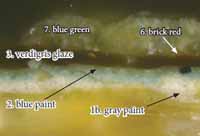 Kutney sample 209, visible light, 400x
Kutney sample 209, visible light, 400x
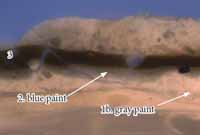 Kutney sample 209, UV light, 400x
Kutney sample 209, UV light, 400x
The early finishes on the architrave to the northwest room begin with the gray paint (1b), and the light blue paint (2), which is followed by a deep green verdigris glaze (3). The verdigris glaze is believed to be contemporary with the deep blue paint on the door leaves.
The sixth generation brick red paint was observed under the microscope in a very small remnant above generation 3 in this sample (although it is difficult to see in the printed image).
Binding Media Analysis (Fluorochrome staining): TTC for carbohydrates
GE 67: door leaf to northwest room (continued on next page)
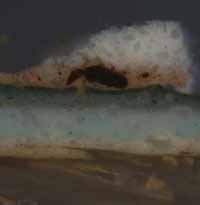 GE 67, UV light, 400x. Before TTC stain.
GE 67, UV light, 400x. Before TTC stain.
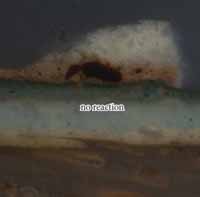 GE 67, UV light, 400x. TTC reaction.
GE 67, UV light, 400x. TTC reaction.
Sample GE 67 was stained with TTC to tag carbohydrates in the sample. No reactions (a red-brown color), were observed. The sample was also stained with FITC for proteins (see below). No reactions (a bright yellow-green fluorescence) were observed.
Binding Media Analysis (Fluorochrome staining): FITC for proteins
Binding Media Analysis (Fluorochrome staining): DCF for lipids (oils)
GE 67: door leaf to northwest room (continued from previous page)
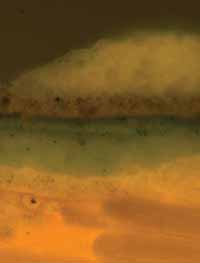 GE 67, B-2A filter, 400x. Before DCF stain.
GE 67, B-2A filter, 400x. Before DCF stain.
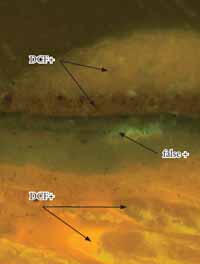 GE 67, B-2A filter, 400x. DCF reaction.
GE 67, B-2A filter, 400x. DCF reaction.
Sample GE 67 was stained with DCF to tag lipids in the sample. A strong reaction (yellow-green fluorescence) was observed in the wood substrate, most likely from oil-based paints applied to the surface. However, no reactions were observed in generations 1-3 (the 'patch' of fluorescence is most likely residual stain and is not a true reaction). There was a weak reaction in generations 6 and 7.
Pigment Identification Results
Generation 1 gray paint*
*also seen in second-floor southwest chamber (analyzed by Sara Lapham)
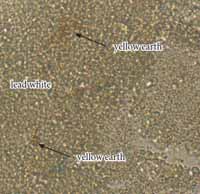 Dispersed pigments from generation 1 gray paint in second floor stair passage (GE 67), plane polarized transmitted
light, 1000x
Dispersed pigments from generation 1 gray paint in second floor stair passage (GE 67), plane polarized transmitted
light, 1000x
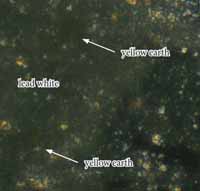 Dispersed pigments from generation 1 gray paint in second floor stair passage (GE 67), cross polarized transmitted
light, 1000x
Dispersed pigments from generation 1 gray paint in second floor stair passage (GE 67), cross polarized transmitted
light, 1000x
The first generation gray paint is mostly comprised of lead white (2PbCO3 ‧ Pb(OH)2), and carbon black (C), pigments. Yellow ochre (Fe2O3 ‧ nH2O), was also present, visible as larger particles with amorphous edges and a deep yellow color in transmitted light that are isotropic in crossed polars. This paint was also used in the second-floor southwest chamber, and Sara Lapham identified the same pigments.
Generation 2 blue paint*
*also seen in second-floor northwest chamber
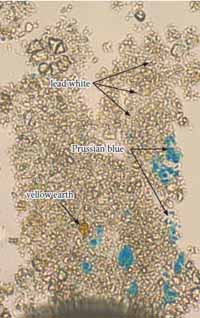 Dispersed pigments from generation 2 blue paint in second floor stair passage (GE 67), plane polarized transmitted
light, 1000x
Dispersed pigments from generation 2 blue paint in second floor stair passage (GE 67), plane polarized transmitted
light, 1000x
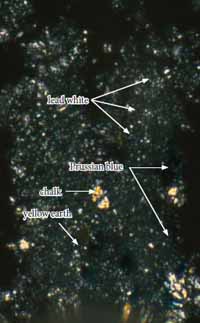 Dispersed pigments from generation 2 blue paint in second floor stair passage (GE 67), cross polarized transmitted
light, 1000x
Dispersed pigments from generation 2 blue paint in second floor stair passage (GE 67), cross polarized transmitted
light, 1000x
The second generation blue paint is comprised of lead white (2PbCO3 ‧ Pb(OH)2), and chalk (CaCO3), as well as a good deal of Prussian blue (Fe4[Fe(CN)6]3), and some yellow ochre pigments.
Generation 3 deep blue paint*
*also seen in second-floor northwest chamber
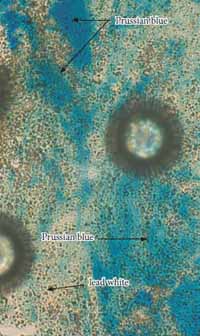 Dispersed pigments from generation 3 blue paint in second floor stair passage (GE 67), plane polarized transmitted
light, 1000x
Dispersed pigments from generation 3 blue paint in second floor stair passage (GE 67), plane polarized transmitted
light, 1000x
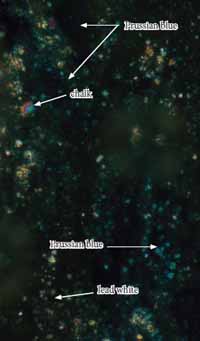 Dispersed pigments from generation 3 blue paint in second floor stair passage (GE 67), cross polarized transmitted
light, 1000x
Dispersed pigments from generation 3 blue paint in second floor stair passage (GE 67), cross polarized transmitted
light, 1000x
The third generation dark blue paint is comprised of large amount of Prussian blue (Fe4[Fe(CN)6]3), which has a very high tinting strength and accounts for its deep blue-black color. Some lead white (2PbCO3 ‧ Pb(OH)2), and chalk (CaCO3) particles were also identified.
Color Measurement Results
Generation 1 gray paint
* same as second-floor southwest chamber (also measured by Sara Lapham)
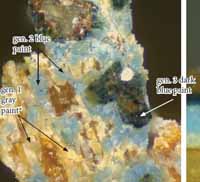 underside of uncast sample GE 67, 100x
underside of uncast sample GE 67, 100x
Accurate color readings for the first generation gray paint could not be obtained with the Minolta Chroma Meter because a clean, intact area could not be isolated for measurement. Instead, the closest commercial color match was determined by eye using a stereomicroscope at 30x magnification with a color corrected light source. The closest match for the gray paint was determined to be Benjamin Moore AC-31 "Hot Spring Stones". Please note that this is a lighter match than the Laphams' gray paint match for the second-floor southwest chamber. For confirmation, swatch AC-31 was compared to several of the southwest chamber samples, and this does appear to be the correct color. Soiling and disruption of the early paint layers could be the source of this inconsistency.
 Benjamin Moore
Benjamin Moore
AC-31
"Hot Spring Stones"
| CIE L*a*b* values | L* (black to white) | a* (green to red) | b* (blue to yellow) |
|---|---|---|---|
| 76.61 | +0.41 | +8.94 | |
| Munsell values | hue | value | chroma |
| 1.6Y | 7.6 | 1.3 |
Generation 2 blue paint*
*same as second-floor northwest chamber
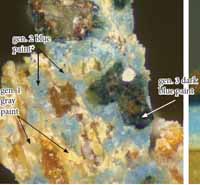 underside of uncast sample GE 67, 100x
underside of uncast sample GE 67, 100x
Accurate color readings for the second generation blue paint could not be obtained with the Minolta Chroma Meter because a clean, intact area could not be isolated for measurement. Instead, the closest commercial color match was determined by eye using a stereomicroscope at 30x magnification with a color corrected light source. The closest match for the base coat was determined to be Sherwin Williams #6494 "Lakeshore".
 Sherwin Williams
Sherwin Williams
#6494
"Lakeshore"
| CIE L*a*b* values | L* (black to white) | a* (green to red) | b* (blue to yellow) |
|---|---|---|---|
| 58.25 | -12.40 | -15.33 | |
| Munsell values | hue | value | chroma |
| 6.2B | 5.7 | 4.5 |
Generation 3 dark blue paint*
*same as second-floor northwest chamber
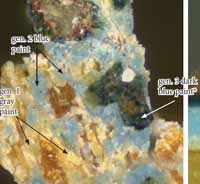 underside of uncast sample GE 67, 100x
underside of uncast sample GE 67, 100x
Accurate color readings for the third generation blue paint could not be obtained with the Minolta Chroma Meter because a clean, intact area could not be isolated for measurement. Instead, the closest commercial color match was determined by eye using a stereomicroscope at 30x magnification with a color corrected light source. The closest match for the base coat was determined to be Benjamin Moore 2062-10 "Polo Blue".
 Benjamin Moore
Benjamin Moore
2062-10
"Polo Blue"
| CIE L*a*b* values | L* (black to white) | a* (green to red) | b* (blue to yellow) |
|---|---|---|---|
| 25.81 | +0.30 | -7.43 | |
| Munsell values | hue | value | chroma |
| 3.8PB | 2.5 | 1.8 |
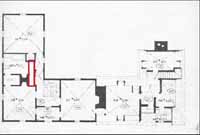 James Geddy House and Silversmith Shop, Second-Floor Plan [Schlesinger, 1968]. The small western
passage is outlined in red.
James Geddy House and Silversmith Shop, Second-Floor Plan [Schlesinger, 1968]. The small western
passage is outlined in red.
Two samples were collected from the small, western second-floor passage:
| GE 62 | Doorway at north end of east partition wall, left architrave, cyma of backband, 32" up from floor | too disrupted, not used |
| GE 63 | Doorway at north end of east partition wall, right architrave casing, 23" up from floor | p. 157, staining p. 158-159 |
Summary of results:
Most of the woodwork in this space is new, with the exception of the doorway at the north end of the east partition wall. From this doorway, only sample GE 63, taken from the right architrave casing, contained an intact stratigraphy, which aligns with the samples taken from the second-floor passage (discussed in detail in the previous section).
Second-floor, Small Western Passage Linking Southwest Chamber and Current Bathroom towards Northern (Rear) End of Stair Passage, Paint Sample Locations
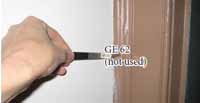 Doorway at north end of east wall, backband
Doorway at north end of east wall, backband
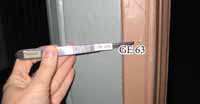 Doorway at north end of east wall, casing
Doorway at north end of east wall, casing
The first and second generation paints on the architrave stop are a shellac sealant (1a), followed by a gray paint (1b). Generation two is a blue paint (2), while generation three (3) is a verdigris glaze (now dark and discolored) that corresponds to the period when the passage door leaves were painted deep blue and the trim was glazed green. These finishes align with what was found in the rest of the second-floor stair passage (see sample GE 67, taken from the door leaf to the northwest chamber, p. 144).
Binding Media Analysis (Fluorochrome staining): TTC for carbohydrates
GE 63: Door at north end of east partition wall, right architrave casing (continued on next page)
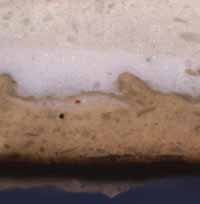 GE 63, UV light, 400x. Before TTC stain.
GE 63, UV light, 400x. Before TTC stain.
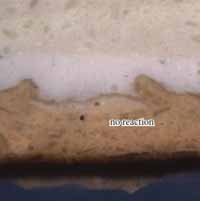 GE 63, UV light, 400x. TTC reaction.
GE 63, UV light, 400x. TTC reaction.
Sample GE 63 was stained with TTC to tag carbohydrates in the sample. No reactions (a red-brown color), were observed. The sample was also stained with FITC for proteins (see below). No reactions (a bright yellow-green fluorescence) were observed.
Binding Media Analysis (Fluorochrome staining): FITC for proteins
Binding Media Analysis (Fluorochrome staining): DCF for lipids (oils)
GE 63: Door at north end of wall, right architrave casing (continued from previous page)
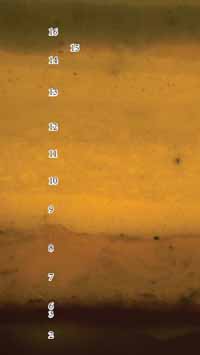 GE 63, B-2A filter, 400x. Before DCF stain.
GE 63, B-2A filter, 400x. Before DCF stain.
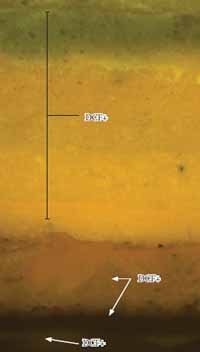 GE 63, B-2A filter, 400x. DCF reaction.
GE 63, B-2A filter, 400x. DCF reaction.
Sample GE 63 was stained with DCF to tag lipids in the sample. Strong reactions (yellow-green fluorescence) were observed in the later zinc white paints (generations 9-16). Weak reactions were observed in generations 2, 6, 7, and 8.
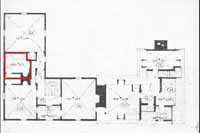 James Geddy House and Silversmith Shop, Second-Floor Plan [Schlesinger, 1968]. The bathroom is outlined in red.
James Geddy House and Silversmith Shop, Second-Floor Plan [Schlesinger, 1968]. The bathroom is outlined in red.
Six samples were collected from the current second-floor bathroom. This bathroom was originally part of the northwest room, and was constructed during the Restoration as a necessary convenience (Waterman 1932, 20). The sash could not be sampled as it was covered with a metal grille.
| GE 70 | West wall, right window architrave, cyma of backband, 24" up from bottom | p. 163 |
| GE 71 | West wall, left window architrave, fascia, 24" up from bottom | disrupted, not used |
| GE 72 | South wall, right door architrave, cyma of backband, 57" up from floor | redundant, not used |
| GE 73 | South wall, door leaf, bottom right raised panel, lower left corner, underside of beveled edge | p. 165 |
| GE 74 | South wall, top door architrave, far right end, underside of bottom bead | p. 164 |
| GE 75 | South wall, closet door leaf, closet-side, lower left panel, upper left corner | p. 166 |
Summary of results:
The samples from the window architrave (GE 70), door architrave (GE 74), and door leaf (GE 73) contain intact early finishes to suggest that the finishes in the bathroom align with what was found in the rest of the second-floor passage.
The first generation is a shellac sealant (1a), and followed by the gray paint (1b). Generation two is a blue paint (2), while in generation three (3), the door leaf was painted deep blue and the architraves were glazed green with a verdigris glaze.
The woodwork in this room appears to have not been repainted in generations 4 - 6. Interestingly, the sixth generation brick red paint used throughout the house was not found in any of the samples taken from this room. It was, however, found in samples from the second-floor northwest room 161 (see next section), which was originally part of this bathroom. The reason for this is unclear, but it is possible that the brick red paint is deteriorated and simply missing from these samples. This would need to be clarified through additional sampling.
Generations 7 and 8 appear to be resinous paints, as they are translucent in visible light and have a bright autofluorescence in UV light. These paints appear quite similar, but are actually two separate generations — a blue-green (7) and an olive green (8) colored-paint.
The closet-side of the closet door leaf was not painted as often as the rest of the room. The earliest paint is a white paint that does not appear to be the same as the gray used in the rest of the room and the second-floor passage. In generation two, this side of the leaf was painted blue along with the rest of the woodwork in the room. In generations 3 - 6, this side of the leaf was unpainted.
The complete finish history for the second-floor bathroom is found in the table below:
| Generation | Description | Observations/Analytical results |
|---|---|---|
| 19-26 | modern (20th c.) paints | presently painted blue-green |
| 9-18 | zinc white paints | zinc white identified by its 'twinkling' autofluorescent particles. Post-dates c.1845 |
| 7, 8 | blue-green resinous paints | seen throughout house |
| 4-6 | unpainted | - |
| 3 | deep blue paint on door leaves, verdigris green on trim | also used in second-floor passage and NW room, closet-side of leaf unpainted. Cracked and disrupted, exposed for long period of time. |
| 2 | light blue paint | also used in second-floor passage and NW room |
| 1 | shellac sealant (1a), gray paint (1b) | also used in second-floor passage, adjacent NW room, and gray paint also seen in some samples from the second-floor SW chamber. Closet-side of door leaf painted white in this period. |
Second-floor, Current Bathroom (Northwest Room), Paint Sample Locations
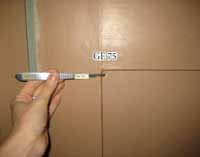 Doorway, south wall (inferior side)
Doorway, south wall (inferior side)
GE 70: West wall, right window architrave, cyma of backband
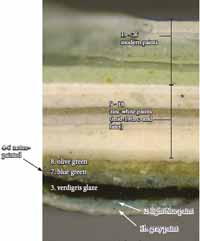 GE 70a (far right side), visible light, 100x
GE 70a (far right side), visible light, 100x
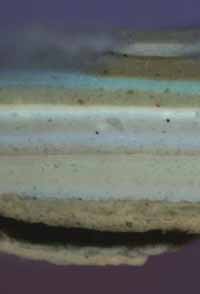 GE 70a (far right side) visible light, 100x
GE 70a (far right side) visible light, 100x
GE 74: South wall, top door architrave, underside of bottom bead
GE 73: South wall, door leaf, bottom right raised panel, lower left corner, underside, beveled edge
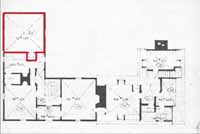 James Geddy House and Silversmith Shop, Second-Floor Plan [Schlesinger, 1968]. The northwest room is outlined in red.
James Geddy House and Silversmith Shop, Second-Floor Plan [Schlesinger, 1968]. The northwest room is outlined in red.
The only old woodwork appeared to be the window architrave on the west wall, and the door leaf and architrave to the passage. Four samples were studied from this room:
| GE 97 | Center stile of door leaf to passage, 26" above floor | p. 169 |
| GE 98 | Right architrave of door to passage, fascia, 29" up from floor | p. 170 |
| GE 99 | South wall, baseboard, fascia, 2" above floor | p. 172 |
| Kutney GE 206 | West wall, window, top architrave fascia, at north miter joint | p. 171 |
Summary of results:
The results suggest this room was finished similarly to the second-floor passage and current bathroom (the latter having been originally part of this room). The first generation is a shellac sealant (1a), and gray paint (1b). Generation two is a coarsely-ground blue paint. Generation three is the period during which the door leaves were painted deep blue, while the trim (architraves) were glazed with a verdigris glaze. This scheme was also seen in the passage and the bathroom. However, in this room, there is one anomaly- the sample from the door architrave to the passage (GE 98) did not contain the verdigris glaze, but only the deep blue paint. This would suggest that the door architrave AND the door leaf were both painted deep blue at this time. However, the verdigris glaze was seen on the window architrave (Kutney sample GE 206), in this period.
The earliest finish in the sample taken from the baseboard (GE 99), is a thin layer of black paint (1b), followed by a thin layer of autofluorescent varnish (1c). This was followed by the brick-red paint that appears to align with generation six in the rest of the house, which would suggest that the baseboards remained unpainted (black) in generations 2-5.
For stain reactions, pigment composition (PLM), and color matches for the early paints in this room, please see the "Stair Passage (Second-Floor)" section.
168The complete finish history for the second-floor northwest room is found in the table below:
| Generation | Description | Observations/Analytical results |
|---|---|---|
| 11-19 | modern (20th c.) paints | presently painted blue-green |
| 8-10 | zinc white paints | zinc white identified by its 'twinkling' autofluorescent particles. Post-dates c.1845 |
| 7 | wood graining on door leaf, zinc white paint on trim | different from adjacent bathroom |
| 6 | brick red paint | also found on baseboards, not found anywhere in adjacent bathroom |
| 4-5 | unpainted | — |
| 3 | deep blue paint on door leaf and door architrave, verdigris green on window architrave | also used in second-floor passage and bathroom, but in these spaces the door architraves were always glazed green. Baseboards unpainted |
| 2 | light blue paint | also used in second-floor passage and bathroom. Baseboards unpainted |
| 1 | shellac sealant (1a), gray paint (1b) on all woodwork, baseboards black (1b) with varnish (1c) | also used in second-floor passage, adjacent bathroom, and gray paint also seen in some samples from the second-floor SW chamber. |
GE 97: Center stile of door leaf to passage, 26" above floor, 1" from left edge
Generations 1 - 3 on the door leaf are the same as those seen in the second-floor passage and the adjacent bathroom (originally part of this room). However, in generation three, the door leaf was painted deep blue, as was the door architrave (see sample GE 98, next page). In generations 4 and 5, this room was not repainted. This was followed by the sixth generation brick-red paint used throughout the house.
GE 98: Right architrave of door to passage, fascia, 29" up from floor
Like the sample from the door leaf (GE 97), the door architrave (GE 98) contains the first generation gray paint (1) followed by the second generation blue paint (2). However, in generation three, the door architrave appears to have been painted deep blue (3) to match the door leaf. This is different to what was found in the rest of the second-floor passage and bathroom, where the door architraves were glazed green while the leaves were dark blue. Interestingly, the window architrave (Kutney sample GE 206, next page), was glazed green in period three.
Kutney sample 206: west wall, window, top architrave fascia at north miter joint
Like the door leaf and door architrave, the window architrave contains the first generation gray paint (1b), followed by the second generation blue paint (2). In the third generation, when the door leaf and architrave were painted deep blue, the window architrave was glazed green (3) with a verdigris glaze.
GE 99: South wall, baseboard, fascia, 2" above floor and 4" west of passage architrave backband
The earliest finish on the baseboard is a shellac sealant (1a), a thin layer of black paint (1b), and a very thin layer of autofluorescent varnish (1c). This is worn and uneven suggesting it was exposed for a long period of time, possibly through generations 2-5, because it is followed by what appears to be the brick red paint that aligns with generation 6 in the rest of the house. This is followed by a thick layer of orange-red paint that was designated generation two in the second-floor southwest chamber (Lapham 2012). However, this sample illustrates that the orange-red paint belongs to a later finish generation.
Second-floor, Southeast Chamber
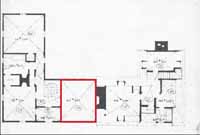 James Geddy House and Silversmith Shop, Second-Floor Plan [Schlesinger, 1968]. The southeast
chamber is outlined in red. Second-floor, Southeast Chamber
James Geddy House and Silversmith Shop, Second-Floor Plan [Schlesinger, 1968]. The southeast
chamber is outlined in red. Second-floor, Southeast Chamber
Eight samples were collected from the second-floor southeast chamber. The passage door architrave is old, but the room-side of the door leaf was covered with a metal plate and could not be sampled. The window architrave on the south wall also appeared old, as did the mantel, and possibly the baseboards. The rest of the woodwork is new.
| GE 78 | West wall, door architrave, north jamb, cyma of backband, 30" from floor | p. 177-178 |
| GE 79 | West wall, door architrave, north jamb, fascia, 25" up from floor | redundant, not shown |
| GE 80 | South wall, window architrave, east jamb, backband fillet, 12" up from bottom of architrave | p. 179 |
| GE 81 | South wall, window architrave, west jamb, fascia, 6" from bottom | disrupted, not shown |
| GE 82 | East wall, mantel, north end, dentil | p. 181 |
| GE 83 | South wall, lower window sash, top central muntin, near center of fillet | p. 180 |
| GE 84 | East wall, mantel, top surface of shelf | no early paint, not shown |
| GE 85 | East wall, baseboard, fascia, 4" north of mantel, 1" from top of baseboard | p. 182 |
Summary of results:
This room appears to have been finished almost identically to the first-floor southeast chamber directly below (see p. 81 for comparison). The samples collected from the passage door architrave (GE 78, GE 79), contained very intact early paint evidence, although the samples from the window architrave and sash (GE 80, GE 81, GE 83), were not as complete. The samples collected from the mantel (GE 82, GE 84), contained early finishes that did not clearly align with the rest of the room.
Generations 1-3 on the door architrave (and probably the window, although they were somewhat disrupted), are blue paints. The first generation is a light blue primer (1a), followed by a light blue paint (1b), and a thin oil-based glaze (1c). The second generation is a similar blue paint (2a), coated with a thin oil-based glaze (2b). The third generation (3), is another very similar coarsely ground blue paint.
174Generations four and five are gray and blue paints, respectively, which were also used in the first-floor southeast chamber, shop, and passage woodwork.
The earliest paint in the sample from the window sash (GE 83), appears to be generation five, the blue paint. This would suggest that the sash is later, or that early paints are missing from this element.
The paint stratigraphy of the mantel is interesting in that it does not align with what was found in the rest of the room. The earliest finish is a deep green-colored paint (1b). This color is clearly different from any other first period finishes in the house. This is followed by a dark gray paint, followed by a black paint in a manner that suggests a "wet into wet" technique, suggestive of a faux-finish, possibly to imitate marble. However, this would need to be confirmed by scraping away later paints to expose this finish. The gray base paint could align with the gray paint used in the rest of the room in generation four, although this is uncertain. These findings suggest that the mantel might have been painted very differently from the rest of the woodwork in the room, or it might have been re-used from another house.
The complete history of the second-floor southeast chamber is found below:
| Generation | Description | Observations/Analytical results |
|---|---|---|
| 16-26 | modern, 20th c. paints | Presently painted gray |
| 10-15 | zinc white paints | c.1845 and later |
| 9 | resinous cream paint | — |
| 8 | resinous cream paint | — |
| 7 | light green resinous paint Paint appears finely ground and homogenous, most likely prepared industrially, postdates | c. 1850. |
| 6 | yellow paint on architraves | This same yellow paint was seen in the first-floor SE chamber, and in this period the door leaves were painted brick red, while the mantel was black |
| 5 | blue paint | Found on all woodwork. Also seen in passage, shop, and second floor rooms. First generation on sash |
| 4 | gray paint | Found on all woodwork. Also seen in passage, shop, and second floor rooms. Could be second generation on mantel, but uncertain |
| 3 | blue paint (3a), oil glaze (3b) | Found on all woodwork. Appears hand ground. Very grimy and worn at the surface, suggesting a very long period of exposure. Same paint seen in first-floor SE chamber |
| 2 | blue paint (2a), oil glaze (2b) | Found on all woodwork, appears hand ground, very similar color and thickness to gen. 1, same blue seen in first-floor SE chamber |
| 1 | shellac sealant, lighter blue primer (1a), darker blue finish (1b), oil glaze (1c) or grime | Found on all woodwork, except on mantel, which was painted a deep green color not seen elsewhere in house. Same blue seen in first-floor SE chamber |
GE 78: West wall, door architrave, north jamb, cyma of backband, 30" from floor
Sample GE 78 and GE 79 (not shown), taken from the door architrave, were the most complete samples taken from the southeast chamber. Approximately twenty-six paint generations were identified. The earliest paints are shown in detail on the next page.
GE 78: West wall, door architrave, north jamb, cyma of backband, 30" from floor
The earliest generations are shown here in greater detail. Generation 1 is composed of a light-colored primer (1a), a blue paint (1b), and an oil glaze (1c), which is tannish in visible light but dim in UV. The base coat has a lighter autofluorescence and the finish coat has a darker autofluorescence. This pattern was observed in most samples taken from this space.
The second and third light blue paint generations are very similar to the first generation, suggesting that this finish was re-applied numerous times. Generations four and five are the gray and blue paints used in the first-floor (southeast room, shop, and passage).
In generation six, some of the trim was painted yellow-tan, while brick red colored paint was used on other elements (such as the door leaves, see "First-floor Southeast Room" section).
GE 80: South wall, window architrave, east jamb, backband fillet, 12" up from bottom of architrave
The sample from the window architrave was missing many of the early paint generations. However, it did contain the first generation base coat (1a) and blue paint (1b), suggesting it is first period. The window architrave fascia (GE 81) also contained an early blue but this was very disrupted as well.
GE 83: South wall, lower window sash, top central muntin, near center of fillet
Sample GE 83 did not contain a complete stratigraphy, but it did contain a fragment of what appears to be the fifth generation blue paint on top of a white primer. The earlier light blue paints were not seen. This would suggest that the sash is missing the earliest paint due to abrasion and wear, or that the sash is later.
GE 82: mantel, one of two remaining dentils at north end
Sample GE 82, taken from one of two remaining dentils on the mantel, contained some intriguing paint evidence. The earliest generation consists of two layers of green paint. The first layer (1a) is slightly lighter in color than the second layer (1b). This could be contemporary with the first generation light blue paint on the door architrave (GE 78), or this could suggest that the mantel was re-used from elsewhere, although this is uncertain. The pigments in the green paint were identified as lead white and some chalk, Prussian blue, and yellow earth (PLM). A color match for this paint is provided on p. 184.
The next finish appears to consist of three layers. The first is a gray paint, the second is a black paint, and the third is a varnish which could be shellac, based on its orange autofluorescence in UV light. Since the boundary between the gray and black are relatively amorphous, this suggests a 'wet into wet' technique which could reflect a faux-marbling finish. This would need to be confirmed by scraping away later paint layers on the mantel to expose this finish. The color and consistency of the gray paint is somewhat similar to the fourth generation gray paint on the door architrave (GE 78, although it is uncertain if these are contemporary. If so, this would suggest that the first generation green paint was exposed for a relatively long period of time.
The paints which follow the gray finish are zinc-based paint that date to the mid-19th century at the earliest. It is likely that the intermediate paints are missing from this sample.
GE 85: east wall, baseboard fascia near mantel
The first generation on the baseboard was a shellac sealant (1a), followed by a black paint (1b). Although most of the baseboards in the house were not sampled, a first generation black paint was also seen on the baseboards in the second-floor northwest room (GE 99, p.172).
Pigment Identification Results
Generation 1 deep green paint on mantel
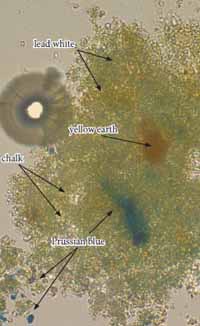 Dispersed pigments from generation 1 green paint on mantel (GE 82), plane polarized transmitted light, 1000x
Dispersed pigments from generation 1 green paint on mantel (GE 82), plane polarized transmitted light, 1000x
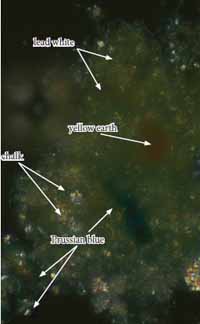 Dispersed pigments from generation 1 green paint on mantel (GE 82), cross polarized transmitted light, 1000x
Dispersed pigments from generation 1 green paint on mantel (GE 82), cross polarized transmitted light, 1000x
The first generation green paint on the mantel in the second-floor southeast chamber is composed of lead white (2PbCO3 ‧ Pb(OH)2), and chalk (CaCO3), as well as some of Prussian blue (Fe4[Fe(CN)6]3), and some yellow ochre (Fe2O3 ‧ nH2O), pigments.
Color Measurement Results
Generation 1 deep green paint on mantel
Accurate color readings for the first generation deep green paint on the mantel could not be obtained with the Minolta Chroma Meter because a clean, intact area could not be isolated for measurement. Instead, the closest commercial color match was determined by eye using a stereomicroscope at 30x magnification with a color corrected light source. The closest match for the base coat was determined to be Colonial Williamsburg Color #403 "Levingston Kitchen Green".
 Colonial Williamsburg
Colonial Williamsburg
#403
"Levingston Kitchen Green"
| CIE L*a*b* values | L* (black to white) | a* (green to red) | b* (blue to yellow) |
|---|---|---|---|
| 37.15 | -6.62 | +2.80 | |
| Munsell values | hue | value | chroma |
| 3.8G | 3.6 | 1.2 |
Second-floor, front left (southwest) chamber
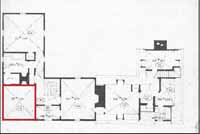 James Geddy House and Silversmith Shop, Second-Floor Plan [Schlesinger, 1968]. The southwest
chamber is outlined in red.
James Geddy House and Silversmith Shop, Second-Floor Plan [Schlesinger, 1968]. The southwest
chamber is outlined in red.
Twenty-one samples were collected from the second-floor front left (southwest) chamber:
| GE 41 | Fireplace shelf, beaded backboard, lower right (east) corner above bottom bead and ¼" in from the right bead | p. 192; Lapham report p. 21-23 |
| GE 42 | Fireplace shelf, right (east) end of the upper fillet on the (upper) cyma recta | Lapham p. 24 |
| GE 43 | Fireplace shelf, beaded backboard, upper left (west) corner | not used |
| GE 44 | Fireplace shelf, bottom of actual shelf (top board), just above cyma fillet | not used |
| GE 45 | Closet (north) door leaf, front bottom edge of lower right panel | not used |
| GE 46 | Closet (north) door leaf, front, left (west) stile, 1" right of middle nail in vertical arm of upper HL hinge | not used |
| GE 47 | Left (west) architrave of closet door, front fascia, ¼" right of left backband, 2'8" above floor | not used |
| GE 48 | Left (west) backband of closet door architrave, convex surface, ½" in from fillet and 2'6" from floor | not used |
| GE 49 | Upper HL hinge on closet door, lower left corner of exposed vertical active leaf | Lapham p. 16 |
| GE 50 | Doorway to passage, top architrave, fascia, 1/2" below backband, 4" right of left backband | Lapham, p. 12 |
| GE 51 | Doorway to passage, right (south) architrave, convex surface adjoining inner edge 3" below upper right corner | p. 189; Lapham p. 11 |
| GE 52 | Left (west) window, left (south) architrave, fascia ¼" left of bead and 2'8" above bottom of window frame | not used |
| GE 53 | Left (west) window, left (south) architrave, middle of backband fillet, 2'11" above bottom of window frame | Lapham p. 15 |
| GE 54 | North wall, closet door leaf, room-side, bottom panel, top ovolo, 36" up from floor | not used |
| GE 55 | West wall, window sash, far left stile, 27" up from bottom of architrave | not used |
| 186 | ||
| GE 56 | South wall, window architrave, right fascia, 40" from bottom of architrave | not used |
| GE 57 | North wall, closet door leaf, closet-side, upper right panel, 53" up from floor and 18" from left edge of door | Lapham p. 18 |
| GE 58 | North wall, closet door leaf, closet-side, lower right hand panel, upper left corner, 34" from floor | Lapham p. 19 |
| GE 59 | South wall, window architrave, right backband, 27" from bottom of architrave | not used |
| GE 60 | South wall, lower window sash, top muntin, far left corner on ovolo | Lapham p. 14 |
| GE 61 | East wall, baseboard fascia, 19.5" from north wall and 3" up from floor | p. 191; Lapham p. 26-27 |
| GE 76 | South window, west architrave, edge of backband | Lapham p. 13 |
Summary of Results:
This chamber was studied by Sara Lapham, Graduate Fellow. Her full report is attached in the Appendix, but some of the results have been re-interpreted and discussed here, placing her findings within the larger context of the entire house's paint history.
Lapham concluded that the old woodwork in the room is contemporary and first-period, and that approximately twenty-five paint generations were present. The first period gray paint found in the second-floor passage, northwest room, and bathroom was seen in this room, but only in a few samples. After this, the room appears to have been painted differently than other rooms in the house, using tans and yellows while the rest of the second-floor spaces were blue. However, the mantel and baseboard paint histories did not clearly align with the rest of the room, and paint samples from these elements have been re-assessed by the author for inclusion in this report.
The samples taken from the door architrave to the passage (GE 50, GE 51), the window architraves (GE 53, 76), the window sash on the south wall (GE 60), and the north wall closet door leaf (GE 49, GE 57, GE 58), contained good evidence to shed light on the early paint history of the room (the door leaf to the passage is original but could not be sampled as it is covered with a metal fire suppression plate). The passageway to the current bathroom and the northern passage door leaf and architrave on the east wall date to the restoration and thus were not sampled.
187The first generation is a thin layer of gray paint that was found in only three of the twenty samples taken from the room (GE 50, GE 51, and GE 53). It is unclear why this paint was only present in a few samples, but it does appear to be a finish layer, as there is a distinct (but thin) boundary separating it from generation two in sample GE 53 (see Lapham report, p.15). In addition, this appears to be the same early gray paint found throughout the second floor — in the passage, the current bathroom, and the northwest room. For comparison, one of Lapham's most intact samples- taken from the door architrave leading to the passage (GE 51), is compared with a paint sample from the second-floor passage door leaf (GE 67, see previous page). Lapham's match for this paint was Benjamin Moore #1545 "Iron Gate", although the author's match, Benjamin Moore #AC-31 "Hot Spring Stones", was much lighter by comparison. The reason for this discrepancy could be due to the inherent variabilities in hand ground paints and/or differing environmental conditions. Again, there is no true evidence of grime or wear on the surface of this paint, and it was only found in a few samples, so it is unclear if it was intended as a finish coat or if it was only applied to selected areas in this room but repainted soon after.
Generation two is comprised of a tan primer (2a) and a tan finish coat (2b), made with lead white, carbon black, and yellow and/or red earth pigments. The color match for this paint was determined by Lapham to lie between Benjamin Moore swatches #1041 "Scarecrow" and #1039 "Stone House". This paint was not found elsewhere in the house in the early period. It does not appear to have been exposed for a very long time, as it has no evidence of grime or wear on its surface.
Generation three is a yellow paint that appears very similar to the first generation paint in the first-floor dining room, although several uncast samples were compared under low-power magnification and they did not appear to be the same paint, although they are a similar color in cross-section. This yellow paint has a translucency in visible light and an autofluorescence in UV light that suggests some type of resinous media was added. This paint is composed of lead white, chalk, and yellow earth pigments, and the closest commercial color match was determined by Lapham to be Benjamin Moore #2158-30 "Delightful Golden". This paint did appear somewhat uneven, suggesting wear (particularly in sample GE 49, closet door hinge), but otherwise there was very little grime or dirt on its surface.
Generation four is another tan paint, very similar in color to generation two, the closest match being Benjamin Moore #1040 "Spice Gold". Generation five is a blue paint that appears to align with the fifth generation blue found in some rooms on the first and second floors.
The rest of the paint history is described in Lapham's report and is summarized in the table on the next page.
Baseboards:
Lapham collected one sample from the baseboard (GE 61), and determined that the first generation was a shellac sealant and a brown oil paint made with red and yellow earth pigments (PLM). The closest commercial match for this paint was Benjamin Moore 2114-20 "Mississippi Mud". This was immediately followed by an orange-red-colored paint, which Lapham identified as generation two. However, the author has observed this orange-red paint in other areas of the house at generation seven. This suggests that some of the earliest paints are missing from the baseboard in this room, and the brown paint may not be first period. Since the rest of the baseboards in the house contained a black paint as their earliest coating, this seems a likely explanation.
Mantel:
The paints on the mantel (GE 41-44), were very disrupted but the early paint history clearly does not align with the rest of the room. In fact, the mantel appears to have been painted much less frequently than the 188 rest of the woodwork. The earliest generation on the mantel is an off-white primer (1a) and a light blue paint (1b), which again, was not seen elsewhere in the room. This light blue contains coarsely-ground particles of Prussian blue in a lead white matrix, so it could be early, although it is difficult to determine which early scheme it aligns with. This is followed by an orange-red paint (called reddish-brown by Lapham), that was found in other areas of the house as a later (post-generation 7), paint. This suggests either: a) a very long time elapsed between painting the mantel light blue in the first generation or: b) the light blue is a later paint, possibly contemporary with the later blues (generation 5) or blue-green resinous paints (generations 7 and 8). It seems most likely that the mantel is an early addition to the room, possibly a replacement for an earlier mantel. This should be kept in mind when reading Lapham's report.
The complete paint history for the second-floor southwest chamber is found in the following table:
| Generation | Description | Observations/Analytical results |
|---|---|---|
| 16-25 | mauve-tan paints, 20th c. | Modern, 20th c. (dim autofluorescence). Present finish. Probably applied by CWF. |
| 9-15 | white paints, 19th c. | Zinc white ('twinkling' autofluorescence) |
| 8 | resinous light blue-green paint | Seen in other areas of the house, paint appears finely ground and homogenous, most likely prepared industrially, post-dates c. 1850 (called a "Pale Green" by Lapham) |
| 7 | resinous blue-green paint | Seen in other areas of the house, this paint appears finely ground and homogenous, most likely prepared industrially, post-dates c. 1850 (called a "Greenish-Blue" by Lapham) |
| 6 | thin pigmented glaze | Brick red paint used in most other areas of the house |
| 5 | blue paint | Found on all woodwork (exception mantel and baseboard). Also seen in second-floor southeast room, first-floor passage, southeast chamber, and shop. |
| 4 | tan primer (4a), tan paint (4b) | Found on all woodwork (exception mantel and baseboard), not seen elsewhere in the house. |
| 3 | yellowish paint | Found on all woodwork (exception mantel and baseboard). In cross-section appears similar in color to generation 1c in dining room, but is not the same. |
| 2 | tan primer (1a), tan/ cream paint (1b) | Found on all woodwork in this room (exception mantel and baseboard), not seen elsewhere in house. |
| 1 | shellac sealant (1a), gray paint (1b). Baseboards black (1b). | Found in only three samples in this room, but this paint was also seen throughout the second-floor. Very little grime on surface, possible primer that was exposed longer than intended |
GE 51: Passage door architrave, top edge of right (south) jamb, inner edge of cyma backband
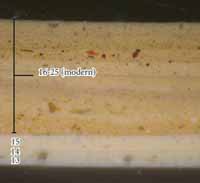 GE 51 (top layers), visible light, 200x
GE 51 (top layers), visible light, 200x
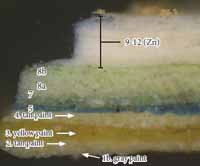 GE 51 (lower layers), visible light, 200x
GE 51 (lower layers), visible light, 200x
 GE 51 (substrate), UV light, 400x
GE 51 (substrate), UV light, 400x
Lapham's sample GE 51 was one of the most complete samples taken from this room.
The first generation appears to be the same gray paint used throughout the second-floor in this same period. It contains finely ground black pigment particles in a lead white matrix. In this sample, this paint is very thin and has almost no "hard boundary" to distinguish it from the following paint. As Lapham suggests, the lack of grime suggests that this paint might have been exposed for a very short period of time, perhaps as a "temporary" paint or primer.
GE 61: baseboard, east wall
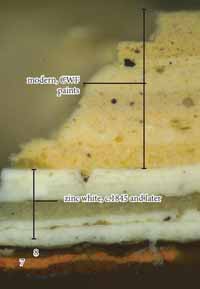 GE 61 (substrate with paints), visible light, 200x
GE 61 (substrate with paints), visible light, 200x
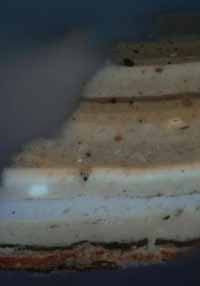 GE 61 (substrate with paints), UV light, 200x
GE 61 (substrate with paints), UV light, 200x
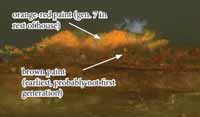 GE 61 (no substrate), visible light, 200x
GE 61 (no substrate), visible light, 200x
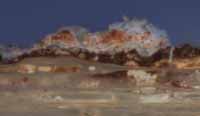 GE 61 (no substrate), UV light, 200x
GE 61 (no substrate), UV light, 200x
The earliest surviving brown paint on the baseboard may not be first period, as it is immediately followed by the seventh generation orange-red paint seen throughout the house. The earliest paints on baseboards throughout the rest of the house were black.
GE 41: Fireplace mantel, beaded backboard
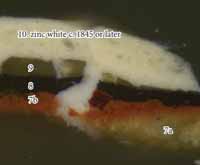 GE 41 (intermediate paints), visible light, 200x
GE 41 (intermediate paints), visible light, 200x
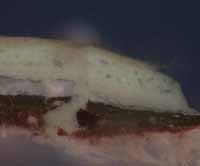 GE 41 (intermediate paints), UV light, 200x
GE 41 (intermediate paints), UV light, 200x
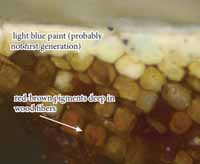 GE 41 (substrate with paints), visible light, 200x
GE 41 (substrate with paints), visible light, 200x
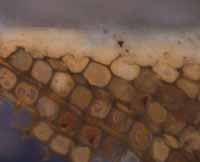 GE 41 (substrate with paints), UV light, 200x
GE 41 (substrate with paints), UV light, 200x
Only the early mantel paints in sample GE 41 are shown above. The earliest intact light blue paint (identified by Lapham as generation 1), is most likely later, since there are red-brown pigments deep in the wood cells, suggesting that earlier finishes are lost from this element. The orange-red paint (7b) and black paint (8) seen on the baseboard (previous page), are also seen here. These appear to be later paints, and may not be as early as previously thought.
Multiple samples were taken from this mantel and all revealed the same disrupted paint layers with fewer coatings that did not clearly align with the early finishes in this room. The reason for this is unclear. Perhaps the mantel was scraped down at an early date.
Conclusions:
The interior woodwork at the James Geddy House retains an impressive amount of original paint evidence, from which we have learned much about the decorative history of the house. The results suggest that in the mid-late 18th century, the Geddy House woodwork was not painted a single color throughout, but with multiple colors to reflect the use and status of certain spaces. While this is a significant finding regarding the decorative history of the interior, it also complicated the interpretation, because it was not always clear how different finishes aligned. However, enough of the early paints were similar to propose a theoretical decorative history of the interior (see Table 1., p. 8).
Period 1:
In the first period, when James Geddy's house was newly constructed (dendro. dated 1762), the first-floor parlor had much simpler woodwork than it does at present — paint evidence indicates only the door leaves and inner architrave fascias are original (there were most likely baseboards that do not survive). This woodwork was shellacked and painted with a verdigris-green glaze with no opaque base coat. This is an unusual finish that has not been seen elsewhere in Williamsburg or the surrounding region. This finish oxidized to a dark brown/black color, but it was probably a green glaze through which the graining of the wood substrate could be seen. Verdigris is an expensive pigment, and its use highlights the parlor as a high-status space.
Most of the dining room woodwork is first-period and original. The woodwork in this room is superior, consisting of double architraves and a buffet, which also suggests the dining room was a high status space, possibly more so than the adjacent parlor (Chappell, Appendix K). In the first period, the dining room woodwork was shellacked, primed white and painted a deep golden yellow color. The only surviving woodwork from the first-floor shop is a door leaf, which contains a first period brown paint on the shop-side. This is a less expensive, 'plain' color which reflects its use as a more utilitarian space.
The first-floor stair passage and staircase woodwork as well as the woodwork in the first-floor southeast chamber were both shellacked and painted a deep blue color. This same blue color was also used on the woodwork in the second-floor southeast chamber. Interestingly, the southeast chambers on the first and second floors have identical paint histories, from the first period up to the present day. On the second-floor much of the woodwork was painted gray. This includes the passage woodwork and the woodwork in the southwest chamber, northwest chamber, and the present bathroom (part of the northwest chamber). Although still open to interpretation, this gray might be a primer that was exposed for a longer period than usual.
Period 2:
In period two, both the parlor and dining rooms were painted with a white paint, chromatically linking these two spaces in a way they had not been previously. The shop woodwork was painted tan. The stair passage and first-floor southeast chamber, and second-floor southeast chamber directly above, were repainted with a similar blue as the previous generation. All of the spaces on the second-floor were painted with a blue paint (a brighter, more intense blue than in the stair passage), with the exception of the southwest chamber, which was painted a tan-cream color.
Period 3:
In period three, most of the spaces were re-painted with the same colors as the previous generation: the parlor and dining rooms were re-painted white. The stair passage and southeast chambers (first and second floors), were re-painted blue. However, a few of the second-floor spaces received a color change— such as the southwest chamber, which was painted yellow, and the passage, current bathroom, and northwest 194 chamber. These spaces were painted in a polychrome scheme consisting of dark blue door leaves and verdigris-green trim.
Period 4:
In period four, the dining room west wall southwest doorway was converted to a window, and the all of the woodwork was re-painted white. The parlor was re-painted white, as well. The rest of the first-floor spaces (the stair passage, the southeast chamber, and the shop) were painted gray. On the second floor, most of the woodwork was unpainted, with the exception of the southeast chamber (painted the same gray as the chamber below), and the southwest chamber woodwork, which was painted a cream-tan color.
Period 5:
In this period, the parlor and dining room woodwork was again painted white. The rest of the first-floor spaces (stair passage, southeast chamber, shop) were painted blue. This same blue was used to re-paint the second-floor southeast chamber, and the second-floor southwest chamber. The rest of the second floor woodwork appears to have been left unpainted (meaning they would have retained the third period polychrome blue and green scheme).
Period 6:
In paint generation six, the parlor underwent major improvements, including the addition of the present wainscot, chair rail, and cornice. Most interestingly, the paint evidence indicates that the simpler architraves were improved through the addition of center fascias and backbands. All old and new woodwork was painted a medium gray color. This upgraded the woodwork in this room to match the superior woodwork in the dining room. The parlor woodwork appears to be early, most likely late 18th-century, so this work might have been carried out when by Geddy family, or possibly their immediate successors (the house having been occupied by the Geddy family until 1777). The installment of this woodwork in the sixth paint generation suggests that this room was repainted frequently, in the 18th century, or even during the fifteen-year Geddy occupation (1762-1777).
The dining room was again re-painted white. A brick-red-colored paint was used in most rooms throughout the house: in the shop, the first-floor passage and stair, the second-floor passage, and the second-floor northwest chamber. In the first and second-floor southeast chambers, this brick red-paint was used on the door leaves and chair rails, while the architraves were painted yellow, and the mantels were painted black. The brick red paint was not seen in any samples taken from the current bathroom or the second-floor northwest chamber.
Period 7:
In period 7, many of the rooms in the house were painted with a resinous blue-green paint, including the parlor and the second-floor chambers. The dining room was painted white, and the first-floor stair passage was painted a dark gray. This resinous blue-green paint is somewhat more finely ground than the previous generations, and could date to the early 19th-century.
Period 8:
Period eight saw the introduction of zinc-white-based paints in some rooms of the house (such as the shop and second-floor stair passage). Therefore, this period must date to the mid-19th-century or later.
Period 9-present:
In period 9, the parlor received a polychrome scheme consistent with a 19th-century style: a blue-green wainscot, bright yellow trim, and a black mantel, while most of the rest of the house was painted white. Most of the woodwork in the house was painted white repeatedly up to the 20th century, when the house was restored by Colonial Williamsburg.
A note about the mantels:
The Geddy House mantels contained unexpected and sometimes confusing paint evidence. To summarize, the mantel in the parlor appeared to have been installed in paint period 6, contemporary with the wainscot (p.29). The dining room mantel was new, and was not sampled. The mantel in the first-floor southeast chamber had the same early paint layers as the rest of the room, so it was certainly original (p.82). However, it contained a light ochre-colored paint directly on the wood that was not seen anywhere else in the room. This could have been a paint applied by the joiner, although this is just one theory. On the second floor, the mantel in the southwest chamber also contained paints that appeared old, but did not align with the rest of the room (Lapham report 2012). The mantel in the second-floor southeast chamber did not align at all with the early paints in the rest of the room (p.181). It contained early dark green and black paints that were not seen anywhere else in the room. The following note was made by Edward Chappell after reviewing a draft of this report:
"The mantel in the upper southeast room is confusing. It could be an early 19th-century addition, but the early green you found suggests it may be moved from another building. Eventually worth more investigation." (Chappell, note to author, November 6, 2013).
Baseboard colors extending over door bottoms:
In February 2013, the author returned to the house to excavate the baseboards in rooms that were not sampled, as well as the bottoms of doors and plinths of architraves. The results suggest that the baseboards in most rooms contain only modern paints, and the bottoms of doors and plinths were not painted black or dark brown (this was a common treatment in other buildings. Examples can be seen in the Governor's Palace and Charlton's Coffeehouse in CW).
Harwood ledger:
There is an entry that regards this property in the Humphrey Harwood account book (1768-1794) dated May 19th, 1778. Humphrey was a bricklayer and builder in Williamsburg. The note relates that Humphrey carried out various repairs in the house including "whitewashing 7 rooms, 2 passages, 4 closets, and 3 poarches" (Schelschinger 1968). These repairs would have been carried out shortly before Geddy sold the property to Robert Jackson in December of that year. It suggests that the walls were whitewashed during the Geddy occupancy.
Footnotes
References:
- Eastaugh, N., et. al. 2008. Pigment Compendium: a dictionary and optical microscopy of historical pigments. Oxford, Butterworth-Heinemann.
- Gettens, R., and G. Stout. 1942. Painting materials: a short encyclopedia. New York, Dover Publications, Inc.
- Kuhn, H. "Verdigris and Copper Resinate," chapter 6 in Artists' Pigments: a handbook of their history and characteristics, volume 2, Ashok Roy, ed., 1984. Oxford University Press, National Gallery of Art, Washington, D.C.: 131-158.
- Schlesinger, Catherine. 1968. "James Geddy House Architectural Report, Block 19, Building 11, Lot 161."
- Unpublished report for the Colonial Williamsburg Foundation; Research Report Series 1450.
- Travers, Kirsten. 2011. "Lead and Zinc-based Paint in Cross-Section: a Comparative Study of Elemental Composition and Autofluorescence Behaviors in Architectural Paints." Unpublished research report completed as part of graduate course-work for the Winterthur/University of Delaware Program in Art Conservation.
- Waterman, Thomas Tileston. 1932. "James Geddy House Architectural Report, Block 19, Building 11, Lot 161." Revised in 1950 by A. Lawrence Kocher and Howard Dearstyne. Unpublished report for the Colonial Williamsburg Foundation; Research Report Series 1449.
- Whiffen, Marcus. 1984. The Eighteenth-century Houses of Williamsburg. Virginia: the Colonial Williamsburg Foundation.
- Wolbers, R. 2008. Color and light. Lecture for General Conservation Science ARTC 615, at the Winterthur/University of Delaware Program in Art Conservation.
Appendix A: Procedures
Sample Preparation:
The samples were cast in mini-cubes of Extec Polyester Clear Resin (methyl methacrylate monomer), and polymerized with the recommended amount of methyl ethyl ketone peroxide catalyst. The resin was allowed to cure for 24 hours under ambient light. After cure, the individual cubes were removed from the casting tray and sanded down using a rotary sander with grits ranging from 200 — 600 to expose the cross-section surface. The samples were then dry polished with silica-embedded Micro-mesh Inc. cloths with grits ranging from 1500 to 12,000, lending the final cross-section surface a glassy-smooth finish.
Microscopy and Documentation:
The cross-section samples were examined using a Nikon Eclipse 80i microscope equipped with an EXFO X-cite 120 fluorescence illumination system fiber-optic halogen light source. Samples were examined and photographed under visible and ultraviolet light conditions (EX 380-330 nm, BA 420 nm), at 100 to 200x magnifications. Digital images were captured using a Spot Flex digital camera with Spot Advance (version 4.6) software. All images were recorded as 12.6 MB tiff files and stored in a folder titled "James Geddy House Interior" on Susan Buck's laboratory computer, as well as on a hard drive owned by the author. A separate set of images will be stored on the CWF Architectural Research server, accompanied by all documentation and a digital version of the final report.
Information Provided by Visible and Ultraviolet Light Microscopy:
When examining paint cross-sections under reflected visible and ultraviolet light conditions, a number of physical characteristics can be observed to assist with the interpretation of a paint stratigraphy. These include the number and color of layers applied to a substrate, the thickness or surface texture of layers, and pigment particle size and distribution within the paint film. Relative time periods for coatings can sometimes be assigned at this stage: for instance, pre-industrial-era paints were hand ground, lending them a coarse, uneven surface texture with large pigment particles that vary in size and shape. By contrast, more "modern", industrially-prepared paints have smoother, even surfaces and machine-ground pigment particles of a consistent size and shape. Furthermore, he presence of cracks, dirt layers, or biological growth between layers can indicate presentation surfaces and/or coatings that were left exposed for an extended period of time.
Under UV light conditions, the presence and type of autofluorescence colors can distinguish sealants, clear coatings, and binding media, from darker dirt or paint layers within the stratigraphy. For instance, shellacs exhibit a distinct orange-colored autofluorescence, while natural resins (such as dammar and mastic), typically fluoresce a bright white color. Oil media tends to quench autofluorescence, while most modern, synthetic paint formulations (such as latex) exhibit no fluorescence at all. Some pigments, such as verdigris, madder, and zinc white, have distinct fluorescence characteristics, as well. UV light microscopy is critical to help distinguish otherwise identical layers often found in architectural samples- such as successive varnishes, or multiple layers of unpigmented (white) lime-wash.
Binding Media Analysis using Fluorochrome staining:
Fluorochrome stains adapted from the biological sciences were used to characterize the paint binding media (oils, proteins, carbohydrates), in layers within the cross-section sample. The following stains were used in this analysis:
2,7 Dichlorofluorescein (DCF): 0.2% w/v in ethanol. Fluorescent labeling reagent for lipids, particularly drying oils. One drop of stain was applied to the surface of the sample, blotted immediately, and cover-slipped with mineral spirits. The reaction was observed with the B2A filter cube (EX 450-490nm, BA 520nm). This stain exhibits a yellow-green fluorescence where lipids are present.
Triphenyl tetrazolium chloride (TTC): 1.0% w/v in ethanol. Labeling reagent for carbohydrates (gums, starches, cellulosic thickeners). One drop of stain was applied to the surface of the sample, blotted dry, and allowed to sit for approximately 45 seconds before cover-slipping, (must be allowed to react with atmospheric moisture for reaction to move forward). The reaction is observed under reflected UV light conditions (EX 330-380nm, BA 420nm). A dark red-brown color is seen where carbohydrates are present.
Fluorescein isothiocyanate (FITC): 0.02% w/v in anhydrous acetone. Fluorescent labeling reagent for proteins. One drop of stain was applied to the surface of the sample, blotted immediately, and cover-slipped with mineral spirits. The reaction was observed using the B-2A filter cube (EX 450-490nm, BA 520nm). A positive reaction is a bright yellow-green fluorescence.
Color measurement and matching:
Color measurements were taken using the Minolta Chroma Meter CR-241 colorimeter/ microscope in Susan Buck's paint analysis laboratory. Equipped with an internal 360-degree pulsed xenon arc lamp, this instrument is capable of obtaining accurate color measurements in any one of five different tristimulus color measurement systems from areas as small as 0.3mm. For the purposes of this project, color values in CIE L*a*b* color-space and the Munsell color system were obtained.
The CIE L*a*b* color space system (developed in 1976 by the Commission International de l'Eclairage, and now an internationally accepted industry-standard color measuring system) uses three numerical values, known as "tristimulus" values, to measure color: L* is the lightness variable, representing dark to light on a scale of 0-100, while a* and b* are chromaticity coordinates, a* representing red to green on scale from -50 to +50, and b*representing blue to yellow on a scale from -50 to +50. These three coordinates are used to plot the location of a color in the CIE L*a*b* color-space. These resulting values can be used to quantify color differences (. E), between two samples. To obtain this value, the following calculation is used: ΔE = (ΔL*)1/2 + (Δa*)1/2 + (Δb*)1/2 A ΔE value = 3 cannot be perceived by the human eye (Wolbers 2008). Therefore, between any two samples, ΔE values at or below this range are considered acceptable matches.
Ideally, color measurements should be collected from a clean, unweathered sample area. If necessary, a scalpel is used to scrape an area clean before color matching. Due to inherent color variations in paints (especially in hand ground, pre-industrial coatings), multiple readings are taken and averaged together to establish the final CIE L*a*b* values.
199Due to the deterioration, soiling, and fragmentary nature of some early paints, color readings cannot always be obtained with the Chroma Meter. In these instances, paints are matched by eye to Munsell standard color swatches and commercial paint chips, using a stereomicroscope at 30x magnification with a color corrected light source. Commercial systems consulted include Benjamin Moore, Sherwin Williams, Pittsburgh Paints, and the Colonial Williamsburg Color Collection.
Appendix B. Sample Memo 1
Cc: Susan Buck
From: Kirsten Travers
Date: April 19, 2012
Re: James Geddy House Paint Samples
On April 19, 2012, I collected nineteen paint samples from the Geddy House first-floor parlor (southwest room) and front passage. I was accompanied on site by Edward Chappell who directed and assisted with sample collection.
Parlor (southwest room)
GE 1: East wall, wainscot to left of door, lower left corner of raised panel, 6" out from door architrave backband (first generation gray paint seen)
GE 2: East wall, cornice, center of fascia, just above door to passage (taken by E. A. C., no early paints seen, stratigraphy begins with white paint)
GE 3: East wall, door architrave to passage, inner fascia, 37" up from floor (first generation verdigris-green seen)
GE 4: East wall, door architrave to passage, center fascia, 28" up from floor (first generation gray paint seen)
GE 5: East wall, door architrave to passage, back edge of backband, 33 ½" up from floor (first generation gray paint seen)
GE 6: East wall, top rail of wainscot, to left of passage doorway, just below chair rail, 40 ½" up from floor (first generation gray paint seen)
GE 7: East wall, wainscot, underside of chair rail, 2" to left of door architrave (first generation gray paint seen)
GE 8: East wall, door leaf to passage, bottom right panel, upper left corner (first generation verdigris green, followed by a cream (or light yellow), gray (same as wainscot), cream (or light yellow), series of whites, series of present grays)
GE 9: West wall, window architrave, bottom left corner, inner fascia (paints same as GE 8, but a very thin red-brown (primer) was seen on the wood)
GE 10: West wall, window architrave, bottom left corner, center fascia (paints same as GE 1)
GE 11: West wall, window architrave, bottom left corner, backband (paints same as GE 1)
201GE 12: Closet door leaf, room-side, bottom ovolo of center left panel (paints same as GE 8)
GE 13: Closet door leaf, room-side, bottom left raised panel, bottom left corner (paints same as GE 8)
GE 14: West wall, window sash, bottom right pane, top muntin (had a lot of paint accumulation, but after multiple excavations, no early paints seen)
GE 15: Mantel, left jamb, 41" up from floor (paints different from rest of room. Gen. 1 white, then red-brown/ violet, then black)
GE 16: Mantel, inner face of right jamb, 43" up from floor (paints same as GE 15)
Passage
GE 17: Door architrave to parlor, right jamb, backband, 22" up from floor (first generation gray or blue-gray (might be same as in parlor, not certain), then very thin and brittle red-brown)
GE 18: Door architrave to parlor, right jamb, fascia, 20" up from floor (paints same as GE 17. I also checked the stop of this same door, and I saw the same paints)
GE 19: Door leaf to parlor, center stile, ovolo, 16" up from floor (first generation gray or blue-gray, then red-brown, a faux-wood grain, series of whites, series of present gray colors. I checked the panel (but did not sample it), and saw the same series of paints)
Appendix C. Sample Memo 2
Cc: Susan Buck
From: Kirsten Travers
Date: April 25, 2012
Re: James Geddy House Paint Samples II
On April 24, 2012, I collected nineteen paint samples (GE 20-GE 38) from the Geddy House front passage and first-floor dining room. I was accompanied on site by Edward Chappell who directed and assisted with sample collection.
Passage
GE 20: Door architrave to dining room, left jamb, backband, 31" up from floor (same paints seen as in other passage samples. First generation gray or blue-gray, followed by a thin and brittle red-brown)
GE 21: Door architrave to dining room, left jamb, fascia where it meets backband, 30" up from floor (same paints as GE 20 seen)
GE 22: Door leaf to dining room (EAC notes this leaf dates to c.1850), left stile, just above lower H-L hinge (fewer paints than other passage samples, first generation faux-wood graining)
Dining Room
Almost all of the trim contained a series of early light-colored paints (light tans, light grays, creams, and whites). Since these paints looked so similar under low-power magnification, it was not possible to assign any relative dates for installation at this time.
The east wall window architrave was examined but was not found to contain any historic paint evidence, and it was not sampled.
GE 23: Door architrave to passage, left jamb, inner fascia just above plinth
GE 24: Door architrave to passage, left jamb, center fascia just above plinth
GE 25: Door architrave to passage, left jamb, backband, just above plinth
GE 26: Door architrave to passage, left jamb, plinth face, upper left corner
GE 27: North wall, window architrave, bottom right corner, inner fascia
GE 28: North wall, window architrave, bottom right corner, center fascia
203GE 29: North wall, window architrave, bottom sill, center fascia, 10 ½" out from back of left jamb
GE 30: West wall, northwest window architrave, inner fascia, 34" up from bottom edge
GE 31: West wall, northwest window architrave, right jamb, center fascia where it meets the backband
GE 32: West wall, northwest window architrave, backband, bottom edge, right side
GE 33: West wall, southwest window architrave, center fascia where it meets the backband, bottom left corner
GE 34: West wall, southwest window architrave, bottom sill, inner fascia, 9 ½" out from left edge
GE 35: West wall, southwest window architrave, backband, bottom left corner
GE 36: Buffet architrave, right jamb, cyma of backband, 19" up from floor
GE 37: Buffet architrave, right jamb, cyma between inner and center fascias, 22" up from floor
GE 38: Buffet, far right end of fascia just under the bolection
GE 39: West wall, SW window architrave, left jamb, center fascia, 51" up from bottom sill
GE 40: West wall, SW window architrave, left jamb, inner fascia, 51" up from bottom sill
Appendix D. Sample Memo 3
Cc: Susan Buck, Kirsten Travers
From: Ed Chappell
Date: June 25, 2012
Re: James Geddy House, Upper Southwest Chamber
Kirsten, you, and I looked at the upper front left (southwest) chamber in the Geddy House this afternoon. We see early woodwork on the fireplace shelf, two window frames, closet doorway, and architrave on the doorway to the passage. The left (west) sash appear to date from the restoration. The front sash are less certain. The backband on the passage doorway has a narrower backband, so it may be old but not first-period. The room face of the door leaf is covered and inaccessible. The fireplace is hidden by plaster.
This is a list of samples you and Kirsten took. I will mention what we saw while recognizing that these are preliminary observations.
- 41.Fireplace shelf, beaded backboard, lower right (east) corner immediately above the bottom bead and ¼" in from the right bead. The earliest layer may be a light blue.
- 42.Fireplace shelf, right (east) end of the upper fillet on the (upper) cyma recta, 1¼" below the top and ¼" back from the front corner. Again we see an early blue.
- 43.Fireplace shelf, beaded backboard, upper left (west) corner ½" in from left bead and ½" below shelf. Blue again.
- 44.Fireplace shelf, bottom of actual shelf (top board), just above the cyma fillet, 2" right of the left (west) end. This, too, seems to have the early blue.
- 45.Closet (north) door leaf, front bottom edge of lower right (east) panel, ½" left of lower right corner. This appears to have a dark blue over a light layer, possibly tan.
- 46.Closet (north) door leaf, front, left (west) stile, 1" right of middle nail in vertical arm of upper HL hinge. Again we see dark blue above a tan or off-white.
- 47.Left (west) architrave of closet door, front fascia, ¼" right of left backband 2' 8" above the floor.
- 48.Left (west) backband of closet door convex surface ½" in from fillet and 2' 6" above the floor. The blue appears brighter here.
- 49.Upper HL hinge on closet door, lower left corner of exposed vertical active leaf. The sample easily cleaves off from the iron. This early hinge appears never to have been removed from the door.
- 50.Doorway to passage, top architrave, fascia, ½" below backband and 4" right of the left (north) back-band 205 band. Looks like blue over tan, separating from wood.
- 51.Doorway to passage, right (south) architrave, convex surface adjoining inner edge 3" below upper right corner. We see deep blue above tan.
- 52.Left (west) window, left (south) architrave, fascia ¼" left of bead and 2' 8" above bottom of window frame.
- 53.Left (west) window, left (south) architrave, middle of backband fillet, 2' 11" above bottom of window frame.
E.A.C.
Appendix E. Sample Memo 4
Cc: Kirsten Travers and Susan Buck
From: Sara Lapham
Date: June 27, 2012
Re: James Geddy House Paint Samples
On June 26, 2012, Kirsten Travers and I collected eight paint samples from the Geddy House second-floor southwest room.
Second-floor southwest room
GE 54: North wall, closet door leaf, room-side, bottom panel, top ovolo, 36" up from floor (first generation (or primer?) tan paint, followed by deep blue, followed by lighter blue)
GE 55: West wall, window sash, far left stile, 27" up from bottom of architrave (records indicate that the sash is original, several excavations were made, no evidence of first generation paint layers were found, stratigraphy begins with a white paint)
GE 56: South wall, window architrave, right fascia, 40" from bottom of architrave (stratigraphy appears the same as that on the west wall)
GE 57: North wall, closet door leaf, closet-side, upper right panel, 53" up from floor, and 18" from left edge of door (not as many layers seen as the superior side of the door, however, an early tan (primer?) followed by blue were noted)
GE 58: North wall, closet door leaf, closet-side, lower right hand panel, upper left corner, 34" above floor (same observations as 57)
GE 59: South wall, window architrave, right backband, 27" from bottom of architrave (stratigraphy appears the same as the west window)
GE 60: South wall, lower window sash, top muntin, fart left corner on ovolo (appears to have the same stratigraphy of the architrave)
GE 61: East wall, baseboard, fascia, 19.5" from north wall, and 3" from floor (first layer dark (maybe a chocolate brown), second- bright orange/red, third- off white, possibly light blue but not like that seen elsewhere in the room)
Appendix F. Sample Memo 5
Cc: Susan Buck, Sara Lapham
From: Kirsten Travers
Date: June 27, 2012
Re: James Geddy House Paint Samples
Today I collected fourteen paint samples (GE 62 — GE 75) from the Geddy House interior, second-floor, west spaces.
Small, west passage between upper front left (southwest) chamber, past current bathroom, opening our to rear (north) end of passage
GE 62: Doorway at north end, leading to rear passage, left architrave, cyma of backband, 32" up from floor (earliest paint blue, followed by red-brown).
GE 63: Doorway at north end, leading to rear passage, right architrave casing, 23" up from floor (same paints as GE 62).
GE 64: Doorway at north end, leading to rear passage, right architrave stop, 16 ½" up from floor, 3 ½" from beaded edge (same paints as GE 62).
Eastern passage leading from stair to rear (northwest) room, northern (rear) end
GE 65: Door architrave to NW room, right architrave, cyma of backband, 26 ½" up from floor (again, early blue, very similar to current color).
GE 66: Door leaf to NW room, bottom right raised panel, 27" up from bottom of door, far right edge (same as GE 65).
GE 67: Door leaf to NW room, bottom ovolo of lock rail, 25 ½" from left edge of leaf (first generation blue is much brighter than other samples. Followed by a very dark blue or green glaze or paint).
GE 68: Door leaf to NW room, underside of bottom left raised panel, beveled edge, 1" from left side (same paints as GE 67).
GE 69: West partition wall of passage, presently (leads to small west passage), door architrave (rear passage side), left architrave, cyma of backband, 23" up from floor (same paints as GE 67. These same paints were seen on the fascia of same architrave, but it was not sampled).
Present Bathroom, at west end
GE 70: West wall, window architrave, right architrave, cyma of backband, 24" from bottom (same paints as GE 67). Sash not accessible, covered by permanent grille
GE 71: West wall, window architrave, left architrave, fascia, 24" up from bottom of architrave (same paints as GE 67, but more later paints)
GE 72: South wall, door architrave, right side, cyma of backband, 57" up from floor (same as GE 71)
GE 73: South wall, door leaf, bottom right raised panel, lower left corner, underside of beveled edge (same as GE 71)
GE 74: South wall, top door architrave, far right end, underside of bottom bead
GE 75: South wall, closet door leaf, closet-side lower left panel, upper left panel (saw early blue, but fewer paints than other woodwork in this space).
Appendix G. Sample Memo 6
Cc: Kirsten Travers and Susan Buck
From: Sara Lapham
Date: August 1, 2012
Re: James Geddy House Paint Samples
Today Kirsten Travers and I continued collecting interior paint samples from the James Geddy house. We took one sample from the first-floor SW chamber (the parlor) and eight samples from the second-floor southeast chamber. In addition to the samples taken today, a sample that I took from the second-floor southwest chamber on July 9th is also included in this sample memo.
Second-floor, southwest chamber:
GE 76: South wall, window architrave, west jamb, edge of backband, ~6" from top of architrave.
First-floor, southwest chamber (parlor):
GE 77: West wall, window architrave, center fascia of right jam, close to inner edge, 8" up from the bottom of the architrave. This sample was taken using a dremel tool with a micro-bit to isolate a small section of wood/paint layers and then removing the isolated sample with a scalpel.
Second-floor, southeast chamber:
Notes:
West wall— only the door architrave to passage is original. The door leaf is also original but the room side has a sheet of metal, (for fireproofing), covering any early finish generations. The southern closet door and trip are new.
South wall— Window architrave is original. Perhaps the sash as well.
East wall— Door leaf and architrave to the shop are new. Not sure if mantel is original. Made many excavations only saw black paint on wood followed by a few modern white paints then current blue/grays. The two samples taken are the only that show other layers below the black. All of the dentals on the front edge are missing. The only two dentals remaining are one on each end.
North wall— window architrave and sash are new.
All baseboards look original (patched in places).
Mark Kutney's sample 202 was taken from the east wall, fireplace mantel, right fascia, right of top molding, under shelf.
210Sample locations:
GE 78: West wall, central door, architrave, north jamb, cyma of backband, 30" up from floor. The first generation appears to be a light blue.
GE 79: West wall, central door, architrave, north jamb, fascia, 25" up from floor.
GE 80: South wall, window architrave, east jamb, backband fillet, 12" up from bottom of architrave.
GE 81: South wall, window architrave, west jamb, fascia, ~ 6" from bottom next to cymation.
GE 82: East wall, fireplace mantel, north end, dental.
GE 83: South wall, lower window sash, upper central/western vertical muntin, close to top rail at center of fillet. Note: Several excavations were made and most areas appear to have a red or white as the earliest paint layer. This area is the only site examined where it looks like there is an early blue.
GE 84: East wall, fireplace mantel, shelf (top board), upper face, 2" from wall, 17" from north end.
GE 85: East wall, baseboard, fascia, 4" north of mantel, 1" from top of baseboard.
SWL
Appendix H. Sample Memo 7
Cc: Susan Buck, Sara Lapham
From: Kirsten Travers
Date: August 7, 2012
Re: Geddy House Interior Paint Samples
Yesterday I collected 11 paint samples from various spaces inside the Geddy House (GE 86- GE 96). The purpose of this sampling excursion was to obtain better samples from surfaces previously examined (such as the inner fascias in the first-floor parlor), and to collect new samples from elements not yet examined (such as the staircase).
GE 86 First floor, Parlor, west wall, window architrave, right architrave, inner fascia, 8" up from bottom of architrave
GE 87 First floor, Parlor, east wall, door architrave (to passage), left architrave, inner fascia, 18" up from floor
GE 88 First floor, Parlor, north wall, closet door architrave, left architrave, inner fascia, 9" up from floor
GE 89 First floor, Passage, west Wall, chair rail, adjacent to dining room doorway, 5" south of the north end
GE 90 First floor, Passage, stair stringer, west face, under third baluster up from bottom, fascia adjacent to top trim
GE 91 Stair, upper shaft of half-baluster on newel post ascending to second floor
GE 92 Stair, landing between first and second floors, east newel post, north face, just under rail
GE 93 Stair, bottom bead of handrail, east face, above second baluster up from the landing between first and second floors
GE 94 Stair, second floor, ½ newel post against east wall, bottom edge
GE 95 Stair, underside of bottom trim of second floor stair landing, accessible by standing on the stair itself, adjacent to the central newel that currently has the first-floor passage lantern hanging from it
GE 96 Second floor, eastern (stair) passage, door leaf to southwest chamber, beveled edge of bottom right panel
Appendix I. Sample Memo 8
Cc: Susan Buck
From: Kirsten Travers
Date: August 17, 2012
Re: Geddy House Interior Paint Samples
On Wednesday, August 15 and Thursday, August 16, I collected 20 additional paint samples from various spaces inside the Geddy House (GE 97- GE 116). The purpose of this sampling excursion was to obtain better samples from surfaces previously studied, and to collect new samples from elements not yet examined (such as the first-floor SE bedchamber).
Second Floor, NW chamber (currently Patti's Office)
GE 97 Center stile of door leaf to passage, 26" above floor, 1" from left edge
GE 98 Right architrave of door to passage, fascia, 29" up from floor, inner edge near bead
GE 99 South wall, baseboard, fascia, 2" above floor and 4" west of passage architrave backband
First Floor, SE bedchamber
GE 100 West wall, mantel backboard, far north end, 2.5" out from wall and ½" from top
GE 104 South wall, left window architrave, fascia, 12" from top and 1" in from backband (same paints seen on the backband with a scalpel and loupe, so backband was not sampled)
GE 105 East wall, chair rail, 3" from south wall, 1.5" up from bottom of rail
GE 106 South wall, chair rail, 4" from west wall, 1.5" up from bottom of rail
GE 107 Door leaf to passage, room-side, upper left corner of lower right panel
GE 108 Door leaf to passage, left stile, just above bottom hinge
GE 109 Door architrave to passage, left architrave, fascia, 37" up from floor
GE 110 Door architrave to passage, top architrave, backband cyma, 5" from south wall
GE 111 Mantel, left side of backboard, 45" from floor
GE 112 Mantel, fascia of center trim around fireplace opening, top element, far left edge
213GE 113 Mantel, fascia of center trim around fireplace opening, right element just above plinth
GE 114 Mantel, ovolo of outer trim around fireplace opening, 8" above floor
GE 115 Mantel, north face of outermost fillet, 55" up from floor
GE 116 Mantel, north face of top trim, bottom fascia
First Floor, Shop (only the door architrave and door leaf in this space is old)
GE 101 West wall, left door architrave, fascia, 30" up from floor
GE 102 West wall, left door architrave, backband cyma, 17" up from floor
GE 103 West wall, door leaf to bedchamber, upper left corner of bottom left panel
Appendix J. Sample Memo 9
Cc: Susan Buck
From: Kirsten Travers
Date: September 10, 2012
Re: Geddy House Interior Paint Samples
On September 6, 2012 I collected three paint samples (GE 117 - GE 119) from the first-floor southeast bedchamber and adjacent shop woodwork. The samples I had taken previously from these surfaces were very disrupted and I wanted to obtain more intact samples for the study, in particular the shop-side of the door leaf.
GE 117 First floor, shop. Door leaf to SE bedchamber, shop-side (inferior construction). Bottom right panel, bottom left corner.
GE 118 First floor, SE bedchamber. Door leaf to shop, chamber-side. Bottom right raised panel, lower right corner, beveled edge on right, 17" up from floor
GE 119 First floor, SE bedchamber. Door leaf to shop, chamber-side. Bottom right panel, bottom right corner.
Appendix K. Chappell Field Notes
Cc: Susan Buck
From: Ed Chappell
Date: April 19, 2012
Re: Woodwork in James Geddy House Parlor (Southwest First-Floor Room), Williamsburg
Kirsten Travers and I looked this afternoon at woodwork in the parlor in the Geddy House to consider the relative eras of its woodwork. Mark Kutney looked at part of the woodwork some years ago, and we found his list of samples but not a record of the findings. My memory is that paint evidence was found indicating that the wainscoting and cornice in the parlor were added at an early date but were not first-period. Susan Buck saw verdigris green in the passage, when she took a handful of samples more than a decade ago.
Kirsten's observation is more interesting. She sees verdigris green followed by a cream or pale yellow on inner beaded elements of both door and window architraves, and on the passage door leaf. The green and cream are absent from the outer elements (two cymas and two fillets) of all four architraves and on the wainscot. These seem to begin with a gray that may be the third finish layer on original woodwork. She sees a red-brown primer under the green on the oldest part of the window but not the door architraves. These as well as other findings will be much clearer once she casts and studies the samples.
My memory is that there is paint evidence for the simple cornice being second-period. The one sample we took today seemed to contain no early paint.
One could easily imagine the mantel being second-period. Kirsten's field observation is that it has a different early paint history than other woodwork in the room. Thomas Waterman's 1932 architectural report, revised by Kocher and Dearstyne in 1950, p. 8, reports that the mantel is "Original or old." It further says, p. 9, "The present mantel may not be colonial but would seem to be. The moulding[s] in it are similar to marble mouldings (see the mantel at Wheatland, Williamsburg), and it may have been meant to be marbled."
Evolution of the finish is interesting because it indicates that the Geddys or a successor upgraded this small front room, plausibly called the parlor, beyond the quality of woodwork in the passage, east room (which we read as a first-floor bedchamber), and second-floor spaces. The larger northwest room, which we read as a dining room, also has double architraves on its door, windows, and buffet (cupboard). It will be interesting to see if this woodwork also was upgraded or if it was always the superior room in the house.
Edward Chappell
Appendix L. Chappell Field Notes
To: Kirsten Travers
From: Edward Chappell
Subject: Woodwork in Dining Room (Northwest First-Floor Room), James Geddy House Block 19, Building 11
You and I began looking at paint evidence in the dining room at the Geddy House this afternoon. The room has had a complex evolution, evident in the use of double architraves, early removal of its west exterior door, presence of a buffet with evidence for counterweighted sash, butt hinges on buffet doors, early 19th-century character of the mantel shelf, mid-19th-century leaf in the doorway to the passage that door also once hung on butt hinges, absence of surbase and cornice, ghost of a surbase beside the fireplace and on the edge of the adjoining architrave matching the surbase surviving on the buffet, etc. We are not yet trying to sort out all this evolution.
Rather, we begin looking at the room by asking if it started life with finish, especially architraves, superior to that in the rest of the house, or if the presence of double architraves here reflects the same change we found in the parlor (southwest room). There you recently found that the outer elements (two cymas and fillets) lack all the earliest layers of paint found on the inner elements (reveal, bead, and first fascia) of the architraves and on the door leaves. The same earliest paints are missing from the wainscot and cornice, suggesting that the parlor was much improved only after enough time for three or more paints to be applied to the original woodwork, presumably well after the Geddy family left the house.
In the dining room, then, the first question is whether the outer elements of architraves and their plinths are later than or contemporary with original inner elements. One basic step, too, is to determine which first-period architraves are.
There is considerable variation in the architraves in the dining room and throughout the house, exemplified by different backbands. In the dining room, architraves on the passage door and buffet have bold Georgian backbands, roughly 1¾" wide with thick 13/16" fillets, above tapered plinths. These are chunkier than any other backbands in the house, and there may be indirect evidence that they are first-period. It is worth noticing that at 3' 3½" by 7½' (assuming ½" beads have been removed) the space enclosed by the buffet architrave is wider and taller than one would expect for a closet door. If the architrave is first-period, then, the cupboard may also be first-period. The doorway to the passage is both slightly shorter, 6' 10", and wider, 3' 6¾". Indeed, size makes the passage-dining room doorway a special feature, offering a superior entrance in spite of its awkward location at the back corner of the passage, slightly north of the rear door. The door seems always to have swing out rather than in, an esoteric choice also seen in the double door between the entrance and best room at Shirley in the early 1770s.
Window backbands in the dining room are narrower. The early-looking north and northwest window architraves have 1½" to 1-5/8" backbands with 5/8" fillets. The southwest window is very similar, but there seem to be slightly different dimensions that might reflect it being of a different date, when the doorway was converted to a window.
217Taking samples today, your initial impression is that the single architrave on the passage side of the doorway into the dining room begins with a blue-gray paint that you saw as the earliest finish on the single architrave and outer face of the leaf in the doorway from passage to parlor. This is useful, giving the doorway some credibility as having first-period finish. It is possible the present blue-gray paint in the passage is intended as a representation of that color. The present gray in the parlor may also be intended to represent the earliest finish on the second-period woodwork. My memory is that the interior paint colors have not changed since my arrival in 1980.
My first guess is that the double architraves on the doorway and buffet are first period, and that the thinner ones on the north and northwest windows may be equally old. I am hoping the paint layers will provide evidence pointing in one direction or another.
Taking samples today, you saw multiple layers of light paint, possibly light cream or light gray, on most early elements.
The number of narrow moldings piled up on the mantel shelf makes it look early 19th-century to me.
E.A.C.
Appendix M. Memo in Geddy File
The following memo is from the James Geddy house file in the Architectural Research Department:
James Geddy House, Williamsburg
October 1999
Mark R. Wenger discovered plaster evidence on partition studs to parlor, parlor side, behind present wainscoting. Susan Buck's paint evidence shows that the door in this room was first painted verdigris, followed by a white, then a white primer, then a light gray. The wainscoting was first painted with a white primer, then a light gray, thus lacking the first two coats of paint. We need to question her as to why she thinks the second white on the door (and the first white on the wainscoting) is a primer and not a finish coat. However, the evidence does suggest that the wainscoting is not an original feature; how late it was applied depends in part on whether the second white is a primer.
W. J. G.
Appendix N. Memo in Geddy File
The following memo is from the James Geddy house paint research file in the architectural fragments collection at Packett's Court in Williamsburg:
To: Files
From: Mark R. Wenger
Subject: James Geddy House — Interior Finishes
Date: October 5, 1999
Following today's construction meeting at the James Geddy House, I examined the area revealed some time ago by removal of plaster from the west passage wall (south end, below the chair board). This area of the wall is framed with three studs- one adjoining the front wall of the house, one adjoining the parlor door, and another centered between. With the aid of a mirror and a light, it was possible to see the west or parlor-side faces of the middle and north studs (the middle stud was left partly in the round. All framing is of pine). There is clear evidence of plaster on the western faces of these studs, i.e.: nail holes for lathing and ghosts left by the plaster where it oozed through the lathing. Evidently, there was plaster in the parlor prior to installation of the present wainscot. It appears that this plaster ran clear down to the floor, as the lathing evidence continues to the very bottom of the north stud and did so on the middle stud before that member was cut off to accommodate the boot for a return air register. (The detached piece was given to Tom Taylor for incorporation into the study collection. There is a hole for a lathing nail near the bottom of this piece).
This new evidence raises the question of whether other woodwork in the room is earlier than or contemporary with the existing parlor wainscot. Mark Kutney has agreed to take samples from the wainscot and from door and window trim to assist in making this determination. I agreed to talk with Susan Buck to ascertain whether her earlier samples would be helpful in this regard.
Tom Taylor made a digital photograph of the plaster evidence using the mirror. He has agreed to provide a print of the image to accompany this memorandum.
M. R. W.
Copies to:
EAC
WJG
CRL
MK
THT
Appendix O. GEDDY INTERIOR PAINT SAMPLES (arranged by room)
| GE 1 | East wall, wainscot to left of door, lower left corner of raised panel, 6" out from door architrave backband |
| GE 2 | East wall, cornice, center of fascia, just above door to passage |
| GE 3 | East wall, door architrave to passage, inner fascia, 37" up from floor |
| GE 4 | East wall, door architrave to passage, center fascia, 28" up from floor |
| GE 5 | East wall, door architrave to passage, back edge of backband, 33 ½" up from floor |
| GE 6 | East wall, top rail of wainscot, left of passage doorway, just below chair rail, 40.5" up from floor |
| GE 7 | East wall, wainscot, underside of chair rail, 2" to left of door architrave |
| GE 8 | East wall, door leaf to passage, bottom right panel, upper left corner |
| GE 9 | West wall, window architrave, bottom left corner, inner fascia |
| GE 10 | West wall, window architrave, bottom left corner, center fascia |
| GE 11 | West wall, window architrave, bottom left corner, backband |
| GE 12 | Closet door leaf, room-side, bottom ovolo of center left panel |
| GE 13 | Closet door leaf, room-side, bottom left raised panel, bottom left corner |
| GE 14 | West wall, window sash, bottom right pane, top muntin |
| GE 15 | Mantel, left jamb, 41" up from floor |
| GE 16 | Mantel, inner face of right jamb, 43" up from floor |
| GE 77 | West wall, window architrave, right jamb, center fascia, 8" above bottom of arch. |
| GE 86 | West wall, window architrave, right jamb, inner fascia, 8" above bottom of arch. |
| GE 87 | East wall, door architrave to passage, left jamb, inner fascia, 18" from floor |
| GE 88 | North wall, closet door architrave, left jamb, inner fascia, 9" above floor |
| GE 136 | North wall, baseboard, 4" out from east wall |
| GE 137 | Interior of closet door, center left panel, edge against center stile, halfway up the panel |
| GE 23 | Door architrave to passage, left jamb, inner fascia just above plinth |
| GE 24 | Door architrave to passage, left jamb, center fascia just above plinth |
| GE 25 | Door architrave to passage, left jamb, backband just above plinth |
| GE 26 | Door architrave to passage, left jamb, plinth face, upper left corner |
| GE 27 | North wall, window architrave, bottom right corner, inner fascia |
| GE 28 | North wall, window architrave, bottom right corner, center fascia |
| GE 29 | North wall, window architrave, bottom sill, enter fascia, 10 1/2" out from back of left jamb |
| GE 30 | West wall, NW window architrave, inner fascia, 34" from bottom edge |
| GE 31 | West wall, NW window architrave, right jamb, center fascia where meets backband |
| GE 32 | West wall, NW window architrave, backband, bottom edge, right side |
| GE 33 | West wall, SW window architrave, center fascia where meets backband, bottom left corner |
| GE 34 | West wall, SW window architrave, bottom sill, inner fascia, 9 1/2" out from left edge |
| GE 35 | West wall, SW window architrave, backband, bottom left corner |
| GE 36 | Buffet architrave, right jamb, cyma of backband, 19" up from floor |
| GE 37 | Buffet architrave, right jamb, cyma between inner and center fascias, 22" up from floor |
| GE 38 | Buffet, far right end of fascia just under bolection |
| GE 39 | West wall, SW window architrave, left jamb, center fascia, 51" up from bottom sill |
| GE 40 | West wall, SW window architrave, left jamb, inner fascia, 51" up from bottom sill |
| 221 | |
| GE 123 | Buffet, east side, panelling towards the front, just under the first shelf |
| GE 124 | Buffet west side, edge of second shelf up from the bottom |
| GE 125 | Buffet, east side, panelling towards the front, just under the second shelf up from the bottom |
| GE 126 | Buffet, back panelling, center panel just below the first shelf up from the bottom |
| GE 127 | Baseboard, east wall, 36" out from north wall |
| GE 17 | Door architrave to parlor, right jamb, backband, 22" up from floor |
| GE 18 | Door architrave to parlor, right jamb, fascia, 20" up from floor |
| GE 19 | Door leaf to parlor, center stile, ovolo, 16" up from floor |
| GE 20 | Door architrave to dining room, left jamb, backband, 31" up from floor |
| GE 21 | Door architrave to dining room, left jamb, fascia, 30" up from floor |
| GE 22 | Door leaf to dining room (not original), left stile, just above bottom H-L hinge |
| GE 89 | West wall, chair rail, adjacent to dining room door, 5" from north wall |
| GE 90 | Stair stringer, west face, fascia just beneath top trim, under 3rd baluster |
| GE 91 | Stair, shaft of 1/2 baluster on newel post on landing |
| GE 92 | Stair, newel post on landing btwn 1st and 2nd floors |
| GE 93 | Stair, handrail fascia, above 2nd baluster up from landing btwn 1st and 2nd floors |
| GE 94 | Stair, second floor, 1/2 newel post against east wall |
| GE 95 | Stair, underside of bottom trim of second floor landing, adjacent to the central newel that extends to the ceiling. |
| GE 128 | Baseboard, east wall, just beneath stair stringer, far north end near closet under stairs |
| GE 130 | Stair, handrail, fascia, south face, above the 5th baluster down from the landing |
| GE 131 | Stair, handrail, bottom bead, above second baluster down from landing, south face |
| GE 132 | Stair, just above GE 131, fascia of handrail |
| GE 133 | Stair, half baluster at landing, bottom of shaft (large flake came off accidentally, collected for sampling) |
| GE 134 | Stair, baluster, first down from 1/2 newel at landing, plinth |
| GE 135 | Stair, unknown location, large flake collected for sampling |
| GE 138 | Column on top of newel at stair landing on second floor, extends to ceiling, east face, 3" above bottom of newel |
| GE 139 | Stair, baluster, second floor, 8th out from landing newel, top of shaft |
| GE 140 | First floor, north entrance door, east side above H-L hinge |
| Kutney GE 79 | Door architrave (top) to parlor, backband, far left end |
| Kutney GE 80 | Door leaf to parlor, center stile, ovolo |
| Kutney GE 114 | Door leaf to SE bedchamber, bottom right panel, top edge |
| Kutney GE 117 | Door architrave to SE bedchamber, top architrave, fascia |
| GE 100 | West wall, mantel backboard, north end, 2.5" out from wall and ½" from top |
| GE 104 | South wall, left window architrave, fascia, 12" from top and 1" in from backband |
| GE 105 | East wall, chair rail, 3" from south wall, 1.5" up from bottom of rail |
| GE 106 | South wall, chair rail, 4" from west wall, 1.5" up from bottom of rail |
| 222 | |
| GE 107 | Door leaf to passage, room-side, upper left corner of lower right panel |
| GE 108 | Door leaf to passage, left stile, just above bottom hinge |
| GE 109 | Door architrave to passage, left architrave, fascia, 37" up from floor |
| GE 110 | Door architrave to passage, top architrave, backband cyma, 5" from south wall |
| GE 111 | Mantel, left side of backboard, 45" from floor |
| GE 112 | Mantel, fascia of center trim around fireplace, top element, far left edge |
| GE 113 | Mantel, fascia of center trim around fireplace, right side just above plinth |
| GE 114 | Mantel, ovolo of outer trim around fireplace, 8" above floor |
| GE 115 | Mantel, north face of outermost fillet, 55" up from floor |
| GE 116 | Mantel, north face of top trim, bottom fascia |
| GE 118 | Door leaf to shop, room-side. Bottom right raised panel, lower right corner, beveled edge on right, 17" up from floor |
| GE 119 | Door leaf to shop, room-side. Bottom right panel, bottom right corner |
| GE 129 | Baseboard, east wall, 12" out from south wall |
| GE 101 | Left architrave, fascia, 30" up from floor |
| GE 102 | Left door architrave, backband cyma, 17" up from floor |
| GE 103 | Door leaf to bedchamber, upper left corner of bottom left panel |
| GE 117 | Door leaf to bedchamber, bottom left corner of bottom right panel |
| GE 65 | Door architrave to northwest room, right architrave, cyma of backband, 26 ½" up from floor |
| GE 66 | Door leaf to northwest room, bottom right raised panel, 27" up from bottom of door, far right end |
| GE 67 | Door leaf to northwest room, bottom ovolo of lock rail, 25 ½" from left edge of leaf |
| GE 68 | Door leaf to northwest room, underside of bottom left raised panel, beveled edge |
| GE 69 | West wall of partition, door architrave leading to smaller east passage, left architrave, cyma of backband, 23" up from floor |
| GE 121 | Door leaf between north and south passages (south side), bottom edge of bottom right panel |
| GE 122 | Door leaf to SE room, bottom edge of bottom right panel |
| Kutney GE 207 | Door leaf to northwest room, bottom right panel, bottom right corner, flat surface |
| GE 41 | Fireplace shelf, beaded backboard, lower right (east) corner above bottom bead and ¼" in from the right bead |
| GE 42 | Fireplace shelf, right (east) end of the upper fillet on the (upper) cyma recta |
| GE 43 | Fireplace shelf, beaded backboard, upper left (west) corner |
| GE 44 | Fireplace shelf, bottom of actual shelf (top board), just above cyma fillet |
| GE 45 | Closet (north) door leaf, front bottom edge of lower right panel |
| GE 46 | Closet (north) door leaf, front, left (west) stile, 1" right of middle nail in vertical arm of upper HL hinge |
| GE 47 | Left (west) architrave of closet door, front fascia, ¼" right of left backband, 2'8" above floor |
| 223 | |
| GE 48 | Left (west) backband of closet door architrave, convex surface, ½" in from fillet and 2'6" from floor |
| GE 49 | Upper HL hinge on closet door, lower left corner of exposed vertical active leaf |
| GE 50 | Doorway to passage, top architrave, fascia, ½" below backband, 4" right of left backband |
| GE 51 | Doorway to passage, right (south) architrave, convex surface adjoining inner edge 3" below upper right corner |
| GE 52 | Left (west) window, left (south) architrave, fascia ¼" left of bead and 2'8" above bottom of window frame |
| GE 53 | Left (west) window, left (south) architrave, middle of backband fillet, 2'11" above bottom of window frame |
| GE 54 | North wall, closet door leaf, room-side, bottom panel, top ovolo, 36" up from floor |
| GE 55 | West wall, window sash, far left stile, 27" up from bottom of architrave |
| GE 56 | South wall, window architrave, right fascia, 40" from bottom of architrave |
| GE 57 | North wall, closet door leaf, closet-side, upper right panel, 53" up from floor and 18" from left edge of door |
| GE 58 | North wall, closet door leaf, closet-side, lower right hand panel, upper left corner, 34" from floor |
| GE 59 | South wall, window architrave, right backband, 27" from bottom of architrave |
| GE 60 | South wall, lower window sash, top muntin, far left corner on ovolo |
| GE 61 | East wall, baseboard fascia, 19.5" from north wall and 3" up from floor |
| GE 76 | South window, west architrave, edge of backband |
| GE 62 | Doorway at north end of east partition wall, left architrave, cyma of backband, 32" up from floor |
| GE 63 | Doorway at north end of east partition wall, right architrave casing, 23" up from floor |
| GE 64 | Doorway at north end of east partition wall, right architrave, stop, 16 ½" up from floor |
| GE 70 | West wall, right window architrave, cyma of backband, 24" up from bottom |
| GE 71 | West wall, left window architrave, fascia, 24" up from bottom |
| GE 72 | South wall, right door architrave, cyma of backband, 57" up from floor |
| GE 73 | South wall, door leaf, bottom right raised panel, lower left corner, underside of beveled edge |
| GE 74 | South wall, top door architrave, far right end, underside of bottom bead |
| GE 75 | South wall, closet door leaf, closet-side, lower left panel, upper left corner |
| GE 78 | West wall, door architrave, north jamb, cyma of backband, 30" from floor |
| GE 79 | West wall, door architrave, north jamb, fascia, 25" up from floor |
| GE 80 | South wall, window architrave, east jamb, backband fillet, 12" up from bottom of architrave |
| GE 81 | South wall, window architrave, west jamb, fascia, 6" from bottom |
| GE 82 | East wall, mantel, north end, dentil |
| GE 83 | South wall, lower window sash, top central muntin, near center of fillet |
| GE 84 | East wall, mantel, top surface of shelf |
| GE 85 | East wall, baseboard, fascia, 4" north of mantel, 1" from top of baseboard |
| GE 97 | Center stile of door leaf to passage, 26" above floor |
| GE 98 | Right architrave of door to passage, fascia, 29" up from floor |
| GE 99 | South wall, baseboard, fascia, 2" above floor |
| GE 120 | Door leaf to passage, top edge of bottom rail |
Appendix P. Parlor, In-situ Paint Exposures
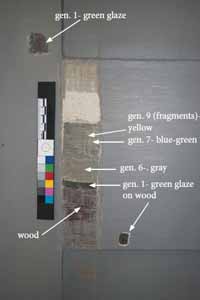 Room-side of passage door leaf, lock rail
Room-side of passage door leaf, lock rail
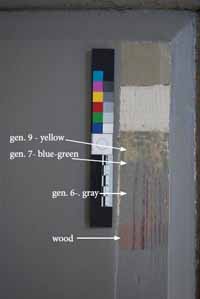 Wainscot panel, east wall, adjacent to passage door
Wainscot panel, east wall, adjacent to passage door
On February 18, 2013, selective paint removal was carried out on the parlor woodwork by Kirsten Travers to explore the paint history on a macro-level. It was of particular interest to explore the sixth generation gray scheme, which, in cross-section, appeared to be a faux-marbling finish (different shades of gray applied "wet-into-wet"). It was also of interest to expose a larger area of the first generation green finish to get a better understanding of its appearance. These exposures were carried out because the parlor woodwork was slated to be re-painted the following week. Therefore, this was an excellent opportunity to excavate for early paints.
Paint exposures had been made in the 1950s, during the restoration. The location of these exposures was determined through examination in raking light. The previous exposures were revealed with a combination of solvent gels and Citrus Strip, a commercial paint stripper, applied to the surface with a very short dwell time. Swollen paints were removed with a surgical scalpel, and rinsed with ethanol.
There was no evidence for a faux-marbling scheme in the sixth generation. In fact, this paint was a solid gray color that was a very close match for the gray color of the woodwork at the time of the exposures (the woodwork has since been re-painted with a green finish to reflect the first period color). The first period green finish was very discolored to black/brown. Due to this discoloration, it was not possible to learn more about its original color or transparency.
Footnotes
CROSS-SECTION MICROSCOPY ANALYSIS REPORT
JAMES GEDDY HOUSE, INTERIOR FINISHES: SECOND-FLOOR, SOUTHEAST ROOM
Block 19, Building 11
Colonial Williamsburg Foundation
Williamsburg, Virginia
Summer 2012
JAMES GEDDY HOUSE CROSS-SECTION MICROSCOPY REPORT, LAPHAM, November 18, 2012
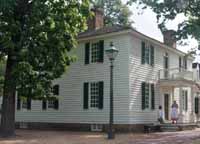 James Geddy house exterior, Williamsburg, Virginia
James Geddy house exterior, Williamsburg, Virginia
Structure: James Geddy House, block 19, building 11, second-floor, southwest room
Requested by: Edward A. Chappell, Roberts Director of Architectural and Archaeological Research
Analyzed by: Sara W. Lapham, Graduate Fellow Winterthur/University of Delaware Program in Art Conservation
Consulted: Susan L. Buck, Ph.D. Conservator and Paint Analyst, Williamsburg, Virginia; Kirsten Travers, Paint Analyst, Colonial Williamsburg Foundation (CWF)
Date submitted: November 18, 2012
Purpose:
The goal of this study is to explore the early finishes in the second-floor southwest room of the James Geddy House in order to better understand the evolution of that space and its relation to the rest of the interior. A study of the entire building is currently underway (Travers 2012). Reflected visible and ultraviolet cross-section microscopy, fluorochrome staining, polarized light microscopy, and colorimetry will be used to identify the binding media, pigments, and colors of the early finish generations.
History:
The James Geddy house (Geddy house) is located on the southeast corner of Palace Green and Duke of Gloucester Street. The 4/10-acre lot was created in the town plan of 1699 and sold by the Trustees of Williamsburg to Samuel Cobbs in 1716. By 1738 this, and the adjoining lot, were owned by James Geddy, the father of James Geddy Junior, for whom the house is now named (Schlesinger 1968).
James Geddy Jr. purchased the lot from his mother Anne Geddy in 1760. He was a prosperous silversmith, slave and land owner, and took an active role in public affairs. Upon purchasing this land it appears that James Geddy, Jr. wanted to demonstrate his aspirations for wealth and refinement by building a new house to reflect these ambitions. Dendrochronology preformed in 1983 by Herman Heikkenen concludes that the current structure was built around 1762 when the trees used for structures in the roof and cellar were cut down. (Chappell 1993).
The room examined for this study is on the second-floor in the southwest corner of the house. According to Schlesinger (1968) the southern door on the east wall was added in 1950 and the opening to the passage to bathroom was cut into the north wall in 1966. The walls have been replastered, but the rest of the woodwork is original. The door leaf of the east doorway to the passage is original, but has a metal sheet for fire suppression covering any early paint generations.
Previous Research:
In 2003 conservator Mark Kutney took 225 paint samples from the interior and exterior of the Geddy house. Many of these samples were mounted for cross-section analysis but no report or summary of his findings was completed. Along with the mounted samples there are also Ziploc bags containing uncast samples and a list of sample locations. According to this list, samples 65-68 were taken from the second-floor southwest room of the Geddy house. In addition to the sample list, Kutney also marked the sample numbers in ink next to the sample sites within the house. During the sample collection process for this study the author observed additional sites where Kutney sampled, but they are not listed under the second-floor southwest room. As part of this investigation, relevant Kutney samples were re-examined and used to augment this research.
Kirsten Travers is currently conducting a study of the interior finishes in the rest of the rooms in the Geddy house. The results from this study of the second-floor southwest room will be integrated into Travers' final report.
Procedures:
For this finish investigation 21 samples, (GE 41 - GE 61 and GE 76) were taken from the second-floor southwest chamber of the James Geddy house by Sara Lapham, Kirsten Travers, and Edward Chappell. Before sampling, the surfaces were examined with raking light, small excavations of the paint layers were made using a micro-scalpel, and the excavations were examined to identify areas with significant paint accumulations at low power magnification (10x). Samples were removed with a scalpel from the areas that appeared to have intact early finish generations. The samples were placed in Ziploc bags labeled with the sample number and a description of the sample site. All sample areas were recorded and photographed for future reference.
In the laboratory, samples were removed from their bags and examined with low-power magnification (5x - 40x) under a stereomicroscope. Four additional samples taken by Mark Kutney were also examined at this time and re-named GE-MK with his original sample numbers (65-68). The fragments with the earliest paint generations and most complete stratigraphies were embedded in Extec polyester resin and prepared for cross-section examination.
The cross-sections were examined and digital photomicrographs were captured in reflected visible and ultraviolet (UV) light at 100x, 200x, and 400x. The most informative photomicrographs of each sample were merged into a single document in Adobe Photoshop and manipulated so that the visible and UV images mirror each other. The photomicrographs were compared in order to establish and characterize the finish generations. Due to differences in white balancing during image capture and the variability of color printing, the images included in this report may not be entirely accurate in color. See Appendix A for further information about sample preparation and analytical procedures.
Cross-section microcopy (CSM) results:
The evidence found through cross-section microscopy confirms that all of the woodwork sampled in this room is original and still retains many of the early finish generations. The results are organized according to type of woodwork. The woodwork of the south and west window, east entrance to passage, and north closet architraves; the north closet door leaf (room and closet-side); and the south and west window sash is discussed first and categorized as "windows, doors, and architraves," followed by the fireplace mantel, and finally the baseboard.
Windows, doors, and architraves:
Sample locations:
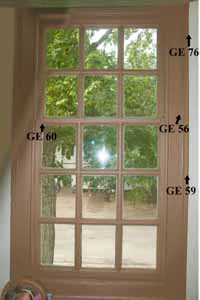 South Window
South Window
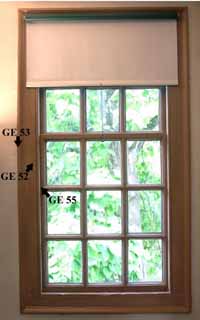 West Window
5
West Window
5
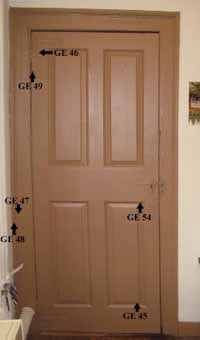 North Closet, Room-side
North Closet, Room-side
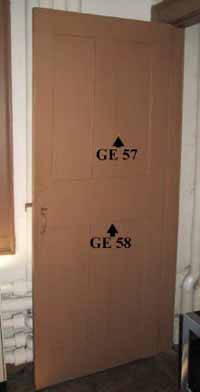 North Closet, Closet-side
North Closet, Closet-side
 East Door to Passage
East Door to Passage
Cross-section microscopy results for windows, doors, and architraves:
For this study, 16 samples were taken from the woodwork of the original doors, windows and architraves in the second-floor southwest room of the James Geddy House. The evidence found in these 16 samples establishes that there are as many as 25 generations of finish on the original woodwork. Tables I-III summarize all of the finish generations found on the woodwork.
The early generations (1-8) are lead white and chalk-based paints with many coarsely ground pigments (suggesting that the paints were prepared by hand). The exceptions to this are generation 6, a pigmented glaze (likely containing verdigris or copper resinate); and generation 8, a chalk and zinc-based green paint dating to post-1845 when zinc white pigments began to be manufactured (Gettens and Stout 1966). The zinc white pigment was identified based on its characteristic blue-white autofluorescence and bright "twinkling" particles (Travers, 2011), and confirmed by staining with TSQ. In most of the samples, the early finish generations, (if present) are uneven, compromised, include additional fill or touch-up layers, and are discolored from grime and oxidation of the binders.
Only three samples (GE 50, 51 and 53) contain what appears to be the first generation, which is a shellac sealant followed by a gray oil-based paint that consists of fine black and coarse yellow particles in a lead white matrix. (The presence of lead white was identified based on its characteristic peachy autofluorescence (Travers, 2011) and the presence of shellac by its characteristic orange autofluorescence in reflected ultraviolet light.) The other samples from these areas of woodwork also have a shellac sealant, but the majority of them are missing the first gray paint layer. The second generation, which is the first layer present in many of the samples, consists of a semi-translucent yellow primer (2a) followed by a lead white-based pale creamy yellow oil paint (2b).
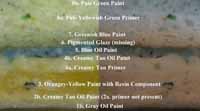 Early Finishes on the Windows, Doors, and Architraves, Generations 1-8 (GE 51)
Early Finishes on the Windows, Doors, and Architraves, Generations 1-8 (GE 51)
Table I: Reconstructed Stratigraphy of Early Finishes on the Windows, Doors, & Architraves (Generations 1-8)
| Gen. | Layer(s) | Description |
|---|---|---|
| 8 | 8b. Pale green paint | In some samples this layer is a strong pale green color and in others it appears more like a yellowish green or cream (It does not appear that there is a consistency of woodwork type where these color variations occur and are likely due to image capture and or variations in paint application/aging) Small green & coarse chalk pigments surrounded by pale green (or yellow/green in some samples). Autofluoresces bluish white, (darker than primer (8a),) in UV with some zinc white "twinkle". The presence of zinc white, which was confirmed with TSQ, dates this generation c. 1845 or later. |
| 8a. Pale yellowish green primer | Semi-transparent, pale green/greenish-yellow, coarse chalk pigments, few small green pigments. Has a bright bluish white autofluorescence in UV. | |
| 7 | 7 Greenish blue paint | Semi-transparent, coarse chalk & medium blue pigments, varies in color from sample to sample, paler or more yellow towards the top. In some samples this layer is a much truer blue than in others. Autofluoresces bright peach surrounding the non-fluorescent coarse pigment particles in UV. |
| Many of the samples have a layer between 4 & 5, as well as between 5 & 7, which could be a fill or touch-up material such as a glue, putty, etc. This layer is thick, translucent or semi-translucent, dark-brown to a light yellowish-brown, & autofluoresces bright blush white or purplish white in UV. All of the samples that have the unknown layer between 4 & 5 do not have generation 6. | ||
| 6 | 6 Green pigmented glaze | Semi-transparent, brown, with small pigment particles, varies greatly from sample to sample appearing dark greenish, reddish brown, or an opaque grayish brown that appears to be part of the layer above or below. Non-autofluorescent in UV but samples that are polished at an angle to the stratigraphy show some of the autofluorescence of adjoining layers through the transparency of this generation. |
| 5 | 5 Blue oil paint | Opaque, pale blue throughout with fine & coarse dark blue pigment particles. In UV autofluoresces brightly appearing a similar blue color as in visible light. |
| All of the samples that have an unknown fill material layer between 7 & 6 also have one between 5 & 4. The nature of this fill material is similar to that between layers 7 & 6. | ||
| 4 | 4b. Creamy tan oil paint | Smooth, opaque, and even creamy yellow tone. Bright peachy autofluorescence in UV with nonfluorescent fine and coarse pigment particles. |
| 4a. Creamy tan primer | Appears in cross-section creamy yellow with coarse chalk pigments, whiter than 4b. Autofluoresces grayish peach in UV surrounding non-fluorescent pigments | |
| 3 | 3. Orangey-yellow paint | Semi-transparent, deep orangey-yellow, fairly homogenous tone with patches that are more transparent. Darker peach autofluorescence in UV with non-fluorescent medium pigments. Likely contains a resin varnish component. In cross-section has a similar appearance to generation 1c in the dining room. |
| 2 | 2b. Creamy tan oil paint | Slightly transparent, fairly even tone with fine yellow & coarse chalk pigments. Bright peach autofluorescence in UV. |
| 2a. Semi-transparent yellow primer | Semi-transparent with coarse yellow & chalk pigments. Autofluoresces a dull grayish peach in UV. | |
| 1 | 1b. Gray oil paint | Fine black & coarse yellow pigments surrounded by a white, slightly transparent matrix. Grayish peach autofluorescence in UV. |
| 1a. Shellac sealant | Translucent/tan, cannot discern from the wood substrate in reflected visible light. Orange autofluorescence (only in wood pores) in UV. |
Generations 9 through 15 are zinc and lead white-based cream and off-white paints. They are evenly applied and with the exception of generation 12, (a gray paint), they are mostly smooth, finely ground, and opaque with few coarse pigment particles suggesting that they were industrially prepared. In reflected visible light these generations can be distinguished by the defined boundaries or "edges" between them, and in reflected ultraviolet light each generation has a distinct and different autofluorescence color.
 Off-White/Cream Paints on the Windows, Doors and Architraves, Generations 9-15(GE-MK 66)
Off-White/Cream Paints on the Windows, Doors and Architraves, Generations 9-15(GE-MK 66)
| Gen. | Layer | Description |
|---|---|---|
| 15 | 15 Off white/cream | Whitest layer in the stratigraphy, finely ground pigments with few coarse chalk pigments. Even peachy autofluorescence in UV. |
| 14 | 14 Off-white/cream | Off-white, slightly warmer tone towards the top. Bright white/green-white fluorescence in UV with lots of zinc "twinkle" & other bright autofluorescent particles |
| 13 | 13 Off white/cream | White/off-white, more coarse chalk particles than generations above. Pale lavender autofluorescence, with some bright white & translucent particles in UV. |
| In many of the samples there is a separation between these two layers which could indicate that a significant amount of time passed before generation 12 was painted over. | ||
| 12 | 12 Off-white/gray | Gray, semi-transparent, many coarse chalk particles. Gray-purplish gray autofluorescence, some zinc "twinkle" in UV |
| 11 | 11 Off white/cream paint | Creamy white, smooth, opaque, a few coarse chalk & small yellow particles. White or slightly peachy white, autofluorescence with zinc "twinkle" in UV |
| 10 | 10 Off white/cream paint | Creamy white, smooth a few medium chalk particles, slightly whiter than generations 11 & 9 Even, peachy autofluorescence with zinc "twinkle" in UV |
| 9 | 9 Off white/cream paint | Creamy white smooth, a few coarse chalk particles, may have primer too, top half is whiter than bottom. Gray-white autofluorescence in UV, more peachy in some images, "twinkle" of zinc. This generation, & possibly generation 10 as well, is found in the lower layers as a result of flowing into cracks or a cleavage between aged paint layers. |
Generations 16-25 (the most recent in the stratigraphy) are post-industrial modern tan/pinkish-tan paints that vary little from one another in visible light, but become more distinct in ultraviolet light. They are mostly composed of fine and medium red, yellow, orange, blue, and white pigment particles in a variety of binders. The layers are smooth, even in application, and have few disruptions. Generations 22-25, which are dim or non-autofluorescent in ultraviolet light, have the typical appearance of modern paints that do not contain white lead and are bound with synthetic resin binders.
Please note that in the following table the descriptions are to help distinguish one generation from the next. They are not necessarily accurate in describing the correct visible light colors, nor do the non-autofluorescent UV appearances have any significance other than helping to distinguish between the paint generations. Many of the generations are made up of a primer and a finish coat, but are listed as one layer to simplify the descriptions.
 Modern Paints on Windows, Doors, and Architraves, Generations 16-25 (GE 50)
Modern Paints on Windows, Doors, and Architraves, Generations 16-25 (GE 50)
| Gen. | Layer | Description |
|---|---|---|
| 25 | 25 Modern tan paint | A grayer pinkish tan than generation 24. Non-autofluorescent, very dark purplish in UV. |
| 24 | 24 Modern tan paint | An orangey pinkish tan that is slightly darker than generation 23. Non-autofluorescent dark purple in UV the lower part being darker than the upper. |
| 23 | 23 Modern tan paint | Large coarse red pigments, similar to generation 24 but a bit lighter. Very dim dull brown autofluorescence in UV. |
| 22 | 22 Modern tan paint | The lightest/brightest pinkish tan of the modern generations. Non-autofluorescent dull purple in UV |
| 21 | 21 Modern tan paint | Gray/off-white with a pinkish tan tone, few particles visible, smooth. Light pink autofluorescence in UV |
| 20 | 20 Modern tan paint | A cooler pinkish tan than surrounding layers, blue pigments visible throughout. Non-autofluorescent, brown in UV |
| 19 | 19 Modern tan paint | Pale pinkish tan, much less orange than other modern generations. Dull pinkish autofluorescence in UV. |
| 18 | 18 Modern tan paint | Orangey pinkish tan, slightly darker than generation 17. Autofluoresces a bright pinky peach in UV. |
| 17 | 17 Modern tan paint | Lighter and less pink than generations above & below, few distinct colored pigments visible. Light pink autofluorescence in UV with a bit of the zinc white "twinkle" |
| 16 | 16 Modern tan paint | Warm orangey pinkish tan with coarse orange pigments. Autofluoresces a pinkish/purple in UV with a large amount of the zinc white "twinkle" |
Cross-section microscopy images of selected samples:
The following photomicrographs are those that are most useful for the discussion and conclusions in this report. The results for all of the samples from the windows, doors, and architraves are summarized in table 1 of Appendix B.
All of the following images were cropped, rotated (as necessary), and labeled in Adobe Photoshop CS5. The numbers used for labeling represent the different finish generations with lowercase letters to distinguish multiple layers within one generation. For instance generation 1 is made up of two distinct layers: 1a, a shellac sealant, and 1b, a gray oil paint. Multiple layers in generations 9-25 are not indicated.
11GE 51: East wall, doorway to passage, right (south) architrave, convex surface adjoining inner edge 3" below upper right corner. Sample GE 51 has the most complete stratigraphy and least disrupted paint generations of all the samples. The images below show the complete stratigraphy with all generations (1-25) labeled. See the image on page 6 for a detail of the earliest generations.
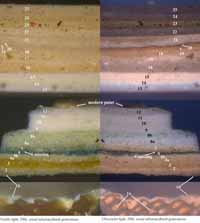 GE 51
GE 51
EAst Door to Passage Architrave, Backband
GE 50: East wall, doorway to passage, top architrave, fascia, ½" below backband and 4" right of north backband. GE 50 is one of the three samples that contain the first gray generation. The images of the paint layers show nearly all of the generations still attached. Note how generation 5 flowed through a crack in generations 1-4, suggesting that generation 4 was very disrupted before generation 5 was applied. Also, note the break between generation 12 and 13. In many of the samples (such as GE 51) generations 12 and below are separated from 13 and above by a fracture between these two layers, possibly indicating that generation 12 was left exposed for a long period of time before re-painting, or that generations 12 and 13 are incompatible paints.
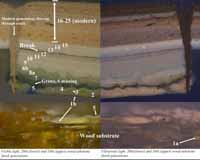 GE 50
GE 50
East Door Architrave, Fascia
GE 76: South window, west architrave, edge of backband 5" from top of architrave. Of the samples taken from the south window, GE 76 is the only one with well-defined early generations. This sample has many more colors mixed within the cream/off-white generations. The sample is from the edge of the backband close to the plaster wall, so it is likely that these colored layers between the white generations are overlaps of the plaster wall paints. This sample also includes the two layers that are most likely a fill material of some sort. In all of the other samples the fill layers are above and below generation 5 instead of generation 4. Again, due to the location of this sample, it is possible the fill materials are overlaps from the plaster wall, or this area may have been more compromised and therefore a fill material was applied at an earlier time or flowed beneath generation 4. Generations 5 and 6 are missing from this sample. It could be that these generations were lost, or were never applied to the edge of the backband when the rest of the woodwork was repainted. The first gray paint was not found in this sample.
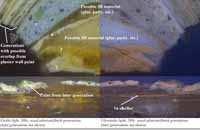 GE 76
GE 76
South Window Architrave, Backband
GE 60: South window, lower sash, top muntin, far left corner on ovolo. Most of the samples taken from the south window do not have well-defined early generations. They appear whiter and are indistinguishable from one another. Also, many of the samples taken from the window sashes contain additional layers of paint that do not fit within the rest of the generations. These layers are likely touch-ups or represent the more frequent re-painting of the window sashes due to the greater weathering of these surfaces. Or, it is possible that the sashes were sometimes painted different colors than the rest of the trim elements. Generation 6, a green pigmented glaze, is readily identifiable in this cross-section.
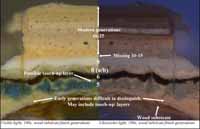 GE 60
GE 60
South Window, Lower Sash
GE 53 West window, left (south) architrave, middle of backband fillet, 2' 11" above bottom of window frame. Only the earliest paints are shown in the images below. Out of all of the samples from the windows, this is the only sample that includes the first gray generation. This cross-section also shows the two layers of possible fill materials above and below generation 5. The presence of this fill material suggests that generations 4 and 5 were largely compromised before they were painted over. The presence of grime accumulation in samples that do not include a fill material (GE 50 and 51) supports the theory that generations 4 and 5 were left exposed for long periods of time before being re-painted.
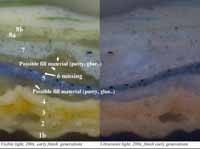 GE 53
GE 53
West Window Architrave, Backband
GE 49: North closet, upper HL hinge on closet door, lower left corner of exposed vertical active leaf. This sample includes a fairly distinct two-part second generation of a semi-translucent yellow primer (2a) followed by the opaque creamy yellow oil paint (2b). This evidence shows that the hinge was painted with the same finish coats as the rest of the room from at least the second generation onward. This sample is also a good example of how generation 6 appears both a reddish brown and a greenish brown in cross-section. This color difference is discussed further on the following page.
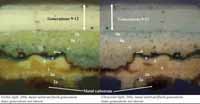 GE 49
GE 49
North Closet Door, Hinge
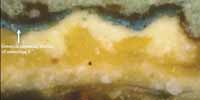 GE 49 visible light, 400x, detail of metal substrate and earliest finish generations
GE 49 visible light, 400x, detail of metal substrate and earliest finish generations
GE-MK 68: west window, top sash, top rail at top PR pane. The uncast images of this sample have intact areas of generation 6, a pigmented green glaze. The green and brown areas (labeled in the images), highlight the color shift from green to brown often observed in coatings containing copper based pigments such as verdigris. (Gettens and Stout 1966, Kühn 1970).
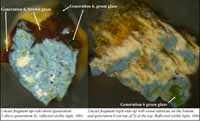 GE-MK 68
GE-MK 68
West Window, Upper Sash
GE 57: North closet, door leaf, closet-side, upper right panel, 53" up from floor, and 18" from left edge of door. The closet-side of the north closet door leaf was painted with the same early paints corresponding to generations 1a, 2, 3, and 4 on the room-side of the closet door. After the fourth generation it appears that the closet-side of the door leaf was not painted again until generation 8. This continual re-painting early on, and then lack of re-painting for three generations, could signify a change in the way that the room was used.
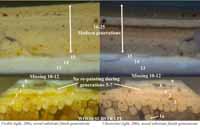 GE 57
GE 57
North Closet Door Leaf, Closet Side
GE 58: North closet, door leaf, closet-side, lower right hand panel, upper left corner, 34" above floor. Although the early generations are not attached to the wood substrate, they are easier to interpret in this sample. Also, this sample shows that the closet-side of the door leaf was painted with generations 2-4, was not re-painted during generations 5-7, but then from generation 8 onward the closet-side leaf was painted to match the rest of the room.
Fireplace mantel:
Cross-section microscopy results, fireplace mantel:
The fireplace mantel has a total of 23 generations of finish. The early generations (1-6), are distinctly different from the early generations on the rest of the woodwork in this room. These generations are largely compromised and hard to distinguish from the adjoining generations. These conditions made it difficult to align the mantel finishes with those of the rest of the room.
Like the woodwork in the rest of the room, generation 1 on the fireplace mantel begins with shellac to seal the wood pores. On top of the shellac there is an off-white primer followed by a pale blue-gray paint. The two are difficult to distinguish in visible and ultraviolet light, but are clearly distinct with the B-2A filter cube (see GE 41, B-2A images in the binding media analysis section). They are both oil-based paints with dispersed small blue pigments surrounded by a lead white matrix. See images and table IV on page 21 for further detail of the early finish generations.
Generations 7 through 14, with the exception of generation 11, are the same cream/off-whites as generations 9-15 on the windows, doors, and architraves. Generation 11 appears to be a flattened varnish; it is tan, semi-translucent, and has a bright purplish-white autofluorescence, characteristic of a synthetic resin varnish. Generations 7-10 and 12-14 on the fireplace mantel correspond to generations 9-12 and 13-15 on the original windows, doors, and architraves. See corresponding descriptions in table II.
Generations 15-23 correspond to the modern generations on the other original woodwork in this room. For further information about generations 15-23 see descriptions of corresponding generations 16-25 in table III.
21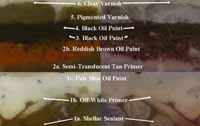 Early Finishes on the Fireplace Mantel, Generations 1-6 (GE 41)
Early Finishes on the Fireplace Mantel, Generations 1-6 (GE 41)
| Gen. | Layer(S) | Description |
|---|---|---|
| 6 | 6 Clear varnish | Transparent, thin, bright white autofluorescence in UV |
| 5 | 5 Pigmented varnish | Transparent with small red and yellow pigment particles, blue/gray autofluorescence in UV |
| 4 | 4 Black paint | Black, opaque, no discrete particles in visible light, in UV binder autofluoresces tan surrounding clumps of small dark pigments |
| 3 | 3 Black paint | Black, opaque, dispersed small colored pigments, difficult to discern from generation 4 in visible light, in UV binder autofluoresces tan surrounding clumps of small reddish-brown pigments. |
| 2 | 2b Reddish brown paint | Coarsely ground red pigments, surrounded by a semi-translucent binder. In UV the binder autofluoresces tan surrounding clumps of fine and coarse red pigments |
| 2a Semi-translucent tan primer | Semi-translucent, tan, coarse chalk pigments. Patches of pink and purple autoflorescence in UV | |
| 1 | 1c Pale blue paint | Opaque with very slight translucency, smooth, white with small dispersed colored pigments, peachy autofluorescence in UV |
| 1b Off-white primer | Opaque, off-white, smooth, bright peachy autofluorescence in UV | |
| 1a | Shellac sealant Within pores of wood substrate, transparent in visible light, orange autofluorescence in UV. |
Selected images of fireplace mantel samples:
GE 41: Fireplace shelf, beaded backboard, lower right (east) corner immediately above the bottom bead and ¼" in from the right bead. Of the samples examined from the fireplace in this study, only fragments from sample GE 41 include the readily identifiable layers that are generations 5 and 6. The images below also include the complete stratigraphy from generation 1- 23. GE 41 continued on next page.
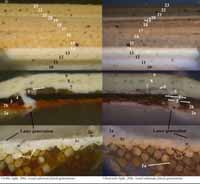 GE-41
GE-41
Fireplace Mantel, Beaded Backboard
GE 41: This detail of the wood substrate and finish generations 1-7 (missing generation 6) clearly shows the two distinct generations (3 and 4) of black oil paints.
 GE-41
GE-41
Fireplace Mantel, Beaded Backboard
GE 42: Fireplace shelf, right (east) end of the upper fillet on the (upper) cyma recta, 1¼" below the top and ¼" back from the front corner. This sample includes traces of the red paint from generation 2 on top of, and trapped in the cracks of generation 1. This confirms that there are no additional layers missing from the fireplace mantel samples that should be between generations 1 and 2.
Baseboard:
Cross-section microscopy results, baseboard:
Only one sample (GE 61) from the baseboard was taken for this investigation. The stratigraphy of GE 61 was compared to the stratigraphies of other samples from this room, and to baseboard samples from other rooms in the house taken by Kutney in order to determine how this cross-section relates to the rest of the baseboard. Based on comparisons with the Kutney samples it appears that the stratigraphy in GE 61 is representative of the baseboard stratigraphy in this room. Further comparisons to how the Kutney samples relate to GE 61 are made in the conclusions of this report.
Sample GE 61 has a total of 22 generations of finish present. Comparing its stratigraphy to the stratigraphy on the windows, doors, and architraves, (as shown in table 2 in Appendix B) it appears that at least three early finish generations are missing, or the baseboard was not repainted with the same regularity as the rest of the woodwork until after generation 9 (compared to the windows, doors, and architraves).
Like the fireplace, the baseboard also has a shellac sealant, but otherwise these early finishes do not match. These early generations are very disrupted as a result of the many cracks and cleavages within the layers. The first generation is a coarsely ground, brown, oil paint (1b) on top of a shellac sealant (1a). In ultraviolet light patches of white or orange autofluorescing medium surround the fine and coarse non-autofluorescent red-brown and yellowish-brown pigments. All of the early generations (1-5 shown in table IV), as well as the wood substrate, are very disrupted in the baseboard sample.
26 Early Finishes on the Baseboards, Generations 1-5 (GE 61)
Early Finishes on the Baseboards, Generations 1-5 (GE 61)
| Gen. | Layer(s) | Description |
|---|---|---|
| 5 | 5 Pigmented varnish | Transparent with dispersed pigments. Has a yellowish brown fluorescence in UV. |
| 4 | 4 Black paint | Smooth, dark, opaque without discernable pigment particles. In UV the binder fluoresces tan in very small areas around the tightly packed pigments. |
| 3 | 3 Pigmented varnish | Transparent with dispersed pigment particles. Fluoresces a dull peachy/gray in UV. |
| 2 | 2b. Orangey-red paint | Mostly opaque with patches of slight transparency, fine and coarsely ground orange pigments. In UV the red clumps of pigments are surrounded by a white autofluorescence. |
| 1 | 1b. Brown paint | Coarse and fine red pigments in a semi-transparent binder. In UV there are patches of bright white or orange autofluorescence where there is more binder than pigment. |
| 1a. | Shellac sealant Transparent in visible light. Orange fluorescence in UV within the wood pores. |
Binding media analysis (fluorochrome staining):
Samples GE 51, GE 49, GE 42, and 61 were analyzed using biological fluorochrome stains in order to characterize the binding media of the early finish generations. Digital images were captured before and after staining and compared to identify positive reactions. Only the images with the most useful are reactions included in this report. A summary of the results is listed in tables 3.1-3.4 of Appendix B, and Appendix A has more information about fluorochrome stains and procedures.
Triphenyl Tetrazolium chloride (TTC) was used to test for the presence of carbohydrates (such as gums, sugars, cellulosics). The red/brown positive reactions are labeled in the images below and on the following page.
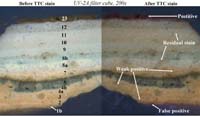 GE-51: East Door Architrave
GE-51: East Door Architrave
Before TTC stain
Fluorescein isothiocyanate (FITC) was used to test for the presence of proteins (such as egg tempera, casein, animal glues, and modern surfactants with amine groups). The positive yellow/green reactions are labeled on the images below and on the following pages.
32 332, 7, Dichlorofluorescein (DCF) was used to test for the presence of lipids (oils). The positive reactions shown by a pink or yellow fluorescence are labeled on the images below and on the following pages.
35 36Rhodamine B (RHOB) was also used to test for the presence of lipids (oils). The positive reaction sites, identified by their orange/red fluorescence, are labeled on the images below.
Pigment identification (polarized light microscopy):
Generations 1-5 on the original doors, windows, and architraves (from sample GE 51); generations 1-3 on the fireplace mantel (from sample GE 42); and generations 1-2 on the baseboard (from sample GE 61) were examined using transmitted polarized light microscopy (PLM) for pigment identification.
Uncast portions of each sample were glued to a glass slide and a micro-scalpel was used to expose each generation and scrape off a small dispersed pigment sample. Each dispersed pigment sample was mounted between a glass slide and coverslip using Cargille MeltMount (refractive index = 1.66). The optical properties, shapes, and sizes of the pigments in each sample were observed at 400x and used for identification. See Appendix A for more information about procedures and Appendix B, table 4 for the pigments identified in each generation that was analyzed. Due to the difficulty in isolating one generation from the next, some of the pigments identified in one generation could actually have come from an adjoining layer.
PLM results:
All of the pigments identified in each of the 10 generations analyzed with PLM are listed in table 4 of Appendix B, as well as in the section summarizing all of the results for the earliest finish generations just before the conclusions in this report. The dispersed pigment images are labeled with some of the major components of that generation, but not all pigments identified are always labeled or present in that image.
Pigment characteristics:
Iron oxides (Fe2O3‧nH2O), or so-called earth pigments, were observed in all of the generations. Earth pigments include yellow ochre, red ochre, raw sienna, burnt sienna, and raw and burnt umber (Fe2O3‧MnO2‧nH2O). It can be challenging to identify the exact earth pigment present in a sample, especially when the pigment is not isolated. For this reason, aside from red ochre in some samples, identifications of these pigments are generalized as yellow earth (yellow ochre, raw sienna, and raw umber), or red earth (burnt sienna, burnt umber, and red ochre).
Yellow earth pigments (yellow ochre, raw sienna, and burnt sienna) are seen in transmitted plane polarized light as small to medium, translucent/yellow, aggregates that are globular in shape, have refractive indices greater than 1.66, and are isotropic (dark) in crossed polars.
Red earth pigments (burnt sienna, burnt umber, and red ochre) are seen in most of the samples as small to medium; red and orange translucent, or dark red semi-opaque; globular shaped particles with refractive indices larger than 1.66 and appear isotropic in crossed polars, with the exception of red ochre which has an orange/red birefringence.
To some degree, all of the generations also contain chalk pigments (CaCO3). These pigments are medium, transparent/colorless, plate-like particles with refractive indices less than 1.66, have bright birefringence with interference colors, and undulose extinctions.
40As observed by the characteristic peachy autofluorescence under ultraviolet light, many of the finish generations have a matrix of lead white (2PbCO3 ‧ Pb(OH)2) pigments. These pigments are visible as very small, rounded, anisotropic, transparent to greenish yellow colored particles with bright birefringence in crossed polars, and refractive indices greater than 1.66.
Black pigments were tentatively identified as carbon based pigments but the exact pigment type was not identified. These pigments are black, opaque, round, large to small particles that are isotropic in crossed polars.
Prussian blue (Fe4[Fe(CN)6]3) pigments were identified in a few of the generations. They are semi-translucent to translucent blue particles that range from medium to large in size, have a refractive index less than 1.66 and are isotropic in crossed polars.
PLM images for generations 1-5 on the original windows, doors, and architraves (GE 51):
Generation 1: Gray
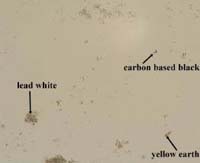 Dispersed pigment sample from sample GE 51, generation 1, transmitted plane polarized light, 400x
Dispersed pigment sample from sample GE 51, generation 1, transmitted plane polarized light, 400x
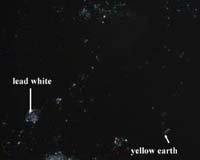 Dispersed pigment sample from sample GE 51, generation 1, transmitted cross-polarized light, 400x
Dispersed pigment sample from sample GE 51, generation 1, transmitted cross-polarized light, 400x
Generation 3: Orangey-yellow
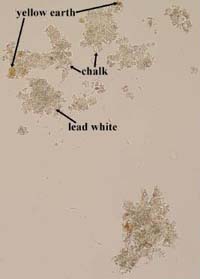 Dispersed pigment sample from sample GE 51, generation 3, transmitted plane polarized light, 400x
Dispersed pigment sample from sample GE 51, generation 3, transmitted plane polarized light, 400x
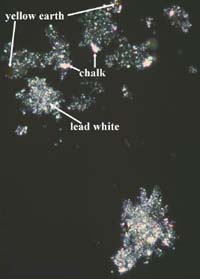 Dispersed pigment sample from sample GE 51, generation 3, transmitted cross-polarized light, 400x
Dispersed pigment sample from sample GE 51, generation 3, transmitted cross-polarized light, 400x
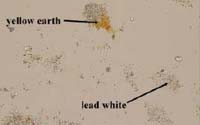 Dispersed pigment sample from sample GE 51, generation 4, transmitted plane polarized light, 400x
Dispersed pigment sample from sample GE 51, generation 4, transmitted plane polarized light, 400x
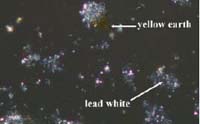 Dispersed pigment sample from sample GE 51, generation 4, transmitted cross-polarized light, 400x
Dispersed pigment sample from sample GE 51, generation 4, transmitted cross-polarized light, 400x
PLM images for generations 1-3 on the fireplace mantel (GE 42):
Generation 1: Blue/gray
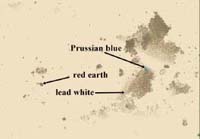 Dispersed pigment sample from sample GE 42, generation 1, transmitted plane polarized light, 400x
Dispersed pigment sample from sample GE 42, generation 1, transmitted plane polarized light, 400x
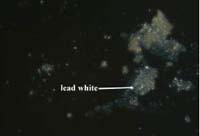 Dispersed pigment sample from sample GE 42, generation 1, transmitted plane polarized light, 400x
Dispersed pigment sample from sample GE 42, generation 1, transmitted plane polarized light, 400x
PLM images for generations 1 and 2 on the baseboard (GE 61):
Color measurement and matching:
Generations 1-5 of the woodwork on the windows and doors, and generations 1-3 from the fireplace woodwork were measured for color matching. Using uncast portions of the samples, with a Minolta Chroma Meter CR-241/microscope, the color values in CIE L*a*b* color-space and in the Munsell color system were recorded for each generation. Running through a series of steps explained in Appendix A, commercial paint matches for each generation were established.
The ΔE value, which is the color difference between any two colors, was calculated to compare the accuracy of the commercial match to the historic paint. The most sensitive human eye can detect a color difference with a ΔE around 2, but the average human eye is unable to detect differences with a ΔE in the range of 3-5 (Wolbers 2010). For this study color matches around or below a ΔE of 3 are considered a satisfactory match. Generations that were too compromised or translucent were color-matched visually under a color corrected-light source at 5x - 40x. For the samples matched visually only the color measurements from the commercial paint swatch are included in this report.
The fact that the first creamy-yellow paint on most of the woodwork is the same as generation 2 on the east door is confirmed by comparing the CIE L*a*b* values measured to get a ΔE of 2.81.
Painted woodwork from the windows, doors, and architraves:
 GE 51 uncast, reflected visible light, 100x
GE 51 uncast, reflected visible light, 100x
Generation 1b: Gray oil paint
Windows, doors, and architraves generation 1b color measurements (samples GE 50 & 51)
| L* | a* | b* | Hue | Value | Chroma | |
|---|---|---|---|---|---|---|
| 1 | 53.71 | -1.85 | +10.66 | 7.0Y | 5.3 | 1.3 |
| 2 | 51.09 | -1.39 | +11.36 | 6.5Y | 5.0 | 1.6 |
| 3 | 52.81 | -0.07 | +9.43 | 3.7Y | 5.2 | 1.3 |
| 4 | 54.34 | +0.15 | +9.48 | 3.1Y | 5.3 | 1.3 |
| Average | 52.99 | -0.79 | +10.23 |
| CIE L*a*b* values | L* | a* | b* |
|---|---|---|---|
| 54.07 | +1.00 | +8.26 | |
| Munsell values | Hue | Value | Chroma |
| 1.1Y | 5.3 | 1.2 |
ΔE = 2.65
Please see hard copy for Benjamin Moore color sample.
Painted woodwork from the windows, doors, and architraves:
 GE 51 uncast, reflected visible light, 100x
GE 51 uncast, reflected visible light, 100x
Generation 2: Creamy tan oil paint
| L* | a* | b* | Hue | Value | Chroma | |
|---|---|---|---|---|---|---|
| 1 | 60.95 | +2.14 | +27.74 | 2.0Y | 6.0 | 4.1 |
| 2 | 60.78 | +1.69 | +28.12 | 2.3Y | 6.0 | 4.2 |
| 3 | 59.94 | +3.97 | +29.67 | 0.8Y | 5.9 | 4.5 |
| 4 | 64.85 | +2.71 | +23.02 | 0.8Y | 6.4 | 3.5 |
| 5 | 63.06 | +3.25 | +23.98 | 0.5Y | 6.2 | 3.6 |
| Average | 61.92 | +2.75 | +26.51 |
| CIE L*a*b* values | L* | a* | b* |
|---|---|---|---|
| 60.61 | +3.23 | +23.61 | |
| Munsell values | Hue | Value | Chroma |
| 0.7Y | 6.0 | 3.6 |
ΔE = 3.18
This color match is a good match to some of the samples but appears too dark for others. Based on the measurement numbers Benjamin Moore's "scarecrow" is the best match, but Benjamin Moore's "stone house" (1039), which is the same color but of a lighter shade, is a better match for other samples.
Please see hard copy for Benjamin Moore color sample.
Painted woodwork from the windows, doors, and architraves:
 GE 51 uncast, reflected visible light, 100x
GE 51 uncast, reflected visible light, 100x
Generation 3: Semi-translucent orangey-yellow paint with resin varnish component
Due to the translucency of this generation color matching was completed by eye.
| CIE L*a*b* values | L* | a* | b* |
|---|---|---|---|
| 66.61 | +11.13 | +44.90 | |
| Munsell values | Hue | Value | Chroma |
| 8.9YR | 6.6 | 7.3 |
Please see hard copy for Benjamin Moore color sample.
Painted woodwork from the windows, doors, and architraves:
 GE 51 uncast, reflected visible light, 100x
GE 51 uncast, reflected visible light, 100x
Generation 4: Creamy tan oil paint (may include primer)
| L* | a* | b* | Hue | Value | Chroma | |
|---|---|---|---|---|---|---|
| 1 | 64.97 | +1.44 | +22.15 | 1.9Y | 6.4 | 3.3 |
| 2 | 64.84 | +1.49 | +21.83 | 1.9Y | 6.4 | 3.2 |
| 3 | 64.87 | +1.42 | +22.43 | 2.0Y | 6.4 | 3.3 |
| Average | 64.89 | +1.45 | +22.14 |
| CIE L*a*b* values | L* | a* | b* |
|---|---|---|---|
| 68.36 | +2.07 | +22.15 | |
| Munsell values | Hue | Value | Chroma |
| 1.1Y | 6.7 | 3.3 |
ΔE = 3.52
Please see hard copy for Benjamin Moore color sample.
 GE 51 uncast, reflected visible light, 100x
GE 51 uncast, reflected visible light, 100x
Generation 5: Blue
| L* | a* | b* | Hue | Value | Chroma | |
|---|---|---|---|---|---|---|
| 1 | 36.55 | -4.59 | -5.98 | 5.7B | 3.6 | 1.7 |
| 2 | 36.78 | -4.42 | -8.49 | 7.9B | 3.6 | 2.2 |
| 3 | 35.53 | -4.58 | -8.28 | 7.8B | 3.5 | 2.2 |
| Average | 36.28 | -4.53 | -7.58 |
| CIE L*a*b* values | L* | a* | b* |
|---|---|---|---|
| 35.34 | -4.61 | -8.93 | |
| Munsell values | Hue | Value | Chroma |
| 8.0B | 3.5 | 2.3 |
ΔE = 1.65
Please see hard copy for Benjamin Moore color sample.
Fireplace mantel:
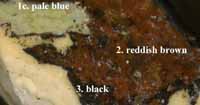 GE 42 uncast, reflected visible light, 100x
GE 42 uncast, reflected visible light, 100x
Generation 1c: Pale blue oil paint
Visually heather gray is the best color match but based on the measured values, appears too dark and yellow compared to the historic sample. It was difficult to isolate a large enough area of this pale blue paint so this layer was matched under color corrected light source at low magnification. Please see hard copy for Benjamin Moore color sample.
| CIE L*a*b* values | L* | a* | b* |
|---|---|---|---|
| 78.34 | -5.06 | -3.71 | |
| Munsell values | Hue | Value | Chroma |
| 4.1B | 7.7 | 1.4 |
Please see hard copy for Benjamin Moore color sample.
Fireplace mantel:
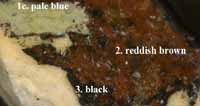 GE 42 uncast, reflected visible light, 100x
GE 42 uncast, reflected visible light, 100x
Generation 2b: Reddish brown
| L* | a* | b* | Hue | Value | Chroma | |
|---|---|---|---|---|---|---|
| 1 | 39.54 | +13.34 | +11.98 | 0.2YR | 3.9 | 3.3 |
| 2 | 38.95 | +14.70 | +12.98 | 10.0R | 3.8 | 3.7 |
| Average | 39.25 | +14.02 | +12.48 |
| CIE L*a*b* values | L* | a* | b* |
|---|---|---|---|
| 41.52 | +14.30 | +12.37 | |
| Munsell values | Hue | Value | Chroma |
| 10.0R | 4.1 | 3.5 |
ΔE = 2.67
Please see hard copy for Benjamin Moore color sample.
Fireplace mantel:
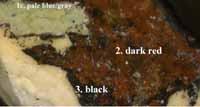 GE 42 uncast, reflected visible light, 100x
GE 42 uncast, reflected visible light, 100x
Generation 3: Black oil paint
| L* | a* | b* | Hue | Value | Chroma | |
|---|---|---|---|---|---|---|
| 1 | 25.55 | +0.52 | -0.61 | 3.3P | 2.5 | 0.1 |
| 2 | 24.88 | +0.95 | -1.99 | 9.0PB | 2.4 | 0.4 |
| 3 | 26.52 | +1.20 | -1.08 | 5.3P | 2.6 | 0.3 |
| Average | 25.65 | +0.89 | -1.22 |
| CIE L*a*b* values | L* | a* | b* |
|---|---|---|---|
| 23.60 | +0.24 | -1.88 | |
| Munsell values | Hue | Value | Chroma |
| 4.8BP | 2.3 | 0.4 |
ΔE = 1.95
Please see hard copy for Benjamin Moore color sample.
Baseboard:
 GE 61 uncast, reflected visible light, 100x
GE 61 uncast, reflected visible light, 100x
Generation 1b: Brown oil paint
| L* | a* | b* | Hue | Value | Chroma | |
|---|---|---|---|---|---|---|
| 1 | 31.49 | +4.36 | +4.84 | 2.6YR | 3.0 | 1.1 |
| 2 | 30.37 | +5.57 | +5.76 | 2.0YR | 2.9 | 1.4 |
| 3 | 32.15 | +4.61 | +5.38 | 3.0YR | 3.1 | 1.2 |
| Average | 31.33 | +4.48 | +5.32 |
| CIE L*a*b* values | L* | a* | b* |
|---|---|---|---|
| 31.46 | +4.70 | +5.13 | |
| Munsell values | Hue | Value | Chroma |
| 2.5YR | 3.0 | 1.2 |
ΔE = 0.33
Please see hard copy for Benjamin Moore color sample.
Baseboard:
 GE 61 uncast, reflected visible light, 100x
GE 61 uncast, reflected visible light, 100x
Generation 2: Reddish-orange oil paint
| L* | a* | b* | Hue | Value | Chroma | |
|---|---|---|---|---|---|---|
| 1 | 49.32 | +25.83 | +31.90 | 1.7YR | 4.8 | 7.4 |
| 2 | 49.72 | +28.37 | +32.65 | 1.1YR | 4.9 | 7.8 |
| 3 | 48.45 | +26.34 | +31.13 | 1.5YR | 4.7 | 7.4 |
| Average | 49.16 | 26.85 | +31.89 |
| CIE L*a*b* values | L* | a* | b* |
|---|---|---|---|
| 52.03 | +26.80 | +33.25 | |
| Munsell values | Hue | Value | Chroma |
| 1.7YR | 5.1 | 7.7 |
ΔE = 3.17
Please see hard copy for Benjamin Moore color sample.
Summary of overall results for earliest finishes in the southwest second-floor chamber:
Windows, doors, and architraves:
Generation 1b has a gray appearance in cross-section mainly showing small carbon based black pigments and large yellow earth pigments in a lead white matrix. Small and large red earth, chalk, and blue pigments (not found in PLM) are also visible in this layer. Benjamin Moore's "iron gate", was determined to be a very close color match. No clear positive results with fluorochrome staining were observed for this layer, but the glossy appearance in the uncast sample suggests that it is an oil paint. The inconsistent and coarse pigment particle sizes are typical of hand ground paints. The evidence of this gray paint however is limited. As discussed in the conclusions of this report, it is possible that the actual first generation is the creamy tan that is interpreted as the second generation for this study.
In some samples from the second-floor southwest room generation 2 includes a distinct semi-translucent tan primer followed by 2b, the creamy tan finish coat. These two layers could not be separated out for pigment identification or color matching and therefore are discussed as one in this section of the report. In cross-section, generation 2 has a creamy yellow appearance with mostly yellow earth pigments in a lead white and chalk matrix. Also visible are medium-size carbon-based black and small red earth pigments. Although this generation appears to be a creamy-yellow color in reflected visible light, the color measurements show that it is more of a medium tan color that is a close color match to Benjamin Moore's "scarecrow". This generation had weak positive reactions for the presences of lipids and carbohydrates suggesting that it has a drying oil binder and the pigments may have been ground with a gum component.
The strong yellow appearance of the semi-translucent third generation could be the reason that the second and fourth generations are perceived as creamy yellow instead of tan. The majority of this layer is composed of yellow earth pigments in a lead white matrix, but chalk, carbon-based black, and red earth pigments can also be seen in cross-section and were characterized with PLM. This generation did not have any well-defined reactions with fluorochrome stains, but the translucency and bright autofluorescence of the binder suggests that there is a significant resin component. Comparison to commercial paint samples shows that this generation can be described better as an orangey yellow close to Benjamin Moore's "delightful golden".
Generation 4 can be described in much the same way as generation 2, with the exceptions that it contains a greater concentration of chalk pigments; no black pigments were found with PLM; and the commercial color match is Benjamin Moore's "spice gold", a lighter tan than the match for generation 2.
Generation 5 consists of coarse dark and small light Prussian blue pigments within a light blue appearing lead white matrix. Medium red ochre and coarse chalk pigments are also seen in cross-section and were identified with PLM. Although this generation appears a medium blue color, the Benjamin Moore color match, "newburg green" is more of a darker slightly greenish blue. There were no strong positive reactions for this generation, but its opacity and glossy appearance suggest that the pigments are bound in a drying oil.
Fireplace mantel:
The primer and finish paint of the first generation on the fireplace mantel could not be separated easily for PLM and color matching and are therefore discussed together in this section of the report. In cross-section the majority of this pale blue layer is composed of small and medium Prussian blue pigments that are thinly dispersed in a lead white matrix. Red earth pigments were also identified with PLM but are most likely from the layer above. The closest commercial paint color to this generation is Benjamin Moore's "Yarmouth blue". This paint had weak positive reactions lipids and proteins. It most likely contains a drying oil binder. The slight positive reaction with the protein stain may be a false positive do to the presence of water or a polyhydric material such as shellac.
Coarsely ground red earth pigments make up the majority of generation 2b but chalk, carbon based black, and lead white pigments were also identified by PLM. The brick red appearance of this layer in cross-section can better be described as a reddish brown like that of the commercial paint match Benjamin Moore's "pumpernickel". This layer had a clear positive reaction for the presence of lipids, confirming that it has an oil binder. It also showed weak positive reactions for the carbohydrate and protein stains. The positive for carbohydrates may indicate that the pigments were ground with a gum component and the protein positive could be the same false positive as described for generation 1 above.
In cross-section generation 3 has red, yellow, and greenish particles dispersed throughout a carbon based black matrix. With PLM the yellow particles were identified as yellow earth, and chalk pigments were also identified, but no red or green pigments were seen. This layer is similar to Benjamin Moore's "midnight dream", a cool tone of black. The positive reactions with two lipid fluorochrome stains confirms that this paint contains an oil binder. The positive reaction for the presence of carbohydrates suggests that the pigments may have been ground with a gum component.
Generation 4, also a black paint, has a different appearance in cross-section but using an uncast fragment it could not be separated from generation 3 for pigment identification and color matching; and it had the same results for fluorochrome staining. This layer is distinct from generation 3 in cross-section because it does not contain colored particles within the black matrix and the black pigments appear darker in ultraviolet light than those in generation 3. Pigment identification and color matching were not attempted for generation 5 due to the difficulty in isolating it in an uncast fragment. The bluish white autofluorescence of this layer in ultraviolet light identifies the major component as a resin, but the weak positive reaction for the presence of lipids suggests that it also contains a small amount of drying oil.
Baseboard:
The generation 1b on the baseboard has a reddish brown appearance in cross-section, but is a good match with Benjamin Moore's "Mississippi mud", which is better described as brown. The coarse red and orangey-brown particles were identified as earth pigments using PLM. Although not observed in cross-section, a few chalk pigments were also identified with PLM. This layer reacted positive for the presence of lipids, confirming that it is an oil bound paint.
Generation 2 has a bright orange appearance in cross-section but is more of an orangey red color, like that of Benjamin Moore's "rust". Red lead and red earth pigments make up the majority of the layer, along with a few chalk and other white pigments that were not identified in PLM. No definite positive reactions were observed with fluorochrome stains, but this generation is assumed to contain an oleo-resin binder based on the glossy appearance in reflected visible light in the uncast sample and the bright autofluorescence in ultraviolet light.
Pigment identification and color matching was not attempted for generations 3-5 on the baseboard. These generations are largely compromised and isolating them within an uncast sample would have been difficult. Weak positive reactions for the presence of lipids and the bright autofluorescence in ultraviolet light suggest that generations 3 and 4 are mostly resinous in nature, with a small amount of drying oil.
Conclusions:
Second-floor southwest chamber finishes:
The evidence found in the samples examined for this study suggest that the window and door architraves, window sashes, and north closet door leaf are all first period. As many as 25 generations of finish are present and many of the samples from these areas of woodwork still retain many of the earliest finish generations. The earliest gray paint however was only found in three of the samples. We will likely never know the reason why this is true but due to evidence of a first generation gray in other parts of the house one could assume that all of the woodwork of the windows doors and architraves in this room was originally painted gray. It is also possible however that the gray paint is only present on re-used wood, or portions of the woodwork where painted with a gray primer but the room was not painted for a long enough time to allow the primer to weather before application of the tan paint of the second generation. Because this tan second generation is found on all of the woodwork of the windows, doors, and architraves one could also interpret that it is the true first generation.
The baseboard and the fireplace mantel also appear to be first period although their finish histories, aside from also beginning with a shellac sealant, are distinctly different from other areas of woodwork in this chamber. The fireplace mantel and baseboard also retain fewer early finish generations than the other woodwork. The reason for this is unknown but several possibilities can be suggested: the few samples from the fireplace mantel and baseboard simply do not capture all of the finish generations present, these areas of woodwork were not re-painted as often, or some generations of finish no longer exist due to loss at the time of their exposure.
60Table 2 in appendix B shows how the finish generations on the fireplace mantel and baseboard relate to those of the other woodwork. The first five finishes on the baseboard and six finishes on the fireplace mantel do not directly relate to any of the finishes on the other woodwork in this chamber. What is labeled as generation 7 on the fireplace mantel and 6 on the baseboard correspond to generation 9 on the rest of the woodwork and are therefore really generation 9 with but a number of earlier generations are no longer present on these areas of woodwork. This generation is the beginning of a series of cream/off-white zinc containing paints that date to the mid 19th century or later. From this period forward, with two exceptions, it appears that all of the woodwork in this chamber was continually re-painted with the same colors. It is likely that this shift in the treatment of the woodwork shows a shift in aesthetic taste due to a change in owner.
The generations identified as 1-6 on the fireplace mantel and 1-5 on the baseboard are described in this study as being contemporary to those generations on the rest of the woodwork, but it is possible and likely that some of them actually correspond to other generations that are from the periods previous to generation 9. For instance generation 1 on the baseboard could be contemporary to generation 2 on the architraves. This might occur if the baseboard were not repainted as frequently as the other trim elements.
Treating all of the earliest generations as being of the same periods, the evidence found in this study suggests that during the first period the window and door architraves, window sashes, and door leaves were painted gray, the fireplace mantel was painted pale blue, and the baseboard was brown. During the second generation the majority of the woodwork was painted tan, the fireplace mantel a reddish-brown, and the baseboard an orangey red. The first and second-generation color combinations can be seen in the section following the conclusions.
The baseboard received a pigmented varnish in the third generation but likely still showed the orangey red of the second generation, the fireplace mantel was painted black and the rest of the woodwork was an orangey yellow. In the fourth generation both the fireplace mantel and baseboard were black while the other areas of woodwork were painted a similar tan to that of the second generation. In the fifth generation the fireplace mantel and baseboards were painted with pigmented varnishes, but likely continued to appear black, and the rest of the woodwork was painted blue. Evidence of large accumulations of grime, application of a possible fill material, and cracks in the fifth generation suggest that it was left exposed for a long period of time before being re-painted.
Second-floor southwest chamber finishes and other interior finishes in James Geddy house: Comparing the evidence found thus far by Travers in the rest of the interior of the Geddy house, to that found for this study, it appears that the second-floor southwest chamber was re-painted with about the same frequency as the other rooms. Travers identified 20-23 finish generations in the other major rooms (excluding passages). Comparing the stratigraphies shows that the number of modern generations counted for the southwest chamber (16-25) is greater than those identified for the other rooms which is likely due to a difference in interpretation. These generations likely represent paints applied by the Colonial Williamsburg Foundation starting in the 1930s.
61The other rooms also have a series of cream/off-white paints starting around the seventh or tenth generations, many of which correspond to the cream/off-white generations in the second-floor southwest room. A few of the early generations in this room have a similar appearance in cross-section to the early generations in other rooms, but they have not been directly compared yet.
The gray first generation in the second-floor southwest chamber was only found in three samples taken from the architraves of the east door to passage and south window. Travers also found a similar gray as the first generation in samples taken from woodwork on the second floor; in the small western passage, the east passage from the stair to the northwest room, and the current bathroom, which was previously a part of the northwest room. The reason that this paint generation was only found in a few samples from the southwest room cannot be known for certain. It is possible that the woodwork in these areas was constructed from re-used wood that was painted gray, or the majority of this generation was lost on the other areas of woodwork.
The tan second generation on the windows, doors, and architraves has a similar appearance in cross-section to the second generation found by Travers in the dining room. This second generation tan, as well as the fourth generation, are similar to generations 3-6 in the parlor. The orangey-yellow third generation can be compared to generation 9 in the parlor, as well as to generation 1b in the dining room.
The most similar comparison of the earliest generations is generation 5, the blue oil paint. This generation appears nearly identical to generation 5b in the southeast second-floor chamber. Generations 5 and 6 in the current bathroom and the small western passage that links the southwest room to this bathroom have similar qualities to generations 7 and 8 in the southwest chamber, although the colors are distinct enough that they may not be related.
The early generations on the fireplace mantel somewhat relate to early generations found by Travers in other rooms of the Geddy house. Travers also found pale blue early generations in the first floor stair passage and on the second floor in the small western passage that links the southwest chamber to the current bathroom, in the current bathroom, in the eastern passage linking the stairs to the northwest chamber, and in the southeast chamber. In cross-section most of these early blues, with one exception, are not very similar to that found on the fireplace mantel. Travers explains that the first generation blue found in sample GE 62 (second-floor, small western passage to bathroom, doorway at north end of east partition wall, left architrave, cyma of backband) is not like the blue found on the rest of that architrave. This blue is, however, similar in appearance to the first generation blue on the fireplace mantel in the southwest chamber. It is possible that the earliest blues in all of these rooms are the same paint, but due to variations in the paint preparation, or to light exposure, they differ in appearance.
Baseboard samples from the first-floor stair passage (GE-MK 116) and dining room (GE-MK 51) contain a similar early generation to the brown paint found on the baseboard in the southwest chamber. Both of these samples however appear to have two distinct layers: an earlier brighter and more orangey brown that has a peachy autofluorescence, followed by a brown, with no autofluorescence in UV, that appears the same as generation 1b on the baseboard in the southwest chamber. The second orangey-red generation identified in the second-floor southwest chamber is also present following the brown generation in the two Kutney samples. Both of these 62 samples also contain portions where the first generation appears to be a black paint followed by a white generation before the brown generation. Since there are fewer early generations on the baseboard than other areas of woodwork in the second-floor southwest chamber it is likely that some of the early finish layers are missing. It is difficult to tell if the black and white observed in the Kutney samples are earlier generations or if they are later generations that flowed below the brown first generation. More sampling of the baseboard in the second-floor southwest chamber is recommended before a more confident interpretation of the earliest generations on the baseboard can be made.
Appendix A: Procedures
Cross-section microscopy
Before beginning the sampling process the Colonial Williamsburg architectural reports from 1932 (Waterman, Kocher, and Dearstyne) and 1968 (Schlesinger) were reviewed. According to Schlesinger (1968) the southern door on the east wall was added in 1950 and the opening to the passage to bathroom was cut into the north wall in 1966. The rest of the woodwork is original. Visual examination of the room confirms what is stated in the report, except for the door leaf of the original east door which does not appear to be original. Samples were only taken from areas of original woodwork in sites where the paint appears most intact.
The samples were placed in a miniature ice cube tray and embedded in a clear polyester resin (Excel Technologies, Inc., Enfield, CT). After curing for 24 hours the resin cubes were sanded down to expose cross-sections of the samples using 220, 400, and 600 grit sandpapers. A series of nine MicroMesh® polishing cloths, increasing in grit fineness from 1500 to 12,000, were used to polish the exposed cross-sections to a glass-like surface.
The polished samples were analyzed using a Nikon Eclipse 80i epi-fluorescence microscope equipped with an X-Cite® 120 Fluorescence Illumination System EXFO, fiber-optic halogen light source, and a polarizing light base. Images were captured at 100x, 200x, and 400x in reflected visible and ultraviolet light using a Spot Flex digital camera with SPOT Advanced software (v. 4.6). Visible light images were captured with a UV cut-off filter, a polarizing light filter, and a rotating polarizing light filter. Fluorescent light images were captured with a Nikon UV-2A filter cube (EX wavelength 330-380, dm 400, ba 420) for standard ultraviolet light and a Nikon B-2A filter cube (ex 450-490 dm 505, ba 520) for blue light.
The digital images were saved as TIFF files on Susan Buck's office computer, to the author's laptop computer, and will be stored on the CWF Architectural Research server along with all files and documents concerning the James Geddy house prepared by Kirsten Travers. All images included in this report were imported into Adobe Photoshop CS5 for digital image management and sample labeling.
64| GE 41 | Fireplace shelf, beaded backboard, lower right (east) corner immediately above the bottom bead and ¼" in from the right bead. |
| GE 42 | Fireplace shelf, right (east) end of the upper fillet on the (upper) cyma recta, 1¼" below the top and ¼" back from the front corner. |
| GE 43 | Fireplace shelf, beaded backboard, upper left (west) corner ½" in from left bead and ½" below shelf. |
| GE 44 | Fireplace shelf, bottom of actual shelf (top board), just above the cyma fillet, 2" right of the left (west) end. |
| GE 45 | Closet (north) door leaf, front bottom edge of lower right (east) panel, ½" left of lower right corner. |
| GE 46 | Closet (north) door leaf, front, left (west) stile, 1" right of middle nail in vertical arm of upper HL hinge. |
| GE 47 | North closet, left (west) architrave of closet door, front fascia, ¼" right of left backband 2' 8" above the floor. |
| GE 48 | North closet, architrave, left (west) backband of closet door convex surface ½" in from fillet and 2' 6" above the floor. |
| GE 49 | North closet, upper HL hinge on closet door, lower left corner of exposed vertical active leaf. |
| GE 50 | East wall, doorway to passage, top architrave, fascia, ½" below backband and 4" right of the left (north) backband. |
| GE 51 | East wall, doorway to passage, right (south) architrave, convex surface adjoining inner edge 3" below upper right corner. |
| GE 52 | West window, left (south) architrave, fascia ¼" left of bead and 2' 8" above bottom of window frame |
| GE 53 | West window, left (south) architrave, middle of backband fillet, 2' 11" above bottom of window frame. |
| GE 54 | North closet, door leaf, room-side, bottom panel, top ovolo, 36" up from floor GE 55 West window, lower sash, far left stile, 27" up from bottom of architrave |
| GE 56 | South wall, window architrave, right fascia, 40" from bottom of architrave |
| GE 57 | North closet, door leaf, closet-side, upper right panel, 53" up from floor, and 18" from left edge of door |
| GE 58 | North closet door leaf, closet-side, lower right hand panel, upper left corner, 34" above floor |
| GE 59 | South wall, window architrave, right backband, 27" from bottom of architrave |
| GE 60 | South wall, lower window sash, top muntin, fart left corner on ovolo (appears to have the same stratigraphy of the architrave |
| GE 61 | East wall, baseboard, fascia, 19.5" from north wall, and 3" from floor |
| GE 76 | South wall, window, west architrave, edge of backband 5" from top of architrave |
Mark Kutney sample locations:
| GE-MK 116: | 1st floor passage, south wall, baseboard, adjacent to bedchamber door architrave |
|---|---|
| GE-MK 51: | Dining room, west wall, baseboard, upper edge |
| GE-MK 15: | 1st floor, parlor (SW room), east wall, baseboard (removed from wall), edge of miter (at join with south wall), 1" from floor. |
| GE-MK 10: | 1st floor, parlor, south wall, baseboard, 5" from SE corner, top edge |
| GE-MK 65: | west window, head, return, south end |
| GE-MK 66: | west window architrave, head, PR end at bead |
| GE-MK 67: | west window, lower sash, upper rail at top PR pane |
| GE-MK 68: | west window, top sash, top rail at top PR pane |
Fluorochrome staining:
Biological fluorochrome stains can be used to identify classes of binders (lipid, carbohydrate, or protein) in architectural paint samples. Each stain shows a positive reaction by a characteristic color at a specific excitation wavelength. By comparing photomicrographs taken under the same conditions before and after staining, positive reactions within the layers can be determined. Due to aging of materials and contamination of the samples by handling or accumulations of pollutants, staining reactions are not always accurate.
After capturing before staining images, a drop of stain, was applied to the surface of the exposed cross-section, excess stain was wiped away with a paper towel, and a glass coverslip with a drop of mineral spirits was placed over the sample. Between stains the sample cubes were re-polished to expose a fresh portion of sample. The before and after staining images were opened in Adobe Photoshop CS5, cropped and rotated to be mirror images of each other, labeled with image information and positive reaction sites, and saved as a single document. The following five fluorochrome stains were applied for this study:
Fluorescein isothiocyanate (FITC), Sigma:F7250, 0.2% in anhydrous acetone (.01g/5ml). Using the B-2A filter cube layers containing free amino groups (such as egg tempera, hide glue, casein, milk…) show a positive reaction by a yellow/green fluorescence. This stain will give a false positive where water is present and reacts with high concentrations of polyhydric minerals; shellacs, gums and synthetic urethane resins, and cationic detergents.
Triphenyl Tetrazolium chloride (TTC), Sigma: T-8877, 1% w/v in anhydrous methanol. When applying this stain, the sample was left without a coverslip for 45 seconds to allow the stain to 66 react with oxygen. The positive red/brown reaction where carbohydrates (reducing compounds/sugars) are present was observed against the blue background of the UV-2A filter cube.
Rhodamine B (RHOB), Sigma: R-66260, 02% w/v in ethanol. This stain dissolves into lipids, showing a red/orange fluorescence with the UV-2A filter cube in lipid containing layers.
2, 7, Dichlorofluorescein (DCF), Sigma:D6665, 0.02% w/v in ethanol. Using the B-2A filter cube, a pink fluorescence indicates positive reactions for the presence of saturated lipids and a yellow fluorescence indicates positive reactions for the presence of unsaturated lipids.
N-(6-methoxy-8-quinolyl)-p-toluenesulfonamide (TSQ), 0.2% in ethanol. A positive bright blue-white reaction where zinc is present is observed using the UV-2A filter cube.
Pigment identification:
Polarized light microscopy (PLM) can be used to identify pigments based on their optical qualities, such as size, shape, color, polarization colors, and refractive index. Using a micro-scalpel, small scrapings were taken from uncast samples mounted on glass slides with super glue. The dispersed pigment samples were mounted on a glass slide with Cargille Melt Mount (refractive index = 1.66) and a glass coverslip.
The pigment samples were examined and photographed with plane polarized and cross-polarized transmitted light at 400x using the polarized light setting on the microscope, camera, and software described for cross-section microscopy. Characteristics of the pigments were recorded and compared to published literature for identification.
Color matching:
Sample fragments were examined with low magnification (5x-40x) and those with the most intact early generations were mounted on a glass slide with super glue. A micro-scalpel was used to expose the generations to be color matched, (generations 1-5 of the windows, doors, and architraves, generations 1-3 of the fireplace mantel, and generations 1 and 2 of the baseboard.) In order to take an accurate color measurement the sample area had to be clean, flat, and had to have a large enough intact portion of the generation to take multiple readings.
Multiple color measurements were taken from the early generations in the samples using Susan Buck's Minolta Chroma Meter CR-241 colorimeter/ microscope equipped with an internal 360- degree pulsed xenon arc lamp. This instrument can take an accurate color reading from areas as small as 0.3mm diameter, and will display/ print the color measurements for five different tristimulus color systems. For this study the color values in the CIE L*a*b* color-space and the Munsell color system were obtained.
The Munsell color system defines a color by its hue (the color in its similarity to red, blue, yellow, etc…), value (intensity of lightness or darkness), and chroma (the saturation or color purity), as determined by the psychological response of the human eye (Wolbers 2010). The 67 Munsell color chip(s) that was/were closest to the measured Munsell values, as well as a good visual match to the sample under low magnification (40x), were obtained for comparison to commercial paint samples. The commercial paint samples that were similar to the Munsell chip(s) were compared to the historic sample under low magnification. The generations that did not match the criteria described above, or were too transparent, were color matched by eye to commercial paint samples under low magnification. Using the colorimeter/ microscope, color measurements were taken from the best commercial match.
The CIE L*a*b* color-space measurements of the commercial and historic samples were used to determine the accuracy of the color match. The CIE L*a*b* color system defines color in a three-dimensional space by the three coordinates: L*, a black to white scale from 0-100; a*, a green to red scale from -50 to +50; and b*, a blue to yellow scale from -50 to +50. These coordinates can be used to calculate the ΔE value, which is the color difference between any two samples. The most sensitive human eye can detect a color difference with a ΔE around 2, but the average human eye is unable to detect differences with a ΔE in the range of 3-5 (Wolbers 2010). For this study color matches around or below a ΔE of 3 are considered a satisfactory match.
The ΔE is calculated using the equation:
ΔE = √[(L*1 — L*2)2 + (a*1 — a*2)2 + (b*1 — B*2)2]
Appendix B: Results
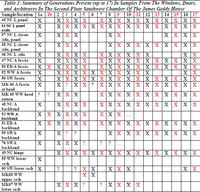 Table 1: Summary of Generations Present (up to 17) In Samples From The Windows, Doors, and Architraves In The Second-Floor Southwest Chamber Of The James Geddy House
Table 1: Summary of Generations Present (up to 17) In Samples From The Windows, Doors, and Architraves In The Second-Floor Southwest Chamber Of The James Geddy House
| Sample/location | 1a | 1b | 2 | 3 | 4 | 5 | 6 | 7 | 8 | 9 | 10 | 11 | 12 | 13 | 14 | 15 | 16 | 17 |
|---|---|---|---|---|---|---|---|---|---|---|---|---|---|---|---|---|---|---|
| 45 NC L panel | X | X | X | X | X | X | X | X | X | X | X | X | X | X | X | X | ||
| 54 NC L panel ovolo | X | X | X | X | X | X | X | X | X | X | X | X | X | X | X | X | X | |
| 57 NC L closet-side, panel | X | X | X | X | X | X | X | X | X | X | ||||||||
| 58 NC L closet-side, panel | X | X | X | X | X | X | X | X | X | X | X | X | X | X | ||||
| 46 NC L stile | X | X | X | X | X | X | X | X | X | X | X | X | X | X | X | X | ||
| 47 NC A fascia | X | X | X | X | X | X | X | X | X | X | X | X | X | X | X | X | ||
| 50 ED A fascia | X | X | X | X | X | X | X | X | X | X | X | X | X | X | X | X | X | |
| 52 WW A fascia | X | X | X | X | X | X | X | X | X | X | X | X | X | X | ||||
| 56 SW fascia | X | X | X | X | X | X | X | X | X | X | X | X | X | X | X | X | X | |
| MK 66 A fascia at bead | X | X | ? | X | X | ? | X | X | X | X | X | X | X | X | X | X | X | |
| MK 65 WW head return | ? | ? | X | X | X | X | X | X | X | X | X | X | X | X | X | X | ||
| 48 NC A backband | X | X | X | X | X | X | X | X | X | X | X | X | X | X | X | X | ||
| 53 WW A backband | X | X | X | X | X | X | X | X | X | … | ||||||||
| 51 ED A backband | X | X | X | X | X | X | X | X | X | X | X | X | X | X | X | X | X | |
| 59 SWA backband | X | X | ? | ? | X | X | X | X | X | X | X | X | X | X | ||||
| 76 SWA backband | X | X | X | X | ? | ? | ? | … | ||||||||||
| 49 NC hinge | X | X | X | X | X | X | X | X | X | X | X | X | X | X | X | X | ||
| 55 WW lower sash | X | |||||||||||||||||
| 60 SW lower sash | X | ? | ? | X | X | X | X | X | X | X | ||||||||
| MK68 WW upper sash | X | X | ||||||||||||||||
| MK67 WW lower sash | X | X | X | ? | ? | X | X | X | X |
Key: NC = north closet, ED = east door, WW = west window, SW = south window, A = architrave, L = leaf, X = finish generation present, ? = generation may be present but has a different appearance than in other samples, … = generations after that are intermixed with additional color layers. Note: red and black are used to make the table easier to read but have no symbolic presence.
69Table II relates the generations on each "woodwork type" to one another. The fireplace mantel and baseboard are lined up in correspondence to the other woodwork, but also correspond to each other. The number in parentheses represents the generation assigned to the layers on the baseboard and fireplace mantel samples for this study. In actuality however, they should be labeled with the same generations as those found in the other woodwork of the room.
| Windows, doors, architraves | Fireplace mantel | Baseboard | |||
|---|---|---|---|---|---|
| Modern paint | 25 | Not present | 25(22) | ||
| Modern paint | 24 | 24(23) | 24(21) | ||
| Modern paint | 23 | 23(22) | 23(20) | ||
| Modern paint | 22 | 22(21) | 22(19) | ||
| Modern paint | 21 | 21(20) | 21(18) | ||
| Modern paint | 20 | 20(19) | 20(17) | ||
| Modern paint | 19 | 19(18) | 19(16) | ||
| Modern paint | 18 | 18(17) | 18(15) | ||
| Modern paint | 17 | 17(16) | 17(14) | ||
| Modern paint | 16 | 16(15) | 16(13) | ||
| Off-white paint | 15 | 15(14) | 15(12) | ||
| Off-white paint | 14 | 14(13) | 14(11) | ||
| Off-white paint | 13 | 13(12) | 13(10) | ||
| Gray paint | 12 | Generation 10 is the same as 12 but there is an additional generation 11 in between | 12 not present, 9 corresponds to fireplace mantel 11 | ||
| Off-white paint | 11 | 11(9) | 11(8) | ||
| Off-white paint | 10 | 10(8) | 10(7) | ||
| Off white paint | 9 | 9(7) | 9(6) | ||
| Pale green paint | 8 | ||||
| Greenish blue paint | 7 | ||||
| Pigmented glaze | 6 | Clear varnish | 6 | ||
| Blue paint | 5 | Pigmented varnish | 5 | Pigmented varnish | 5 |
| Tan paint | 4 | Black paint | 4 | Black paint | 4 |
| Orangey yellow paint | 3 | Black paint | 3 | Pigmented varnish | 3 |
| Tan paint | 2 | Reddish brown paint | 2 | Orangey red paint | 2 |
| Gray paint | 1 | Pale blue paint | 1 | Brown paint | 1 |
Tables 3.1-1.4 show the fluorochrome staining results. Key: NA = not applicable, - = no reaction, + = positive reaction
| Generation in room/description | Baseboard generation | Fireplace generation | TTC | FITC | RHOB | DCF |
|---|---|---|---|---|---|---|
| 25 Modern tan | 22 | NA | + | + | NA | + |
| 24 Modern tan | 21 | 23 | + | + | NA | + |
| 23 Modern tan | 20 | 22 | + | + | NA | + |
| 22 Modern tan | 19 | 21 | + | + | NA | + |
| 21 Modern tan | 18 | 20 | - | - | NA | - |
| 20 Modern tan | 17 | 19 | - | - | - | + |
| 19 Modern tan | 16 | 18 | - | + | NA | - |
| 18 Modern tan | 15 | 17 | - | + | NA | - |
| 17 Modern tan | 14 | 16 | - | - | NA | + |
| 16 Modern tan | 13 | 15 | - | - | NA | + |
| 15 White | 12 | 14 | - | - | NA | + |
| 14 White | 11 | 13 | - | - | NA | - |
| 13 White | 10 | 12 | - | - | NA | - |
| Generation | Description | TTC | FITC | RHOB | DCF | TSQ |
|---|---|---|---|---|---|---|
| 12 | Gray/off-white | Weak + | - | - | Possible weak + | Weak + |
| 11 | Cream/off-white | - | - | - | Possible weak + | Weak + |
| 10 | Cream/off-white | Weak + | - | - | Possible weak + | Weak + |
| 9 | Cream/off-white | - | - | - | + | Weak + |
| 8b | Green-yellow | + | - | Weak + | Possible weak + | Weak + |
| 8a | Primer | Weak + | - | Weak + | Possible weak + | Weak + |
| 7 | Blue-green | Weak + | - | Weak + | Possible weak + | - |
| 6 | Pigmented glaze | - | + | - | Possible weak + | - |
| 5 | Blue | - | - | - | Possible weak + | - |
| 4b | Tan | Weak + | - | - | Possible weak + | - |
| 4a | Primer | Weak + | - | Weak + | + | - |
| 3 | Yellow | - | - | - | Possible weak + | - |
| 2b | Tan | Weak + | - | Weak + | Possible weak + | - |
| 2a | Primer | - | - | Weak + | Possible weak + | - |
| 1b | Gray | - | - | Weak + | Possible weak + | - |
| 1a | Shellac | NA | False + | - | Weak + | - |
| Generation | Description | TTC | FITC | RHOB | DCF | TSQ | |
|---|---|---|---|---|---|---|---|
| 9 | Cream/off-white | 11 | - | - | Weak + | - | NA |
| 8 | Cream/off-white | 10 | - | - | - | - | NA |
| 7 | Cream/off-white | 9 | - | - | - | - | NA |
| 6 | Clear varnish | - | - | - | Weak + | NA | |
| 5 | Pigmented varnish | - | - | - | Weak + | NA | |
| 4 | Black | Weak + | Possible weak + | + | Weak + | NA | |
| 3 | Black | Weak + | Possible weak + | + | Weak + | NA | |
| 2b | Reddish brown | Weak + | Weak + | - | Weak + | NA | |
| 2a | Semi-trans Primer | Weak + | Weak + | - | - | NA | |
| 1c | Pale blue | - | Weak + | - | - | NA | |
| 1b | Primer | - | - | Weak + | - | NA | |
| 1a | Shellac | V | Weak + | + | + | NA |
| Generation | Description | TTC | FITC | RHOB | DCF | TSQ | |
|---|---|---|---|---|---|---|---|
| 9 | Matted varnish | - | - | NA | Weak + | NA | |
| 8 | White | 11 | - | - | NA | - | NA |
| 7 | White | 10 | Weak + | - | NA | - | NA |
| 6 | White | 9 | - | - | NA | - | NA |
| 5 | Clear varnish | - | - | NA | - | NA | |
| 4 | Black | - | - | NA | Weak + | NA | |
| 3 | Pigmented varnish | - | - | NA | Weak + | NA | |
| 2 | Reddish orange | - | + | in area below | NA | + in area below | NA |
| 1b | Brown | - | - | NA | + | NA | |
| 1a | Shellac | - | - | NA | + | NA |
| Gen. | Perceived color and pigments in cross-section | Benjamin Moore color match | Major pigments | Minor pigments |
|---|---|---|---|---|
| Windows, doors, & architraves | ||||
| 1b | Gray with small black and large yellow, as well as a few small/large red and small blue pigments | 1545 Iron gate | Lead white, yellow earth | Red earth, black, chalk |
| 2 a/b | Creamy yellow with large and small white, small and medium yellow, small red, and medium dark brown pigments | 1041 Scarecrow | Lead white, chalk | Red and or yellow earth |
| 3 | Semi-translucent deep yellow with coarse white, and small and medium yellow and red pigments | 2158-30 Delightful golden | Lead white, yellow earth | Chalk, carbon based-black, iron oxide red/brown |
| 4 a/b | Creamy yellow with small yellow, red and black, and large and small white pigments | 1040 Spice gold | Lead white, yellow earth, chalk | Red earth |
| 5 | Blue with large dark blue and white, small light blue, and medium red pigments | HC 158 Newburg green | Lead white, Prussian blue | Chalk, red ocher |
| Fireplace mantel | ||||
| 1 a/b | Pale blue with small-large white and small-medium blue pigments | HC150 Yarmouth blue | Lead white | Prussian blue, red earth |
| 2b | Brick red with large white and black, small orangey red and medium dark red pigments | 2102-20 Pumpernickel | Red earth | Chalk, carbon-based black, lead white |
| 3 | Black with a range of black, small/medium red and small yellow-green pigments | 2129-10 Midnight dream | Carbon-based black | Chalk, yellow earth |
| Baseboard | ||||
| 1 | Reddish brown with small red-brown, medium/large red, and large red/black pigments | 2114-20 Mississippi mud | Red earth/ochre, yellow earth | Chalk |
| 2 | Orange with Small orange, small and large yellow, large white pigments | 2175-30 Rust | Red lead, red earth | Chalk |
Resources:
- Chappell, E. 1993. James Geddy builds his dream house. The Colonial Williamsburg Interpreter 14(4): 1-7
- Eastaugh, N., V. Walsh, T. Chaplin, and R. Siddall. 2008. Pigment compendium: a dictionary and optical microscopy of historical pigments. Boston, MA.: Elsevier Ltd.
- Gettens, R. J. and G. L. Stout. 1966. Painting materials, a short encyclopedia. New York, NY.: Dover Publications, Inc.
- Kühn, H. 1970. Verdigris and copper resinate. Studies in Conservation 15: 12-36
- McCrone, W. C. 1982. The microscopical identification of artists' pigments. Journal of the International Institute for Conservation — Canadian Group 7 (1 & 2): 11-34.
- Travers, K. 2011. Lead and zinc-based paints in cross-section: A comparative study of their elemental composition and autofluorescence behaviors. Winterthur, DE
